

3 Day Uluru Itinerary in the Uluru-Kata Tjuta National Park

Who’s searching for the adventure of a lifetime? Uluru or Ayers Rock is an absolute must-see for outdoor enthusiasts or hiking lovers looking to tour one of Australia’s most iconic landmarks. The great news is that the 3 day Uluru Itinerary listed below is here to help you plan your days!
Having visited the National Park four times over the last decade, I’ve gained a wealth of knowledge and experience about the area. And every time I return, I am amazed by the new additions while still enjoying everything that has been around for a while.
Let me be your personal guide and share my best tips for making the most of your vacation!
This post may contain affiliate links that at no additional cost to you, I may earn a small commission. Please read my blog disclaimer, terms and conditions & privacy policy here for details.
3 Day Uluru Itinerary (Ayers Rock)
Key Takeaways: Why do I suggest a 3 Day Uluru Itinerary? Firstly, you must purchase a National Park pass to enter, which are sold as a 3 Day pass or Annual Ticket. Therefore, it makes more sense for tourists seeking the highlights to explore for just three days!
Secondly, while I think there is plenty to do in the area to keep you entertained for over a week, not everyone will want to do everything. So, in rounding down your highlights, I’m sure you are going to be happy with what you see in those three days.
The stunning Uluru-Kata Tjuta National Park is located in the heart of Central Australia and contained within the state of the Northern Territory. It was UNESCO World Heritage listed in 1987 for it’s natural values and again in 1994 for cultural.
The closest towns are Alice Springs, with a population of 25 thousand, and the community of Yulara, with 1000 people.
Overall, Uluru is worth checking out since this massive red rock formation will have you in awe when driving up for the first time. Not only that, but it also holds significant cultural and spiritual importance to the Indigenous Anangu people.

➡ Compare prices for Yulara Accommodation HERE with Booking.com
Day 1 – See Uluru (Drive around, Walk around, Helicopter Tours)
Our First day is all about exploring the big red rock called Uluru, or otherwise known as Ayers Rock. You can choose your best way or know that there is enough time to complete all three ways I have scheduled for today.
Ultimately, its an out-of-this-world red sandstone rock formation reaching almost 350 metres into the sky. All this is accompanied by stunning desert views and landscapes. Together with being one of Australia’s most picturesque icons and renowned for its ancient Aboriginal culture.

Drive Around
Just to get a feel for the size and ease you into the area, I recommend just taking a drive. It’s one of the largest monoliths in the world and takes a whopping 30 minutes to drive around!
This driving path does have restrictions, though, and every time you think you want to stop – Don’t! Most of this road is marked as “No Stopping,” and you need to wait for the specified parking bays to do this. However, my best tip is for the passenger to sit in the back seat and take photos as you drive.

Walk Around
Next up, we have the allocated Loop walking track around the rock. However, while the 9.4 kilometres might sound intimidating, it is all flat ground and not too difficult to walk. Ultimately, the whole track will take you about 3 to 4 hours to complete. This includes the little site tracks to enjoy for sacred sites and waterholes.
Alternatively, If you think you can’t do the walk, there are options for a Segway ride. Not only will you learn about the area as you go and have fun doing it. But these tours range from 2 to 5 hours, so you can choose one that suits you.
➡ Compare prices for All Tours HERE with Get your Guide, or HERE with Viator.
A secret option here would be completing some of it and returning on the same track. I know I have done this once since I didn’t have much time and it allows you to see a watering hole or two and a couple of sacred sites. Surprisingly, it’s not as good as doing the whole thing, but it’s nice if you have options.

Aerial view
Have you ever had one of those bucket list items in Australia that you just knew you had to cross off? For me, it was flying in a helicopter over Uluru, Yulara, and Kata Tjuta. And let me tell you, it did not disappoint. The feeling of soaring above these incredible sites is something that you simply can’t replicate on the ground.
But don’t worry if helicopters aren’t your thing – there are also options for hot air balloons or fixed-winged planes. No matter which option you choose, I can promise you that it is well worth the high ticket price. The aerial view is phenomenal and an unbelievable experience you will never forget.

Check out my Photo Gallery for sample tourism images needed for websites, blog posts, magazines articles, Marketing and/or Advertisement’s.

Day 2 – Sunrise / Cultural Centre / Field of Lights
By this time, we have settled in and seen every inch of the red rock. But how else can you experience it? Well, this is where it gets really exciting seeing the unique and special additions to the area. While also viewing the different shades of colour the rock can change into.
As someone who has seen it multiple times, I can attest to the fact that the colors of the rock formation are impressive. Witnessing the vibrant oranges and reds during sunrise and sunset is a site you don’t want to miss. But what some people may not know is that even on a rainy day, the color takes on a unique grey hue. This makes it gorgeous with small streams flowing down the crevices.

Sunrise / Sunset
Just for convenience, there are specifically allocated Sunrise and Sunset locations. These allow plenty of parking and large areas to spread out for viewing. However, with a large number of people eager to experience this spectacular event as well, it’s important to plan ahead and get there ahead of time (at least 30 minutes to 1 hour before).
To make it an even more enjoyable experience, consider bringing a chair, some snacks, and your favorite drink (especially at sunset). After that, you can just sit back, relax, and let the vibrant hues of the sun’s rays wash over you.
This brings me to my next big tip! As a photographer, I know that sometimes the allocated spots for capturing a specific effect may not align with the creative vision that’s brewing in your mind. So, if you’re like me, you may want to switch things up and capture it from a different angle. Additionally, the second reason to do this would be less crowds.

Cultural Centre
The Cultural Centre is where you’ll find all sorts of useful information about what activities the park has to offer. As well as an in-depth introduction to Anangu culture. The Anangu people have lived in this region for over 22,000 years, making them Uluru’s traditional custodians.
At the cultural centre, you can take part in a range of activities like a bush tucker session and guided walk, or watch craft demonstrations and purchase traditional Anangu art. This is a popular starting point for visitors exploring the park and a wealth of information and experiences you won’t want to miss.

Field of Lights experience
The Bruce Munro Field of Lights display is a mind-boggling art installation that covers a huge area near the rock. You can only experience this by tour at sunrise or sunset, and it’s truly a once-in-a-lifetime opportunity to witness something extraordinary.
I did the tour at sunset, and one minute I was in the middle of the Australian desert, sipping on some Australian wine. All the while, I was surrounded by nothing but dusty sand and Uluru towering in the distance.
➡ Check out the Field of Lights tour HERE with Get Your Guide, Or HERE with Viator.
At first, all you see is a vast expanse of emptiness. But as the sun dips below the horizon, something magical happens. Around 50,000 solar-powered globes or light stems suddenly phase to life, creating a mesmerizing display of colours and light.
Honestly, I felt like I was in the Avatar movie, visiting the Tree of Life! But even better, after your overall view, you could wander down the hill and meander up close through the bulbs before returning back to your accommodation.

Day3 – Kuta Tjuta / Dinner
Kata Tjuta (The Olgas) is the lesson known Wonder in the National Park, but it is still worth checking out. What’s even more fascinating is that while it stands as one big rock, Kata Tjuta is made from the same substance and formed into an array of rocks.
You can take the Walpa Gorge Walk (only 1-hour return), which is the more popular one I’ve completed a couple of times. Essentially, this walks you through the middle of two rock formations into a small gorge.
The Valley of the Winds walk is a little more challenging, with a 3-hour return hike starting at the other end of Kata Tjuta. It will feature many of the rock formations and have you walk into areas most people don’t see (unless you do the hike).

Now our time here is quickly coming to a close. But not before checking out the “Sounds of Silence” Dinner experience in front of the rock. Picture yourself with a glass of champagne in hand, standing in front of one of the world’s most spectacular natural wonders. What’s even better is you’re served a superb Australian meal and get to enjoy it in style with a limited number of other tourists.
This is the relaxing part of the journey, where you sit back and reminisce over what happened in the last few days. All complete with a 3-course meal and drinks while the sun sets and in clear view of the rock.

Where to Stay
There is always some confusion when finding a place to stay at Uluru . Most of this comes from booking accommodation in Yulara rather than in Uluru. There are about seven hotel styles on offer, ranging from camping to glamping, mid-class comfort to pure luxury, so you’re sure to find something that suits your budget and taste.
➡ Check and compare prices for Yulara Accommodation HERE with Booking.com
I’ve personally stayed in the Outback Pioneer Lodge for my last three visits purely for budget and knowing it can be one of the cheaper options. However, that doesn’t mean you can’t pick up a special discount or want the extra luxury at the other hotels.

Wrap up – 3 Day Uluru Itinerary in Uluru-Kata Tjuta National Park
Visiting Central Australia is a chance of a lifetime, and travelers who choose to take that journey will be rewarded with incredible beauty. The 3 Day Uluru Itinerary above provides an amazing combination of awe-inspiring nature, history, and culture, making it a truly unique experience.
I highly recommend doing further research to get more ideas and inspiration on what to do in the Northern Territory . There’s really so much more to this place than meets the eye! From the outback landscapes to the fascinating culture, it is easy to understand why it’s one of the Australia’s most popular stops.
Read More Articles:
Is Darwin worth visiting & the best things to do?
How to Get to Florence Falls in Litchfield National Park
Kings Canyon Rim Walk Guide, Watarrka National Park
See Magnetic Termite Mounds in the Northern Territory
Cairns Vs Darwin – Which is better to Visit?
“Hi, travel enthusiasts! I’m Chris Fry, The Aquarius Traveller Blogger. I’ve been exploring the world since 2007, documenting my journeys through the lens of my camera. Having visited over 37 countries (including my home Australia), I’ve gained first-hand experiences that help you plan your adventures.
So, whether you need insider tips, or want to live vicariously through my escapades – You’ll find something to love in my blog.”
Leave a Reply Cancel reply
Your email address will not be published. Required fields are marked *
Privacy Overview
- Ulu r u-Kata Tju t a National Park
- Things to do
- Itineraries

Sunset at Ulu r u is a must for any itinerary. Photo: Tourism Australia
There is so much to do in and around Ulu r u-Kata Tju t a, from contemplating the vastness of the desert and the richness of A n angu culture to riding Segways through the landscape and dining under a star-studded sky.
Given the wide variety of activities on offer, we recommend staying at least three days to give yourself time to explore, learn, go on some adventures and take your time to understand this special place.
But don’t worry if you’re only here for a short visit. You can still see the main highlights of the park in a single day or less .
Got a bit more time? Ayers Rock Resort offers a variety of paid and free activities you can add to your schedule. Trot across the sands on a camel tour, see Ulu r u from the air on a scenic flight or enjoy an open-air dinner with some of Central Australia’s best views.
Visit the info desk at the Cultural Centre or the tour office in the town square at Ayers Rock Resort for more information about what’s on during your stay.
Choose your itinerary

Half- & one-day adventures
You can see a lot in a short visit to Ulu r u-Kata Tju t a National Park. Here are the best ways to spend a day or less in the park.

The two-day explorer
Spend two full days in Ulu r u-Kata Tju t a National Park to get more of a feel for this amazing place.
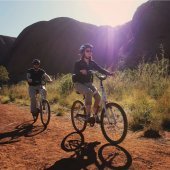
The three-day immersion
Three days in Ulu r u-Kata Tju t a National Park gives you time to soak up the natural beauty and deep cultural significance of the landscape.
- Australian Government, Parks Australia
- Ulu r u-Kata Tju t a National Park is dual-listed on the UNESCO World Heritage List for its outstanding natural and cultural values
- Buy park pass
- Cultural Centre
- Tours & activities
- Plan your trip
- Buy your pass
- When to come
- Getting here
- Hotels & lodges
- Shops & facilities
- About Ayers Rock Resort
- Latest news
- Media centre
- Frequently asked questions
- Kakadu National Park
- Norfolk Island
- Christmas Island
- Pulu Keeling
- Australian National Botanic Gardens
- Australian Marine Parks
© 2013–2024 Parks Australia (Commonwealth of Australia)
We acknowledge the Traditional Owners of country throughout Australia and recognise their continuing connection to land, waters and culture. We pay our respects to their Elders past, present and emerging.

Anna Sherchand
Solo Female Travel Blog
Exciting Uluru trip – The must-read guide
As a lover of unique places, I always wanted to do an Uluru trip but never got around to it. That is until 2019!
Here I cover my Uluru experience, the recommended 3 day Uluru itinerary travel tips, and the best places to see on your Uluru trip. Visiting Uluru is going to leave you spellbound! It may be the best adventure in the Australian outback!
- 99% of readers found must see on the east coast of Australia helpful.
Previously Uluru was known as Ayera rock and was named Ayers Rock by William Gosse in 1873 after Sir Henry Ayers. In 1993 the name of the national park changed from Ayers Rock -Mount Olga National Park to Uluru -Kata Tjuta National Park to acknowledge and respect the Aboriginal Anangu people and their land. It is possibly the most famous and coolest rock in the world!
Uluru was created around over 600 million years ago, and originally sat at the bottom of the sea! The aboriginals have been in the area for the last 10,000 years! Do you know it is 348 m high?
Anangu people, who are known as the world’s oldest civilization call this place home. Hence it is protected by the Uluru-Kata Tjuta National Park and is listed as a UNESCO World Heritage Site.
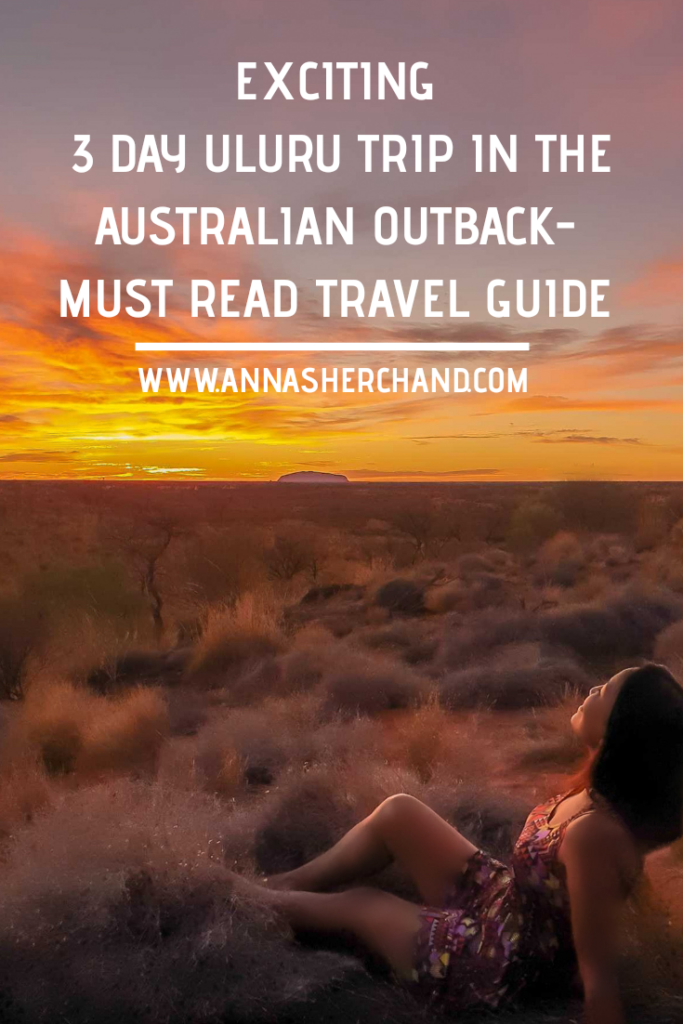
Exciting Uluru trip – 3 days itinerary and must-know travel tips
So where is uluru, when is the best time to go to uluru, how many days is good for uluru, how can you visit ayers rock in australia, the best places to see on your uluru trip., uluru sunset and cultural center, uluru sunrise and kata tjuta hike, kings canyon rim walk, garden of eden, uluru kata tjuta and kings canyon tips:, take time off the internet, respect the aboriginal request, buy the flynet, bring at least a 1-liter water bottle, don’t forget the sunscreen, pack the right clothes, read the signs, it’s mount conner, not uluru, go stargazing, bring a camera, let me know in the comments-.
Uluru is close to central Australia and is about 5-6 hours drive from Alice Springs, Northern Territory of Australia. The red rock lies right in the center of Uluru National Park, just east of Kata Tjuta.
Alice Springs is the gateway to this sacred and iconic place. Sadly Alice Springs gets a negative rap of being a small town but don’t let that stop you from visiting. I absolutely loved the peace and quietness and there are also bars and restaurants to keep you busy! Also, sunsets at the ANZAC Hill are beautiful (only a short climb), and check out the rock art at the visitor center.
I went in April, and the weather was just perfect at night! During the day it was still quite hot but totally manageable. Just don’t forget to take at least a 1-liter water bottle with you! (more tips below)
Having said that, the best time to travel to Uluru is from May to September. It won’t be too hot nor too cold whereas December, January, February is Australia’s summertime and is the worst time to travel to the lovely Uluru. Similarly, June to September is the winter months.
I would say at least 3 days. But if you can 4 days is better to cover all the must-see places in a leisurely fashion.
You can get there by driving or taking a bus. Flying from the Ayers rock airport and then arranging the tour or private transport to Uluru seems to be the go-to option. (more on that below) You can find the cheapest flights through the most trusted sites such as Skyscanner or Momodo. Qantas and Virgin Australia fly to Uluru from all Australian capital cities (except Canberra!)
You could also hire a private car from Alice Springs to Uluru, and visit Uluru on your own but genuinely there is so much value in going with a local guide/ tour company. You will learn a lot of interesting facts and stories about Ayers Rock, outback history in a cultural center, its inhabitants, and more.
I met a few travelers who did Uluru trip on their own and knew nothing about the fascinating Uluru stories! They just drove there, saw the red rock, and left! But am sure you are cooler than that, you can make this trip memorable and fun, continue reading to know-how!
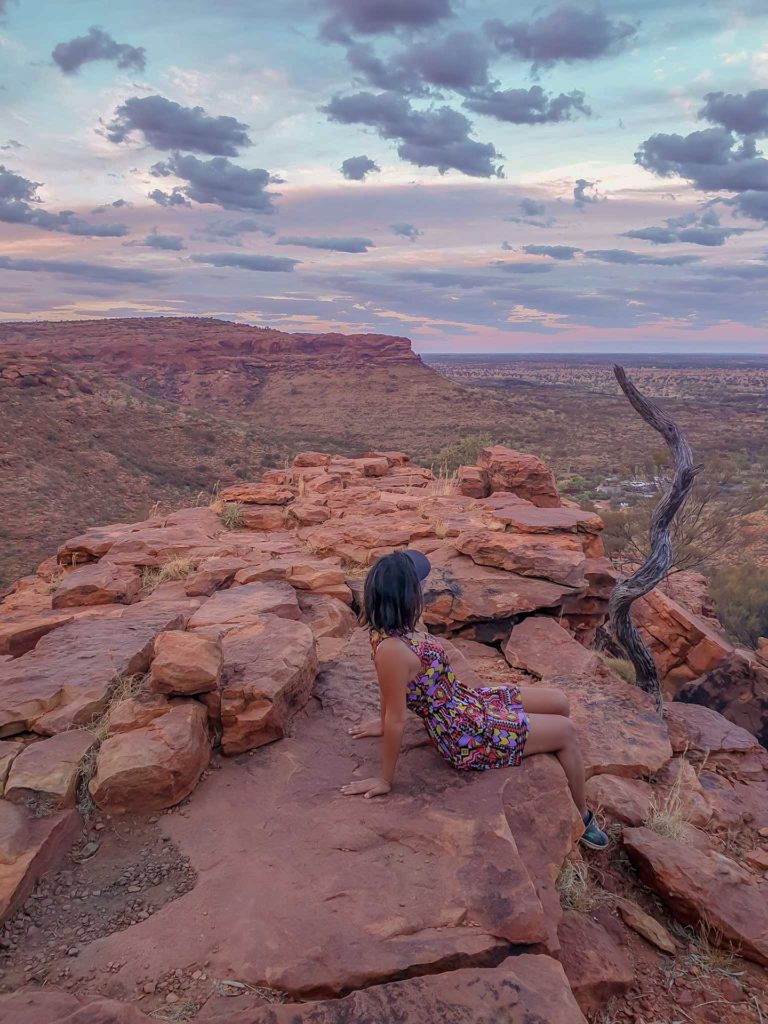
Book Uluru tours from Alice Springs
Since there is no airport in Uluru National Park , once you arrive in Alice Springs, I recommend booking a tour that includes everything for the best bargain. Look for Uluru tour packages that include pick up and drop off from your accommodation, inclusive of the National Park entrance fee, meals, snacks, and accommodation.
Uluru is a highly visited destination and there are loads of Uluru tours to choose from, some of them offer one-day tours and some 2 or 3 days Uluru trips.
As you may have seen on my Instagram , I went on a 3 days and 2 nights tour with Mulgas Adventure Tours. It was fully focused on fun, affordability, education, way better food on our tour (even a guide from another tour was eyeing our food!), and a more relaxed schedule. All are run by only experienced Australian-born guides who have a wealth of knowledge and are happy to share them! Alternatively, here are some recommended tours below from trusted get your guide.
If you are worried about spending 3 days on a tour with the teenagers focused on the party or the elders who remind you of your distant uncle and aunties, let me assure you Mulgas knows how to balance the tour! They have been doing this for years and are known as the best in the business. In fact, it was referred to me by a fellow traveler as well! Their tours are so entertaining word of mouth does the marketing for them!
Mulgas’s target market is the younger travelers usually from 18- 35 years old and of course, there will be times when you will meet an odd 45 years old passenger but if they are joining this adventurous Uluru trip, they must be as adventurous as you!
And in regards to the party, some drinks by the bonfire are always enjoyable after exploring Uluru all day. But a late-night one won’t go down well as most people want to sleep and see the awe-inspiring sunrise over Uluru in the morning. (more on that below)
I was glad our Uluru tour was full of common activities, which allowed us to talk and engage with each other and within a few hours, we all knew each other by the first name!
PS: Thanks to our tour guide Ben for organizing drinks and dinner AFTER the trip once we were back in Alice Springs, freshly showered and smelling of roses!
Most times, the tour guides get unnoticed despite the hard work they put in to deliver a great tour. So, let me just share that our guide Ben had incredible nonstop energy, knowledge, fun-loving, professional, safety-focused, problem-solving, and dynamic capabilities!
All three days, he was always smiling and full of energy! There was never a dull moment around Ben! I truly believe it set a great vibe for the comrade of the group as well.
It was great to see people from all around the world joining this exciting 3 day Uluru trip and happily helping to cook, wash dishes and contribute to packing. All this participation in tasks created a homey bonding within the group, that ultimately helped to turn strangers into friends! I am glad I went with Mulgas Adventure and highly recommend the same tour to you.
Now, without further ado let me share,
You can also use it as a 3 days Uluru travel itinerary.
Ps: Click on the blue link of the name of the places, and it will take you straight to the google maps of desired destinations 🙂
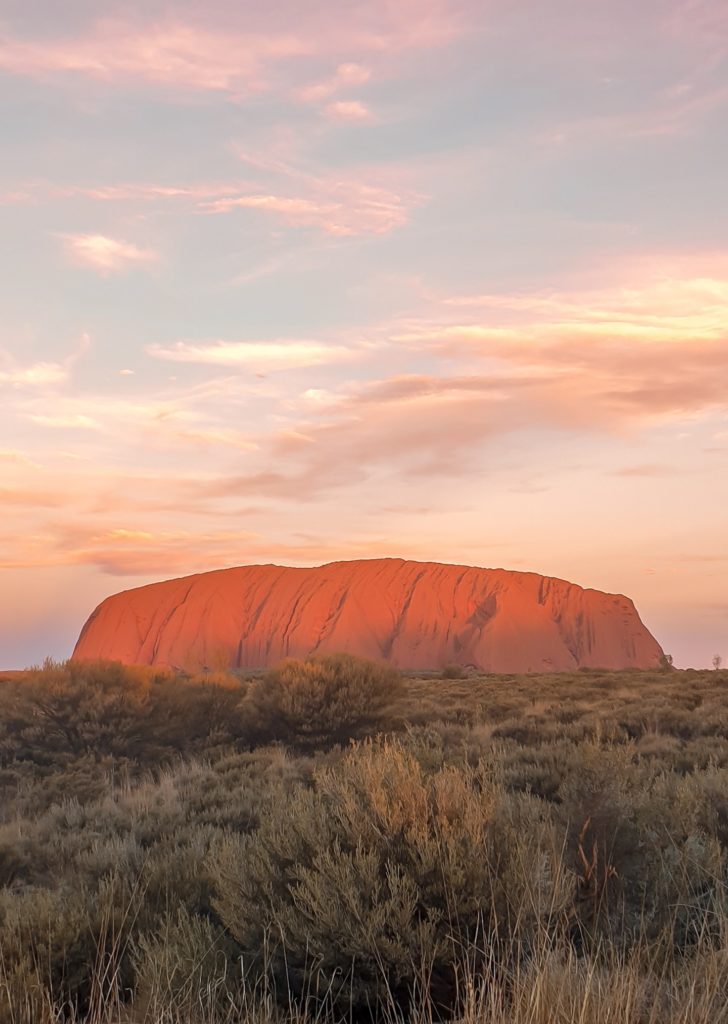
Day 1: As we arrived in Uluru, we visited the cultural center and gained an understanding of Aboriginal culture. You can see the big aboriginal exhibition that teaches you about Aboriginal culture, things you can eat in the outback from the plants, buy the painting made by Anangu people, and learn the history of Ayers Rock.
With that in mind, we then drove to the base of Uluru for a walk. It was a strange but nice experience to be able to walk and touch this giant red rock in Australia! There are also caves where aboriginal people used to live, cook and play! They used some of these caves for indigenous rituals and taught young generations how to hunt and gather with drawings on the wall!
It was then time to head to the sunset viewing area. We drove there and as we park in the big car park, I noticed hundreds of people waiting for the same sunsets over Uluru! After all, it is one of the must-sees during the Uluru holidays.
If you want to avoid the crowd and watch sunsets over Uluru in a relatively peaceful area, head to the right as there is a path with fewer people! It is a perfect place to take some Instagram-worthy photos and you won’t be disappointed with the amazing color change that the rock undertakes as the sunsets!
Upon returning back to the car park, I was pleased to see our tour guide had a table set with nibbles, dips, and champagne! At the same time, it was an incredible experience to watch the full moon rise next to the Uluru. I couldn’t ask for more as it was the perfect way to end our first day in the outback.
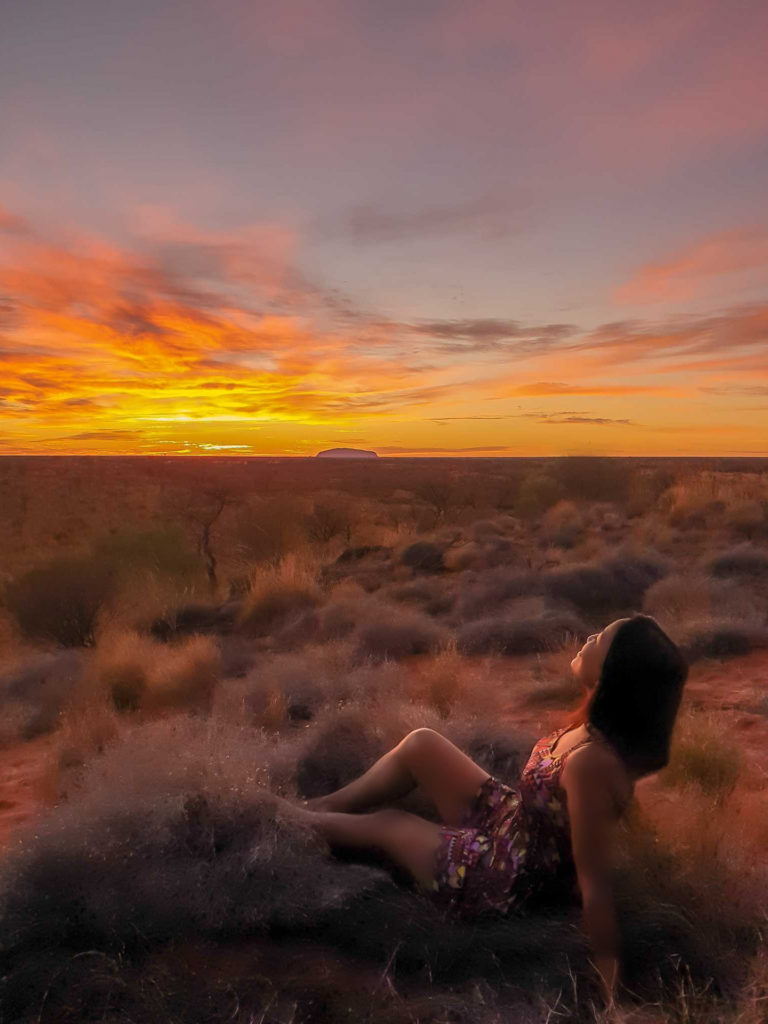
The Valley of the winds
Day 2: If there is one thing from this list you want to do, let it be this one. It is not like in Bagan Myanmar where you have to rush to find sunrise spots. There is a big sunrise viewing deck in Uluru (click on the name above that will take you straight to google maps). All you have to do is put your alarm on and get up on time so you won’t miss the stunning sunrise over ayres rock.
We got up at 4 am, had breakfast, and made our way there. It wasn’t easy to wake up that early but guess what! Our group was the first group to get there and we got our well-deserved first-row seats too! Watching this iconic sunrise over Uluru is a ‘must do’ on every traveler’s list. On one side you can watch the sunrise over Uluru and on the other Kata Tjuta which means many heads!
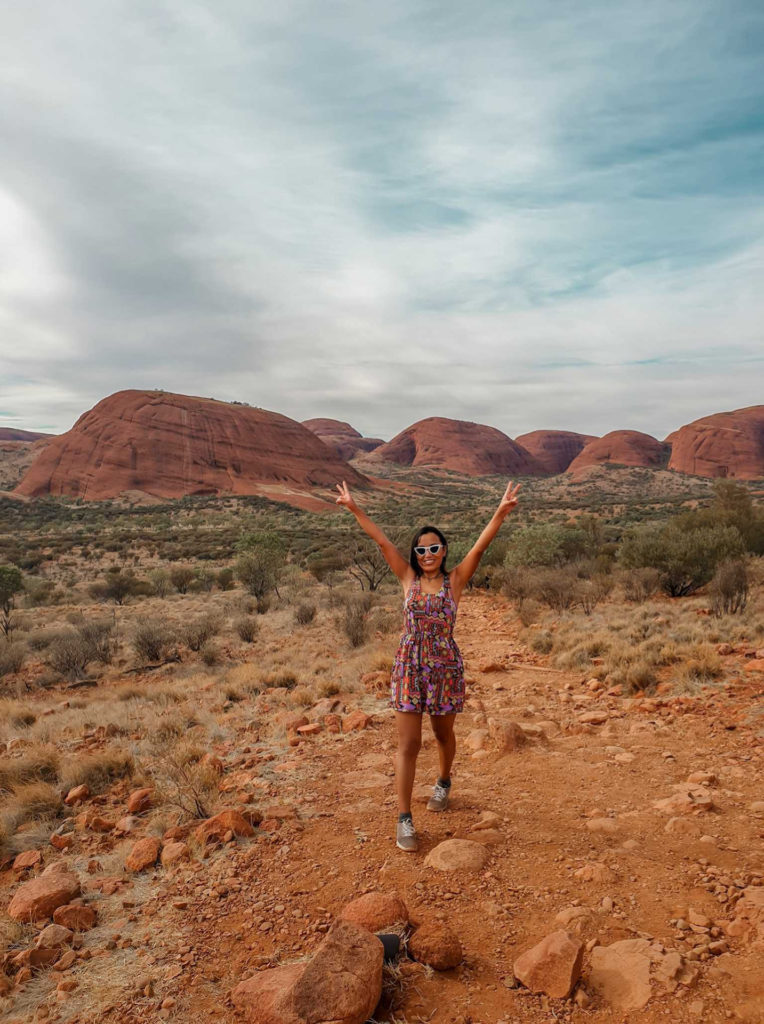
After witnessing the beautiful sunrise, it was time to explore Kata Tjuta National Park also known as the valley of the winds. Rock formations at Kata Tjuta are estimated to be 500 million years old! The complete walk takes around 3-4 hours (fast-slow phase) and there is a signboard at the first lookout that shows the current weather! When the forecast temperature is 36-degree Celsius or above, the track actually closes!
Therefore it is imperative, to wake up on time for the sunrise, and that way you will have ample time to hike Kata Tjuta and complete it before the midday sun!
If I was hiking by myself I would have missed many interesting areas. For example, our tour guide Ben pointed out the elephant structure, flora & herbs, and more things. It was like receiving little surprises along the way that kept the hiking enjoyable through and through!
Then minutes before we got to the second lookout – Karingana, we had a surprise cookie break! Ben then gave us an option to either continue the hike or go back to the coach with him. There was no pressure like you must complete it but nobody from our tour wanted to go back! So, we continued the hike with pleasure!
It was 31 degrees and flies were EVERYWHERE but we were rocking our fly nets, (I took it off for pictures), and enjoyed this interesting landscape that is so rare!
We finished the hike before mid-day and had an awesome lunch back at the campground!

On the way back from Kata Tjuta, we stopped at the Salt Lake! It is a bit of a walk to get to from the parking lot but if you have time, definitely worth it. Along the way have a unique experience touching the ever so soft and fine red sand in the northern territory of Australia!
Tank hill is in Kings Creek Station and is a pretty decent spot for watching sunsets. As the name suggests, there are four tank hills and a spectacular view around the ranges all around.
I know some people who have stayed at Ayers rock resort and similar places but we were happy with our Uluru camping arrangements!
Back at the campground, we had a delicious dinner and a warm bonfire waiting for us. With a belly full of good food we then slept on our swag. If you don’t know, swag is a roll-out sleeping tent that comes with an inner mattress and you just throw in a sleeping bag on it.
That brings me to the topic of
There may be some dingos (native Australian dogs) around but they walk in single unlike in Fraser Island where they walk around in packs! So, it is less dangerous but they may sniff and lick your face while you are asleep!
There may be potential for the attack but the reality is the incidence of attacks on humans is relatively rare. Just don’t feed or encourage them anywhere you see them. The same goes with wild Kangaroos and Wallabies.
We didn’t have any dingo incidents and we all slept watching the million twinkling stars above us! It is one of the adventurous experiences of your Uluru trip.
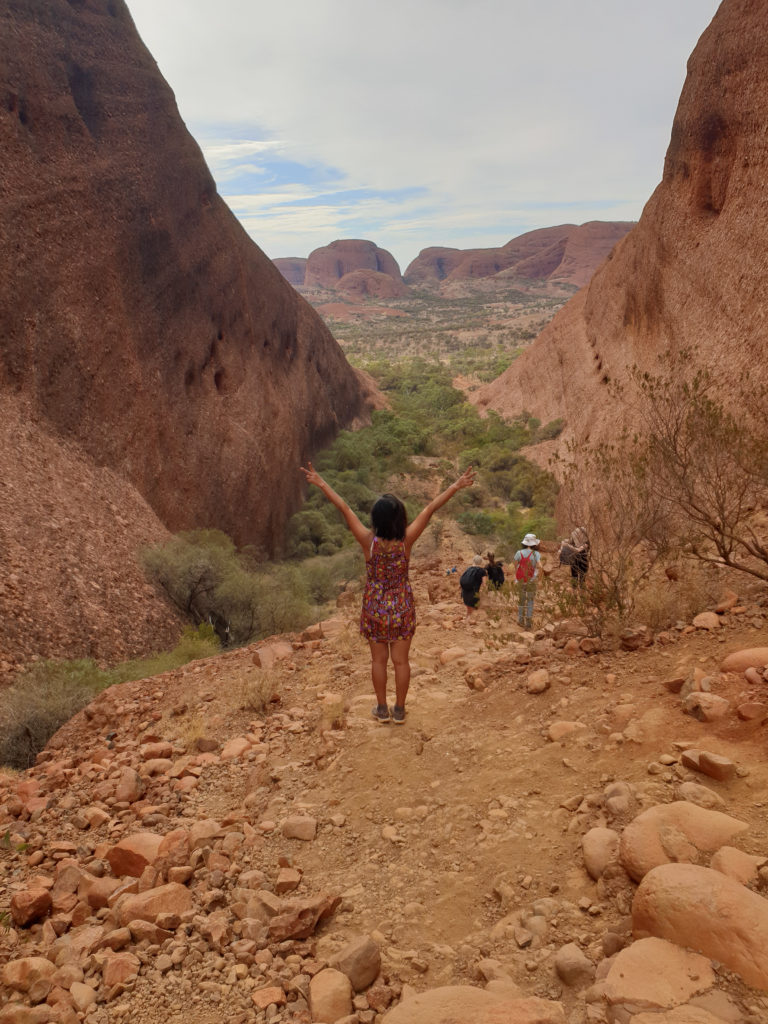
Day 3: It was our last day at Ayers Rock Australia and another early start. The temperature gets too hot real quick around Uluru so, the best time to do sightseeing is the first thing in the morning. Hence our plan was to watch the sunrise at the Kings Canyon and do the Kings Canyon Rim Walk.
There are a number of different hikes you can do at the King’s Canyon. We did the 6KM full circuit and it started with the very steep 780 stairs known to locals as “Heart Attack Hill”! It was difficult but not impossible. Just take it slow and enjoy the view as you go up! Then once you are at the summit of this hill, you will be greeted with a gorgeous view.
Note: Kings Canyon is basically made with Sandrock, you can not tell how stable it is just from looking at it! So, it is best to avoid stepping around the edges and always be 3 meters away.
After the first portion of the steep hill, the rest of the walk is pretty flat but gets more vivid with red cliffs! The surrounding areas reminded me of the Grand Canyon in the USA!
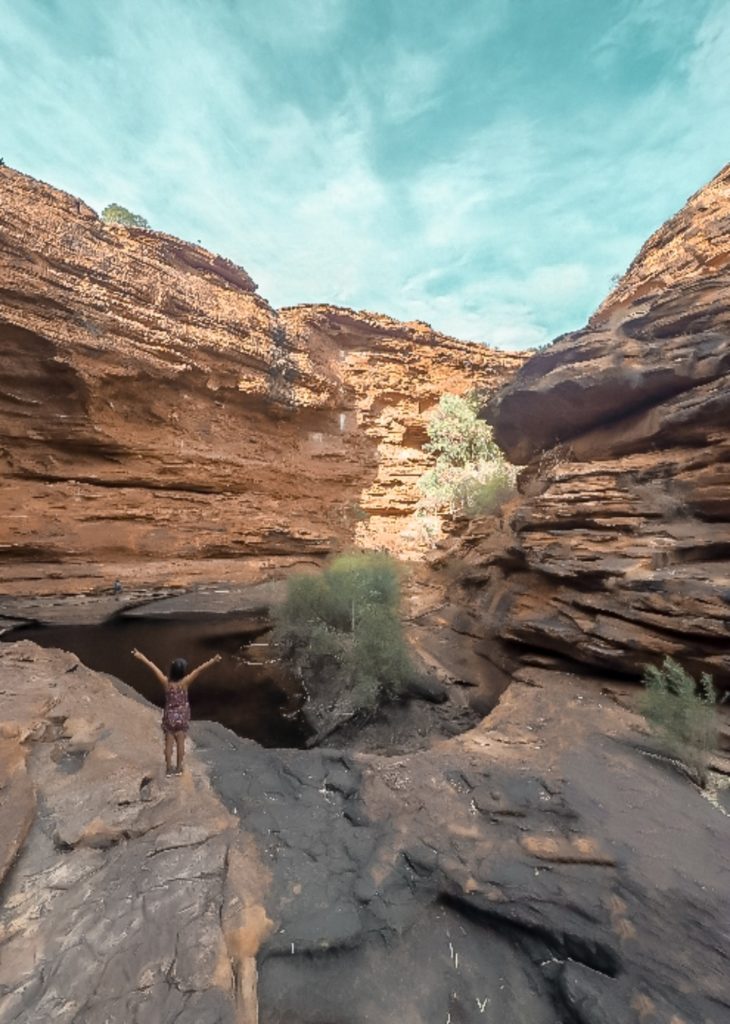
The next thing we did was to hike up and down through the Canyon to get to a hidden gem called “Garden of Eden”. It made total sense to sit there in speechless view and eat an apple! Garden of Eden was beautiful even with dark water holes and cliffs on all sides.
Camel rides in Uluru
Oh, and before I forget, we were also offered camel rides at the outback! These are wild camels, so they train and make use of them. If you are thinking about animal rights, just don’t go on it but a little selfie hurt nobody, right?
I recommend visiting Uluru the red center with the mindset to enjoy nature and time off of the internet/ social media. As a digital nomad, my work is all online and I admit it was hard for me to adjust on the first day. But as I engage with others on the tour, participate in the tasks, and gave myself permission to enjoy my time. I gradually stop thinking about work, phone signals, and WIFI. It was such a relief to just enjoy, be there, and not scroll through social media!
Uluru-Kata Tjuta National Park is jointly run by the Australian government and representatives of the Aboriginal society. They are so very polite not to put any gates or fences around the majestic Uluru. So, we can have a personal close look at this iconic landmark.
There is only a signboard that states please don’t climb Uluru. But despite that, there are people who climb it and leave their rubbish at the top and most importantly, risk their own life! 37 people have died at Uluru to date! It would be the best idea to respect the Anangu people and their cultures as you are on their land!
Flynet is basically a hat with a thin mesh net around it. There are A LOT OF flies around Uluru and they come out in multiple numbers in the daytime! I highly recommend buying a fly hat which costs under $10. You can buy this in Yulara or Alice Springs Pharmacy, Woolworths, or Coles. There were some people who came without it and you could see, every day it was a struggle for them! Also, fly repellent roll-on or cream would be handy as well but you would have to put them on frequently as it wears off. Therefore, flynet is the easiest option!
I can’t emphasize how important it is to drink at least a liter of water every day. And when you are in a dry area like Uluru, it is vital! DO yourself a favor, and bring at least a 1-liter water bottle with you. You can refill it on the coach for free!
I am one of those people who forget to put on sunscreen but not on this trip! Sun is super strong in Australia due to the thin Ozone layer. So, make sure you buy sunscreen and use it 1-2 times a day before you go out in the sun.
If you are going to be walking around hiking, I recommend packing cotton airy clothes as Uluru gets hot during the day. And for the nighttime, the temperature tends to drop like in the desert so pack a few warm clothes as well. Basically, packing light is the goal as it’s only a 3 day Uluru tour.
When you are walking the base of the Uluru or hiking up in the Kings Canyon, take note of the signs on the ground. Some sign reads there are sensitive sites so no pictures are to be taken and some have vital warning signs of steep cliffs and so on. Don’t miss these and you will be safe!
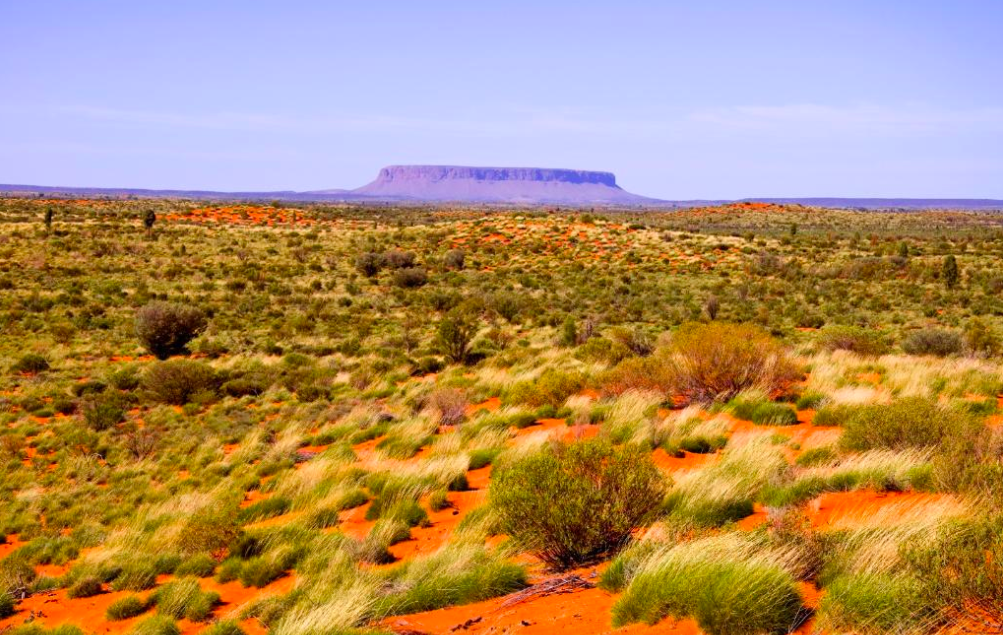
From the distance, even I thought Mt Connor was Uluru as they look quite the same from far! Pay close attention, you will notice the edges of Mount Conner and Uluru are different! Hence it is quite popular with locals as “fool-a ru”! Note: It is only possible to arrive at the base of the Munt Conner with a 4WD car.
I recommend strolling along a little further from the campground to watch the stars at night! Because there are minimum lights, the sky looks absolutely gorgeous with the million stars and the milky way! It is one of the must-sees in Uluru.
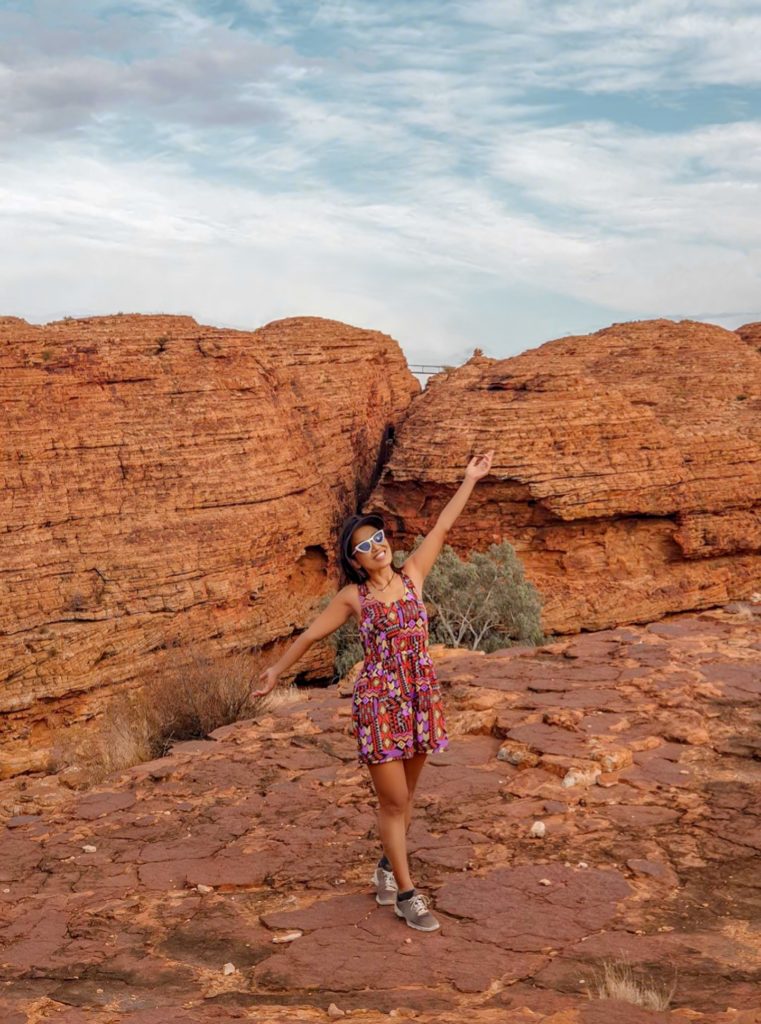
This one goes without saying but I’m going to include it as a reminder! You will be seeing some of the most beautiful landscapes in Australia so, bring your camera. If not, at least your phone to take some pictures as memories of your time in the outback. And don’t forget your charger, there are loads of charging points at the campground
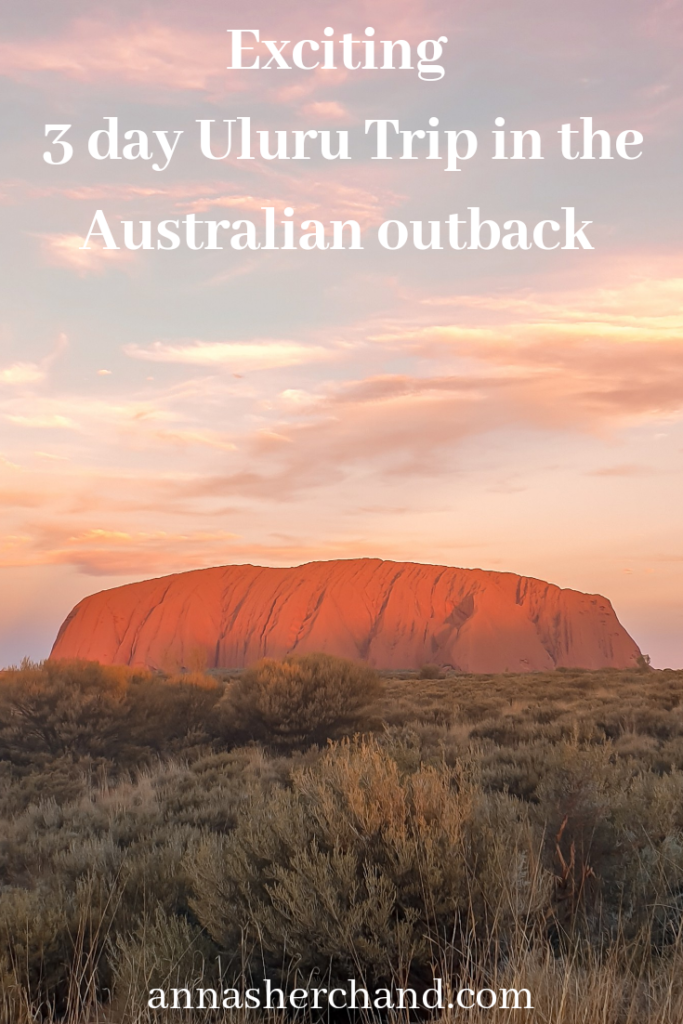
- When you are heading on the Uluru trip?
- Read the solo travel guide to Sydney, Australia
- Heading down south after Uluru? Read exploring Adelaide the best way.
- Read here for the solo itinerary to Canberra , another excellent short break destination.
- Check out the 10 best instagrammable cafes in sydney
- Sydney itinerary 5 days is here.
- Interested in 10 hidden beaches and bays in Sydney ?
- Here I share must do in Darwin , Australia.
- Solo travel guide to Brisbane (Insta worthy places included!)
- Over 90 things to do in Melbourne at night
- Heading to Melbourne next, check out Melbourne travel guide for first timers.
- Heading to Perth , Australia? read Perth solo itinerary
- How about weekend getaways from Perth ?
- Next Stop? check out the most beautiful places in New Zealand South Island.
- Going to Vietnam after Australia? Check out the 7 days Hanoi travel guide.
- If you need to book accommodations for your next travels, get a $76 discount with Airbnb here.
- Alternatively, you can check hotel prices and book it through trusted Agoda , or Booking.com
- Read the most wanted travel resource here.
- If you like this article, follow my adventures on Instagram , Facebook , YouTube , Twitter , and Pinterest , but most importantly sign up to my email list to keep up with updates and travel posts!
- ← Teaching English in south east asia
- Top 5 must do in Darwin, Northern Territory of Australia →
You May Also Like

Best things to do in Portarlington, Victoria

Experience Paradise: Day Trip to Stradbroke Island

5 tips for moving from Sydney to Melbourne
27 thoughts on “ exciting uluru trip – the must-read guide ”.
Australia has always been one of those countries we’d love to visit. The country is just rich in beauty. It’s always felt to me to be an exotic place, and your post really shows that.
I would love to visit the outback one day. It has such a diverse geographical profile, and the wildlife there is amazing.
I would love to visit Uluru. I wish the official name was Uluru as the aborigines intended instead of Ayers Rock, the name of the colonizers.
Gorgeous! I would love to visit Uluru someday. It seems like a hiker’s paradise and a great place to become one with nature.
I’m learning about Uluru for the first time, and this place looks marvellous! What a wonderful way to catch the sunrise! 🙂
Uluru looks stunning! The landscape is so unique and captivating. All your pictures are fantastic too! followed in Instagram!
Your photos are gorgeous. This reminds me of our trip to Sedona, Arizona, USA. They have massive red rocks like this one.
Detailed background information about Uluru! Just what I’m after… the sunset and the moonrise at Uluru are absolutely stunning. I will add this to my Australia travel bucket list.
Wow. Those natural rock formations are so beautiful. I would love to watch the sunrise at Uluru too. That must have been such a beautiful sight to witness.
I’m heading there in Australian Summer and this info is super handy! Thanks Anna
I have yet to make it to Australia. Hopefully in a couple of years. You took some amazing photos!
What ADVENTURE! The photos are breathtaking. Have always wanted to go to Australia. Followed you in IG too
I would love to go there some day! Those rock formations are just stunning!
The photos are sooo nice! I am still waiting for my foot to step on that Australian dirt! Hopefully soon!
This looks like such a pretty place to explore! You packed a lot of information in this post, love all the detail!
WOW!! I bet that was a fantastic trip – those photos look AMAZING!
This is beautiful and looks like fun-filled trip. It’s really a beautiful place to go. Putting it on my bucket list.
It is indeed a lovely place to explore, Such great captures I must say that and your description is lovely and the view looks really awesome.
This looks like a great place to visit, I’ve never been to Australia. However, after seeing your pictures and reading your post, it definitely looks like I’m missing out!
Such beautiful photos! This is completely and utterly spectacular! I would love to travel here so much. Thanks for sharing
It is simply amazing to read the number of things that one can do at Uluru. I love hiking and sunsets, this place has both!
Australia is one continent I’ve never been to but have always been interested in going to. What’s striking from your pictures is how dry and desert-like Uluru seems. I always thought of Australia as a bit more green and plush than this. Is this just how it is in the more central parts of the region?
How exciting! Australia is def on my list so having these tips is awesome
Wow what a trip! Australia has been on my bucket list for as far as I can remember. It’s just a long way to go and I hate flying!
hi, Good post and good precautions you said here. Thanks
Great post and information, however, please note that there is an airport at Uluṟu – AYQ Ayers Rock Airport is 6K from the Yulara Resort area. Direct flights from most Australian cities service AYQ and complimentary transfers to most Hotels are offered
Thank you for your input Maxine. Appreciate it.
Leave a Reply Cancel reply
Your email address will not be published. Required fields are marked *

Uluru Itinerary – 2 Days at Australia’s Famous Desert Rock
Last updated: 7th January 2022

Our whistle stop self-guided tour of Australia continued and after touring Sydney next up was Ayers Rock, or by its aboriginal name Uluru. We were incredibly excited to see one of the world’s greatest wonders . In this post we’ll show you our Uluru itinerary for 2 days and the best things to do in a short time.
Table of Contents
Arriving at Ayers Rock Airport
We transferred by planes from Sydney via Alice Springs and got an amazing view of Australia’s famous desert rock as we came in for landing at Connellan Airport (Ayers Rock airport). It was a rather bumpy flight from Alice Springs, Phil compared it to like riding the Big One rollercoaster in Blackpool! Stepping out of a plane the extreme dry heat hit us (39ºC) and gave us a taste of what was to come. We quickly headed straight to the air conditioned arrival hall to get our hire car for the next 2 days in Uluru. The airport looked like it had an airplane graveyard too, which was an eerie sight of abandoned unmarked planes parked in the desert.
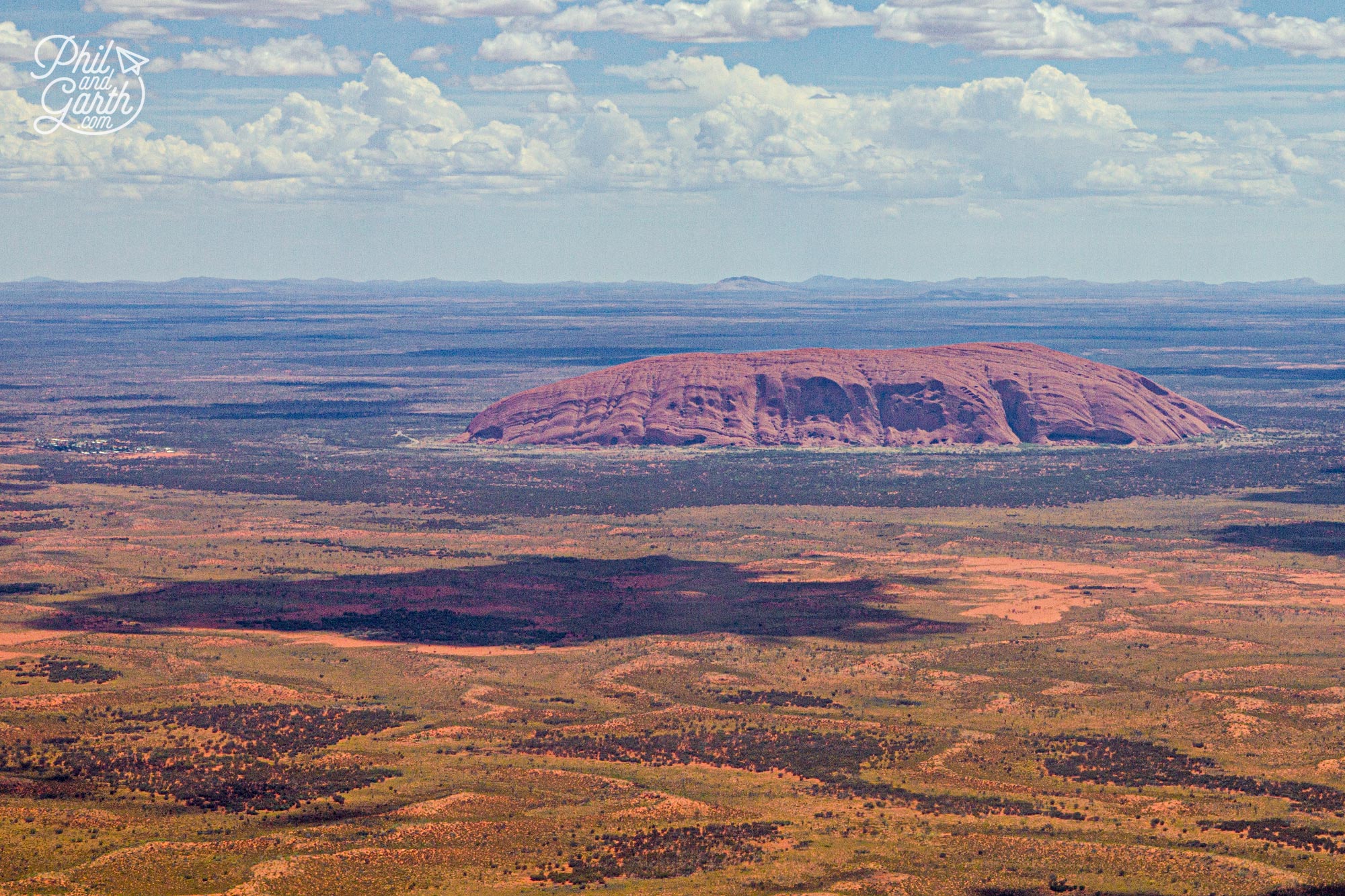
Our fabulous view of Uluru and the town of Yulara as we came into land
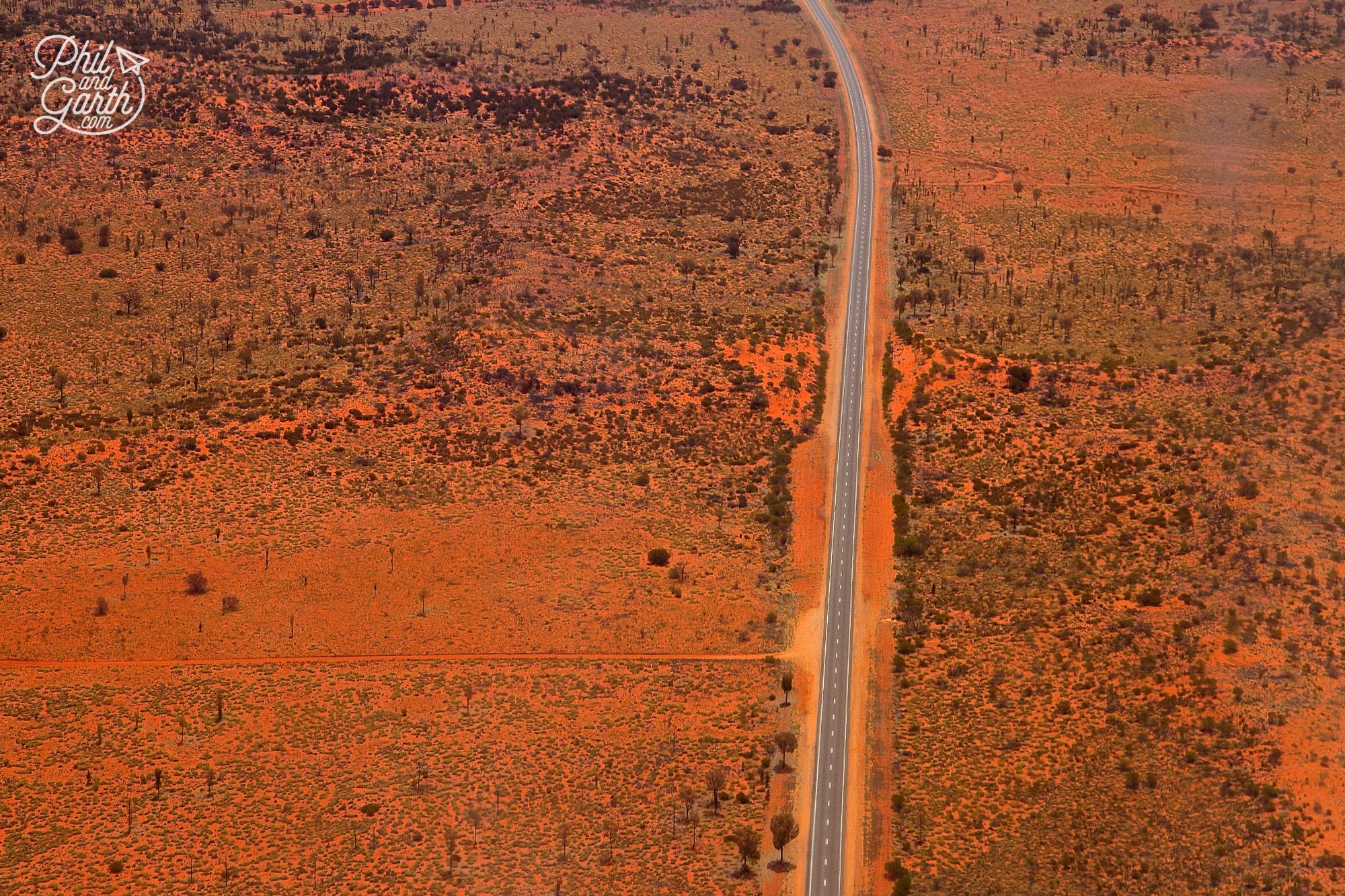
The wild Australian outback as seen from the air
Yulara – Ayers Rock Resort
Garth drove us to our hotel – The Outback Pioneer just 9 miles from the rock. It’s situated in the town of Yulara, best known as Ayers Rock Resort , a strange place where you realise the ‘town’ is actually one huge resort comprising five different hotels from 5 stars to a campsite, with shops and restaurants – so you basically have no choice, but to go to what the resort is offering, as it’s all owned by the same company. Our hotel was the cheapest in Yulara, the room was basic, but it was comfortable and the hotel had a small pool, which we used to cool down. Garth has a phobia of cockroaches and there were a few outside our front door, so we stuffed a towel under the door gap at night, just in case!
The hotel catered for the masses, including many backpackers, but it’s do it yourself BBQ was excellent and good fun. You queue up at the meat counters and buy what you fancy we chose Kangaroo, Emu and Crocodile sausages and steaks, you then head over to the BBQ’s and choose one, there are 10 or so and there was always one free, so you can tick off that Aussie barbie!
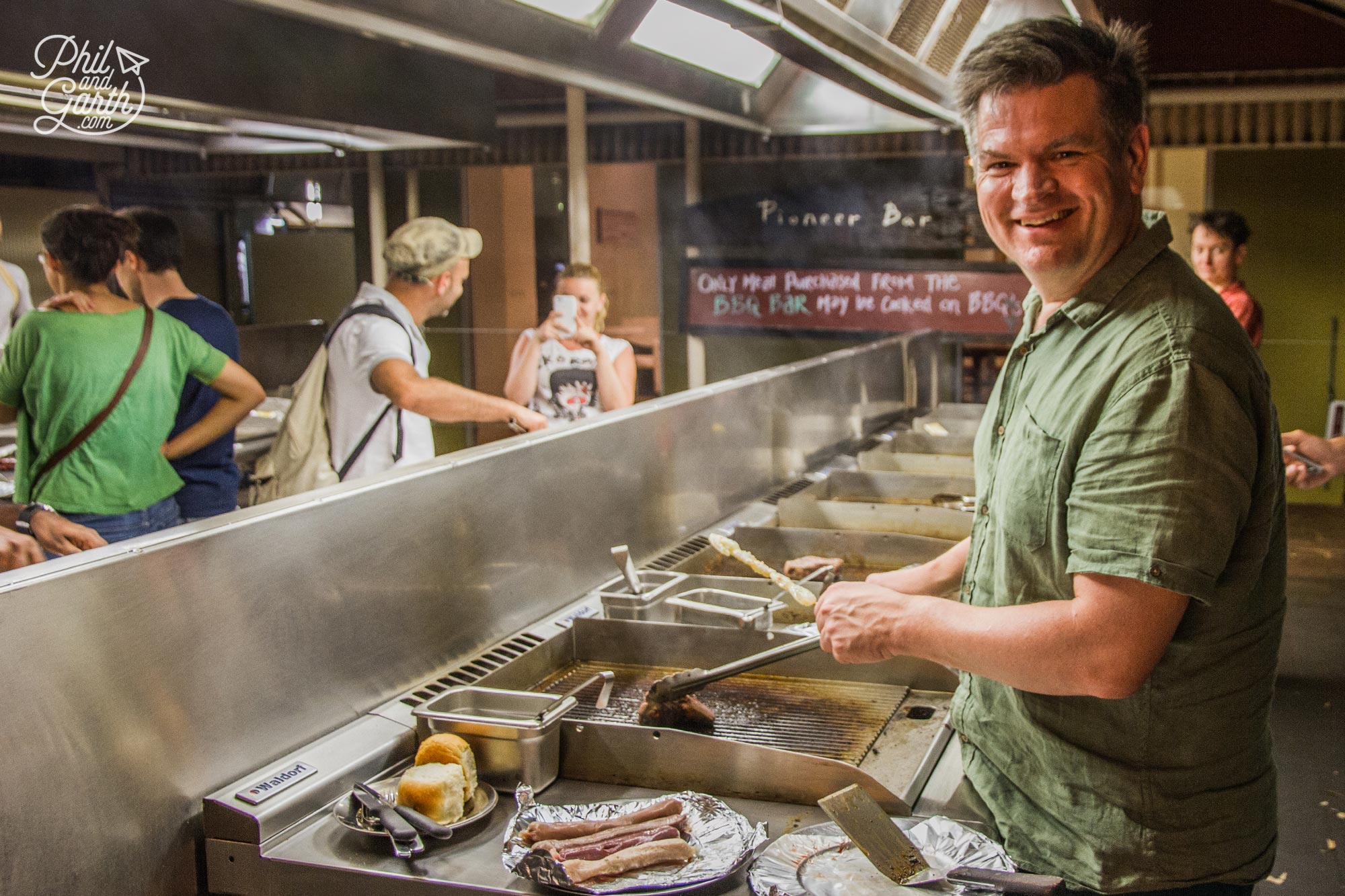
Phil using the Outback Hotel’s DIY BBQ
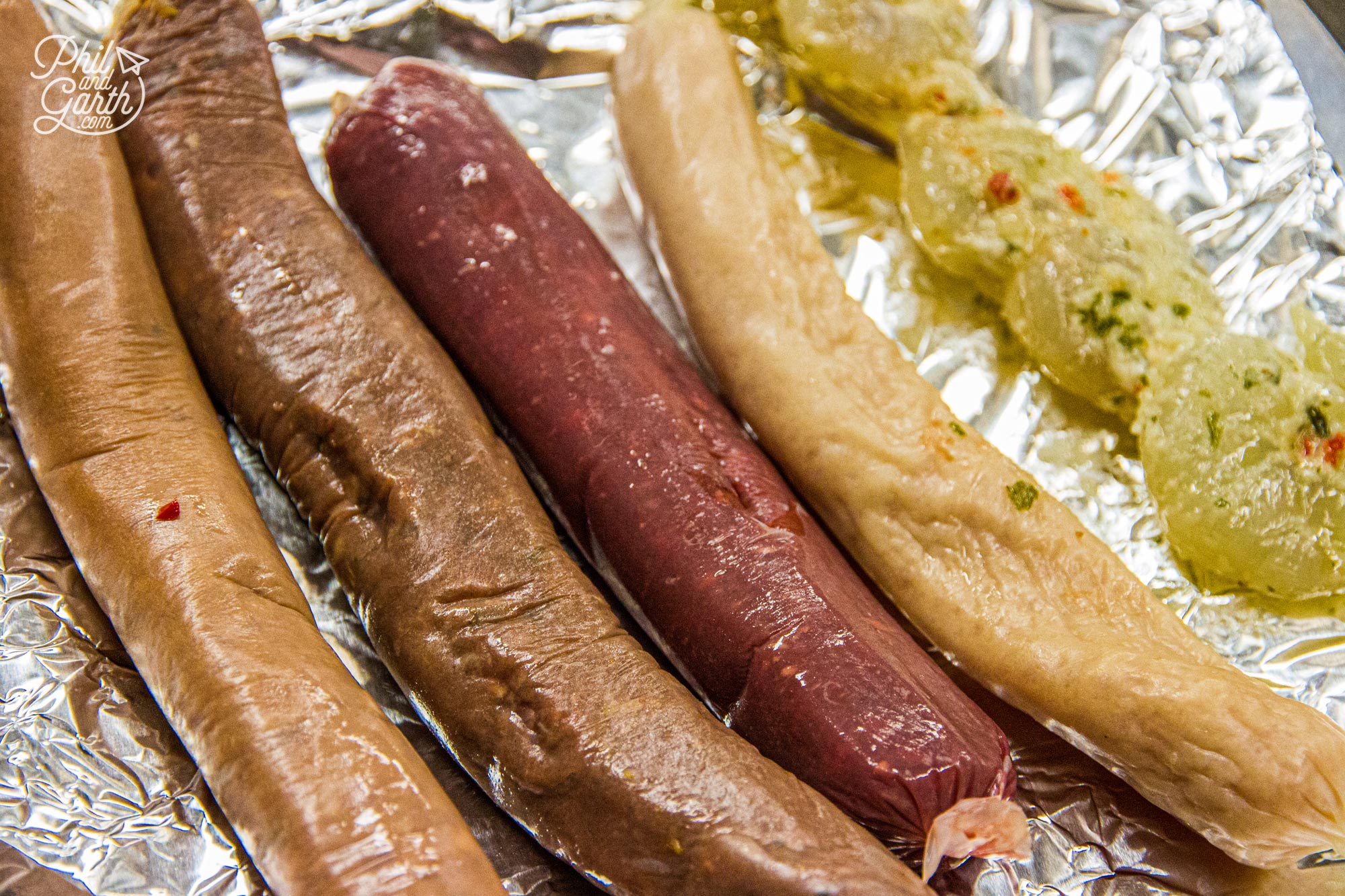
Ready for grilling Kangaroo, Emu and Crocodile sausages
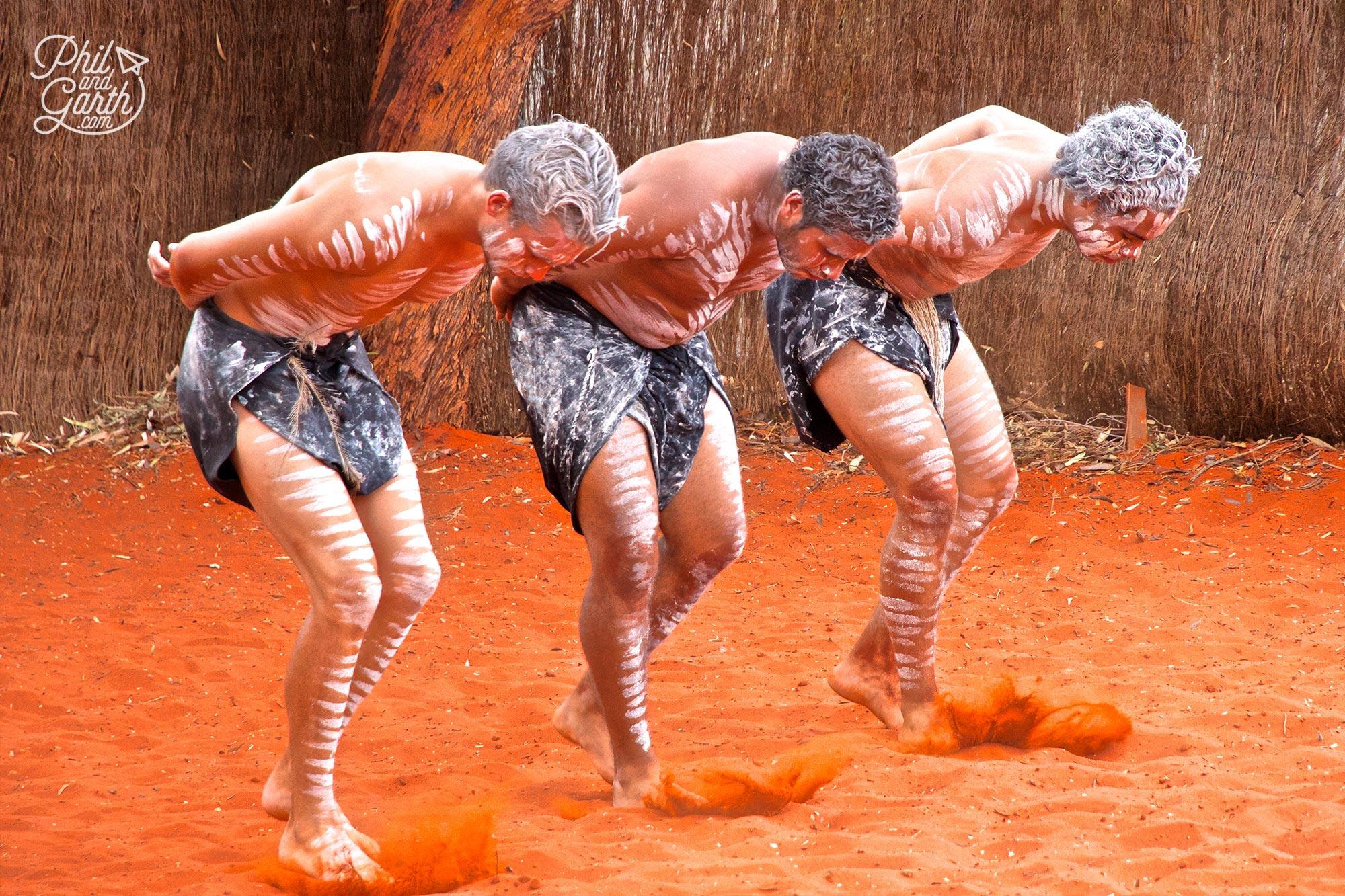
Indigenous ‘Wakagetti’ dance everyday at 4pm at the Town Square lawn of Ayers Rock Resort
Uluru Itinerary
Day 1: uluru-kata tjuta national park.
For the first day of our Uluru itinerary we drove out to the entrance gate of the Uluru-Kata Tjuta National Park. To enter the park you need a ticket which we bought in advance online . The ticket costs AU$38 it is valid for 3 days to explore this UNESCO World Heritage Site .
Seeing Uluru is awesome, you really can’t comprehend the sheer size and beauty of the rock from TV or pictures, until you get up close, a bit like seeing the Grand Canyon for the first time. You also realise just how remote Uluru is the middle of the desert, the nearest town of Alice Springs is 280 miles away.
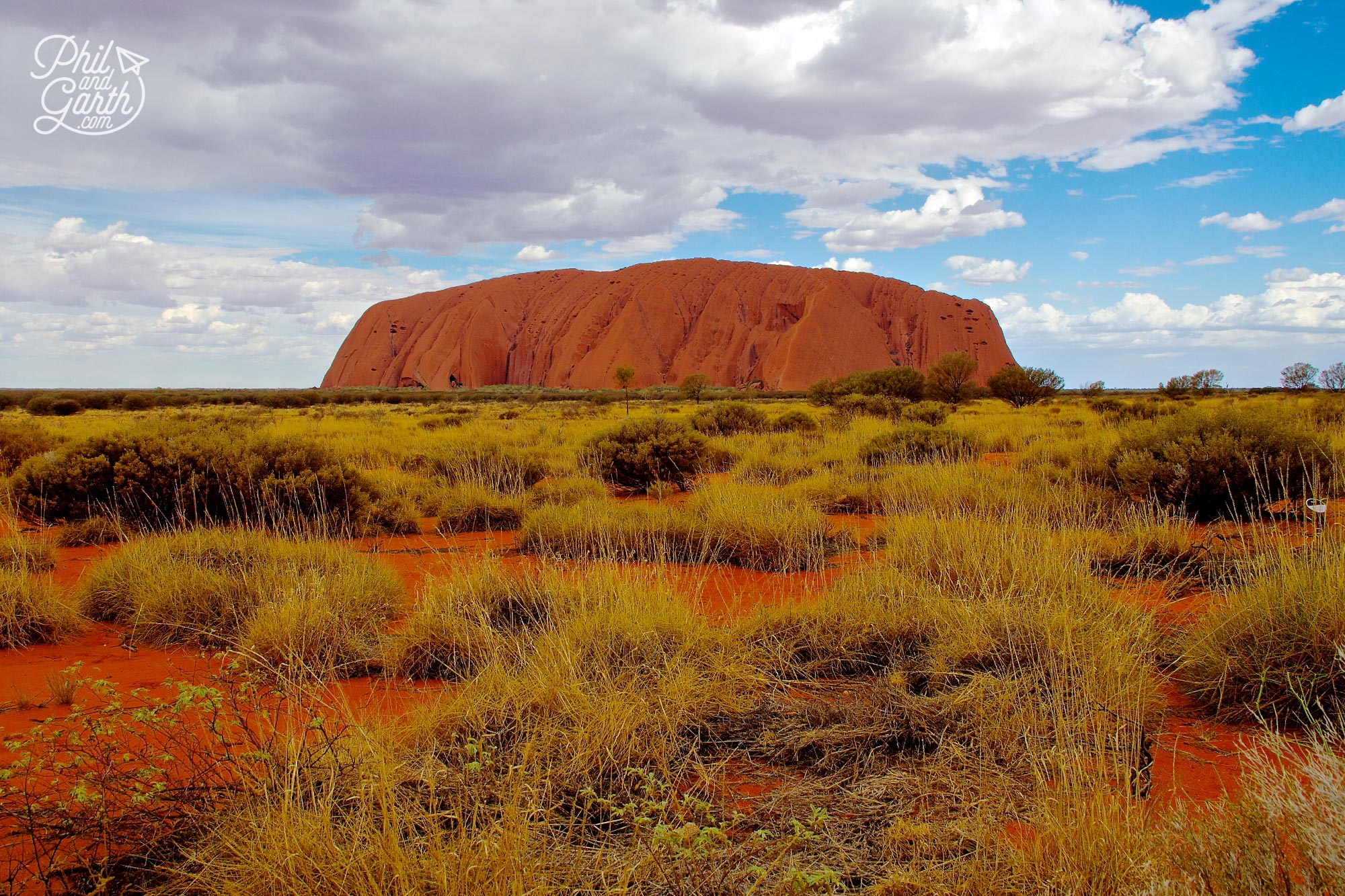
Day 1 of our Uluru itinerary and we start with a fabulous view of Uluru
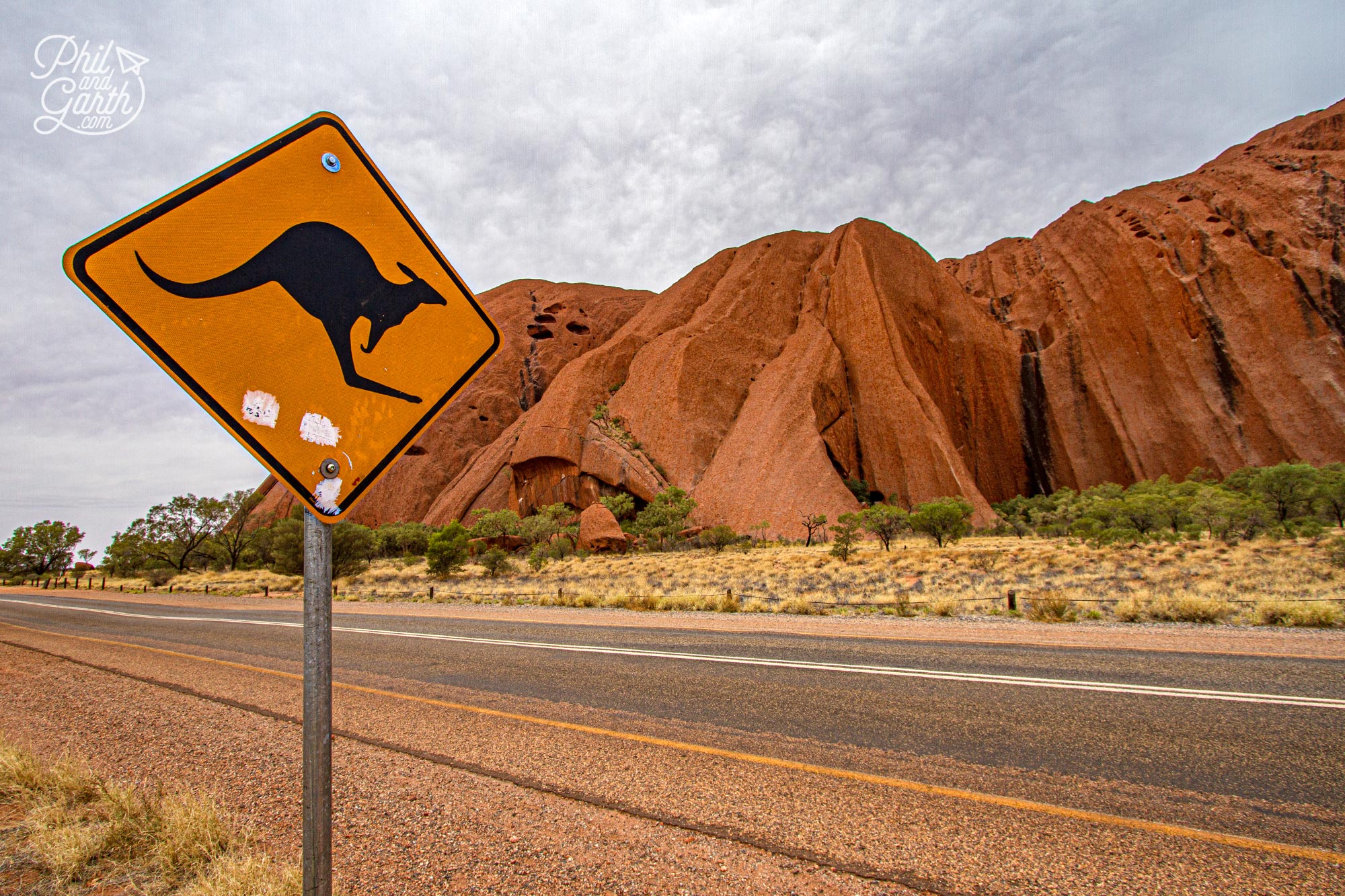
Driving around Uluru-Kata Tjuta National Park is really easy
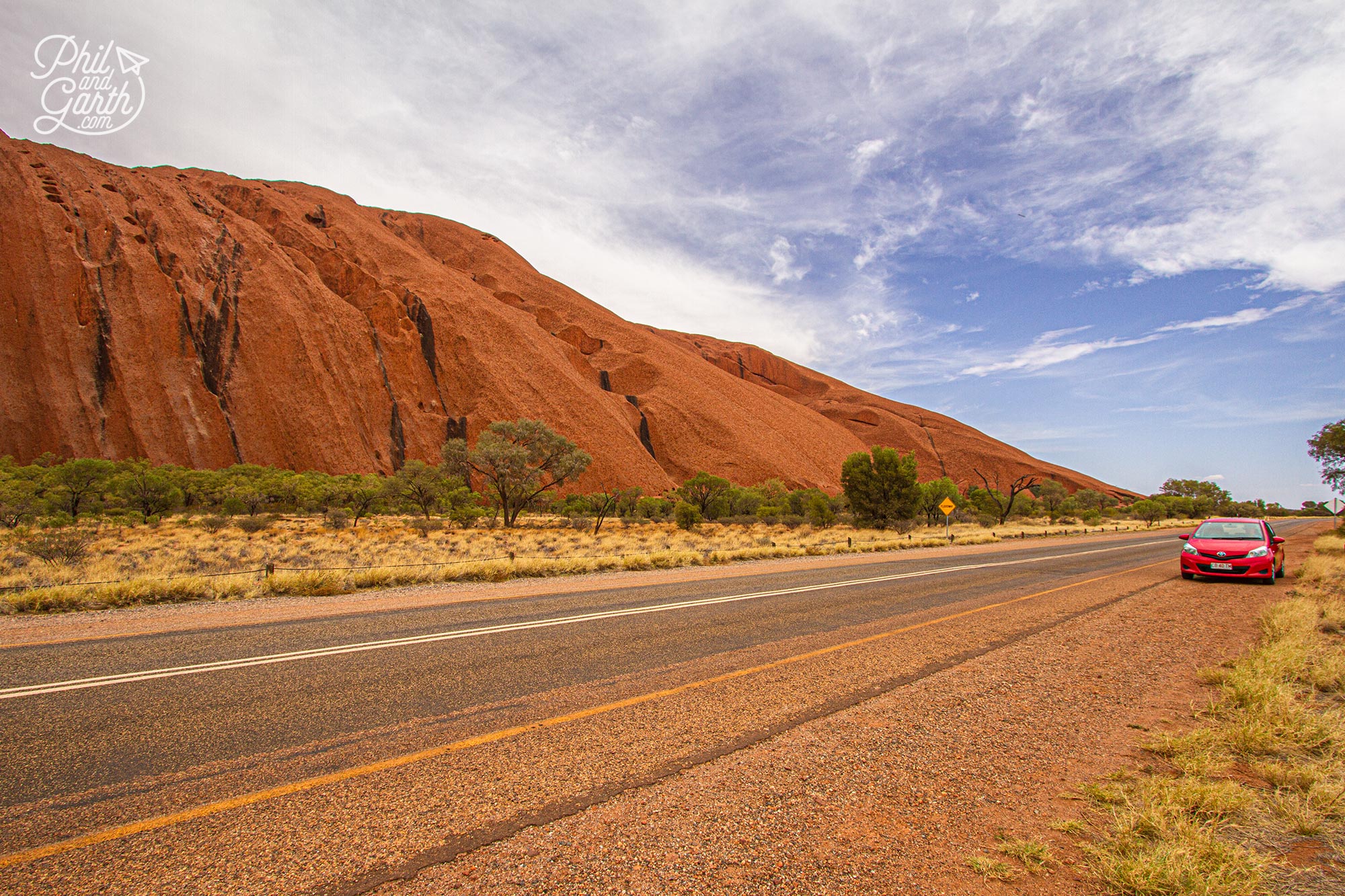
Our delightful little hire car we used for our 2 days in Uluru of sightseeing
Driving around the park is really easy as your ticket includes a map with the various viewing points. There are signs to look out for camels but we didn’t see any. We went in low season in January which means extreme heat and Outback flies, oh my gosh, the flies! I’m not sure they all come from because the place isn’t dirty at all, but they are absolutely everywhere. We had read about the issue of flies and bought face nets off eBay before we came. You can buy them from the shop in Yulara but if you arrive in the evening it may not be open. Do you really need the nets? OMG YES! they’re not attractive, but be warned without them the flies will be up your nose, in your ears and you’ll have a miserable experience, we took them off for a couple of photos, but they went straight back on as soon as the shutter had closed!
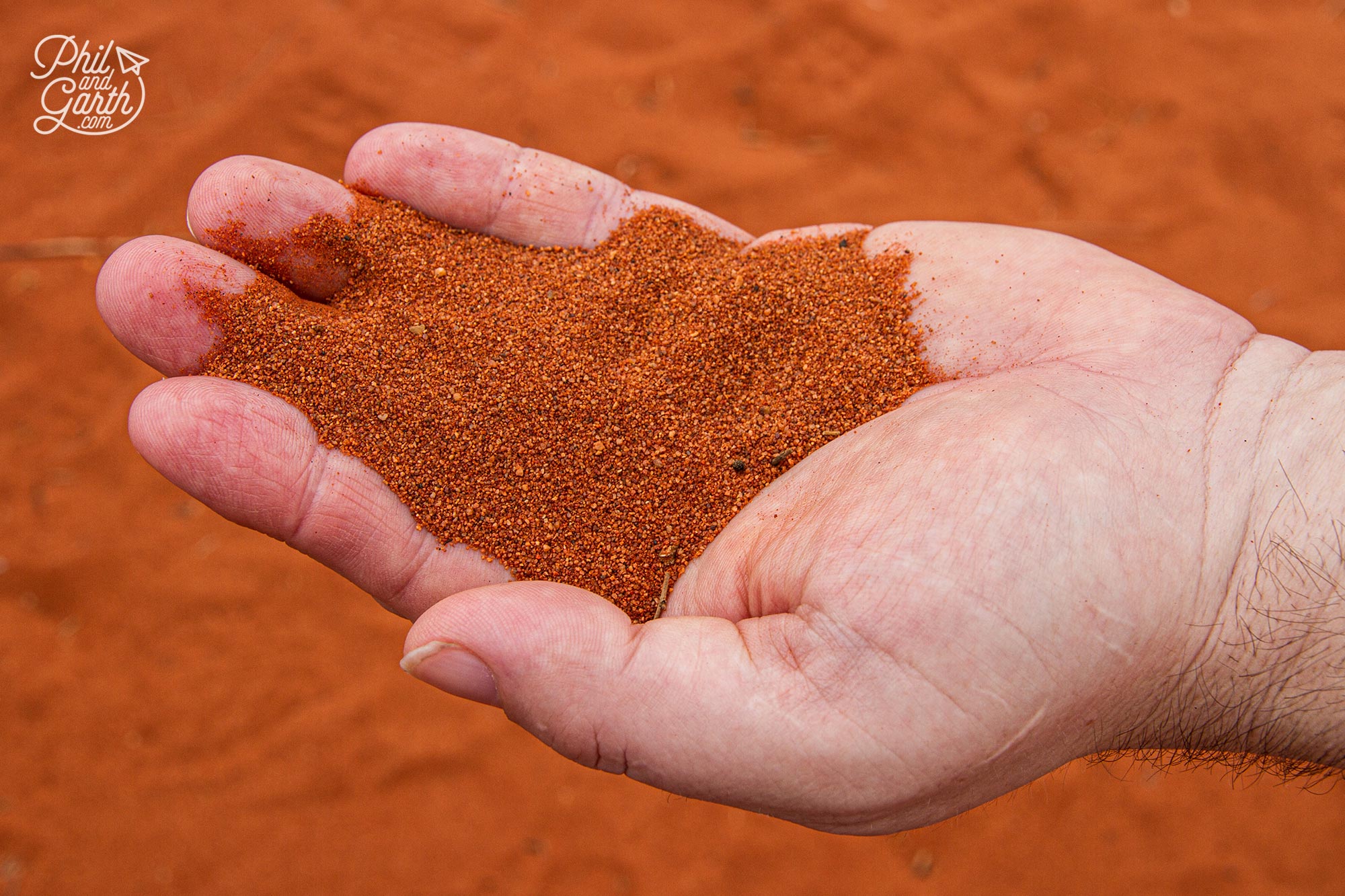
The rock and sand is red because of the iron in the rock which turns rusty
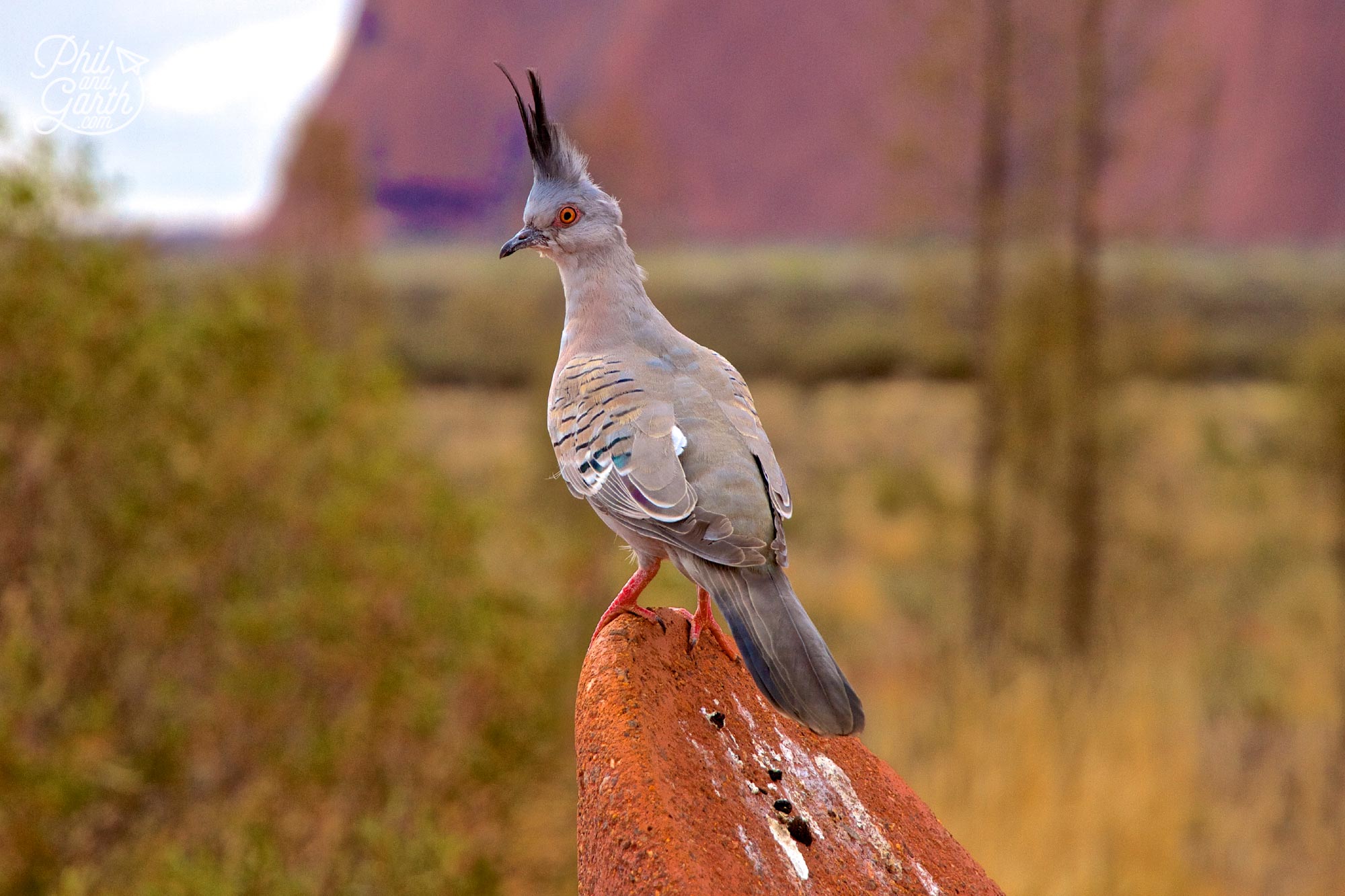
There’s lots of wildlife at Uluru, we saw lizards and this crested pigeon
Uluru-Kata Tjuta Cultural Centre
We then headed to the Cultural Centre for lunch, the restaurant there made us laugh, with just two items for sale, a generic pie and a cheese sandwich. After eating we sat and watched the centre’s video to Anangu people, Aboriginal culture and the sacredness of Uluru. The video is interesting but in desperate need of updating and cutting down from what felt like a 2 hour movie. The souvenir shop has some great Aboriginal artworks to buy, but a little bit too pricey for us to warrant the souvenir.
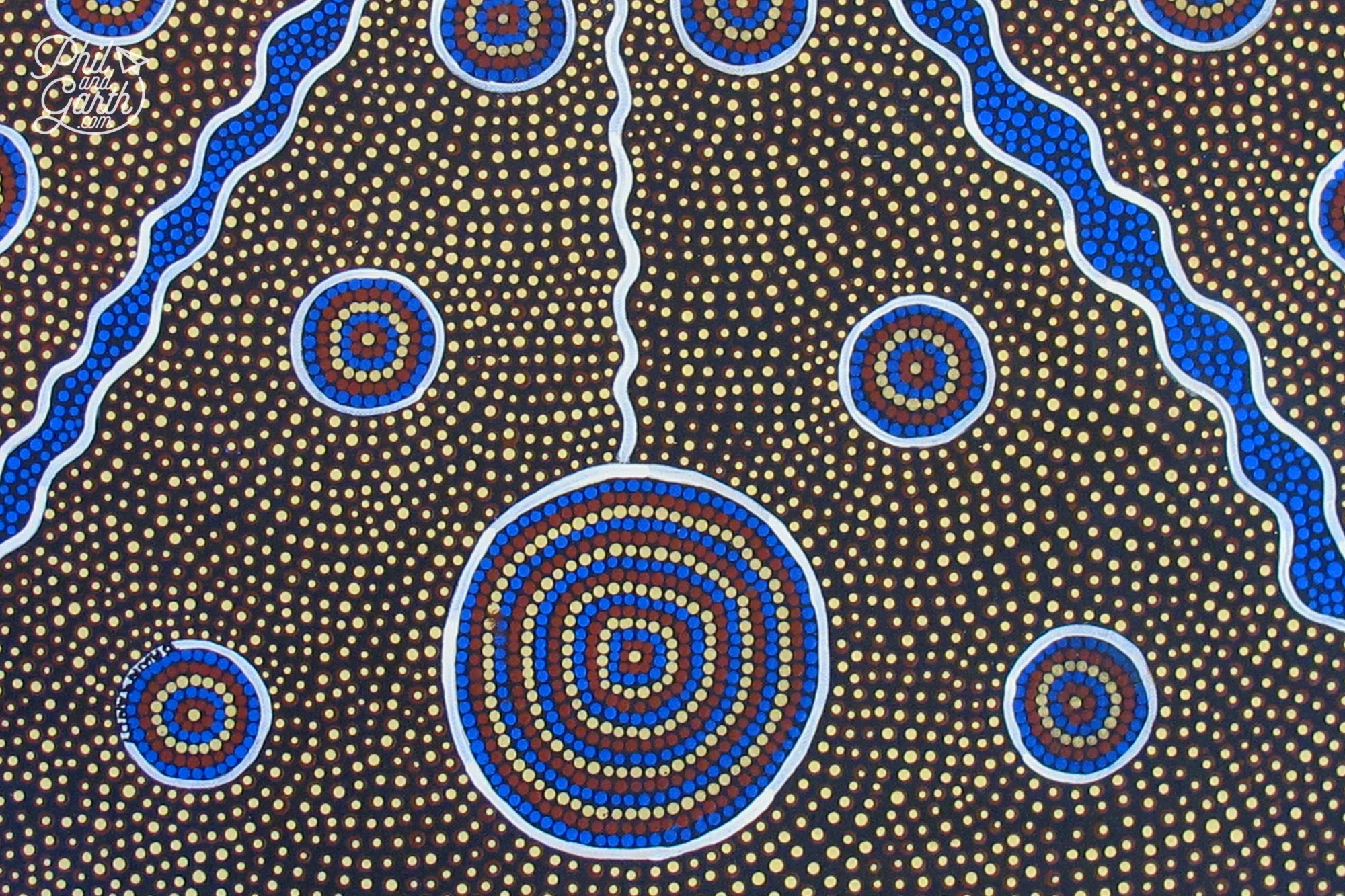
Aboriginal art, souvenirs, snacks and drinks can be bought from the Uluru Cultural Centre
Tips and Precautions from the Cultural Centre
- Hike in the cooler parts of the day, before 11.00am
- Walk with another person at all times
- Always stay on the designated tracks
- Familiarise yourself with the symptoms of heat stroke – such as dry mouth, clammy sweating, dizziness or nausea
- Temperatures at Uluru are considered extreme once it reaches 36ºC – certain tracks will be closed.
Hiking around Uluru
We spent the rest of the day hiking the suggested base walk around Uluru which takes 4 hours. Along the route we came across waterholes, birds and some tiny flowers. There’s also various caves where we read stories about the Elders of Uluru. Men had their own caves and the women had theirs. There are even some caves where you can get up close and see ancient cave paintings, the women’s kitchen caves still have the areas where food was ground and cooked in.
The reason the rock is red is due to the amount of iron in the rock itself. As it reaches the surface it oxides – basically goes rusty.
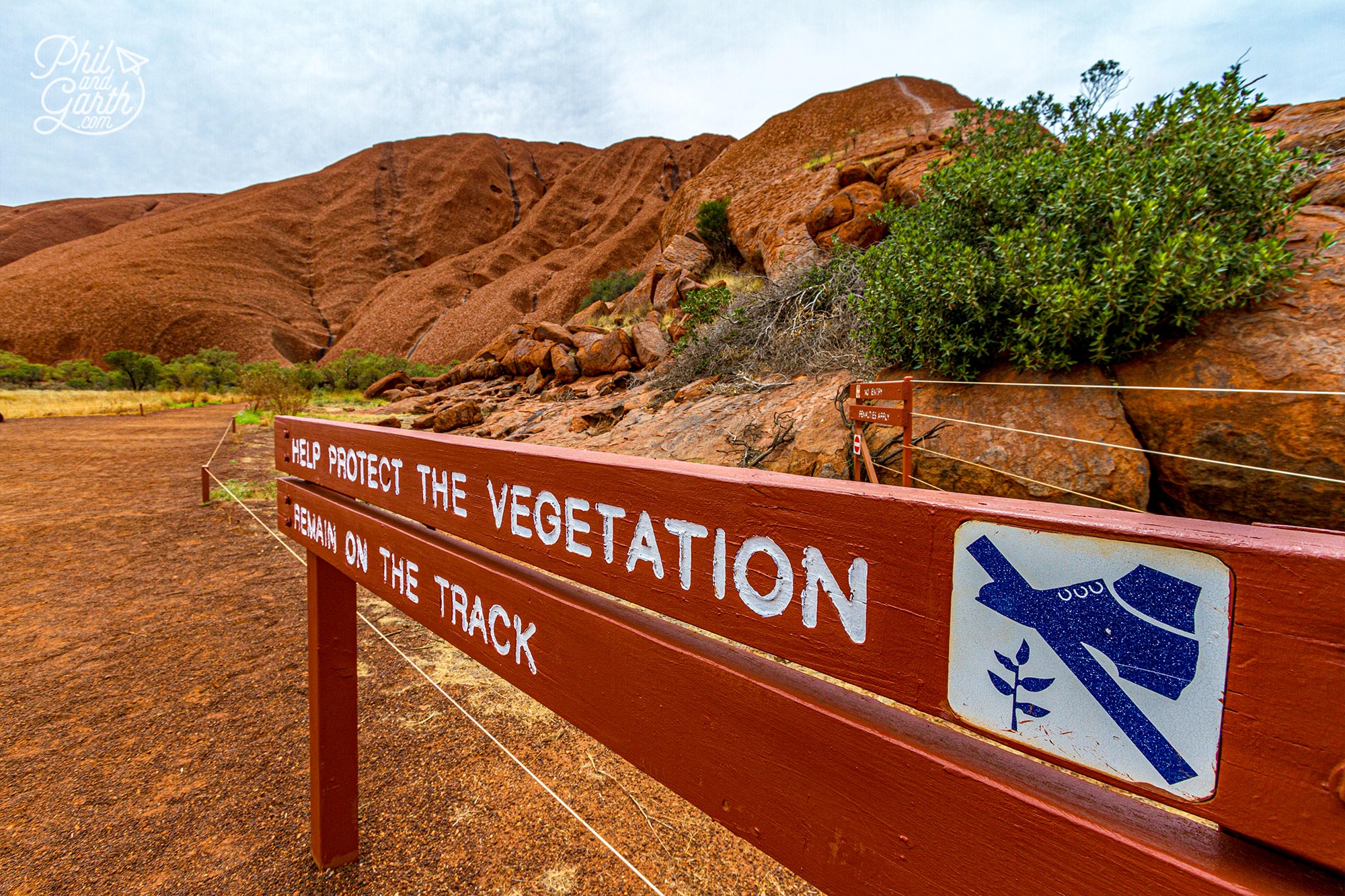
From the Mala car park take the 6 mile circular base walk around Uluru
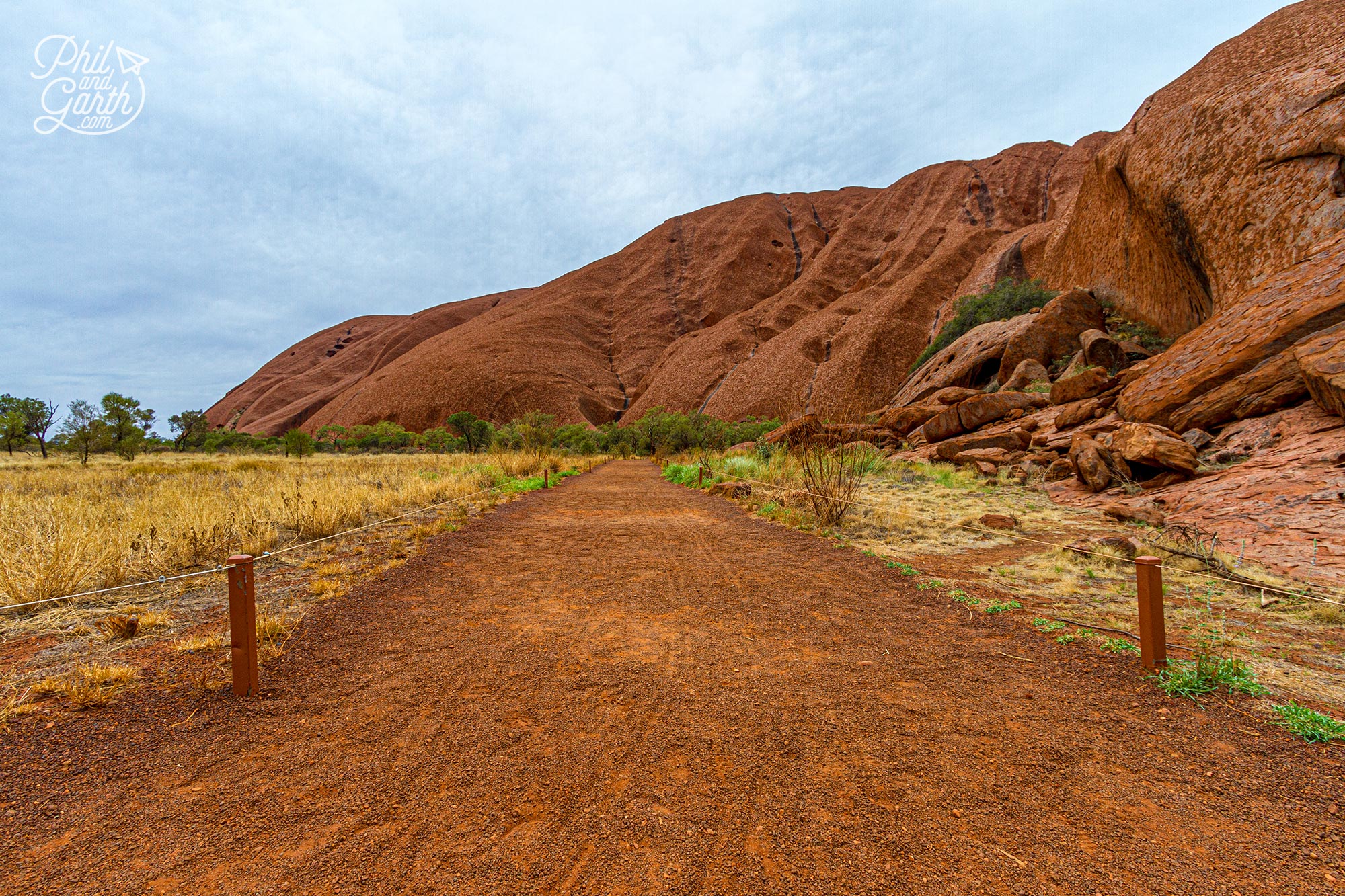
The start of the Uluru base walk
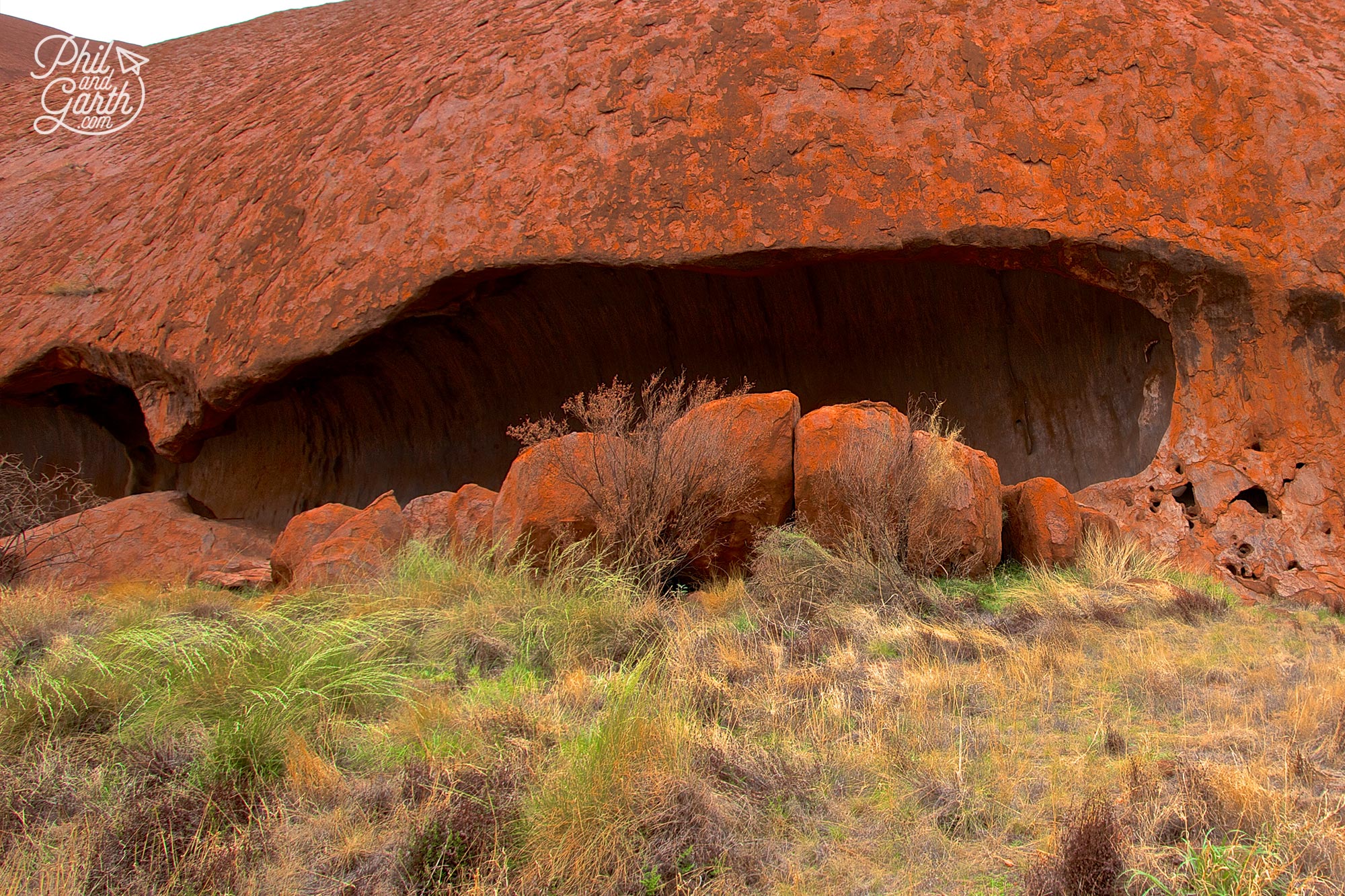
Kulpi Minymaku – The Kitchen Cave
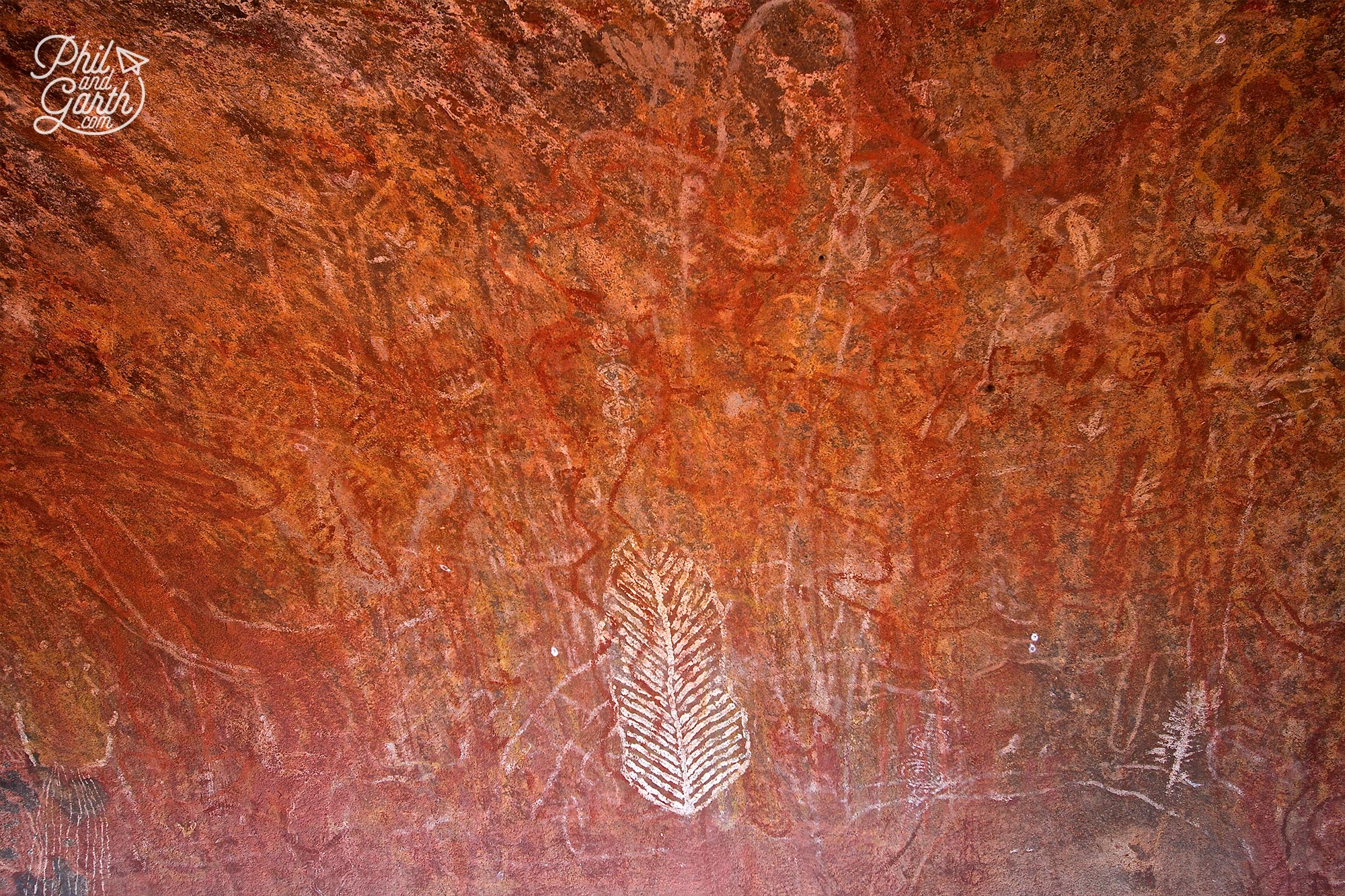
Ancient Aboriginal cave paintings
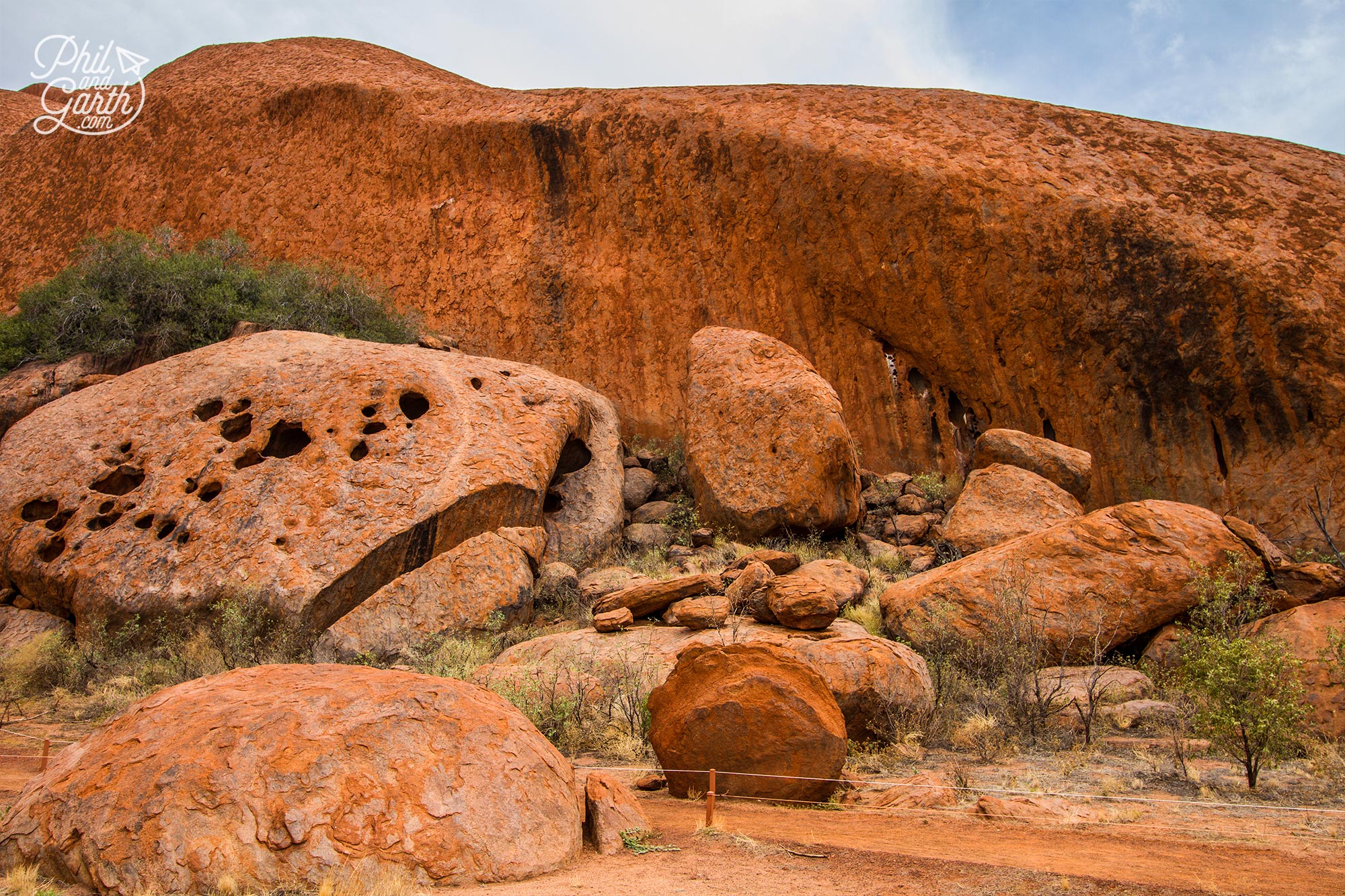
Rusty orange views of Uluru close up on the walk
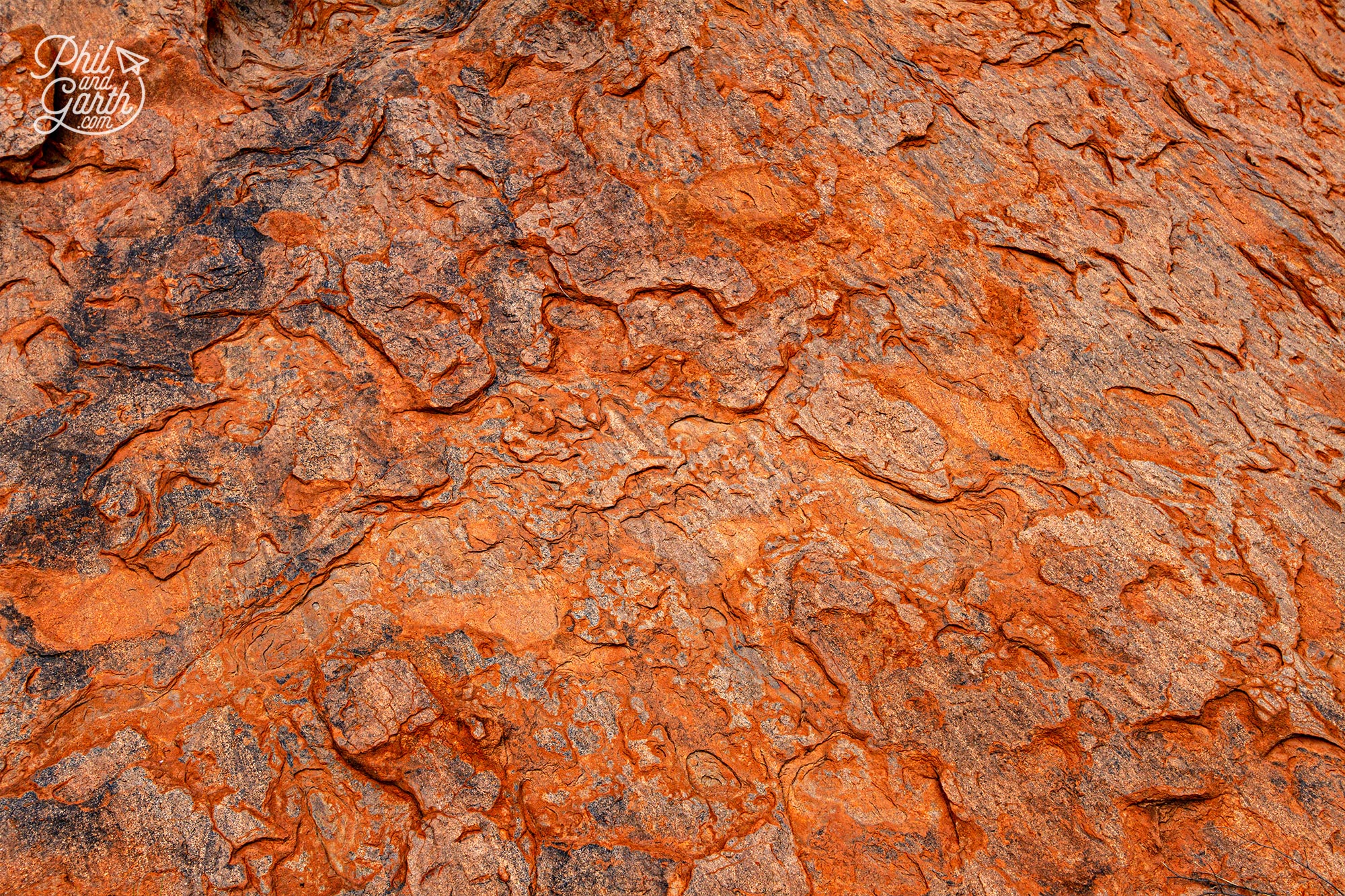
A close up of Uluru’s rough surface texture
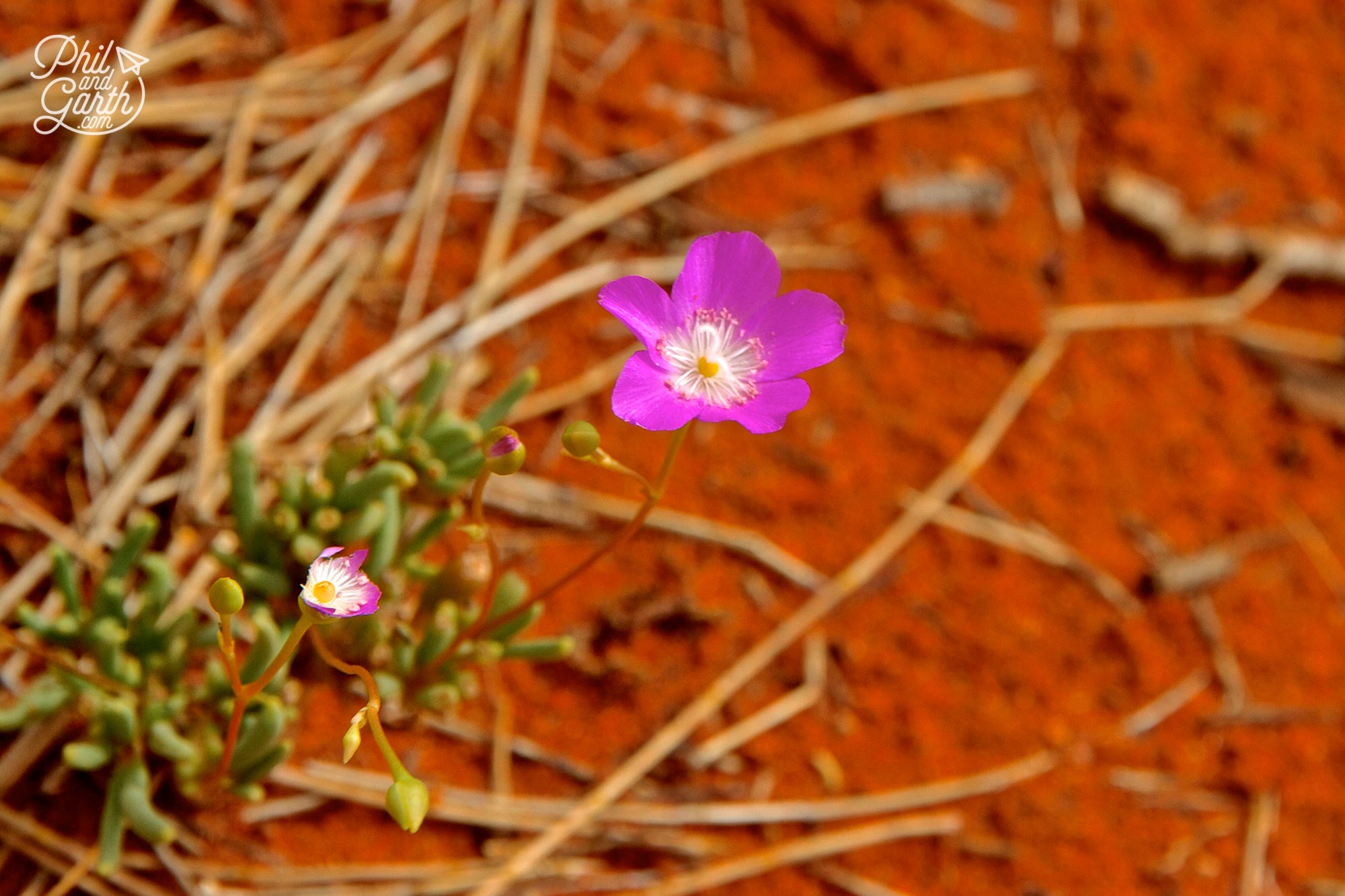
Delicate little wild flowers on our base walk around Uluru
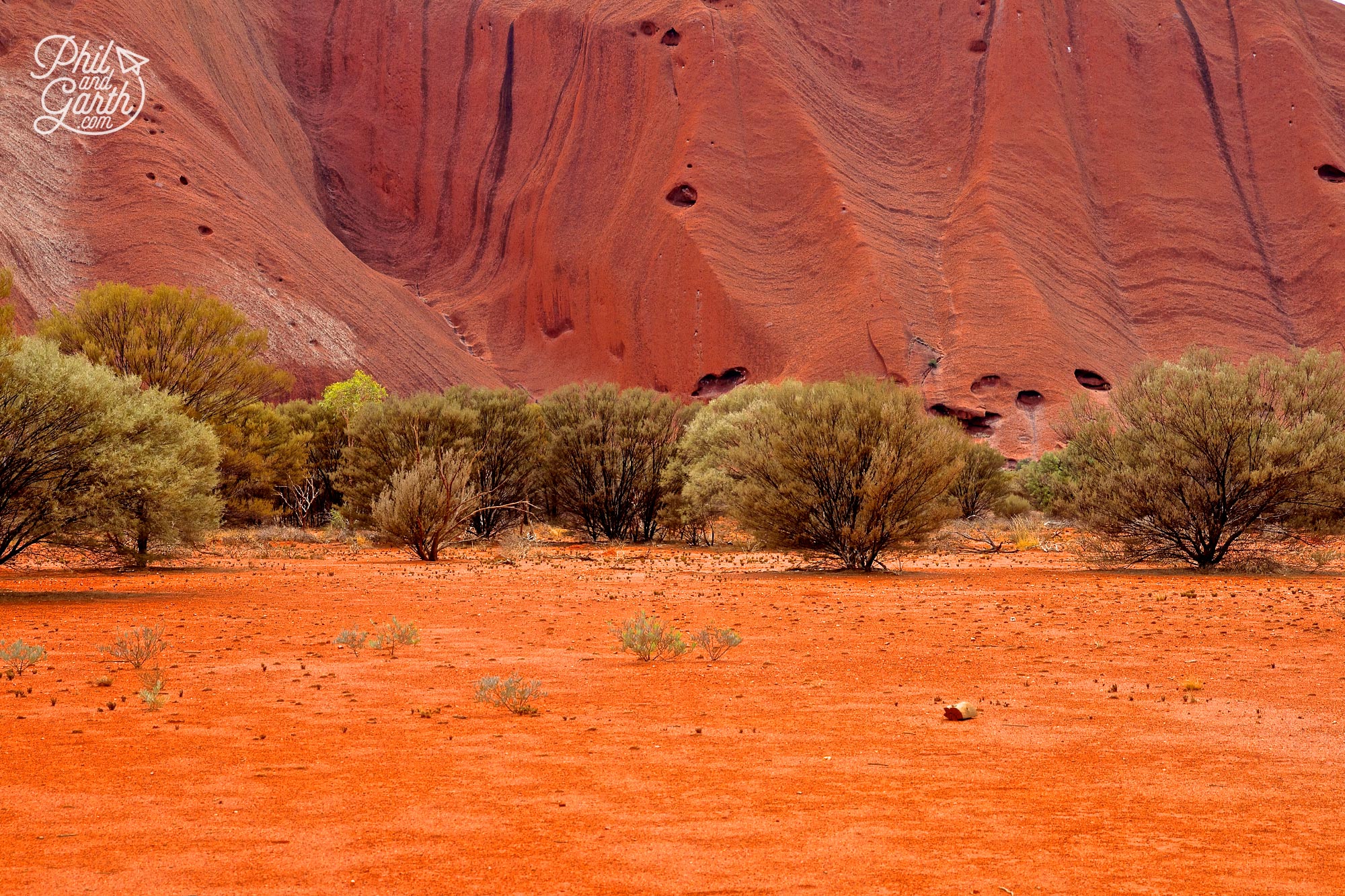
The fabulous colour palette or earthy reds and oranges change hues throughout the day
Photography is not permitted in certain sacred parts along the routes, these were clearly marked and we respected this. The area of the rock, that you can’t photograph tells a story which is passed down from mothers to daughters though the ages.
Climbing Uluru
Climbing and hiking to the top of Uluru was banned in October 2019. In the past hundreds of people had climbed and even died its strenuous hike to the top. It was considered controversial because the Anangu people asked tourists not to do this and respect their culture. They won their battle and now the sacredness of Uluru has been restored.
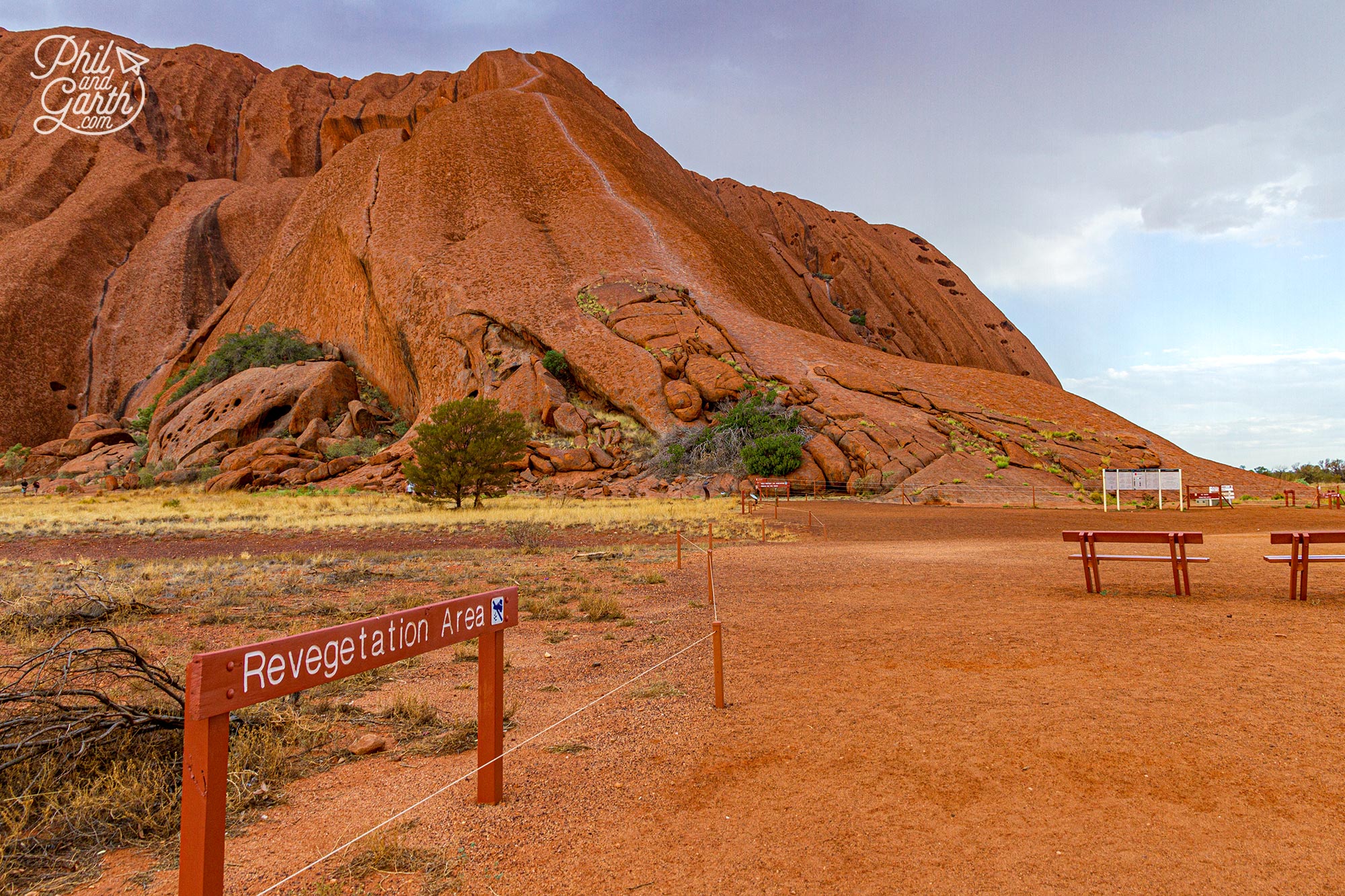
Climbing up to the top of Uluru was banned in 2019
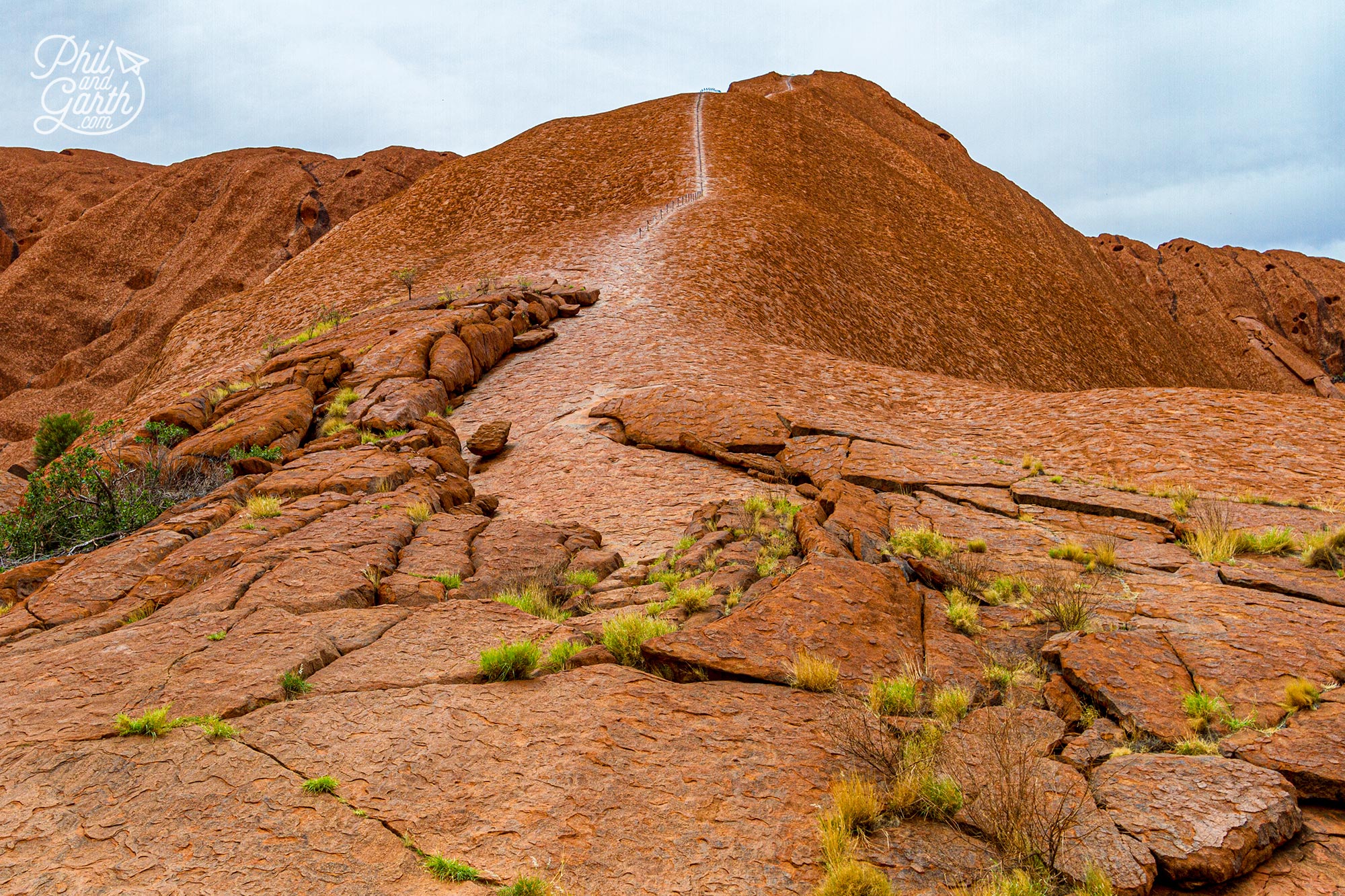
The old hiking path
Uluru’s Extreme Heat
Uluru is beautiful but it is a harsh environment in the heat. There are warning signs everywhere not to under estimate it. Heat stroke, exhaustion and dehydration are very real dangers. So make sure you wear a hat, cover yourself in suncream and wear good hiking boots too. Carry at least a litre of water per person per hour, and avoid sports and caffeinated drinks as these contribute to dehydration.
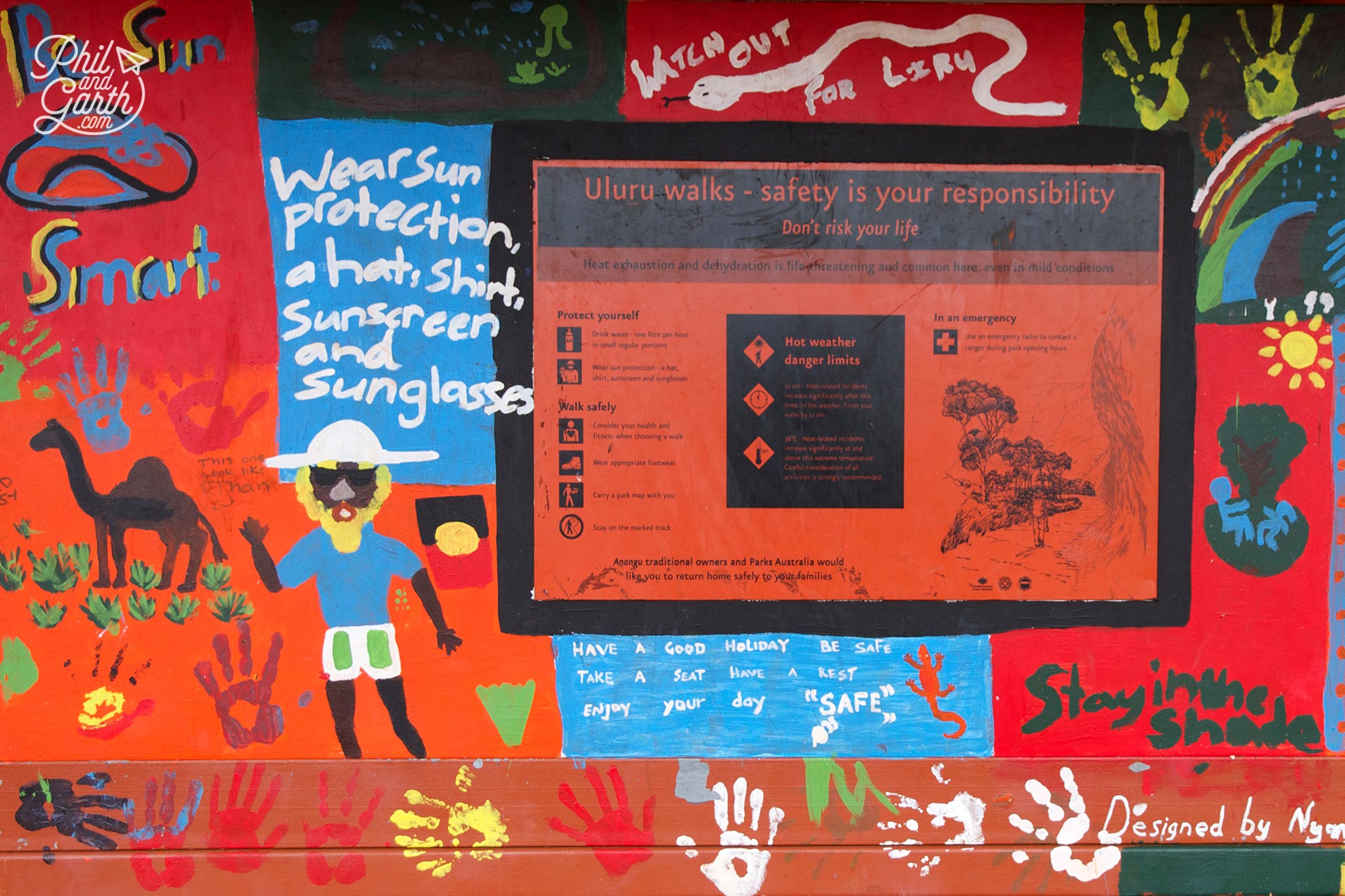
A sign warning of the dangers of the extreme heat at Uluru
Uluru At Sunset
Evening and it’s time to drive to the sunset viewing car park, this is a real highlight, as well as the perfect opportunity for taking the obligatory tourist shots of both of us of the sun setting on the rock. It’s just magical spending time watching Uluru change colours from orange to a blood red and its texture change from the the long shadows cast. We kept saying to each other, are we really stood in front of Uluru!? It was special and somewhat surreal too, we thought about how lucky we were to have been up close to this natural wonder and how far away from home we were at that exact moment. After it turned dark we headed back just in time for another Aussie barbie of kangaroo and crocodile sausages!
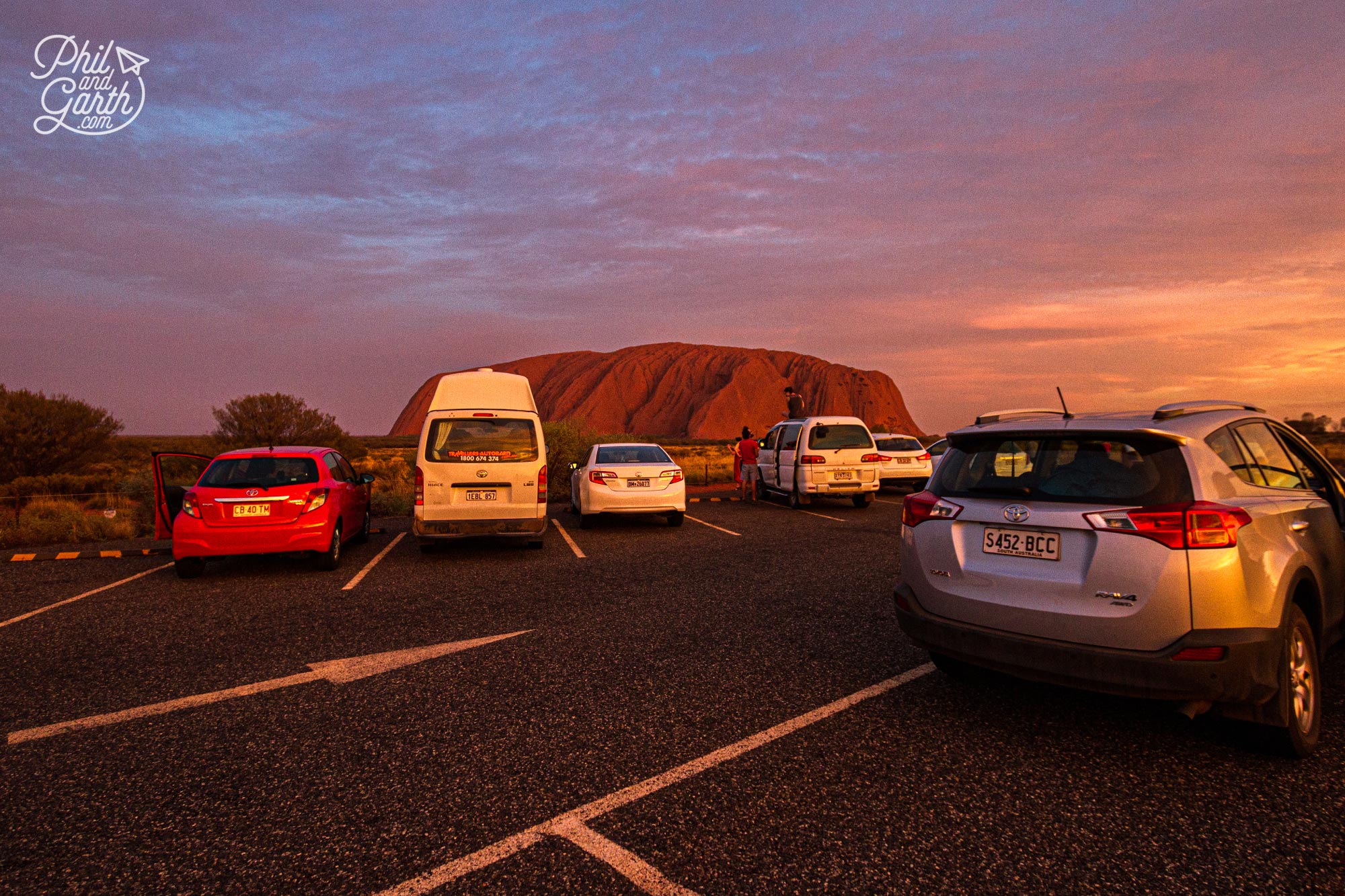
The sunset viewing car park
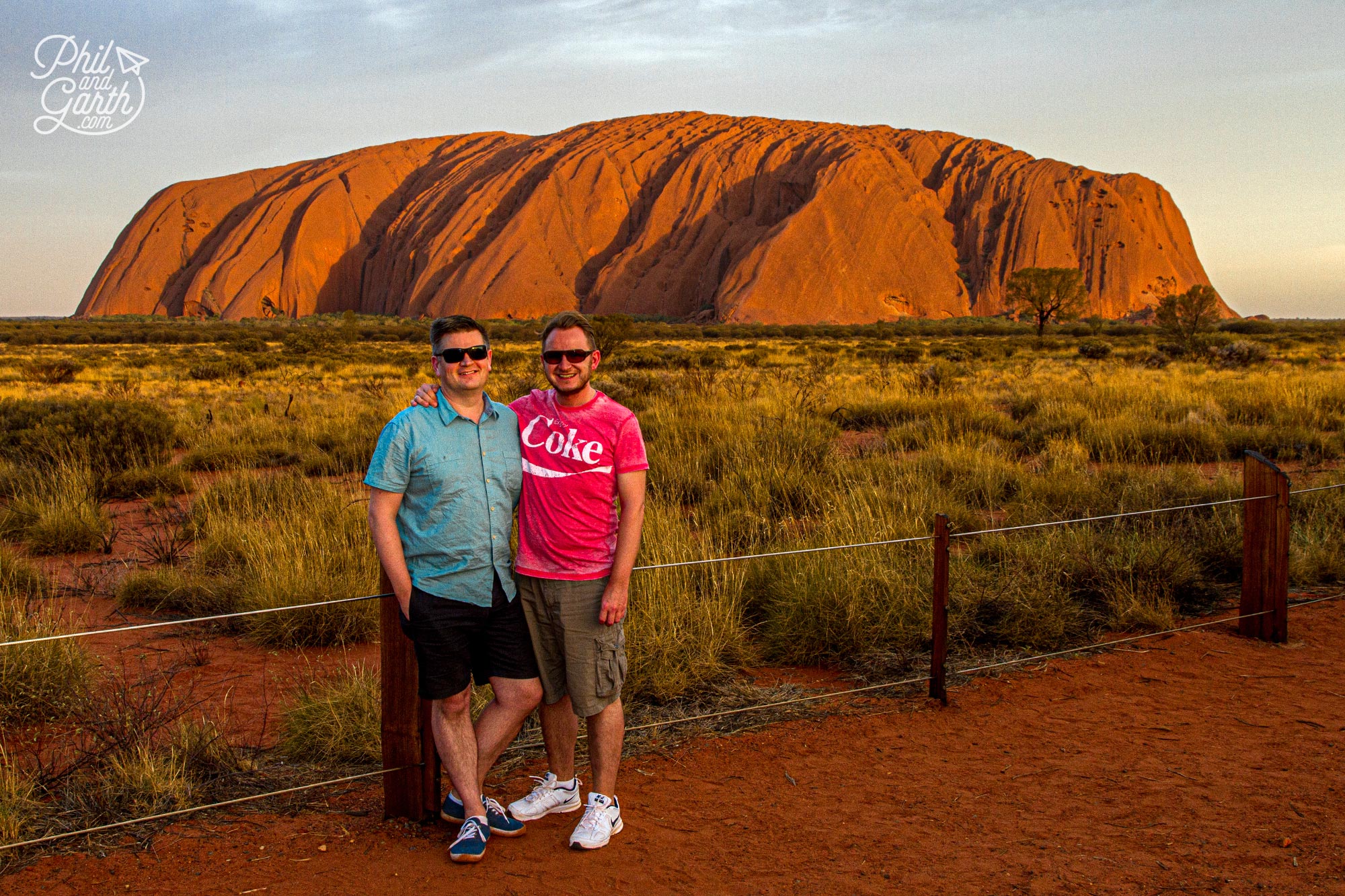
In the bag our classic sunset shot of Uluru
There were various stargazing tours on offer, which we definately would have taken up, but sadly it was too cloudy for our stay as there was a nearby cyclone developing, so we didn’t bother. The skies must be amazing at night as there is no light pollution, we both love stargazing so that would have been amazing to witness, but mother nature wasn’t playing ball. Many people went to see the similar beauty at sunrise, but we we’re too tired from all our travelling in Australia and somewhat lazy!
Day 2: Kata Tjuta – Uluru’s Neighbouring Rock
For the second day of our Uluru itinerary we visited the neighbouring rock, Kata Tjuta about 20 miles from Uluru. We never really realised just how striking and impressive Kata Tjuta would be. It’s meaning is ‘many heads’ because of its huge domed rocks. We hiked into one of the canyons created from the boulders, it’s terrain is rocky and uneven, so quite different to the red dust like Uluru walks. Remember to take plenty of water and your face nets! We only saw a couple of people during our time there, magical.
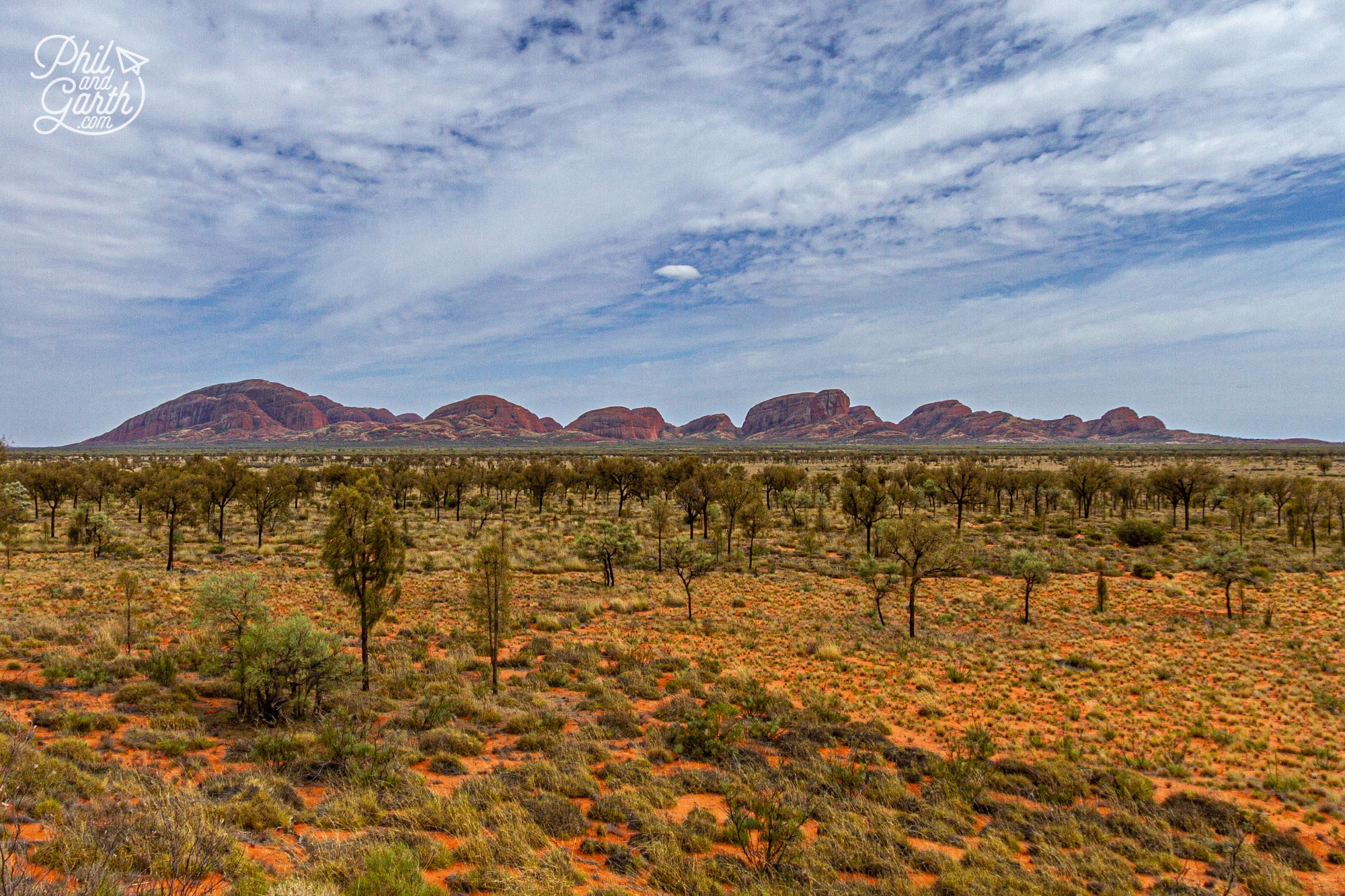
Kata Tjuta is also known as ‘The Olgas’
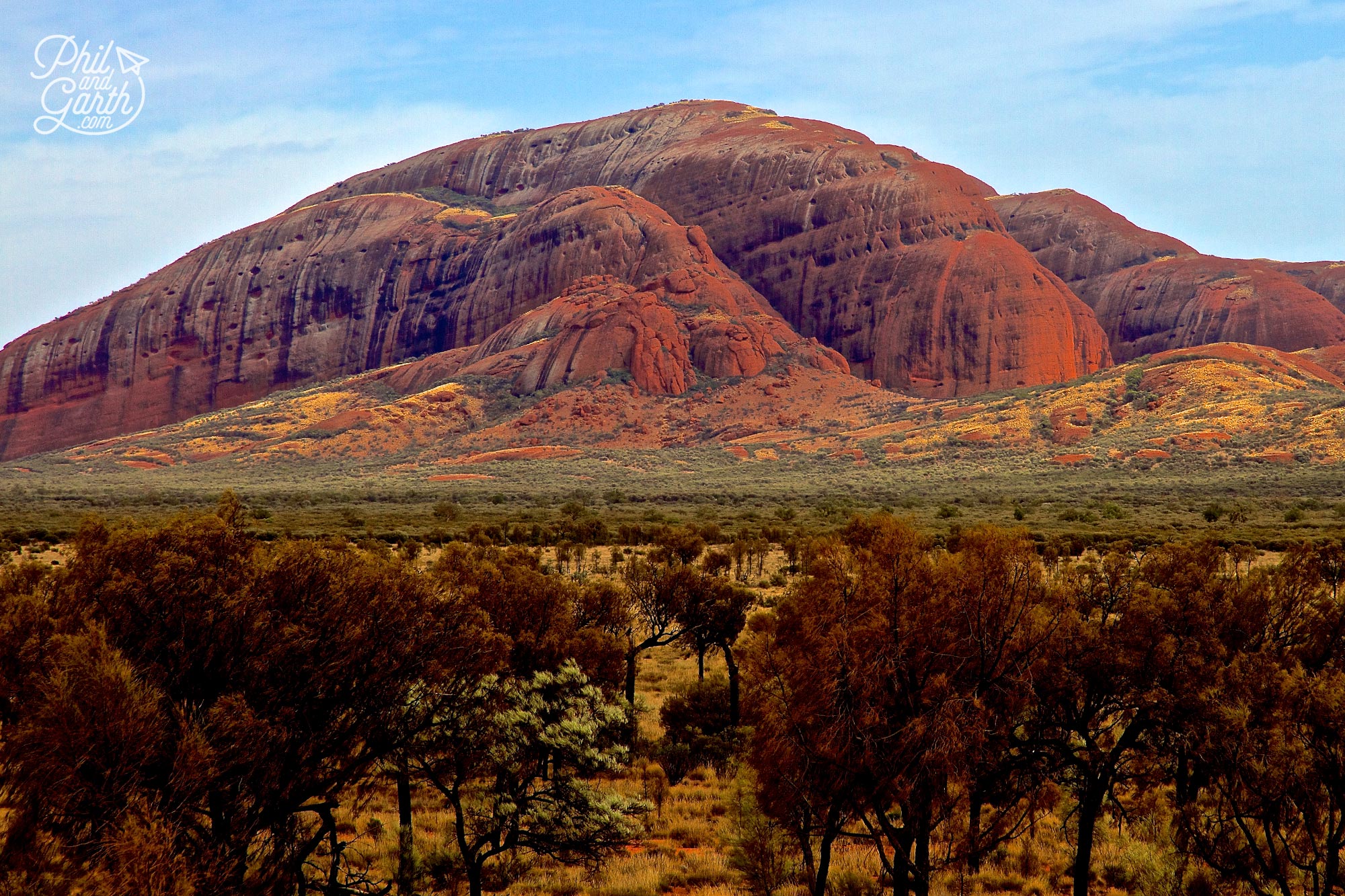
Kata Tjuta is equally as impressive as Uluru
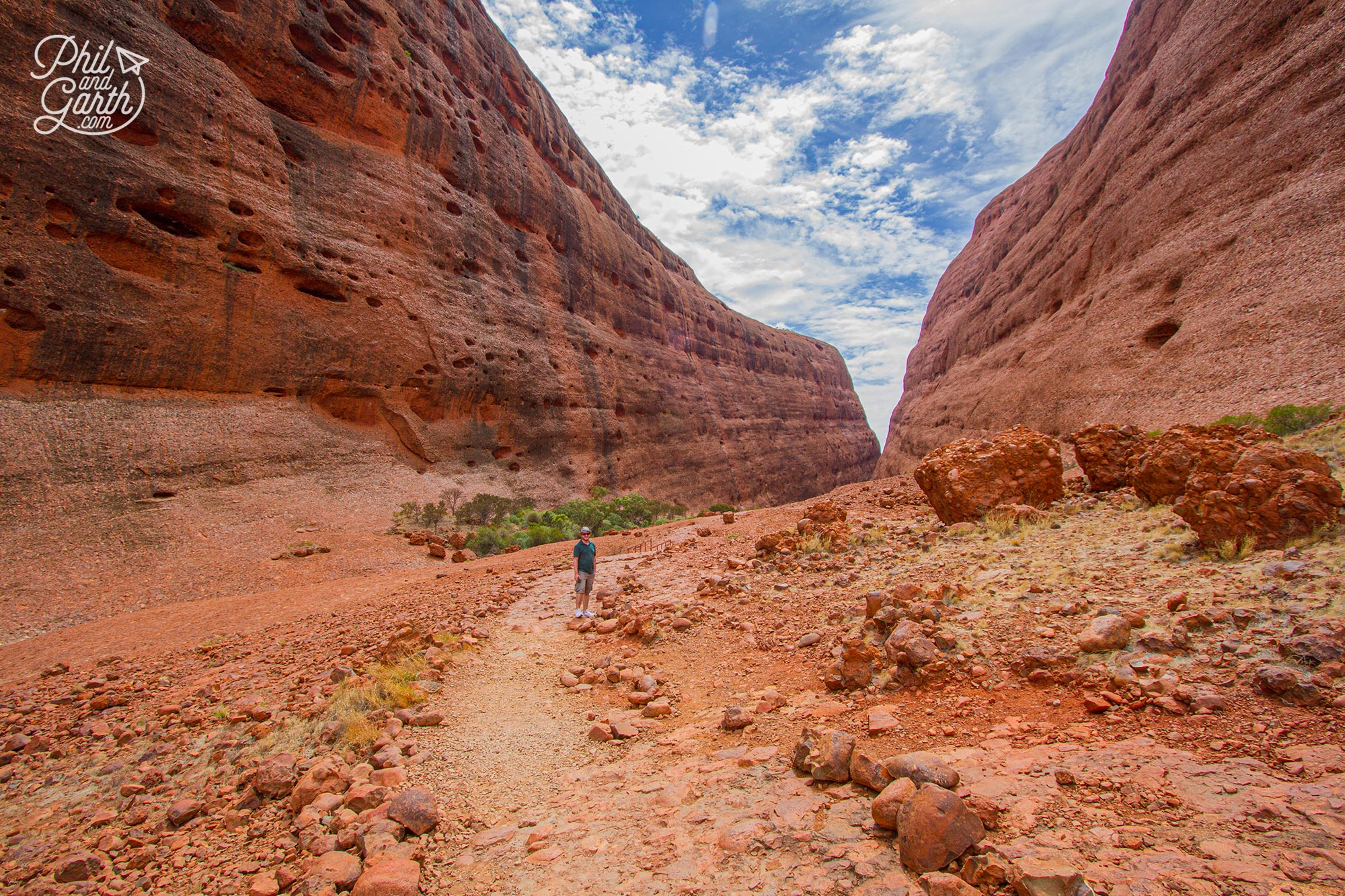
Garth walking through Kata Tjuta’s Walpa Gorge
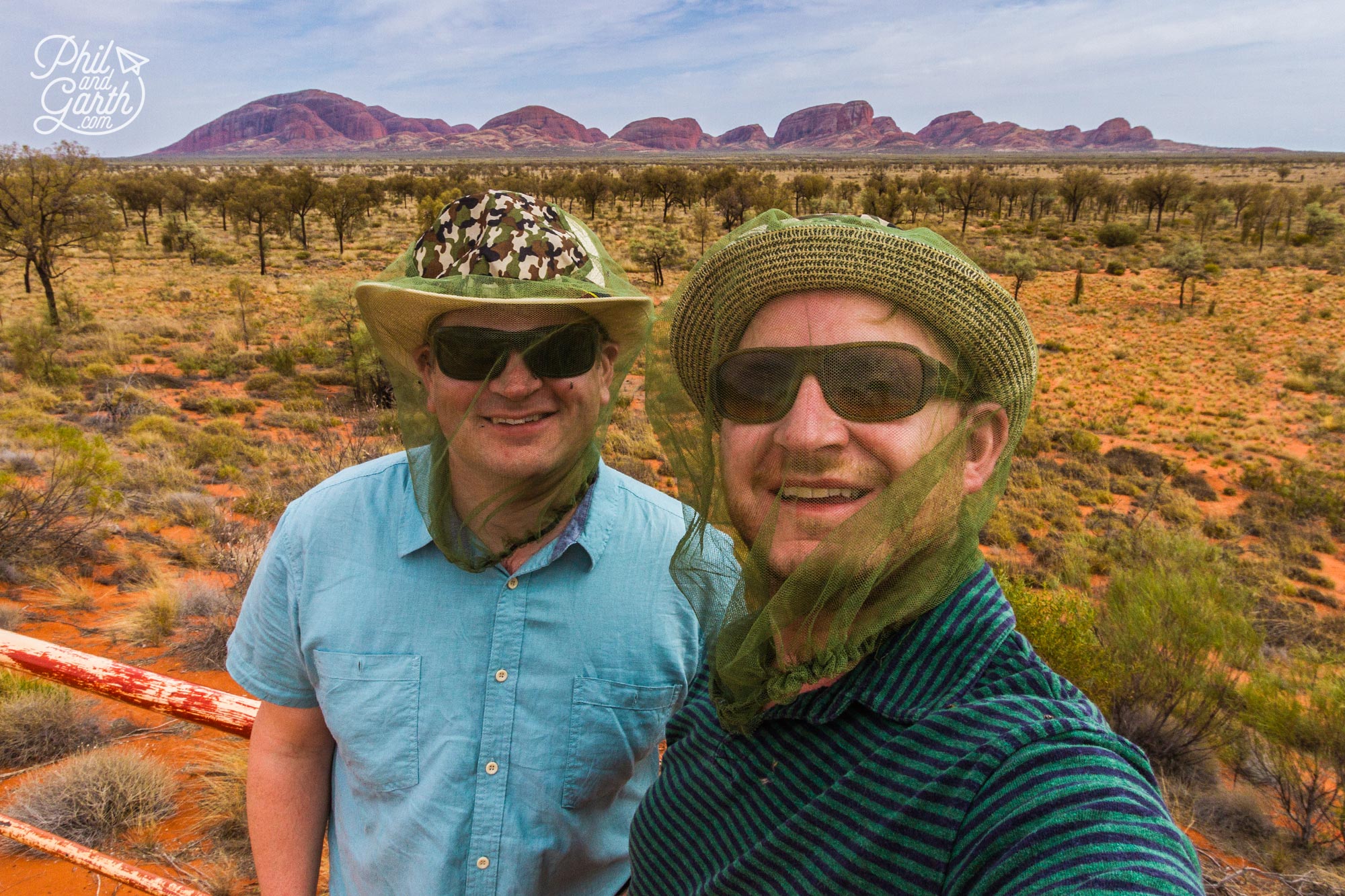
Our attractive face nets at a Kata Tjuta viewpoint
We filled our bags with quite a few bottles of water, and so glad we did, as we got through all of them. Dehydration is a real risk here, so don’t be caught out as the area is so isolated.
Uluru Practical Information & Useful Advice
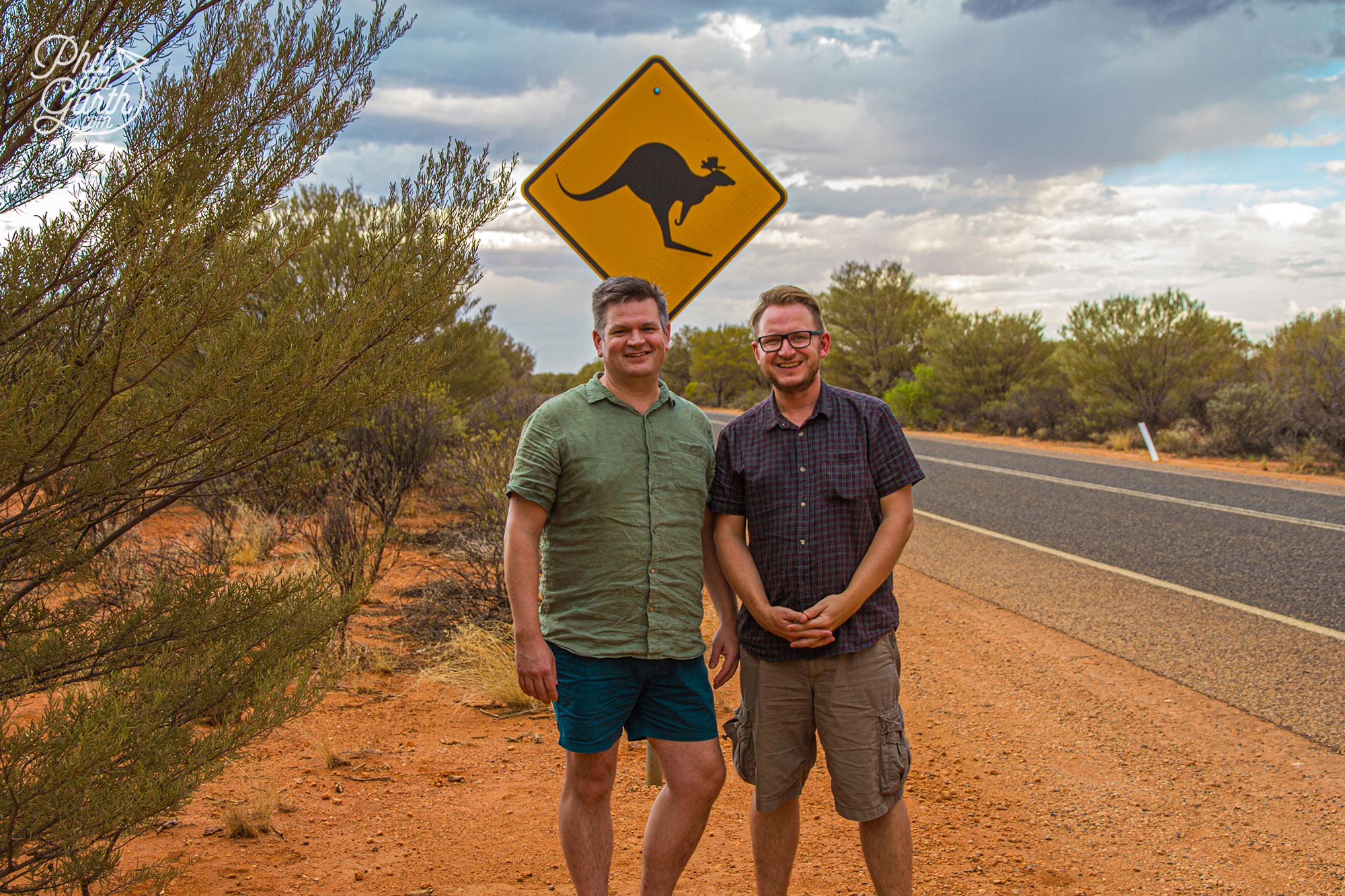
Phil & Garth’s Top 5 Tips for Uluru Kata Tjuta National Park
Phil & Garth’s Top 5 Uluru Travel Tips
- Tip #1 : Remember those flies we told you about – You must buy face nets before you go, just incase local shops have run out!
- Tip #2 : If you avoid peak season (June – Sept) and go in summer like we did, prices are much lower but you pay the price with flies! and the heat!
- Tip #3 : Some people fly in and out the same day, we don’t suggest you do this, as it’s just not enough time to see everything on offer – you need at least 2 days in Uluru.
- Tip #4 : When taking those must have sunset shots, wait another half hour after the sun has set, as we got some of best shots then.
- Tip #5 : Food is very expensive, but the local supermarket we went to in Yulara isn’t.
- What is the airport code for Uluru? AYQ – Ayers Rock Airport.
- What time zone is Uluru? GMT +9:30. Australian Central Standard Time.
- What currency is used in Uluru? Australian Dollar (symbol: $)
- What language is spoken in Uluru? English
- What is the population of Uluru? 1,000
- What number should I call in an emergency? Call 000 for police, ambulance or fire.
- What plug type is used in Uluru? Plug type I. 3 flat pins in a triangular pattern. Voltage is 230 volts, 50 hertz .
- When is the best time to visit Uluru? June to September.
- When is the worst time to visit Uluru? December to February (Australian summer) it’s very hot and humid.
- What is Uluru famous for? Ancient sandstone monolith.
- What is the history of Uluru? The Anangu people have lived around Uluru for more than 30,000 years.
- What are the 5 must see sights of Uluru? Uluru, Kata Tjuta, Cultural Centre, Uluru Kuniya walk & Walpa Gorge walk.
- What is the local food in Uluru? Kangaroo sausages are popular.
- What is the best way to get around Uluru? You will need to hire a car.
- What is a fun fact about Uluru? Uluru is estimated to be 600 million years old, wow.
- What movies have been filmed at Uluru? Young Einstein (1988) was filmed here.
- Where is the best photo spot in Uluru? Sunset Viewing Area.
- Where is a hidden gem in Uluru? Mutitjulu Waterhole.
- What is the best souvenir to buy in Uluru? Buy a piece of Anangu art from the cultural centre.
How We Did It
- We did a self-guided tour of Australia . We paid for internal flights with Quantas to Ayers Rock via Alice Springs.
- We visited in January, ridiculously hot and humid!
- We used the Uluru-Kata Tjuta National Park official website for the latest travel information.
Pin our Uluru itinerary for later
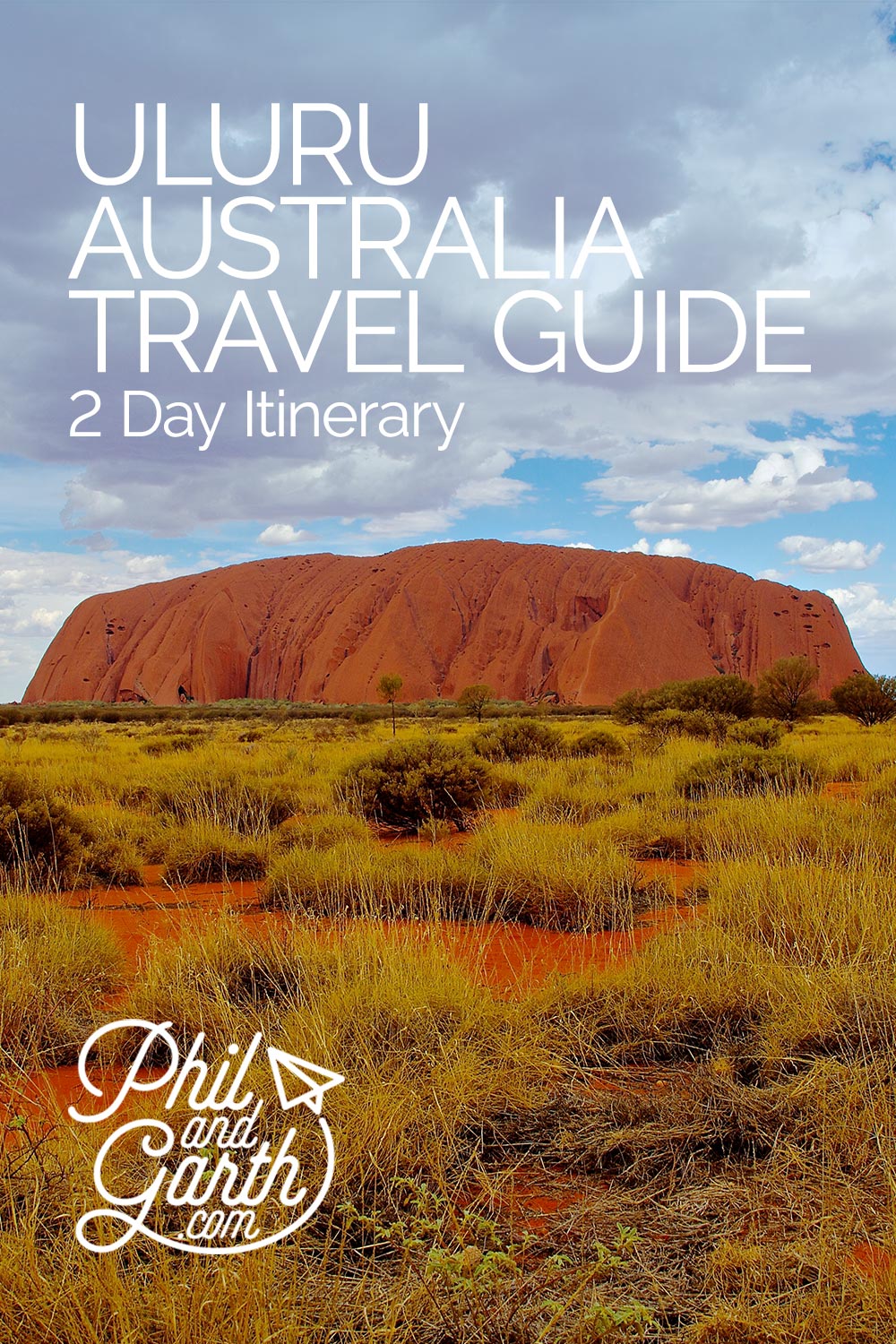
You may also like
Great barrier reef from port douglas – our bucket list adventure, 12 comments.
Lovely post and beautiful photos. Thanks.
Thanks for all the info. I really want to go there again. Took our kids to Uluru by Campervan from Adelaide in May 2002. It was the best trip of my life. We drove into Uluru and stayed at the resort you stayed at. But some miles before it we stopped at a site – it had a cattle ranch style pub with tin roof, australian animals to look at and a place to put up a tent or camper. We didn’t stay as we had booked in to the resort. I would also love to have camped by Uluru with aborigines. My kids were young 3, 5 and 7 and reckon it was the best trip ever.
Uluru comes across as a great place to commune with the great outdoors, never mind the flies! The sunsets and sunrises seem really magical, I reckon it would be a haven for hiking as well.
Haven’t been to Australia since I was a kid I so want to go back and spend about a month or so. I’m all about the hiking for sure and Kata Tjuta looks like a perfect place. I always love the photos you guys take too! I agree about not going during peak seasons as well.
Ah the memories – Australia is by far my favourite place in the world and I had a great time travelling around the country in a camper van with my friends. We went to Uluru in July and the weather was warm during the day but absolutely freezing at night! It was a fantastic experience even though I liked Kata-Tjuta more!
Wow, what an exciting adventure. The photos are great, love the do it your self BBQ and especially the nets. What an interesting color of sand. Looks like a beautiful place to take pictures. Great Tips and thanks for sharing such a great adventure.
I haven’t been to Uluru since we went in high school for a school trip, but seems a lot of it is as I remember. We camped at Yulara from memory. It definitely is in the middle of nowhere. Wonderful photos as always guys. #FeetDoTravel
I know you said you can’t comprehend the full beauty of it in pictures, but your pictures really are stunning!! I’ve always wanted to visit here – hopefully I’ll make it one day!
Oh this took me right back to my time here! I was part of a bus tour group and we had so much fun – we went in November and I don’t recall flies in that month – phew! When you are here, you can really see why it’s called the “red centre” so I love your photo which depicts this so well. Sadly for my visit it was cloudy so the sunset/sunrise shots weren’t as spectacular as yours, however it brightened up for my walk around Uluru – it is fantastic isn’t it! We were told that the locals have a name for the tourists who walk, they are called “mingas” which means ants, apparently that’s what they look like walking in a line from a distance lol. So glad you have also experienced one of life’s stunning natural phenomenon 🙂
Great photos and detailed post guys. Just out of curiosity what camera do you use?
We’ve got a few cameras including a cheap point and press underwater one which is great fun, we used our Cannon 7D to take the pictures in Australia.
Great stuff – it really shows in the pictures. I’ve been living in Australia on and off for a while and can certainly relate to the flies. The summer months are the worse! The graveyard also is a storage depot for most major airlines operating n Australia. It’s the only one in Australia.
Leave a Comment Cancel Reply
Save my name, email, and website in this browser for the next time I comment.
This website uses cookies to improve your experience. Press accept if you're ok with this. Accept Read More

Uluru 3-Day Tour: The Ultimate Guide & Review
Posted on Last updated: November 24, 2020
When I was little I read a fiction book set in Uluru (also known as Ayers Rock), it had drawings of the huge red monolith and I remember thinking it looked magical.
Fast-forward 15 years and I’m visiting Australia for the first time, I couldn’t help but satisfy my childhood fascinations and pay Uluru a visit!
I went on a 3-day tour of Uluru and the surrounding areas with Wayoutback Australian Safaris and I can highly recommend the experience.
We spent 3 days learning about Aboriginal culture in Australia, hiking in stunning outback landscapes, seeing impressive rock formations and much more.
Read on to discover the day-by-day itinerary of our Ayers Rock tour , and additional information about what you need to be ready for a trip in the Australian outback.
- 1 About Uluru & surroundings
- 2.1 Day 1: Uluru – Learn about Aboriginal culture
- 2.2 Day 2: Kata Tjuta – Hike in the Valley of the Winds
- 2.3 Day 3: Hike in Kings Canyon
- 3.1 Be ready to battle the flies
- 3.2 Don’t forget sunscreen!
- 3.3 Bring water bottles
- 3.4 Pack warm clothes
- 3.5 Pack a small bag for the trip
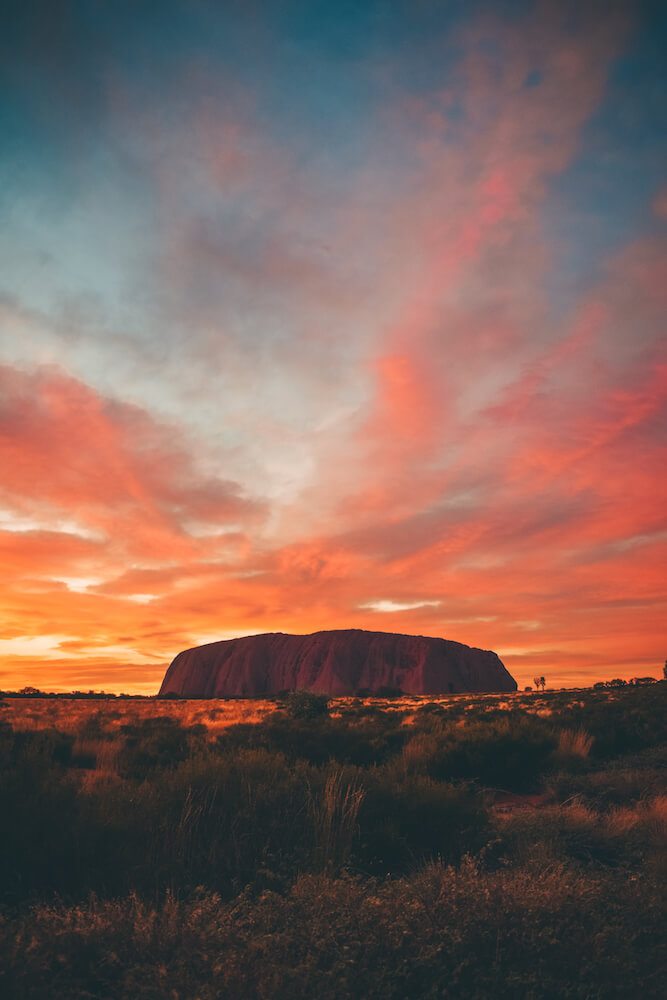
Uluru at sunrise
About Uluru & surroundings
Uluru is the original Aboriginal name of the largest monolith in Australia and the world. You might have heard it being called Ayers Rock, this is the name that the English colonisers gave it when they first came to Australia.
Either name can be used but today it’s more common and appreciated to call it Uluru. It’s located in the Northern Territory of Australia or what is known as the “Red Centre” due to red colour of the sand and rocks.
Uluru is also home to the Anangu people, who known as the world’s oldest civilisation.
Uluru is sacred to the Anangu people, which is why it is now protected by the Uluru-Kata Tjuta National Park and is listed as a UNESCO World Heritage Site.
The national park is jointly run by Australian government officials and representatives of the Aboriginal society, so as to ensure it is preserved appropriately and its history passed on.

Exploring Kata Tjuta, Australia
Our 3-day Uluru tour itinerary
Wayoutback Australian Safaris have a number of different tours both in the Northern Territory and other parts of Australia.
I would have loved to spend longer exploring Australia’s Red Centre however given our other travel plans, we decided to go for the 3 Day Goanna Dreaming Red Centre 4WD Tour , as it would enable us to see as much as possible of Uluru and the surroundings in just 3 days.
On our 3-day Uluru tour we followed the itinerary below.
Day 1: Uluru – Learn about Aboriginal culture
Our tour started with a 1PM pick up from our hotel in Yulara, the town closest to Ayers Rock airport; the Outback Pioneer Lodge .
On the first day you will receive your ticket for the Uluru-Kata Tjuta National Park, you need to hold on to this at all times as they might ask you for it if you meet a ranger.
The first stop of our tour was the Cultural Centre. Here there is a big exhibition in place that teaches you about the flora, fauna and history of this area.
The most interesting part for me was learning about Aboriginal culture and how the National Park is run today with guidance from the Anangu people.
Check out the latest prices and availability at Outback Pioneer Lodge

Exploring the base of Uluru, Australia
After visiting the Cultural Centre we drove to the base of Uluru, where we met our Anangu guide and her interpreter.
We did the Uluru base walk where we saw a number of small caves, where indigenous rituals used to be carried out and others with indigenous paintings on them.
There are lots of beautiful walks in Uluru , and the base walk is just one of them.
Our guide introduced us to Aboriginal origin stories and it was fascinating to hear about them from her, even with a interpreter translating in English.
We also learnt about Aboriginal painting methods and symbols, and what specific recurring symbols mean. We then finished our walk at Mutitjulu Waterhole, a water hole where the Anangu men used to hunt.

Our Anangu guide with some of the traditional aboriginal tools the women used
We then drove to the sunset viewing spot over Uluru. There is a big car park here and you will find a lot of other people here. Watching the sun go down and turn Uluru a fiery red is one of the biggest attractions here after all!
However most people crowd by the car park, if looking at Uluru you just walk towards the right there is a path with considerably less people. Perfect if you want to snap some photos without the crowds!
We also had a table by our 4WD with nibbles, dips and champagne, the perfect way to end our first day in the outback.
From there we drove to the campsite, where all had dinner together before going to sleep in either the tents or swag for those that felt like braving it (I wasn’t one of them).
Click here to book your Uluru 3-day tour!

Enjoying the sunset over Uluru with champagne and nibbles
Day 2: Kata Tjuta – Hike in the Valley of the Winds
On the second day we woke up at 5AM in the morning to make sure we were at the Uluru sunset viewing spot in time for sunrise.
The viewing spot is a short 5-minute drive away so you have time to get ready and have breakfast before the day starts.
Once we got there we were happy to see that the crowds of the day before at sunset had considerably diminished. We were there with only a handful of other people watching the sky around Uluru catch fire.
Once the sun was fully up we drove on to Kata Tjuta, the next stop on our 3-day Uluru tour.
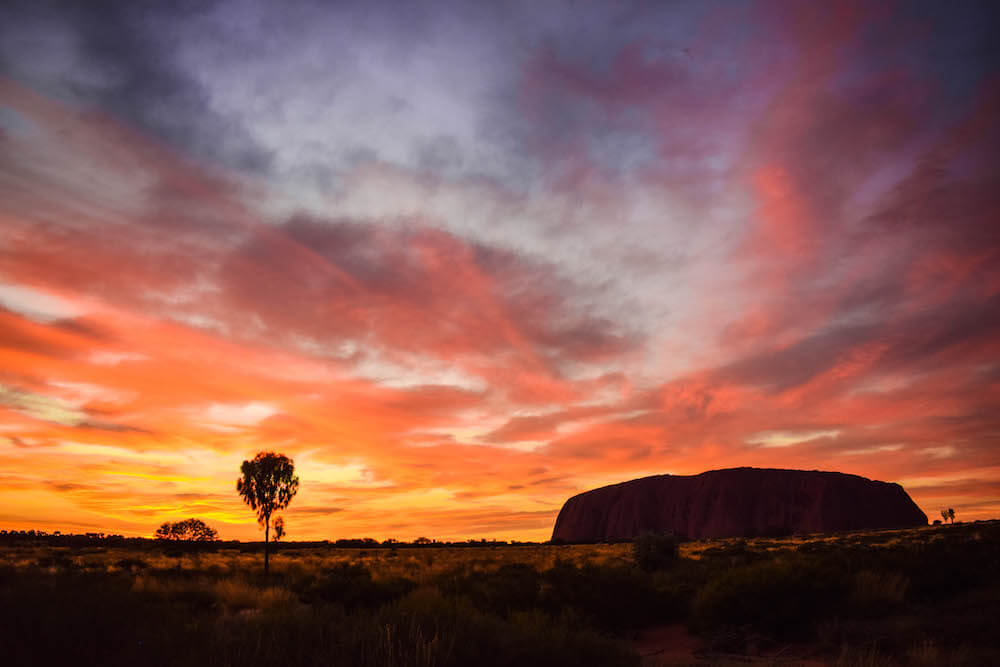
Sunrise at Uluru, Australia
I was surprised to find out about Kata Tjuta. In my ignorance I always thought of Uluru as a stand alone natural beauty, I didn’t realise there was another similar rock formation so close to it.
Our guide explained that the reason why Kata Tjuta is less known is because it is a sacred place for Aboriginal men, which means creation stories about it are not shared with tourists. Here we went hiking in the “Valley of the Winds”.
| READ MORE: 15 INCREDIBLE AUSTRALIAN ADVENTURES |

Kata Tjuta, Australia

Hiking in the Valley of the Winds in Kata-Tjuta, Australia
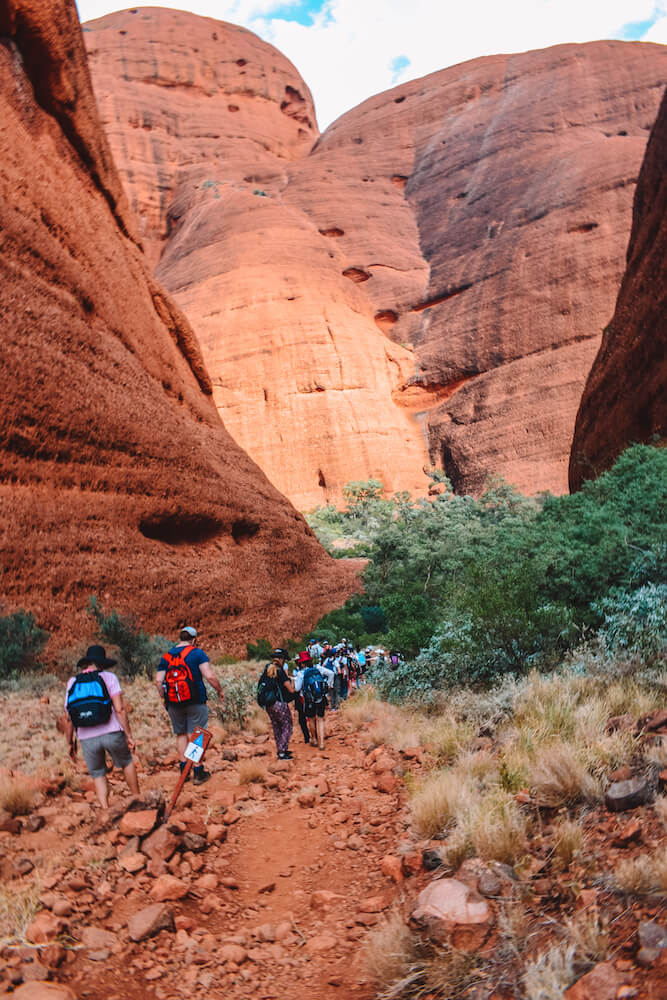
The hike in the Valley of the Winds starts off on a straight path, then at one points breaks off and forms a loop, forming two possible hiking routes.
You can either hike directly to Karingana Lookout and then hike back (5.4km return, approximately 2.5 hours), or go all the way round and form a loop (7.5km full circuit, approximately 4 hours) .
Being the young and dashing athletes we think we are we decided to go the longer way round. Most of the hike is pretty flat with the occasional extremely steep section.
If you can handle a 7.5km hike, I really recommend going the longer way, as part of the hike was outside of the canyons of Kata Tjuta and will give you some epic views over the surrounding landscapes.
The steepest part is the uphill climb to reach the lookout, but once you make it up, the view is well worth it!
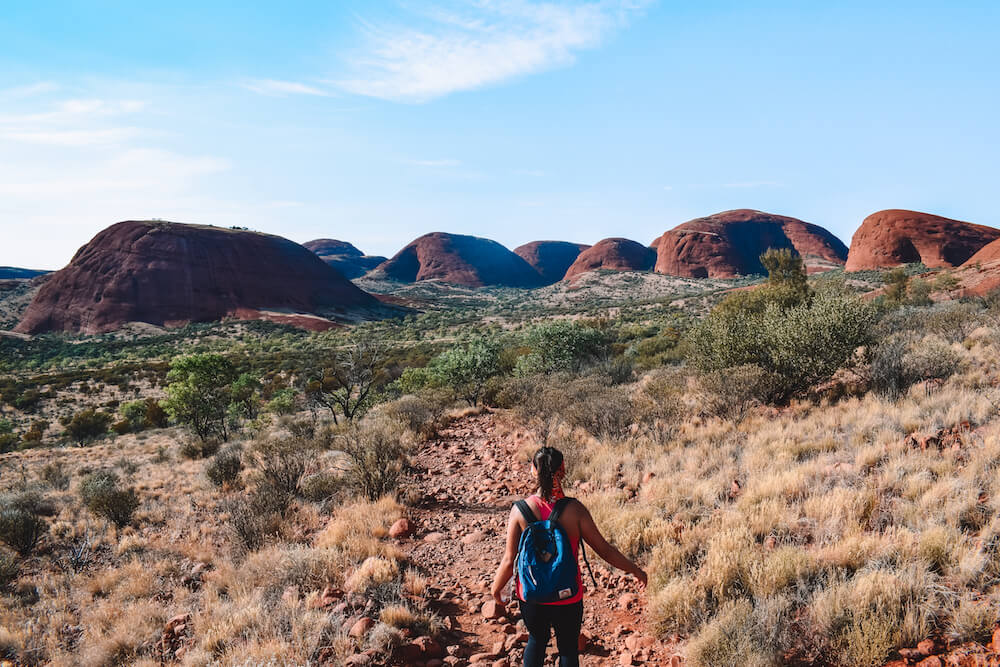
The view from Karingana Lookout in Kata Tjuta, Australia
After the hike we drove back for approximately an hour to Yulara for a barbeque lunch, just what you need after a long hike!
There was also a pool at the camping spot where we had lunch so if you need to cool down after the hike it’s a great place to do so. From there we then had a long drive to Kings Creek Cattle Station; our camp for the night.
We did a few stops along the way to see Mount Connor, a mesa tableland and another important rock formation like Uluru and Kata Tjuta, and other particularities of the environment during the drive.
The camp you will stay at tonight is truly magical and will give you a true feeling of what the outback is really like.
There are no other camps, towns or other forms of civilisation for miles, making it also an amazing place for stargazing given the minimal light pollution!
We had dinner cooked on the campfire, watched the stars and then hit the hay early in preparation for the early rise the next day.
Click here for more information and to book your own Uluru 3-day tour!

Mount Connor, Australia
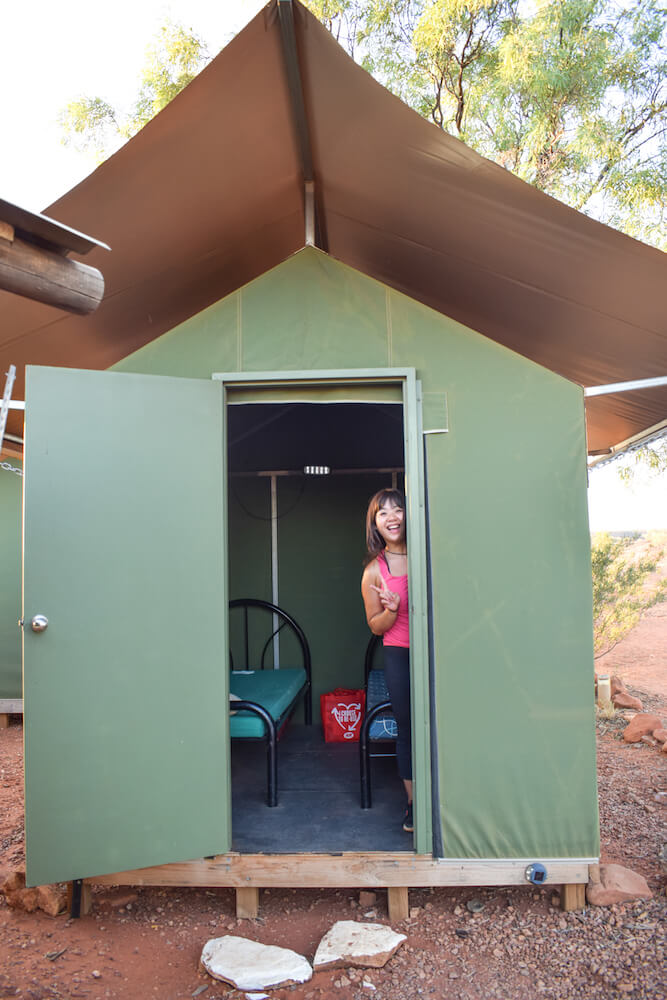
Our tent at Kings Creek Cattle Station, Australia
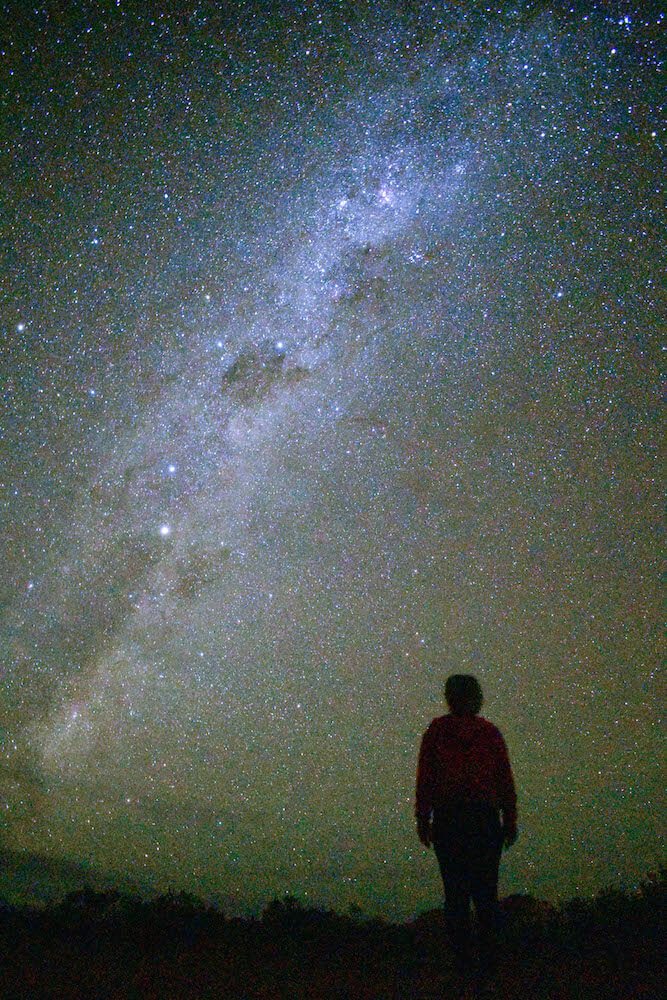
The Milky Way seen from the Australian outback
Day 3: Hike in Kings Canyon
It’s another 5AM start for day 3, so that we could make it to King’s Canyon in time to catch the sunrise and before it became too hot to hike.
There are a number of different hikes that you can do at King’s Canyon, however given that some are more than 20km long we were given two options; an easy 2.5km return trip or a 6km full circuit.
The longer loop starts with a very steep uphill walk along what is known as “Heart Attack Hill”. Yes that’s how steep it is. However even if you’re not an athlete you’ll be able to do it, if I managed it can’t be too hard really!
It’s very steep but it’s quite brief, and once you reach the summit you will be rewarded with a beautiful view over the surrounding outback.
We made it just in time to see the sun come out from behind the rocks and it set a great mood for the rest of the hike.

Hiking up Heart Attack Hill at Kings Canyon, Australia

Hiking in Kings Canyon, Australia

After Heart Attack Hill the rest of the walk is pretty flat and our guide had the opportunity to tell us about the local flora, fauna and aboriginal traditions.
At a number of points during the hike we stopped to enjoy the view of the red cliffs. About half way through the hike we reached the “Garden of Eden”, an unexpected waterhole surrounded by cliffs on all sides.
We finished the hike around lunch and went back to our campsite for lunch, after which we set off for a long drive on to Alice Springs .
We did part of the driving on a typical outback road, with the occasional stops to appreciate the local flora and fauna or to try throwing a frisbee.
The tour ended around 5PM with a drop off at our hostel. If you want the tour can continue on back to Yulara.
Click here to see the latest prices and availability for your Uluru 3-day tour!

The “Garden of Eden” in King’s Canyon, Australia

Cool rock formations in Kings Canyon, Australia
How to prepare for a trip in the outback
The Australian outback is considered one of the world’s harshest environments, and while today we have the benefits of civilisation, I still found that compared to a “normal” trip to a city or beach there were things I wish I’d known and been better prepared for.
This is an extensive list of things I think will help you prepare for a trip in the Australian outback.
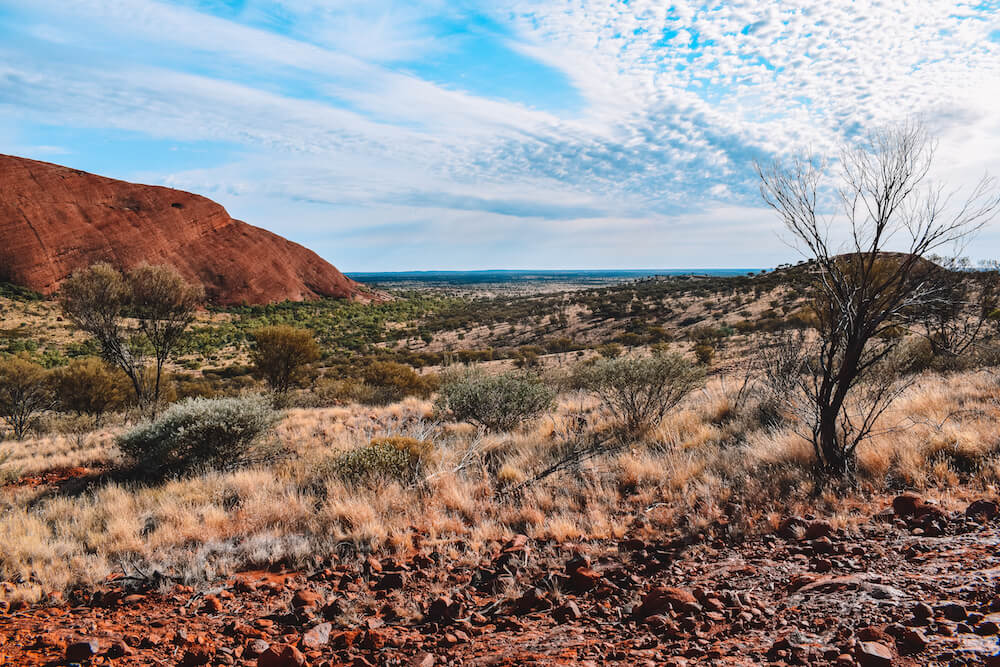
View over the Australian outback from Kata Tjuta
Be ready to battle the flies
One of the things I was not ready for on my outback trip were the flies. Nobody told me there would be so many flies everywhere!
From the moment when the sun comes up to when it goes back down (you get some relief at least at night!) you will be pestered by flies.
They’re like that one friend that always leans in too much when they talk to you, they have no concept of personal space.
They will fly in your ears, nose and mouth if you don’t stop them. You have two main remedies against flies:
Fly nets : These look ridiculous but they’re the only 100% effective fly repellent. They’re made of fine mesh and you wear them over your head so that they can’t get in your mouth when you speak.
The downside is that you will look a bit silly and will have to see the world through a mesh of light pink / blue / green / whatever colour you pick for your net.

The flies will attack you as soon as they get a chance
Fly repellent roll-on or cream : This isn’t as effective as the nets but it gets pretty close. We bought a natural repellent that you apply on your exposed skin and the smell keeps the flies away (it’s not a bad smell btw)!
The only disadvantage is that you need to reapply often as it wears off quickly.
I went for the roll-on as I have the bad habit of rubbing my eyes when I’m tired and given the number of 5AMs on the itinerary, I didn’t want to be rubbing fly repellent in my face.
The cream is supposedly more effective but I found the roll-on to be enough, when a fly came too close to my face I just reapplied and they would stop coming.
All of these can be bought at the shops in Yulara or Alice Springs . You will see the shops there also sell cork hats. These are normal hats with strings with corks dangling at the end of them.
Legend says that you just shake your head and all the dangling corks scare away the flies. They don’t work. If you want one as a souvenir go for it, but don’t expect them to keep flies away.

And land anywhere on you
Don’t forget sunscreen !
I’m the kind of person that puts sunscreen on only at the beach, and even then I tend to go for factor 20 or less (what’s skin cancer compared to a beautiful golden tan right? Just kidding, that’s me trying to be funny).
In the Australian desert, make sure to bring a high SPF sunscreen and don’t forget to reapply when you need to. The sun is strong here and nobody likes sunburns or skin cancer.

Uluru at sunset
Bring water bottles
The 4WD always had a tank of fresh drinkable water on board, however you will need your own water bottles to fill up. Wayoutback recommends bringing two 1.5L bottles.
When you get off the 4WD and start hiking, don’t forget your water bottle! Hiking under the desert sun will make you sweat a lot and you will need to drink while you hike.

Hiking in Kata Tjuta with our water bottles!
Pack warm clothes
This might seem like a counter intuitive one, given that you’re going on a trip to the desert, however if you’re visiting in autumn, spring or winter you will need some warm clothes for the night.
The temperatures drop considerably at night and you will want a hoodie or long sleeved top to spend the evening in. This isn’t to say that you will need a winter coat, but just an extra layer will do.
If you need help figuring out what to pack for your trip to the Australian outback, check out my Uluru packing list .

Our camp at Kings Creek Cattle Station, Australia
Pack a small bag for the trip
If you do a tour with Wayoutback Australian Safaris they will store your luggage in a trailer in the back of the 4WD.
The luggage trailer is always accessible when you stop for the night however if you’re like me, and travelling with a huge 25kg suitcase, you might not want to lobby it up and down the stairs of the luggage trailer and into a small tent.
I found it easier to pack the things I needed for 3 days in a backpack so I could keep those with me in the bus, and I just put the luggage in the trailer at the tour pick up and took it back at the end of the tour.

The Wayoutback Australian Safaris 4WD vehicle we did the 3-day Uluru tour with
Final thoughts on our Uluru 3-day tour
Have you been to Uluru? How did you find it? Let me know in the comments below!
Visiting Uluru was a magical experience for me, one of the highlights of my Australia trip and something I think everyone should add to their Australia itinerary .
I was a bit concerned I would be doing a huge trip to get there and then feel like it was all “just for a big rock in the middle of the desert” but it was so much more than that.
Learning about aboriginal culture was fascinating, the hikes we did were amongst my favourite ever and the landscape was unlike anything I had ever seen before.
If you get the opportunity, I highly recommend doing a 3-day tour of Uluru .
Looking for more Australia tips? Check out my travel guides:
- Is the Bondi to Coogee Coastal Walk the most beautiful walk in Sydney?
- Swimming in the Noosa Heads fairy pools
- Fraser Island 3-day tour review
- How to spend a weekend on the Great Ocean Road
- The best day trips to Whitehaven Beach & the Whitsunday Islands
- How to spend 3 awesome days in Sydney
- 15 most Instagrammable places in Sydney
- Day trip to Blue Mountains from Sydney
- Daintree Rainforest – the ultimate Cairns day trip
- Everything you need to know to plan the perfect Australia road trip
- Cairns to Brisbane 2-week itinerary
- Discover the Great Barrier Reef
- Best things to do in & around Cairns
Enjoyed reading about our Uluru 3-day tour? Pin it!

Wednesday 30th of January 2019
Thanks for the information. It looks like that tour costs $860 AUD on 1/30/19. Kind of a high price. I will look for other tours and compare itineraries and read others reviews. Your info make me wonder if there is some similar type of fly repellent that you could sort of pre-soak your shirt in that would also help keep them away. Thanks for the post and you have some great photos!
Monday 4th of February 2019
The tour I did was a bit more expensive as it was in a smaller 4x4 coach and sleeping in tents, the same company does bus tours sleeping in the swag (under the stars) which are cheaper. Don't know about a fly repellent for clothes, I found the roll-on was fairly effective! Glad you liked my post & photos, hope this helps in planning your trip! :)
Small Towns in Australia Worth Visiting (and a Couple of Slightly Bigger Ones) - Birdgehls
Wednesday 11th of July 2018
[…] population of less than 900 people. It is also a popular tourist destination, as it is where most Uluru tours start from and it’s where all the area’s campsites and hotels are […]
Saturday 2nd of June 2018
Gorgeous photography! And you've enlightened me, didn't realise there was quite so much to do around the rock too :) Enjoyed the read!
Thanks, glad you enjoyed the post! And I know, I had no clue till I went there! (should've done more research before haha)
I visited the Outback a couple years ago and LOVED it! Uluru is so beautiful and I loved Kings Canyon as well. Your photos are great and are making me want to get back to Australia asap!
Thanks so much, glad you enjoyed it! Visiting the outback and Uluru was my favourite part of my Australia trip!
If there was only a word to describe those photos... Is it magic?
Beautiful journey!
Thanks, it really is a magical place!

A Complete Uluru Itinerary | Red Centre Way Uluru to Alice Springs
By: Author Charles
Posted on October 25, 2023
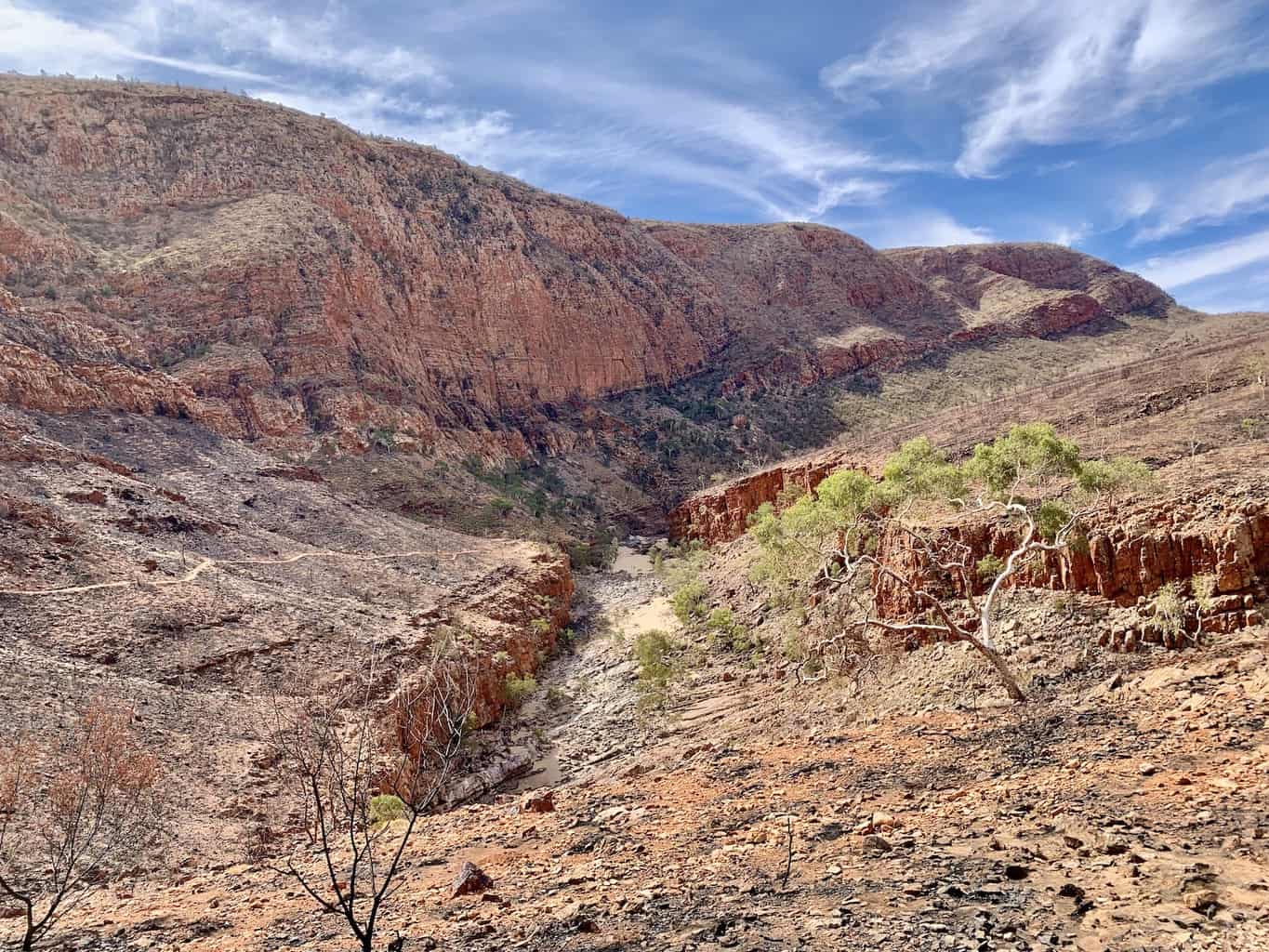
Are you headed to the Outback of Australia and wondering how to put together the perfect Uluru itinerary along the Red Centre Way from Uluru to Alice Springs?
Well, this guide will go over everything you need to know on how to put together the best possible itinerary as well as go over things such as attractions, activities, rental cars, hikes, accommodation and much more.
* Affiliate Disclosure : This post may contain affiliate links, which means I may receive a commission if you make a purchase through the links provided, at no additional cost to you. Thanks for supporting the work I put into TripTins!
1) A Red Centre Way Uluru Itinerary
Below is an overview of what an Uluru itinerary can look like. I wanted to list it out first since the rest of this guide will refer back to this itinerary in particular all throughout.
Of course, you can add or remove particular activities/attractions but overall it is a great starting point to build your trip off of.
Altogether it will be 3 nights in Yulara, 1 night at Kings Canyon, and 2 nights in Alice Springs . I should also note that you can also do this in the other direction – starting in Alice Springs and ending in Yulara.
- Day 1: Arrive Ayers Rock Airport / Transfer to Yulara / Pick Up Car / Uluru Sunset
- Day 2: Uluru Sunrise / Uluru Base Walk
- Day 3: Kata Tjuta Sunrise / Valley of the Winds Walk / Kata Tjuta Sunset
- Day 4: Drive to Kings Canyon / Kings Canyon Rim Walk
- Day 5: Drive to Alice Springs / Kangaroo Sanctuary Tour
- Day 6: West MacDonnell Ranges Day Trip
- Day 7: Depart Alice Springs
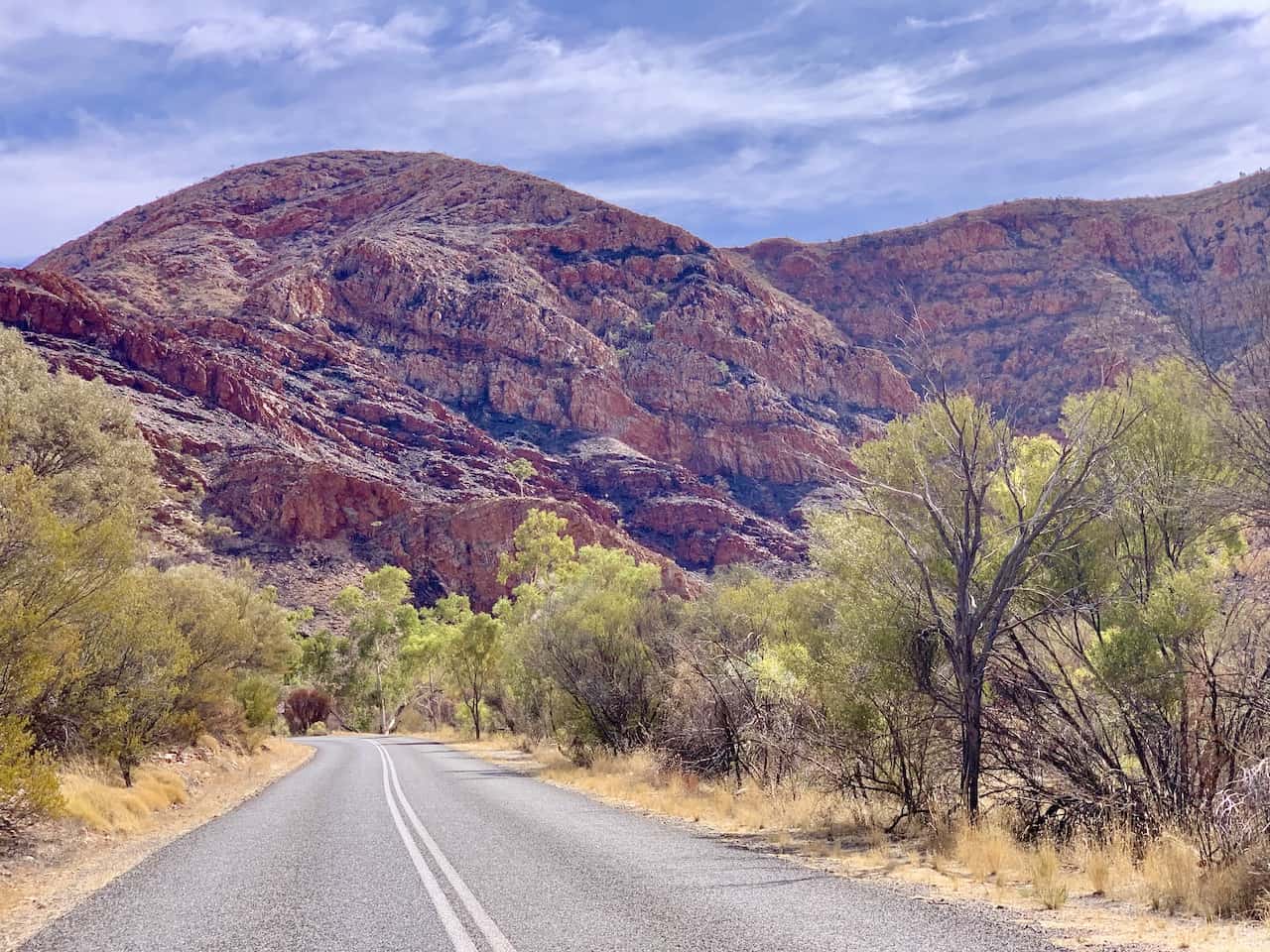
2) Red Centre Way Map
To make it simple, the Red Centre Way is an area of Northern Australia that spans from Uluru-Kata Tjuta National Park up to Alice Springs. It includes highlights such as Uluru, Kata Tjuta, Kings Canyon, and the West MacDonnell Ranges .
There is just a ton to do all along the Red Centre Way and this itinerary will walk you through it all.
Below is a great map (courtesy of Christallkeks / Wikimedia Commons) that goes over where each of the main attractions along the Red Centre Way are located. It also shows all the main roads that you can drive on in the area.
I will be referring to the map throughout the article so be sure to get a good understanding of it for your trip to the Red Centre Way.
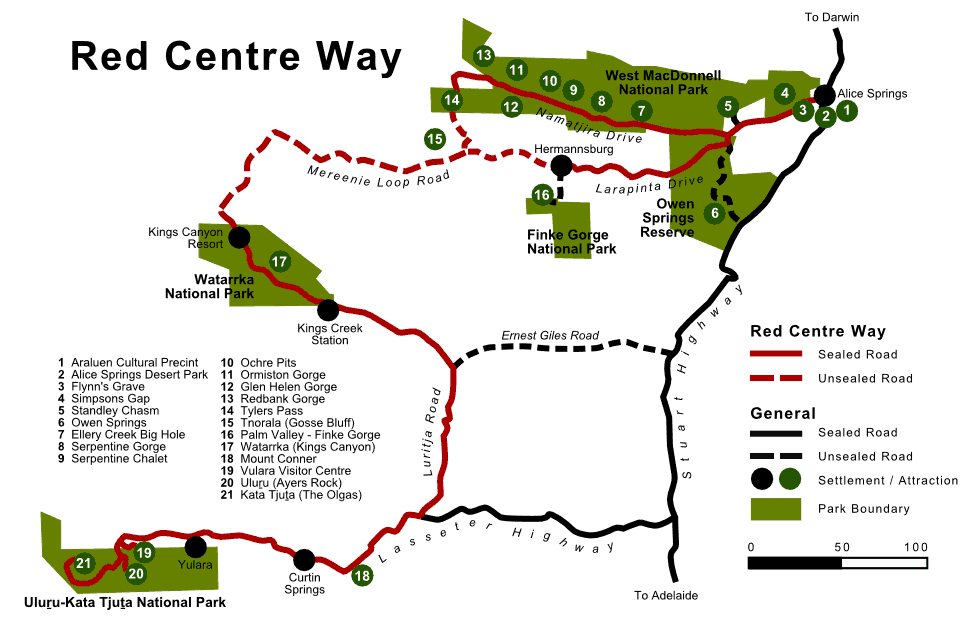
3) Uluru Weather
One major decision you will need to make is when to actually visit the Red Centre Way. Whenever I think about when to visit an area I like to know what the temperatures will be like and how much rain to expect during different times of year.
Although the Australian winter is the high season (~May-September), temperatures are much more suitable to enjoy the area. In the summertime, temperatures can reach 100F / 40C, making some activities tough to take part of.
You will also want to consider the rainy vs. dry season. Again, during that winter time period you will see rain at its lowest. This means more comfortable days, less clouds, and better visibility.
Below are some weather charts that will give you a better idea of the month to month temperatures and rainfall around Uluru.
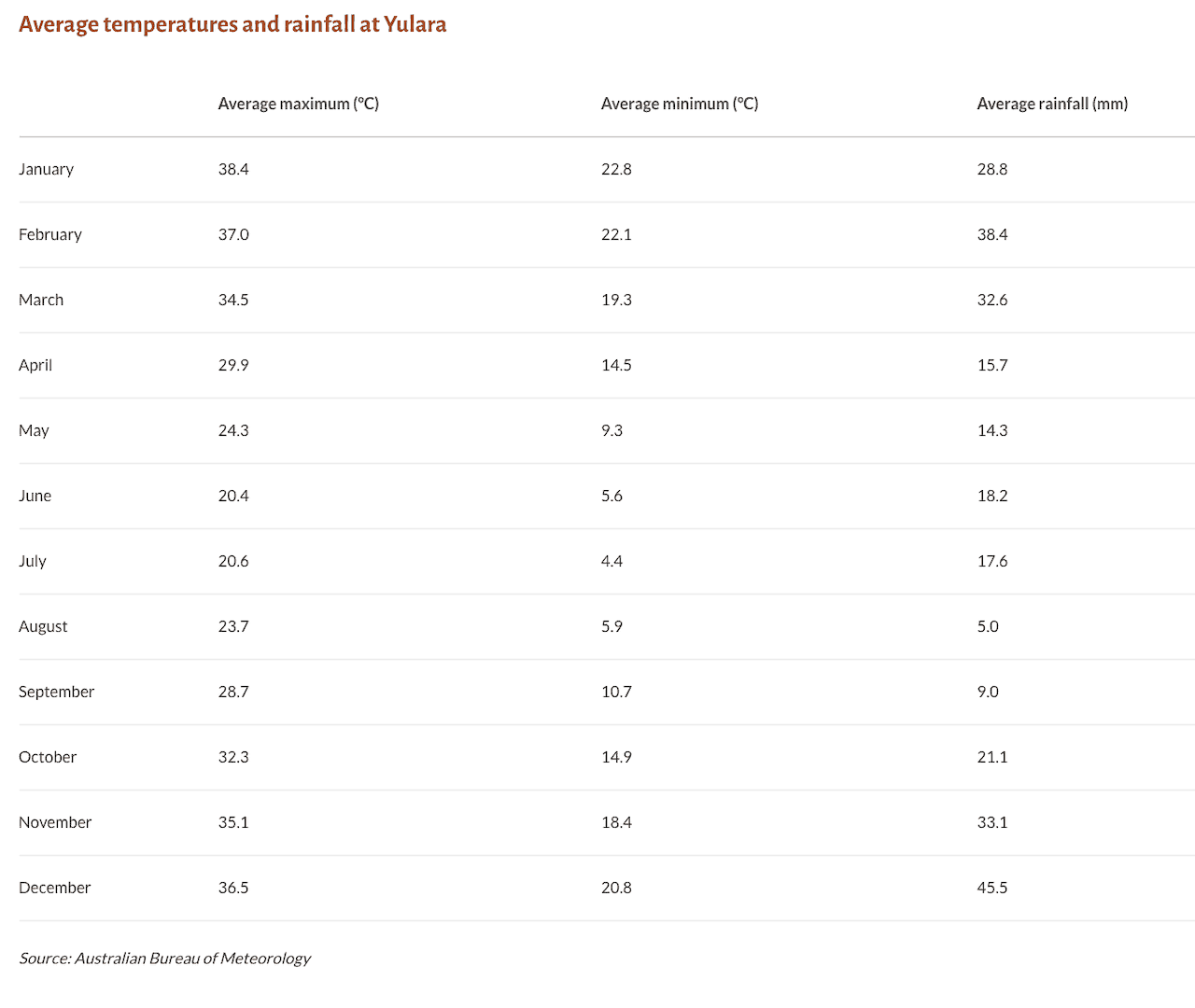
» Need some Australia inspiration? Check out these Australia travel quotes to inspire your travels
4) Red Centre Way Accommodation
The three areas that are mentioned in this itinerary as overnights are Yulara, Kings Canyon and Alice Springs .
Below are some options for each one of these places when deciding on where to stay:
The entire town of Yulara is built around one large loop, where you will find several accommodation options, a small town center with restaurants, shops, and a supermarket, and other things like a gas station, emergency services, etc. I will talk a bit more about all that soon.
Below are a few of the places you can choose from although there are several more part of the larger Ayers Rock Resort:
- Sails in the Desert
- Desert Gardens Hotel
- The Lost Camel Hotel
Looking for a budget option? The Outback Pioneer Lodge has some shared room options.
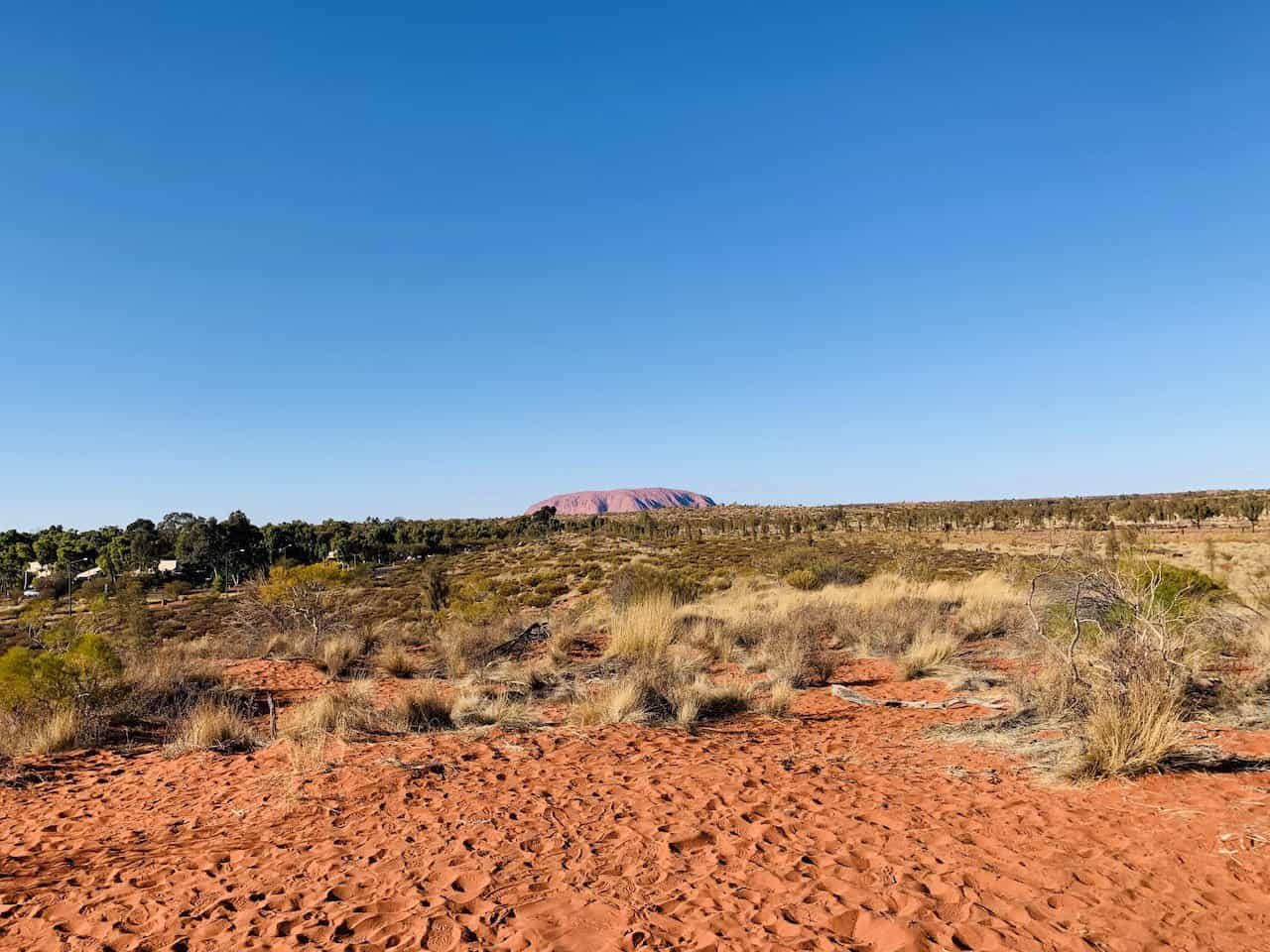
Kings Canyon
Since Kings Canyon is located pretty far away from any other major attractions, you will only find two potential accommodation options – the Kings Canyon Resort and the Kings Creek Station .
The former will have several accommodation options along with restaurants and a market while the later is more so a campground with some other accommodation offerings as well.
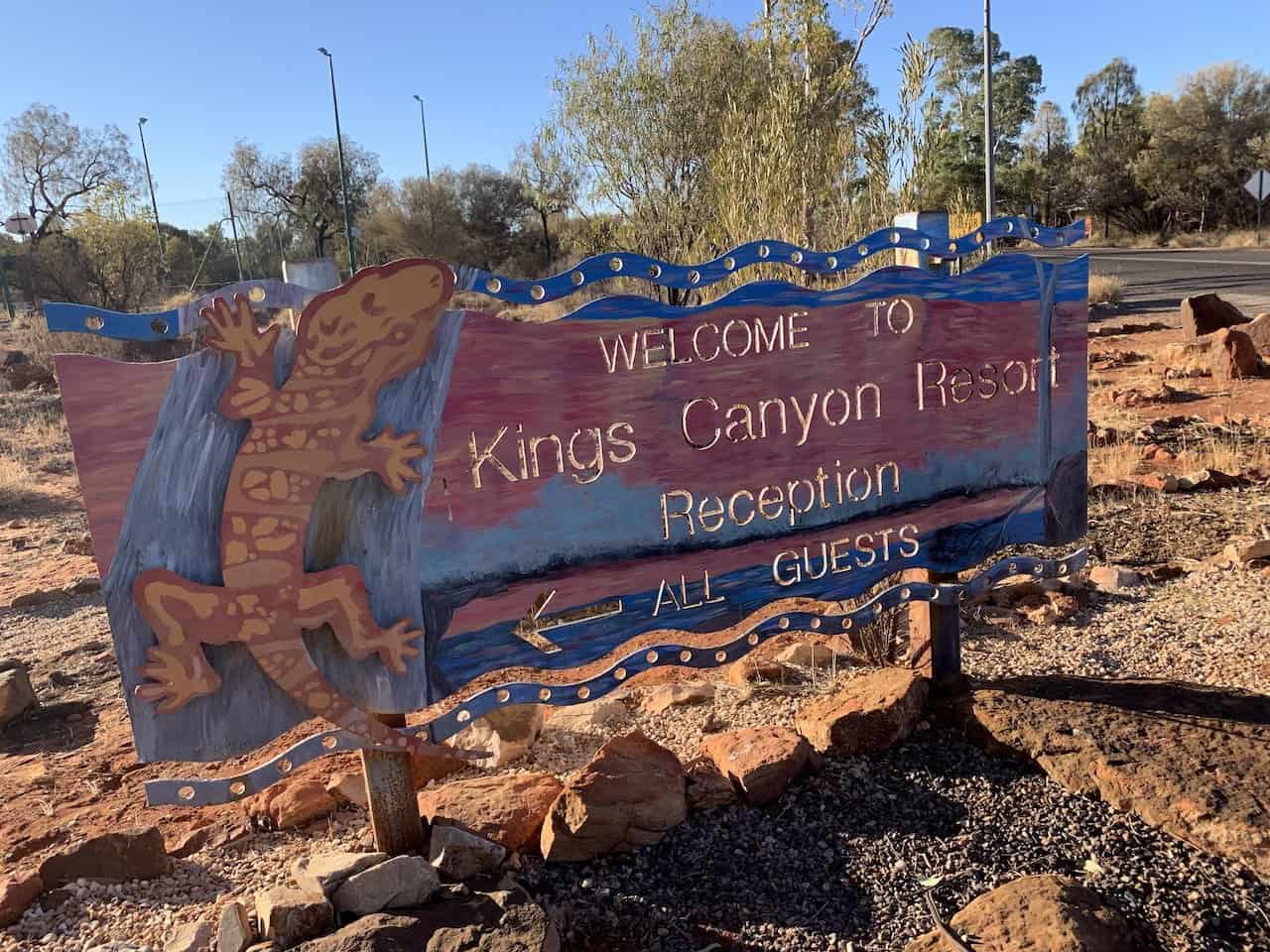
Alice Springs
Out of the three locations, Alice Springs will definitely have the most to offer from a variety perspective. Below though are just a few highly rated options at some different price points that you can choose from:
- Luxury | DoubleTree by Hilton Alice Springs
- Mid Tier | Crowne Plaza Alice Springs
- Budget | Alice’s Secret Travellers Inn
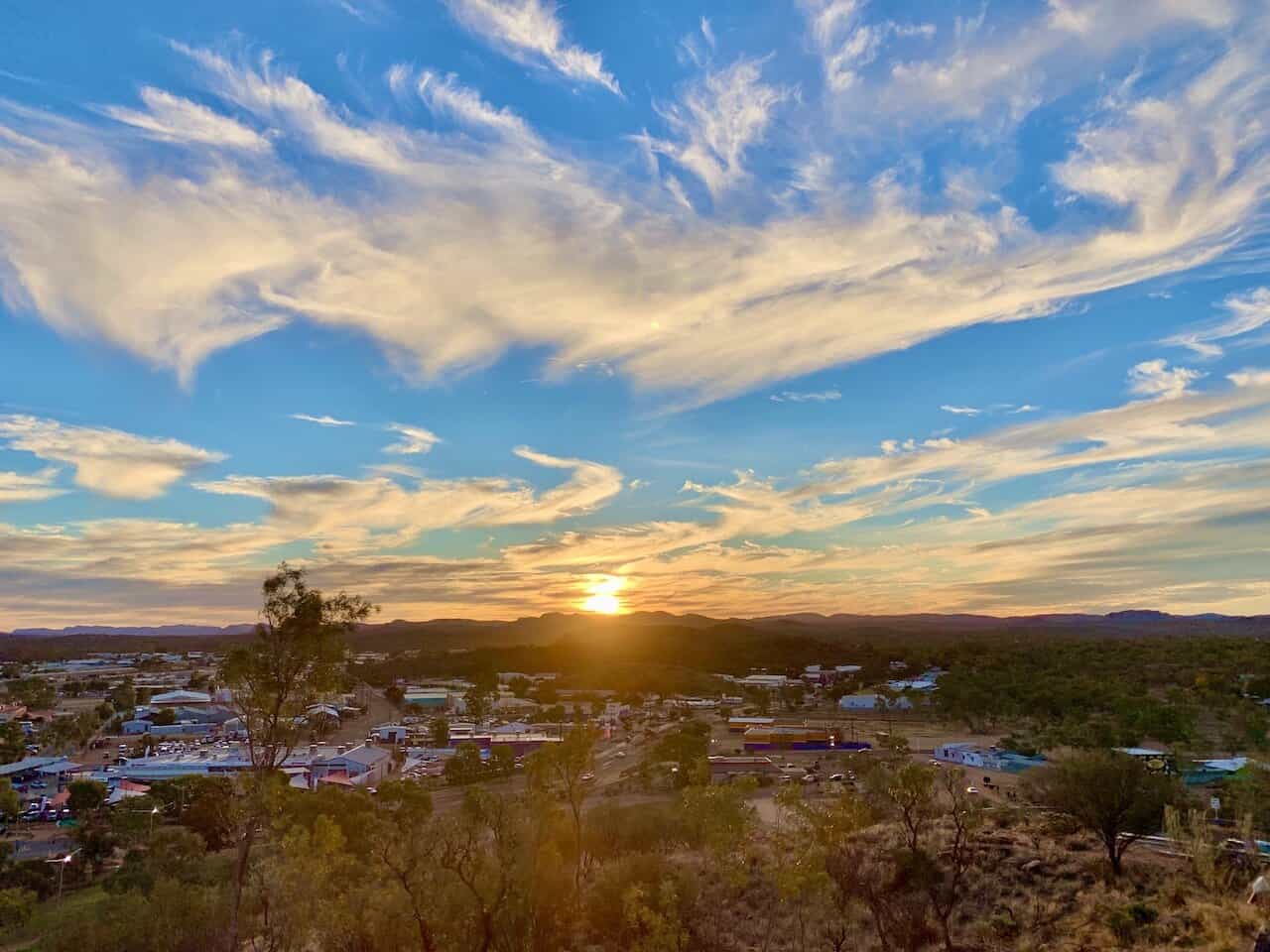
5) Red Centre Way Roads
On the map above you can see red and black colored roads as well as solid lines and dotted lines.
The red roads are the official Red Centre Way roads. The black roads are the nearest main roads that are not technically part of the Red Centre Way .
You will also see the solid and dotted lines there. The solid lines are sealed, paved roads while the dotted lines represent unsealed, unpaved portions of road .
This is important to point out as not every car is made to drive on these unsealed roads and not every car company even allows their cars to drive on them.
Don’t worry though, because at the end of the day, there is always a workaround on the sealed roads to get you to your next destination.
To give an overview of what an Uluru to Alice Springs itinerary could like look going on all sealed roads vs. using unsealed roads (which would save some driving time):
A) Uluru to Alice Springs Sealed Roads
1) Yulara to Kings Canyon Resort (Lasseter Highway to Luritja Road / 300 KM (186 Miles) / 3.5 Hours)
2) Kings Canyon to Alice Springs (Luritja Road to Lasseter Highway to Stuart Highway / 475 KM (295 Miles) / 5 Hours)
3) West MacDonnell Ranges Day Trip (Namatjira Drive / 265 KM (165 Miles) / 3 Hours Round Trip + stops)
B) Uluru to Alice Springs Unsealed Roads
If you decide to head on the Mereenie Loop unsealed road, you can change up your itinerary a bit to save some driving time.
Instead of staying night 5 in Alice Springs, you can stay at the Glen Helen Lodge instead.
2) Kings Canyon to Glen Helen (Mereenie Loop Road* / 235 KM (146 Miles) / 3.5 Hours) – UNSEALED
3) Glen Helen to Alice Springs (Namatjira Drive / 133 KM (83 Miles) / 1.5 Hours + stops)
*If you decide to go via option 2 on the unsealed Mereenie Loop from Kings Canyon to Glen Helen, you must get a Mereenie Loop permit.
These cost just $5 and can be purchased at Kings Canyon Resort or Glen Helen Lodge. And remember – double check with your car rental company ahead of time.
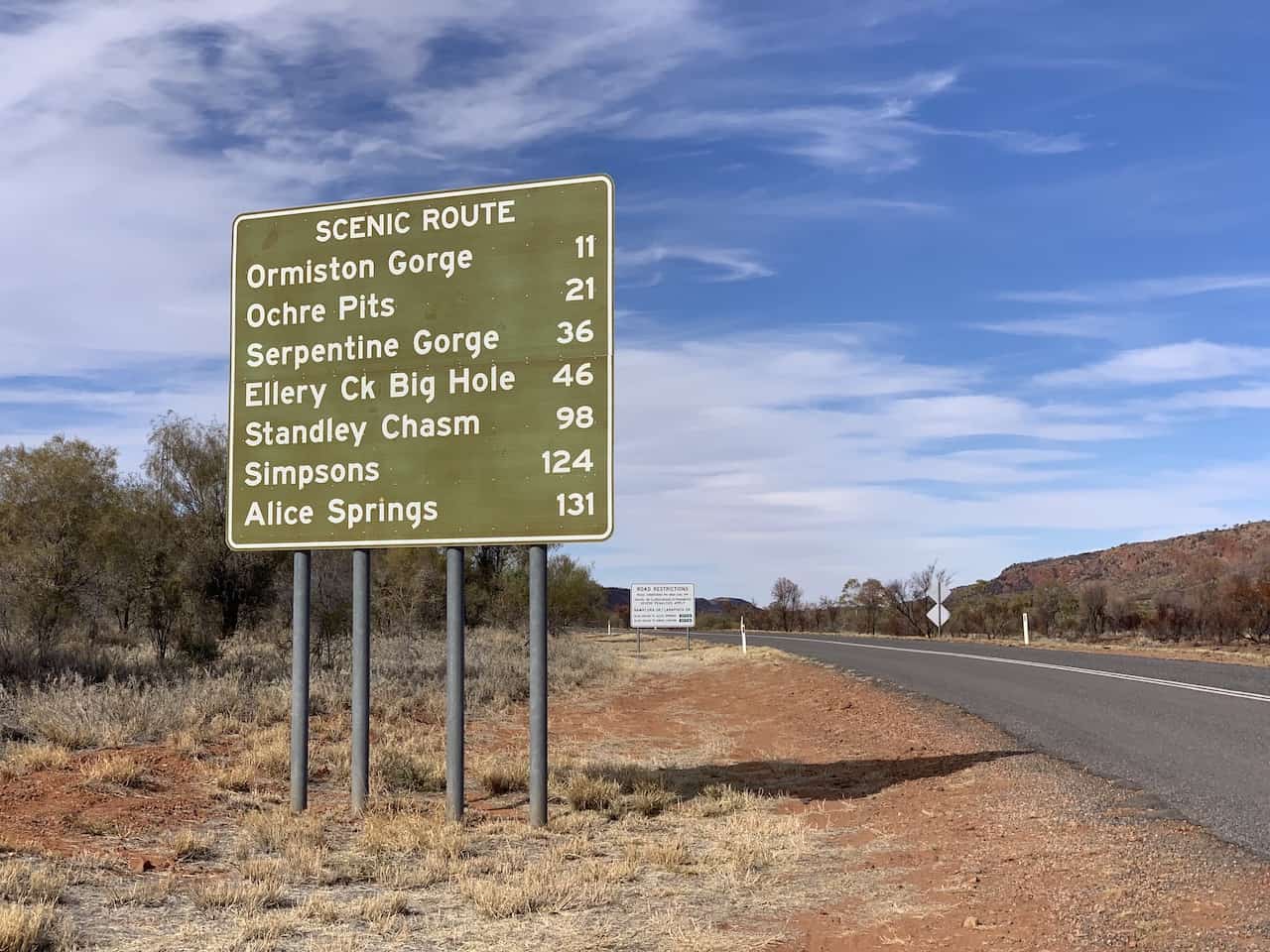
6) Uluru Car Hire
Now that you have a bit better understanding of the layout of the region, you can see why having a car rental is a great option to see it all at your own pace.
Renting a car can be expensive in the Outback, especially when you consider things like one way drop fees and limited kilometers on many rentals.
To get around these issues though, you can easily save some money by booking directly with Central Tourism Australia .
If you book directly through them (and using the itinerary above), you are most likely going to be saving some money and having a more stress free car rental experience.
By booking with Central Tourism Australia you may receive free unlimited kilometers on all car hires and will most likely have free one way rentals as well.
» Learn more about renting a car in Uluru by checking out the Uluru Car Hire Guide that goes into it all.
» If the that doesn’t work for you, feel free to check out Rentalcars.com , which will have various options to browse through. You can filter by car type, price, and more to find the perfect car for your trip.
» By following the itinerary, you will want to pick up in Yulara downtown or Ayers Rock Airport and drop off at Alice Springs Airport .
Note that picking up in Ayers Rock Airport instead of Yulara downtown may have higher costs for some companies.
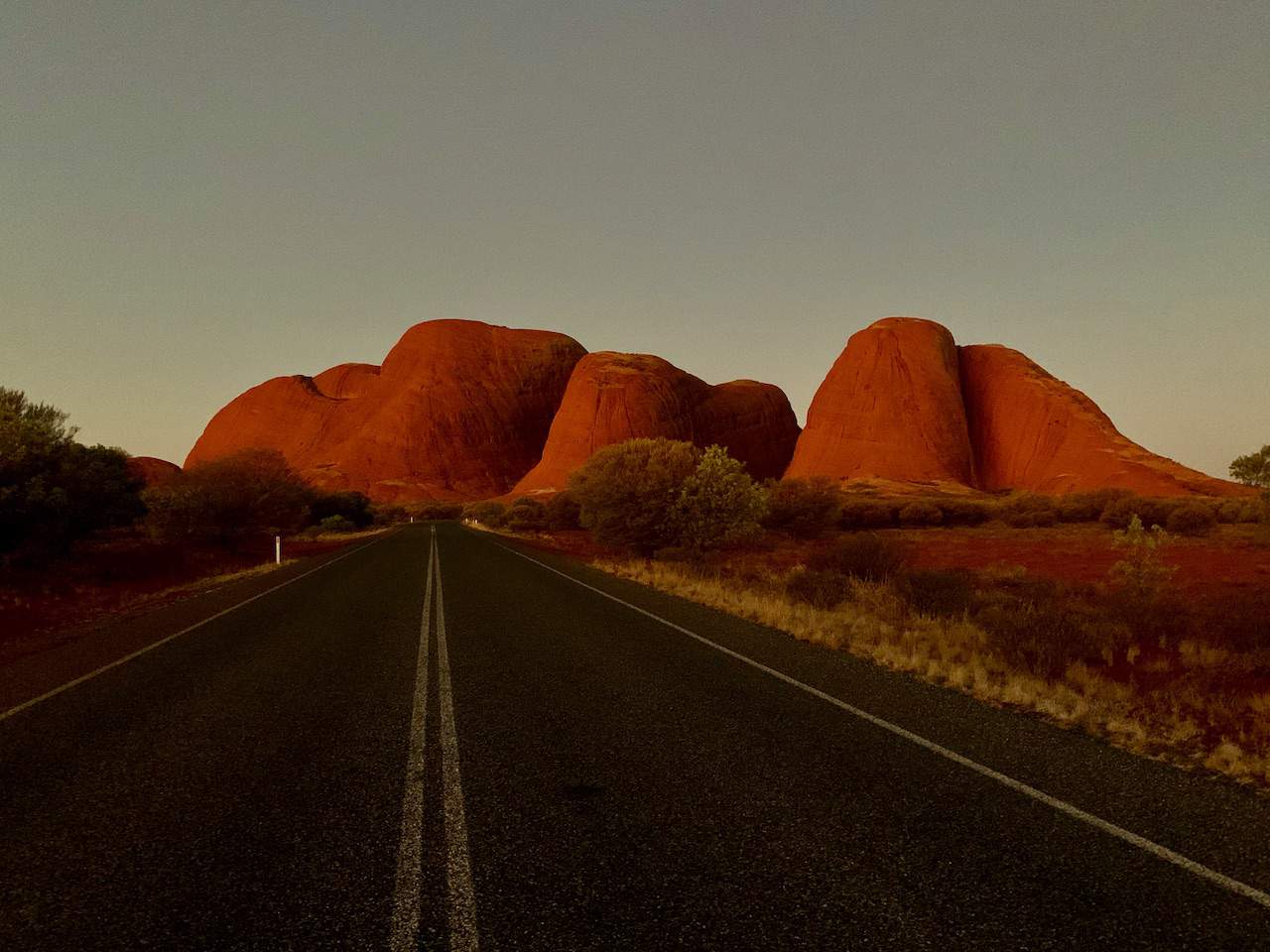
7) Yulara Helpful Information
Before diving into a day by day itinerary, I wanted to lay out some helpful information about Yulara and Kings Canyon so you can better prepare yourself for your time there.
While many people may just say they are going to “Uluru”, there is a bit more to lay out about the area. Below are some key places to note when visiting:
Ayers Rock Airport (AYQ)
The main airport closest to the Uluru-Kata Tjuta National Park is Ayers Rock Airport (AYQ). You can find flights from several different cities around Australia that fly directly into AYQ such as Sydney, Cairns and Perth.
The airport is also located just 10 minutes away from Yulara, the main town of the area that I will talk about more next.
Yulara is the main town (the only town) to stay in when visiting Uluru-Kata Tjuta National Park. The whole town is basically one large loop filled with several different hotels all around it.
You will also find a small “downtown” area with some restaurants, a supermarket, gift shops, gas station and an information center.
Voyages Ayers Rock Resort
This may seem a bit confusing, but the Voyages Ayers Rock Resort actually makes up most of Yulara.
The Resort runs several different hotels, a spa, and the restaurants and shops located in the town center. So, if you hear of the Ayers Rock Resort, just note that it basically the same thing as Yulara.
Uluru-Kata Tjuta National Park
A 10-minute drive from Yulara is the entryway to the Uluru-Kata Tjuta National Park. Within the national park you will find the two main attractions of the area – Uluru and Kata Tjuta.
Not only will you find these two magnificent rock formations, but you also will find the sunrise and sunset viewing areas for both of them.
To enter the national park though, you can only do so within certain hours of the day (just before sunrise and just after sunset). You will also need to purchase tickets to enter.
I would recommend purchasing tickets ahead of time to Uluru Kata Tjuta National Park .
These tickets can then be printed out or added to your Apple Wallet on your phone. Once you arrive at the national park entrance you can simply scan your paper or phone and be on your way.
If you do not purchase ahead of time, you will need to purchase tickets in a separate car line at the entrance.
National Park Ticket Prices
- Adult (18+): $38 AUD
- Child (0-17): Free
At time of purchase you can choose how many days you would like to spend in the park. The tickets are valid for up to 5 days at no additional cost.
National Park Hours
The Uluru Kata Tjuta National Park hours depend on time of year. It opens early enough to make it to those sunrise points, and closes late enough to enjoy sunset within the park. Below is the latest as of 2023:
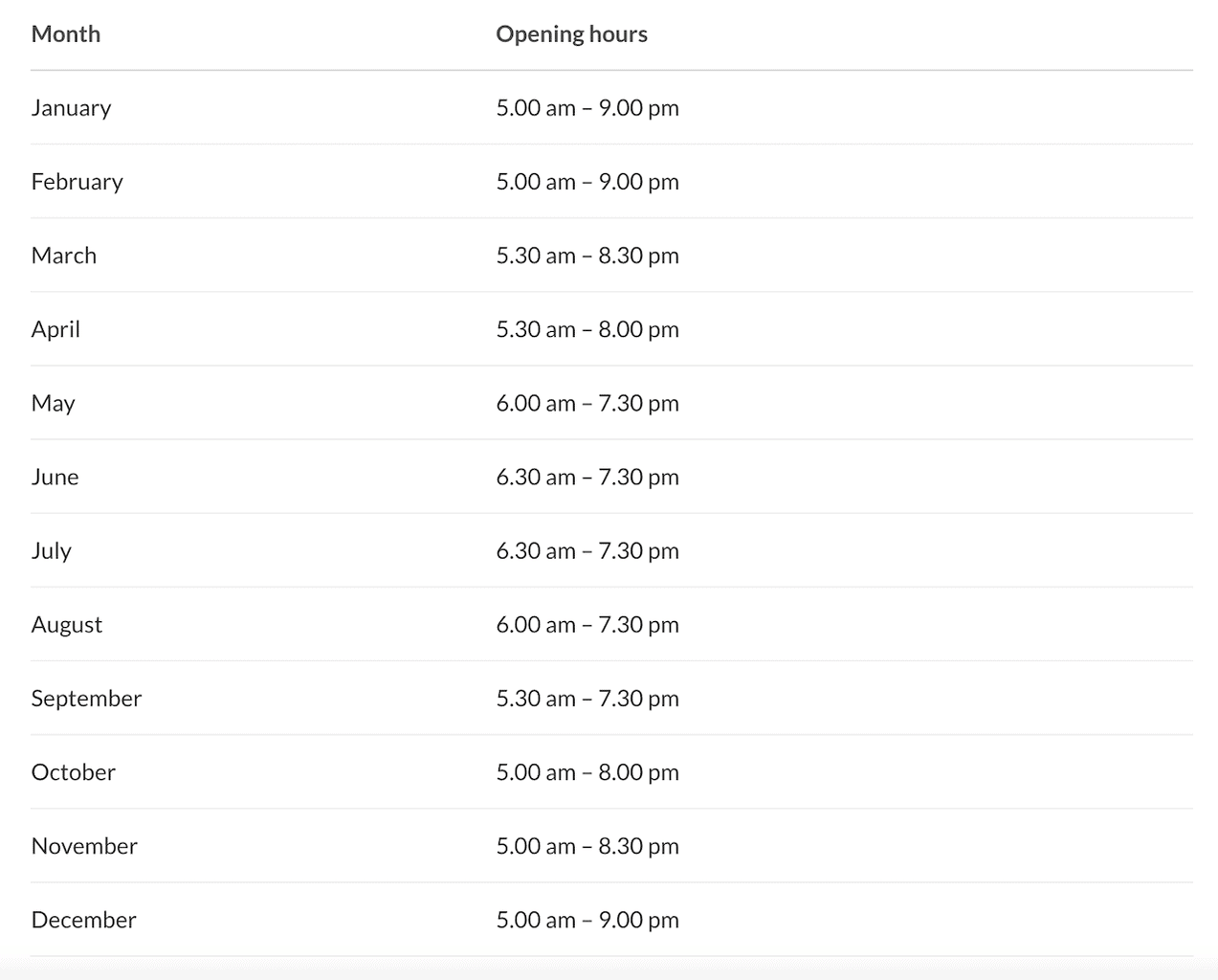
8) Kings Canyon Helpful Information
After a visit to the Uluru-Kata Tjuta National Park area, you can spend some time enjoying what Kings Canyon has to offer. Below are some quick notes about the area and what to expect:
» The main attraction here is Kings Canyon itself – a massive rock formation in the middle of the Outback with some stunning views all around. It is home to the Kings Canyon Rim Walk – a 4 hour hike up and around the canyon walls .
» Besides Kings Canyon you will not find much else in the area. Another potential stop could be the Kathleen Springs Walk, an easy 1.5 hour round trip walk.
» Since Kings Canyon is located pretty far away from any other major attractions, you will only find two potential accommodation options – the Kings Canyon Resort (8 minutes away from the Rim Walk) and the Kings Creek Station (25 minutes away).
» The Kings Canyon Resort has a few different restaurant options as well as a gas station and convenience store across the road.
» As mentioned earlier, there are two potential routes from Kings Canyon to Alice Springs . One on sealed roads and one on unsealed roads (Mereenie Loop). If headed on the Mereenie Loop be sure to get the permit at Kings Canyon (and make sure that your car rental company allows it!).
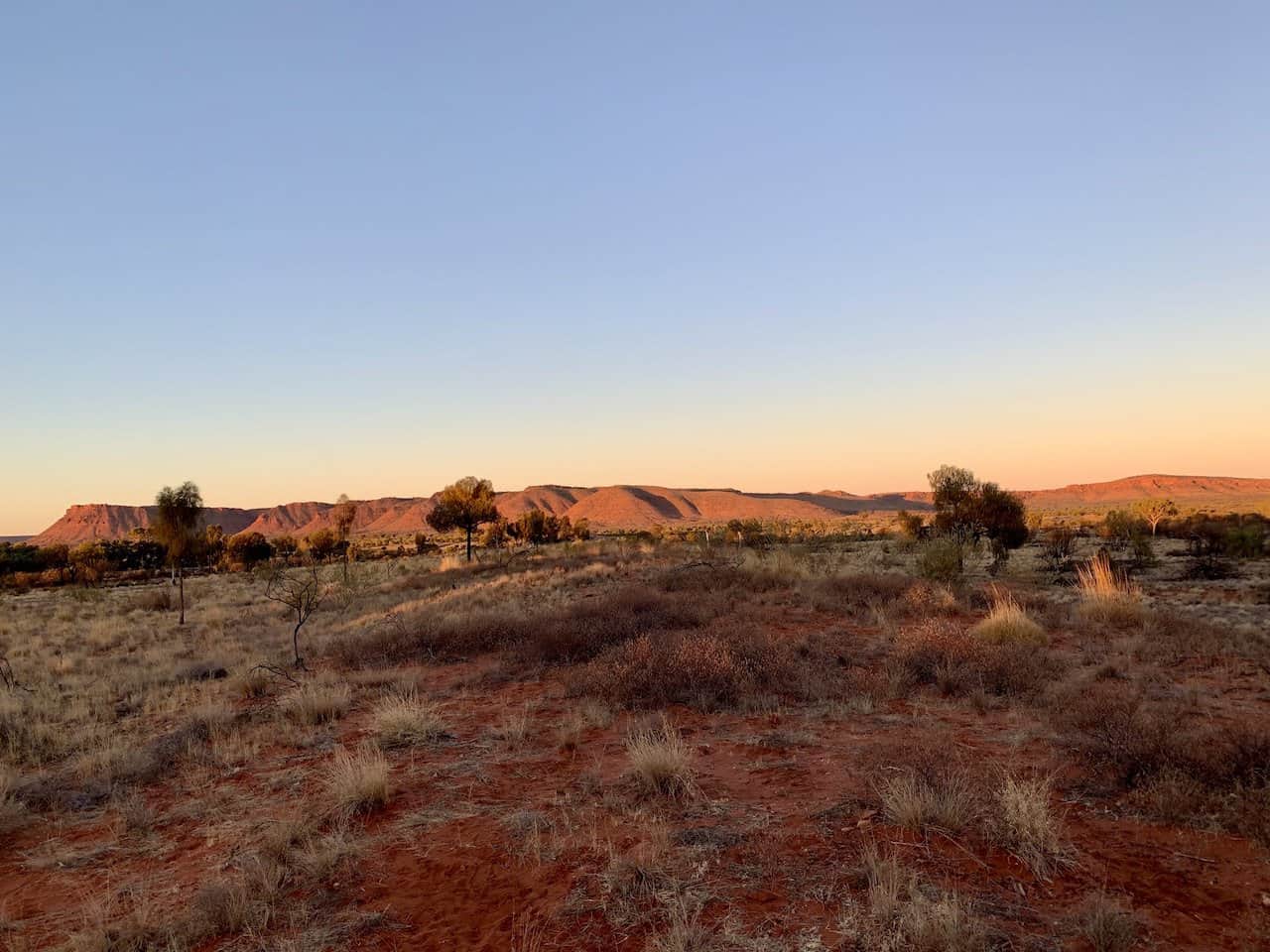
9) Uluru to Alice Springs Red Centre Way Route
Now that you have a bit better overview of the logistics of the Uluru to Alice Springs route and how to go about planning the itinerary, let’s dive into a more detailed view of each day.
As mentioned, we are going to start this trip off in Yulara and end in Alice Springs. You can opt to do this in the opposite direction as well if that fits better into your overall itinerary.
Day 1 – Arrive in Yulara
Highlights : Enjoy Yulara & Uluru Sunset Overnight : Yulara
On your first day in the Outback you will want to fly into Ayers Rock Airport (AYQ), the closest airport to the Uluru-Kata Tjuta National Park.
You can opt to rent a car directly from the airport OR you can take the free shuttle bus service to Yulara (where all hotels are located), and pick up your car in town.
Once you have your car rental, you can spend the rest of the afternoon getting settled into your hotel, buying groceries, and enjoying a walk around Yulara.
Later in the afternoon, make your way to the Uluru Sunset Area .
Be sure to get there with plenty time to spare though! Uluru begins to turn bright red as the sun starts to get lower and lower so you don’t want to miss out on the best part of sunset.
» Learn more in the Uluru Sunset & Sunrise Guide up on the site
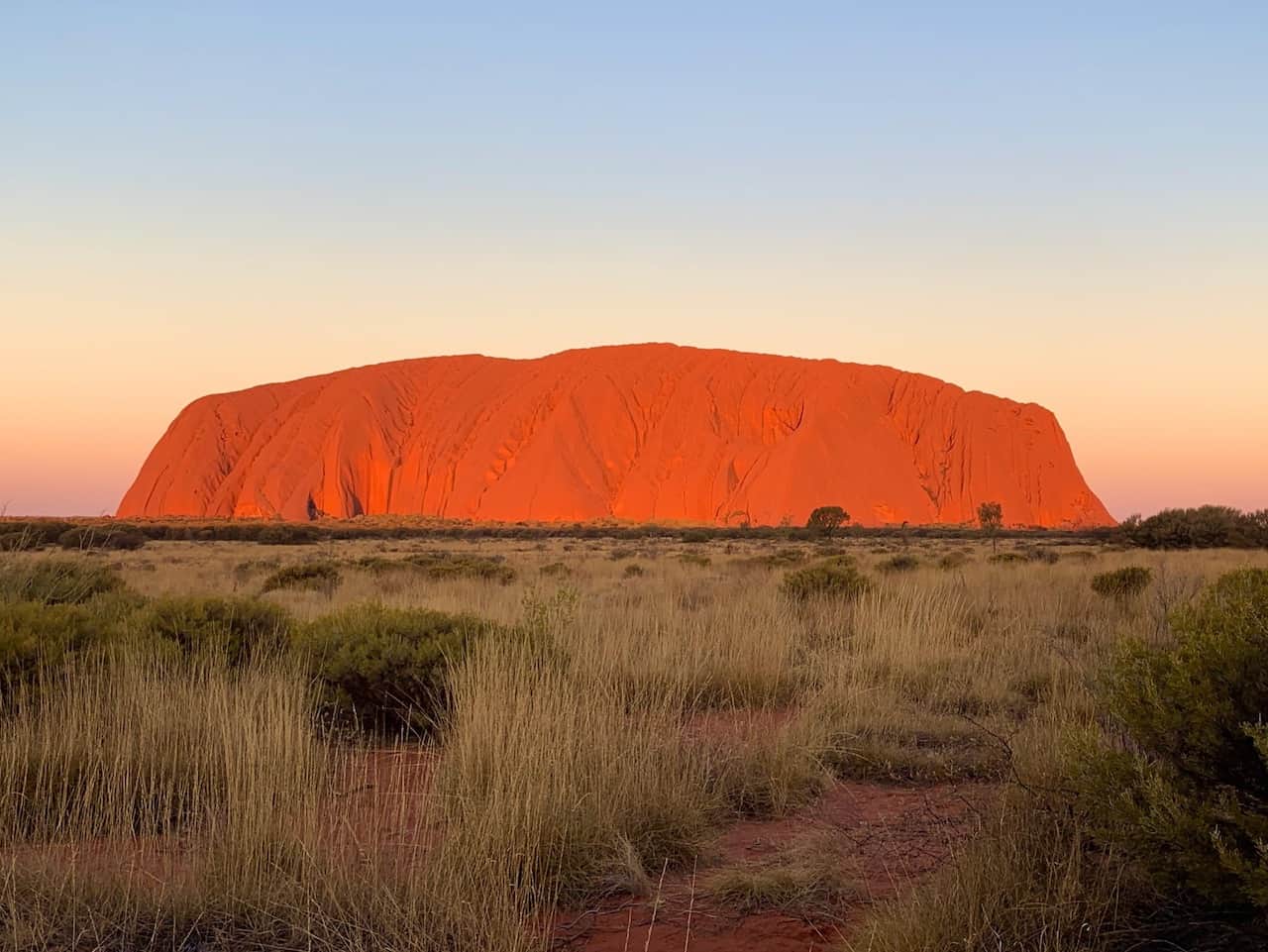
Day 2 – Uluru
Highlights : Uluru Sunrise & Uluru Base Walk Overnight : Yulara
Day 2 will begin bright and early as you awake for an Uluru sunrise.
Once again you will make your way to the National Park entrance, show your tickets and head to the sunrise viewing area (note that this is different than the sunset viewing area).
The sunrise viewing area is set further back from Uluru itself, where you can begin to see the sun light up the rock and also see Kata Tjuta all the way out in the distance.
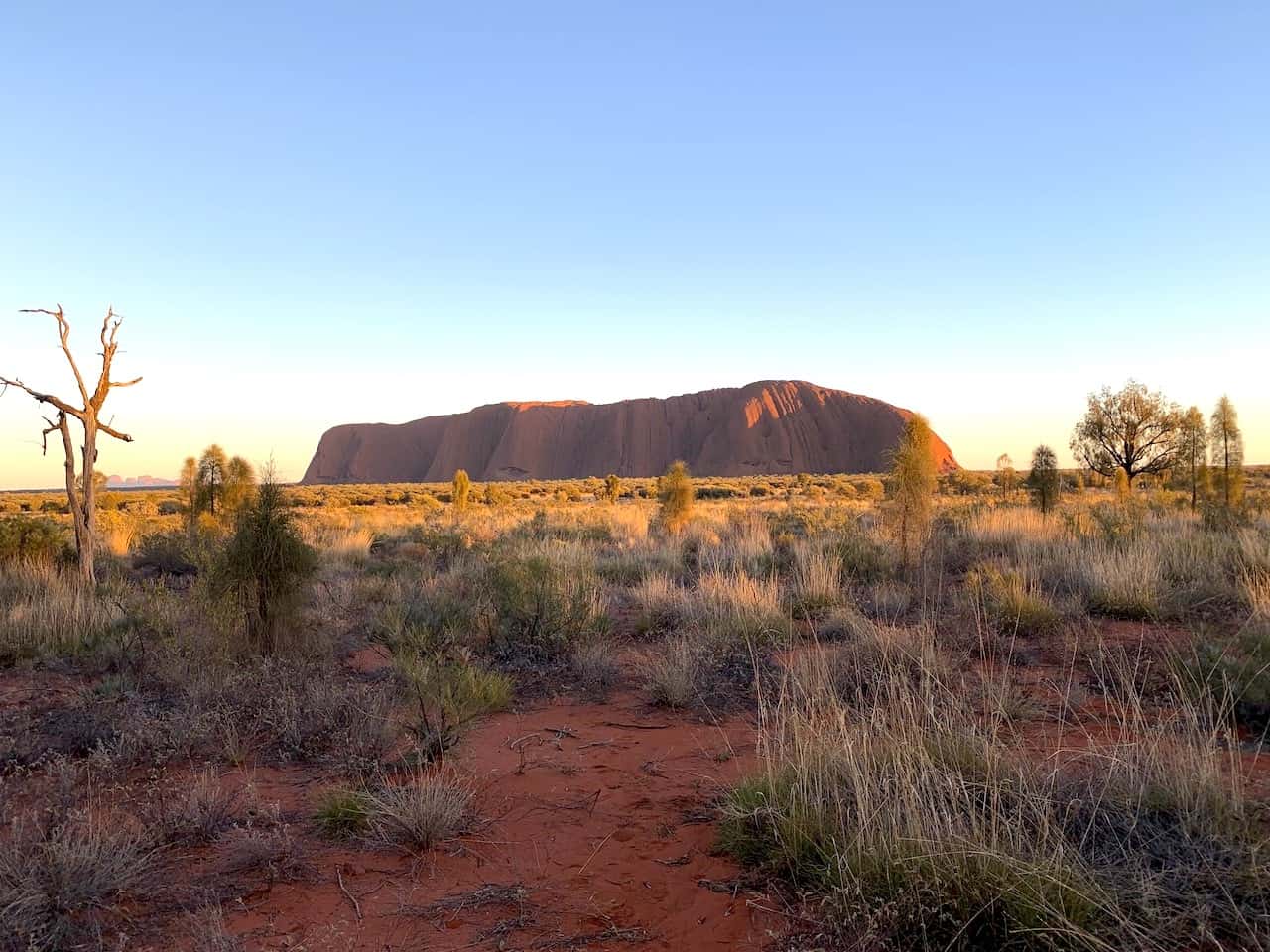
After a sunrise, you can drive to the Uluru car park. Here is where you can begin the famous Uluru Base Walk .
This 10KM / 6 Mile trail will take you all around the rock of Uluru as you get to experience it from all different angles.
At some points you will be right up close to it and at other points you will be able to enjoy the entire rock from a distance.
Overall, it is a fantastic walk to take part of and since it is all flat, nearly anyone can walk it for themselves. And if you don’t want to walk it you can also bike ride the trail or even take a Segway tour !
» The Uluru Base Walk Guide will go over everything you need to know about the trail
If you are not up for the entire loop, I would at least recommend taking part of the Mala Walk (same parking lot where you would start the base walk from), and after that I would drive to the Kuniya parking lot. There you can part of the Kuniya Walk. Both of these walks are part of the larger Uluru Base Walk.
After finishing up at Uluru you can head back to Yulara to grab some lunch and relax for the rest of the day.
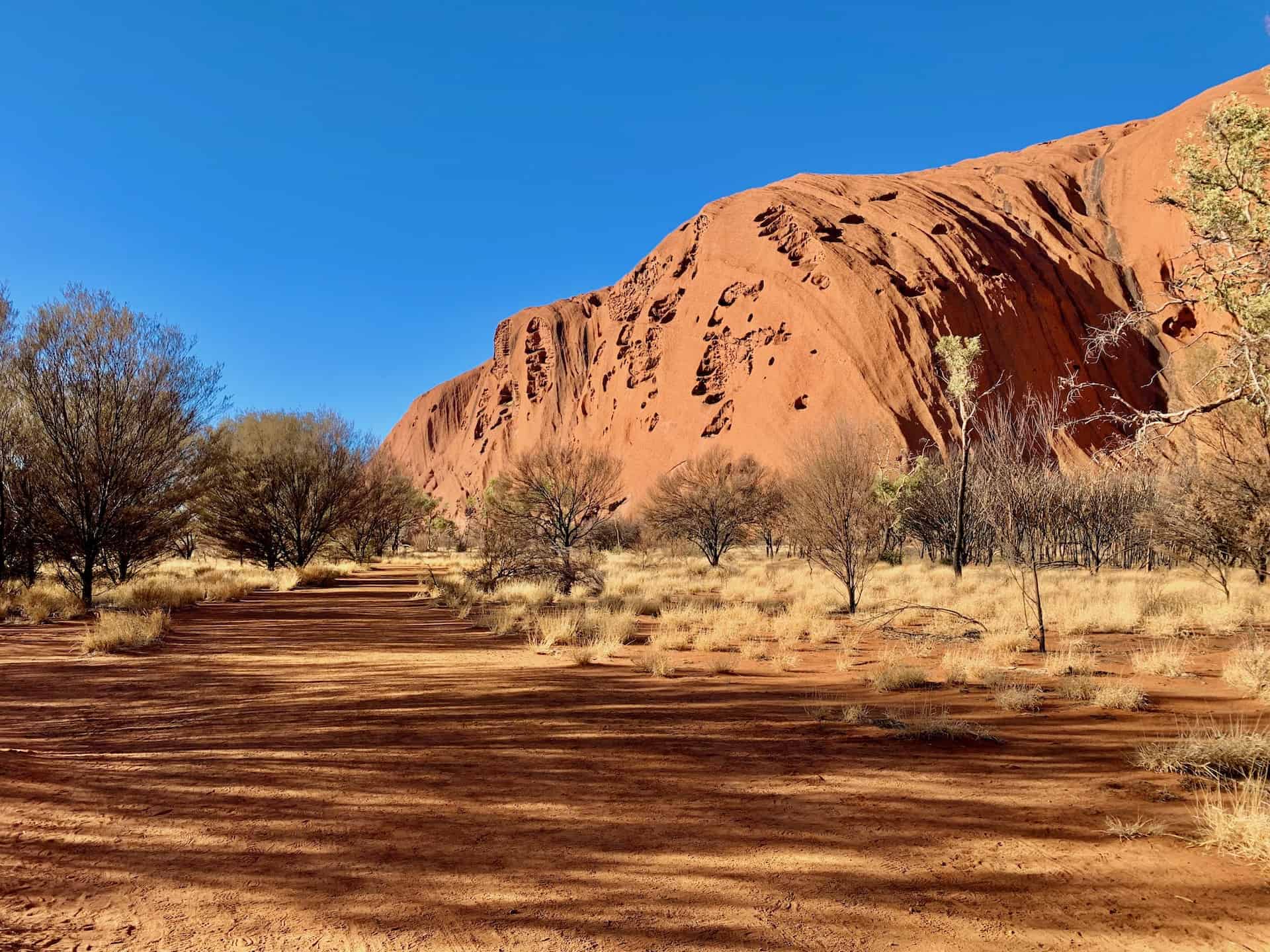
Day 3 – Kata Tjuta
Highlights : Kata Tjuta Sunrise / Valley of the Winds Walk / Kata Tjuta Sunset Overnight : Yulara
Now that you have explored all that Uluru has to offer, it is time to do the same at Kata Tjuta. Once again you can wake up nice and early and head on over to the Kata Tjuta Sunrise Area.
This was one of my favorite sunrises that I have experienced as you see Kata Tjuta from up close slowly lighting up with Uluru way out in the background.
» Learn more in the Kata Tjuta Sunrise and Sunset Guide up on the site
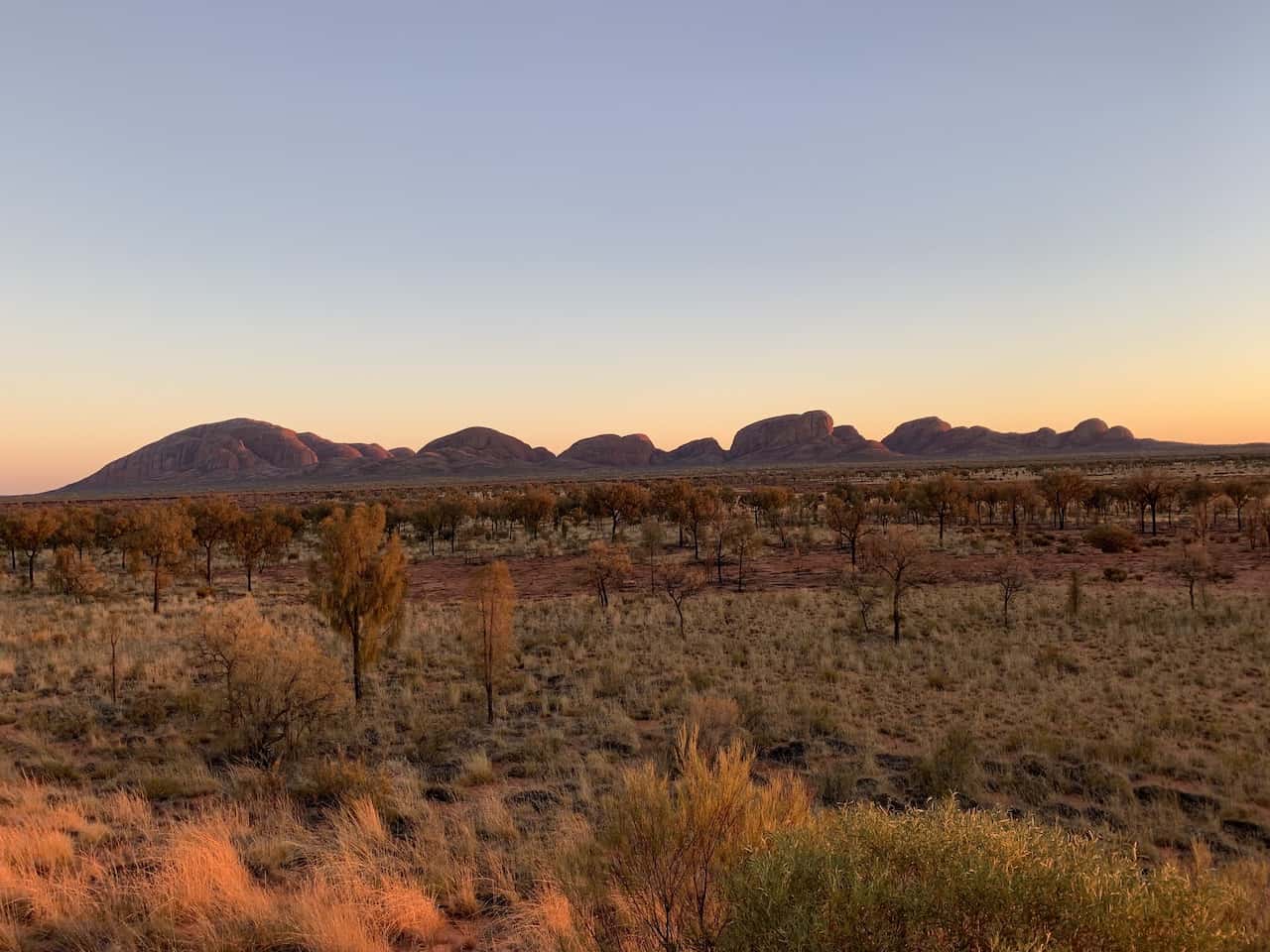
Once sunrise is complete, make the quick drive to the Kata Tjuta Valley of the Winds parking lot. Here you can take part of the impressive Valley of the Winds Walk that will take you through the ins and outs of the Olga rock formations.
Now this walk is much tougher than the previous Uluru Base Walk. There are several inclines and declines throughout and on a hot day it can take a toll on you.
With that said though, the Valley of the Winds Walk is a must do in my book with plenty of scenic views all throughout.
» Learn more about the walk in the Valley of the Winds Guide up on the site
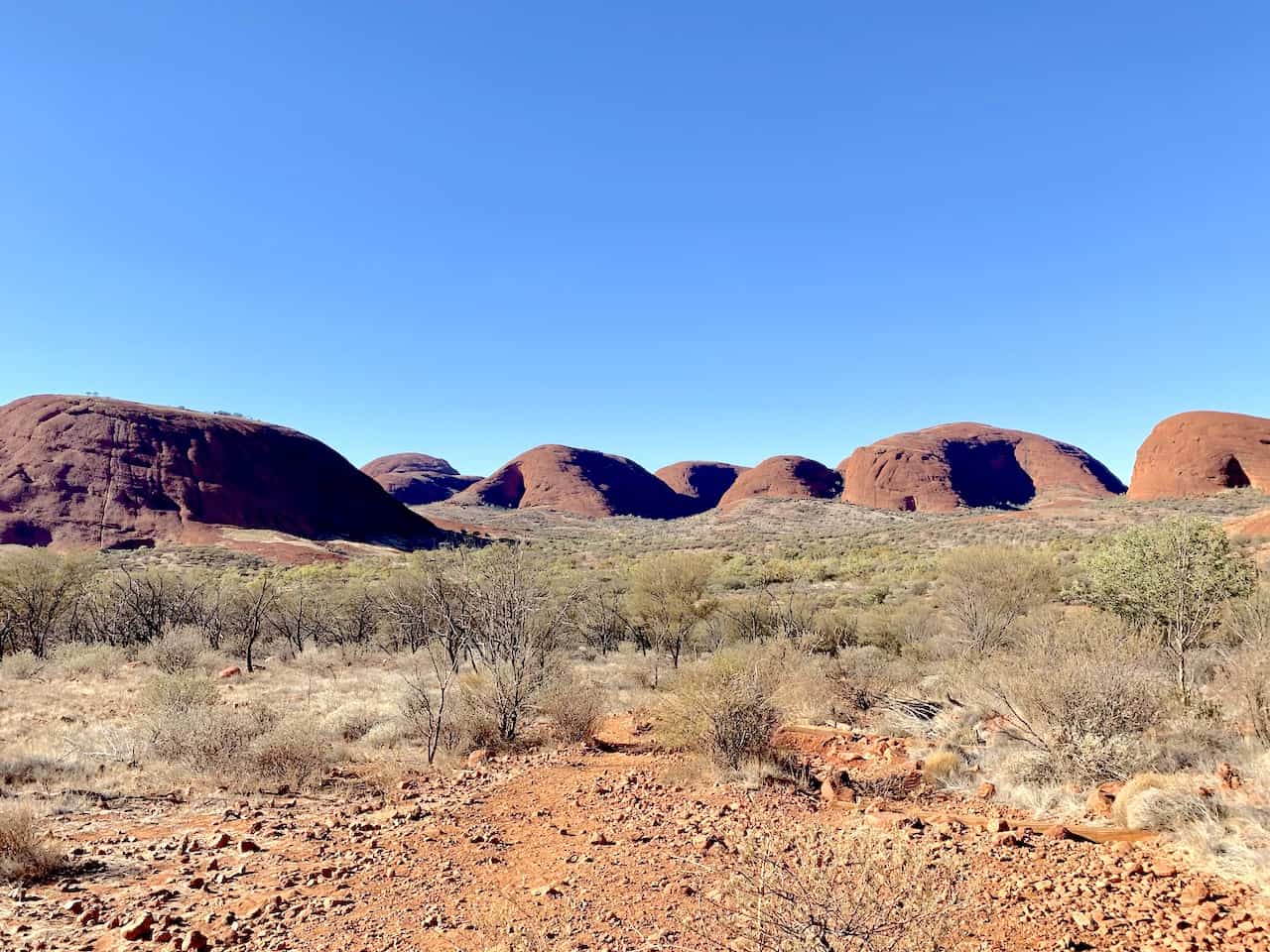
If you are not up for the full walk you can also just head to the first lookout point and/or head to the Walpa Gorge – a much less strenuous walk that takes you between two giant Olga walls.
Odds are after the Valley of the Winds Walk, you will have some time to spare until sunset.
You can either head back to Yulara for rest of the afternoon or you can stop by the Uluru Visitors Center, where you can relax and have some lunch before returning to the Kata Tjuta Sunset Area .
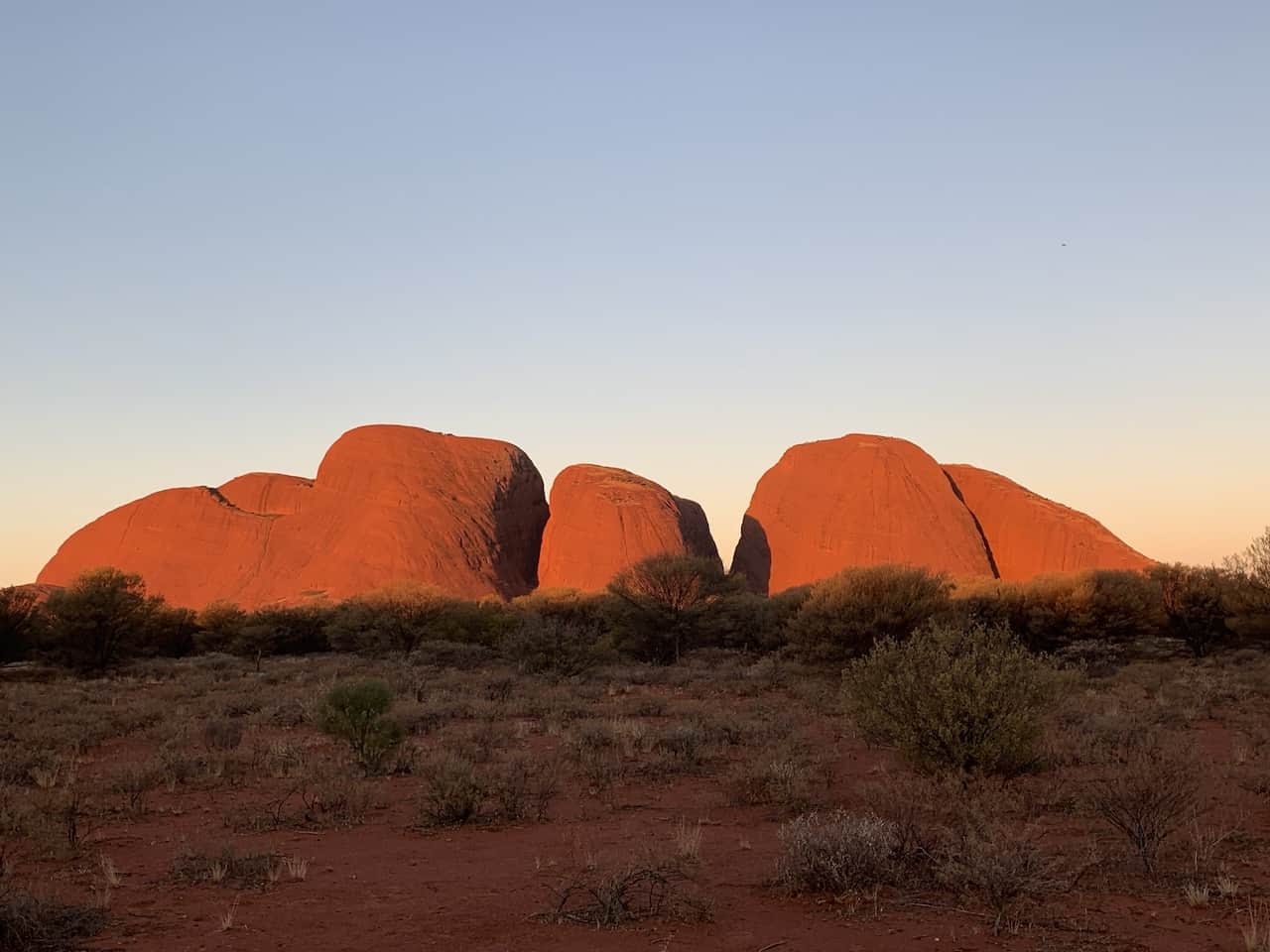
Day 4 – Kings Canyon
Highlights : The King Canyon Rim Walk Overnight : Kings Canyon
After enjoying Uluru-Kata Tjuta National Park, you can now make the drive all the way to Kings Canyon. The drive will take the better part of 3.5 hours as you drive through the Outback.
I would recommend leaving as early as possible (after sunrise) so you can get to Kings Canyon by late morning.
Once you arrive at Kings Canyon you can go straight to the Kings Canyon Rim Walk parking lot, where you can start the hike.
The Kings Canyon Rim Walk is an absolutely breathtaking hike that will take you up, around and down the canyon. You will get to experience vast landscape views alongside the variety of rock formations of Kings Canyon.
Besides for the one incline towards the beginning of the trail that will take you up to the rim, the remainder of the path is pretty easy altogether.
» The Kings Canyon Rim Walk Guide has you covered when it comes to learning more about the hike
If you are not up for the entire Rim Walk, your other option here is to just enjoy the Kings Creek Walk that will take you to a nice lookout point down below.
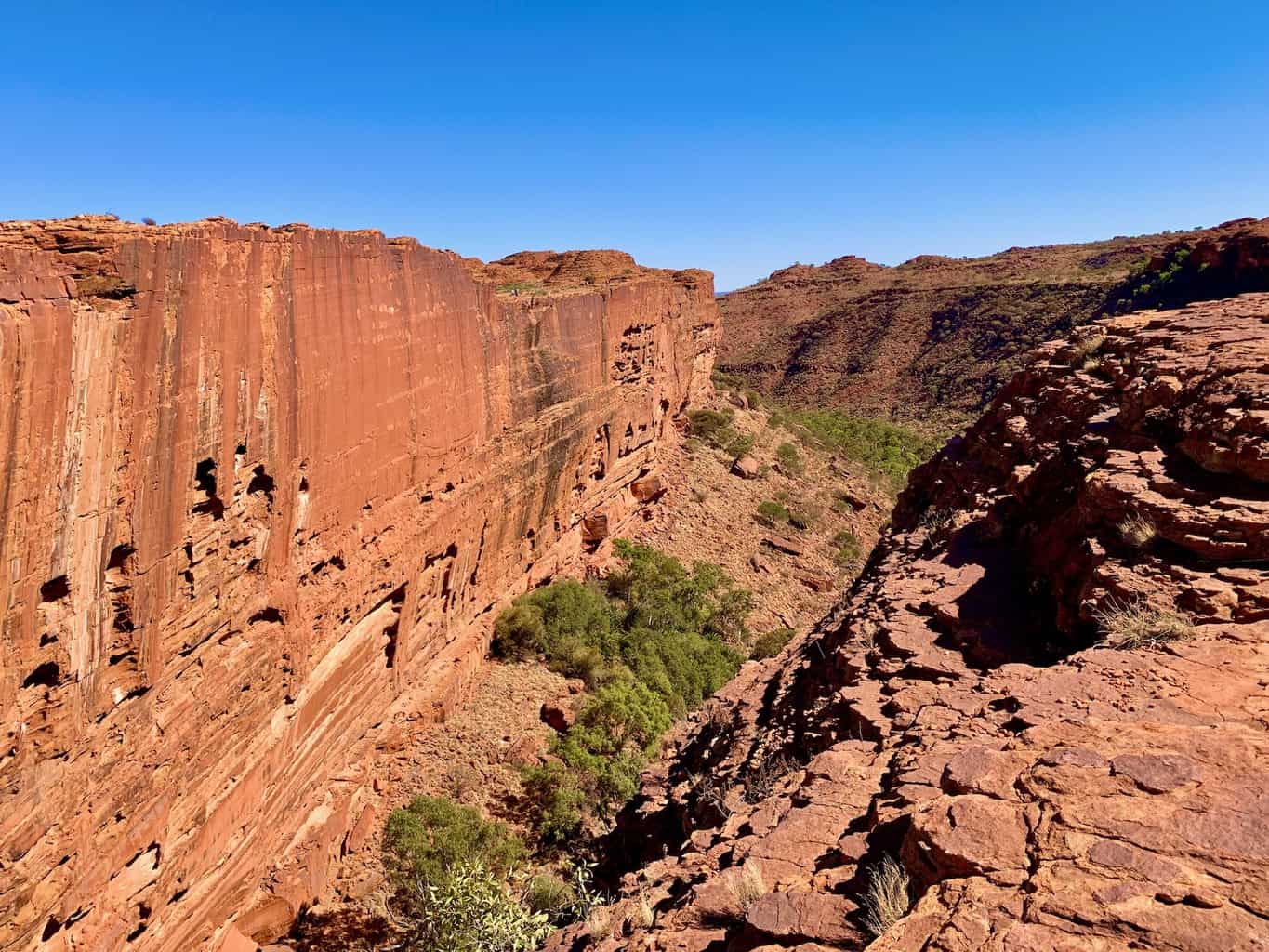
Day 5 – Drive to Alice Springs
Highlights : Kangaroo Sanctuary Tour Overnight : Alice Springs
For this itinerary I am going to assume you will not head on the unsealed Mereenie Loop road. Instead you will make the 5 hour drive to Alice Springs via Luritja Road / Lasseter Highway / Stuart Highway.
For the most part this is just going to be a driving day.
However, if this happens to be Wednesday to Friday for your itinerary, I would highly recommend taking part of the Kangaroo Sanctuary Tour that begins later in the afternoon .
Chris Barns runs an incredible facility that rehabs injured kangaroos from all around the country. During a tour of the sanctuary you will learn all about the rehab process and get to see plenty of baby and adult kangaroos all around.
It will be a memorable experience to take part of and is sure to be a highlight of your time in the Outback. You can sign up for the tour on the official Kangaroo Sanctuary website .
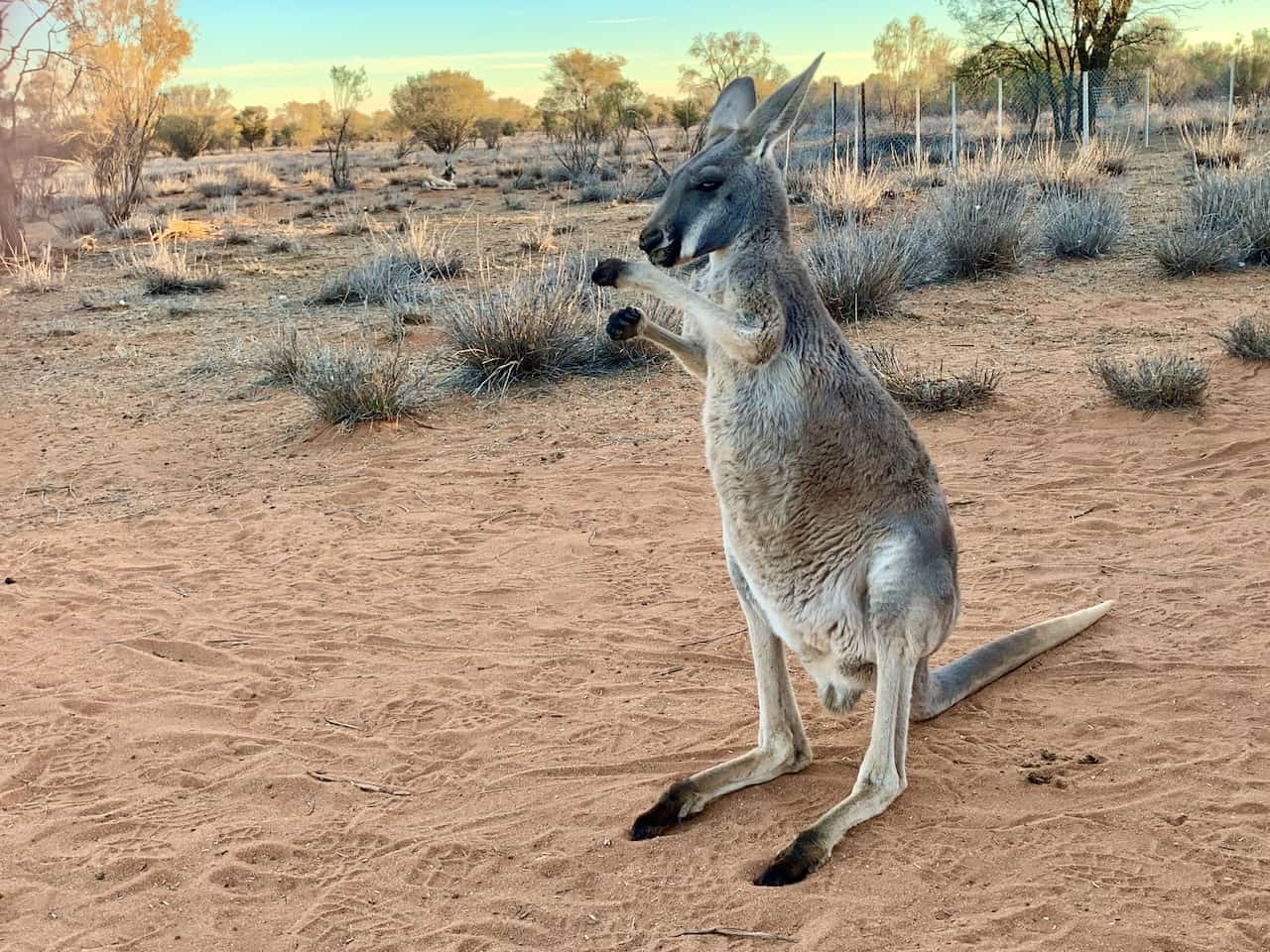
Day 6 – West MacDonnell Ranges Day Trip
Highlights : West MacDonnell Ranges Overnight : Alice Springs
One of the best day trips you can do from Alice Springs is explore everything that the West MacDonnell Ranges have to offer.
There are several attractions that you can stop by, some of which offer just a quick 10 minute walk from the parking lot, while others offer longer hiking options around the area.
During my time in the West MacDonnell Ranges, I stopped by the following 7 attractions:
- 1. Simpsons Gap
- 2. Standley Chasm
- 3. Ellery Creek Big Hole
- 4. Serpentine Gorge – » Learn more in the Serpertine Gorge Guide
- 5. Ochre Pits
- 6. Ormiston Gorge – » Learn more in the Ormiston Gorge Guide
- 7. Glen Helen Gorge
I won’t dive into each one in this itinerary. Instead, I would recommend checking out the West MacDonnell Ranges Itinerary up on the site that will go into much more detail about each place and what they offer.
At the end of the day though, you will simply turn back around and drive back to Alice Springs to finish up the day trip. If time allows maybe you can head up to Anzac Hill for one final Outback sunset.
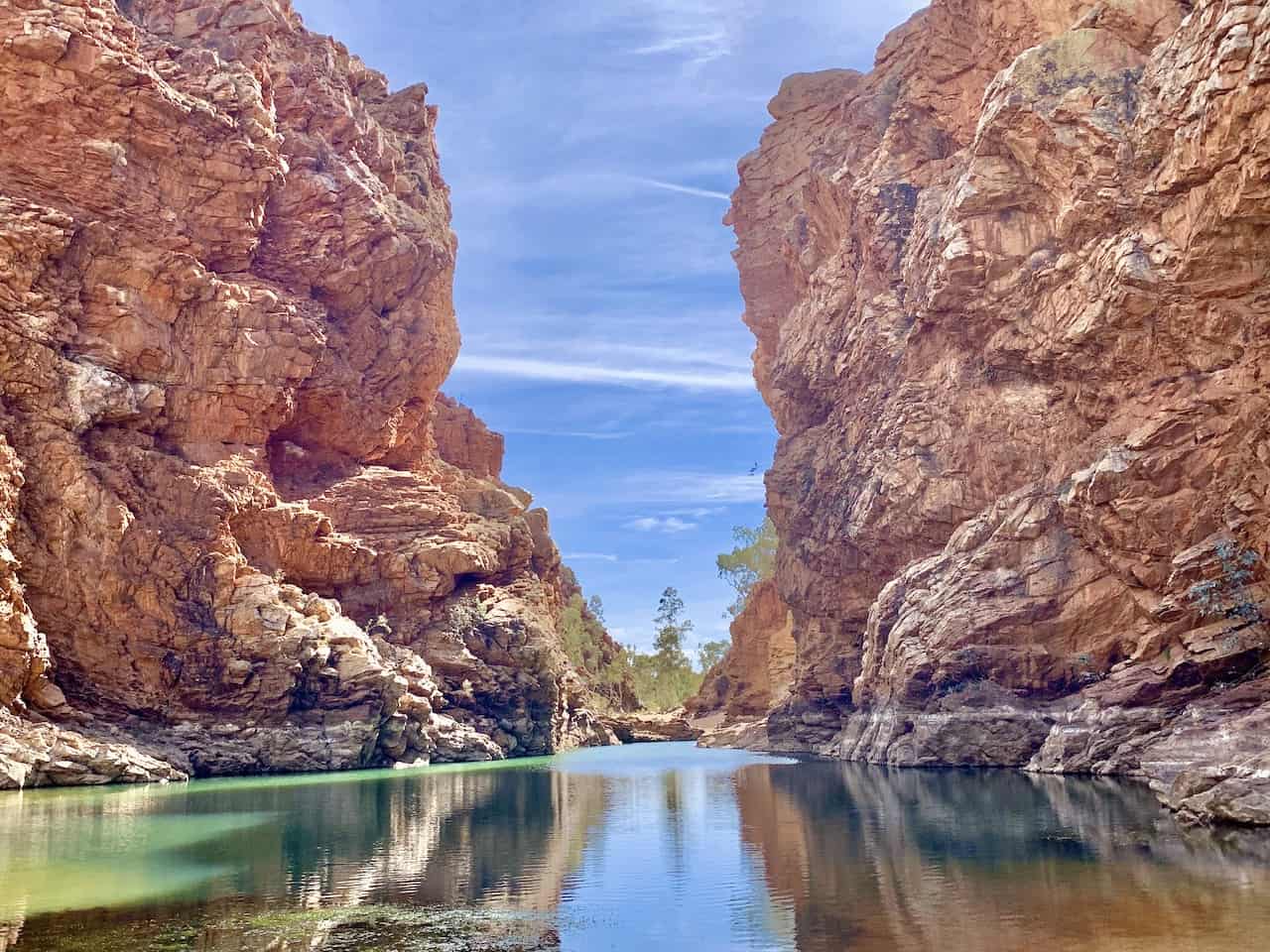
Day 7 – Depart Alice Springs
On your last day of this Uluru to Alice Springs road trip, it is time to head out to your next destination.
When you arrive at the airport, head on over to the car rental return area, where you can drop your car off before making your way onto your flight.
Overall, this Red Centre Way Uluru itinerary gives you a great overview of everything that the area has to offer. You will make your way to all the main highlights as you enjoy some of the best natural beauty in all of Australia.
I sure hope this has helped you out plan your trip to the Outback! If you have any questions or comments, feel free to add them in below.
Also don’t forget to check out the other Australia itineraries and guides up on the site that can be combined into a 3 Week Australia Itinerary .
Have fun out there and safe travels!
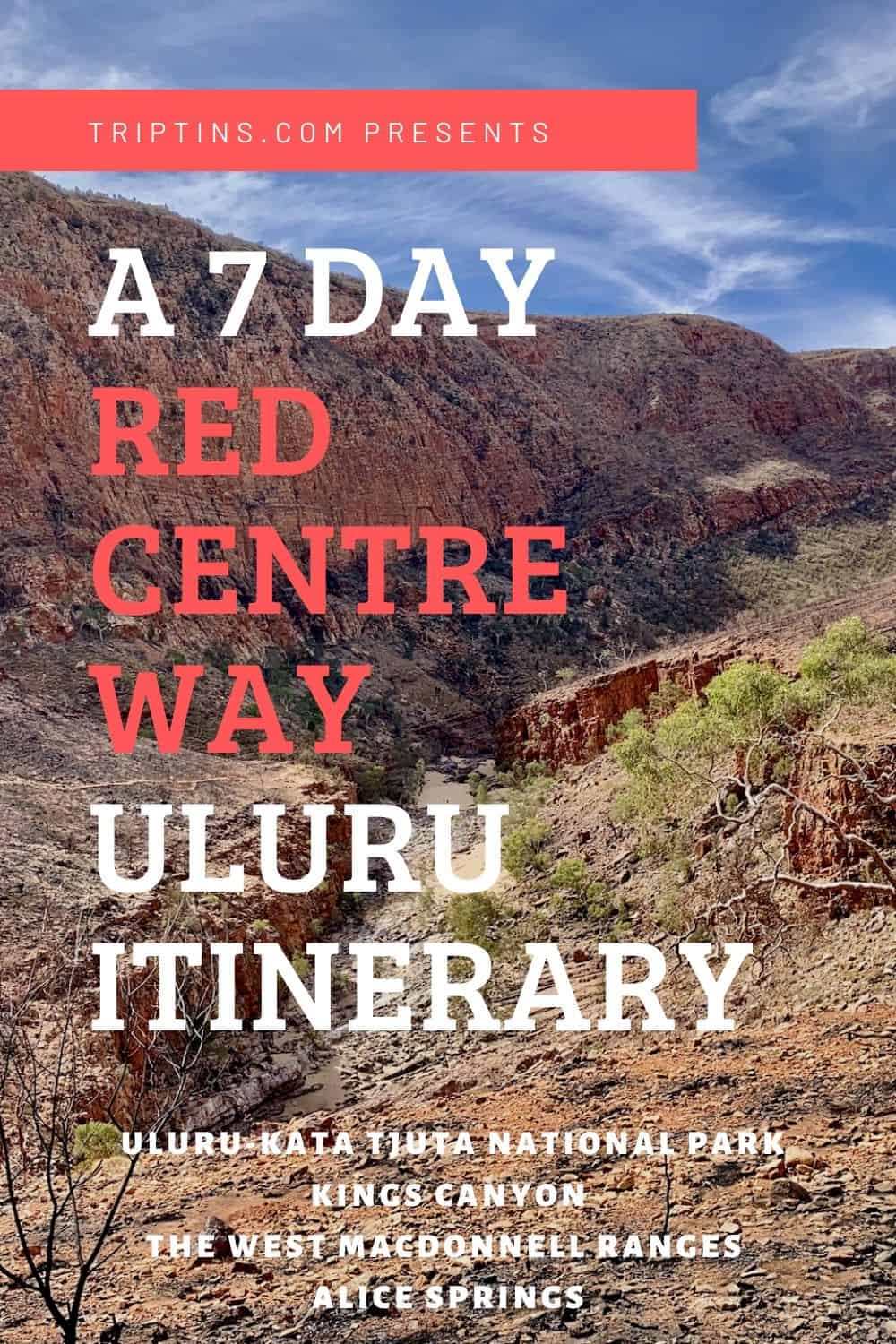
Related posts:
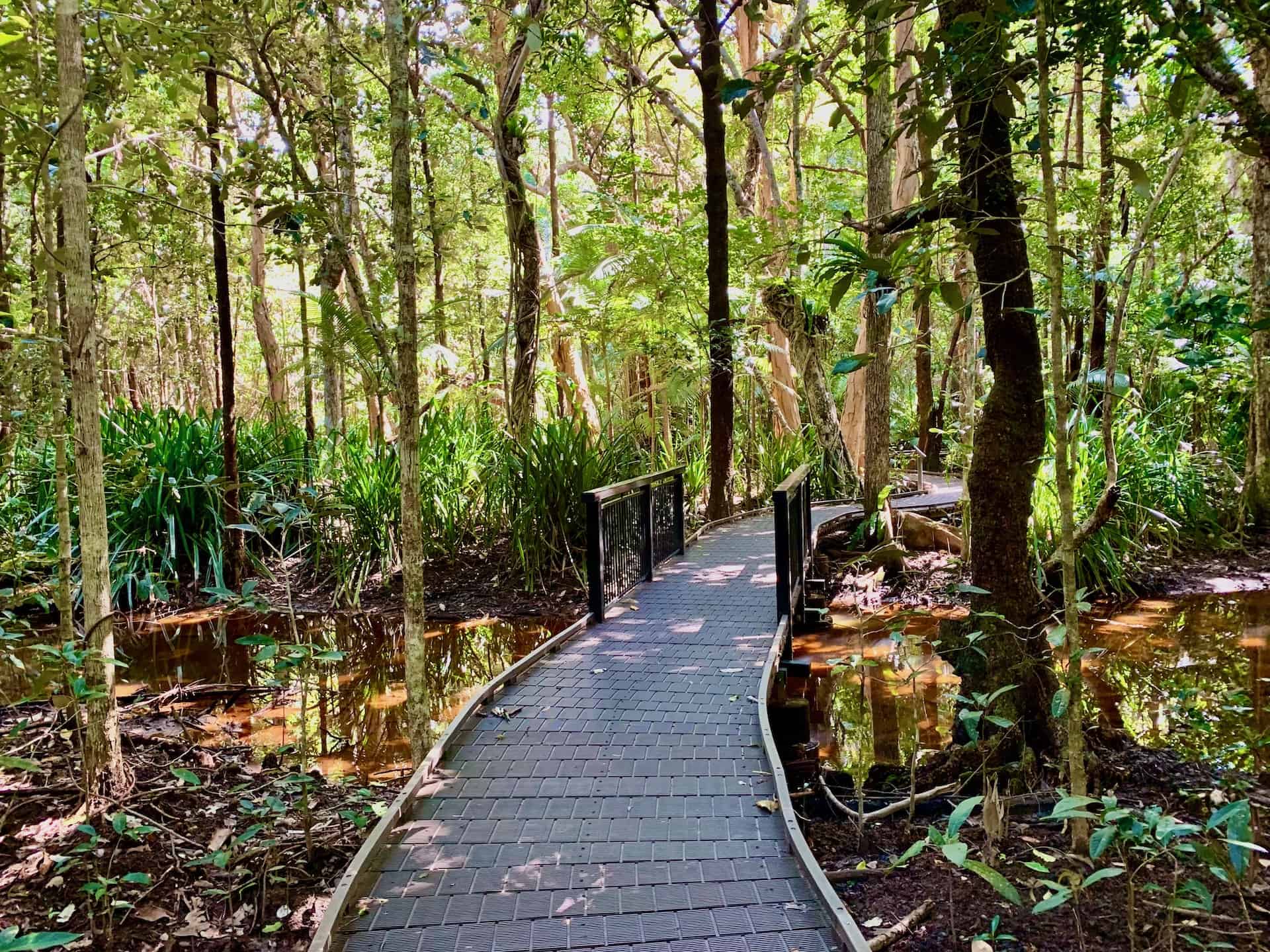
Sharing is caring!

The 10 BEST Things to Do in Uluru [2024 Guide]
- Last Updated: January 13, 2024
From enjoying sunrise at Uluru to walking the base of this iconic monolith, here’s our list of best things to do in Uluru!
A trip through Australia’s Northern Territory’s red centre wouldn’t be complete without a stop to Uluru near Alice Springs.
Taking residence in the living cultural landscape of Uluru Kata Tjuta National park, this iconic monolith stands at around 348 metres tall with a circumference of 9.4km and is the largest sandstone monolith in the world!
Uluru is a great place to learn about traditional Anangu culture of Australia, experience the incredible views of a desert sunrise and take part in one of the many activities and experiences on offer in this culturally rich landscape in the heart of the Northern Territory.
READ MORE: See what else makes our list of the top places to visit in Australia !
Table of Contents
1) See Uluru at Sunrise
2) hike around the uluru base walk, 3) segway or cycle around uluru, 4) don’t miss the mala walk, 5) visit the cultural centre, 6) join a dot painting workshop , 7) visit kata tjuta, 8) be amazed by the field of light installation, 9) enjoy dinner ‘under the stars’, 10) spend some time in kings canyon , best mid-range accommodation – desert gardens hotel, best luxury hotel in uluru – ayers rock resort, budget , mid range , high end , our guide to the best things to do in uluru.
While climbing Uluru was once a sought after tourist activity in Australia, due to the cultural significance of this site it was rightly discontinued in late 2019. Uluru was also formerly called Ayers Rock but has been restored to its indigenous name.
But don’t worry, there are still so many things to do in Uluru and so many ways to enjoy this iconic monolith!
For just $38 for 3 days , you get access to the entire national park of awe inspiring sunrises, resources of the local history at the cultural centre, experience this cultural site up close with the Uluru base walk, as well as explore the often overlooked Uluru Kata Tjuda National Park and the diversity of flora and fauna in the desert refuge of Walpa Gorge.
Overall, the park boasts over 100+ activities and tours to suit everyone’s ideal outback getaway, but with so much to choose from, it can be hard to know where to start!
So, here’s our list of the ten best things to do in Uluru!
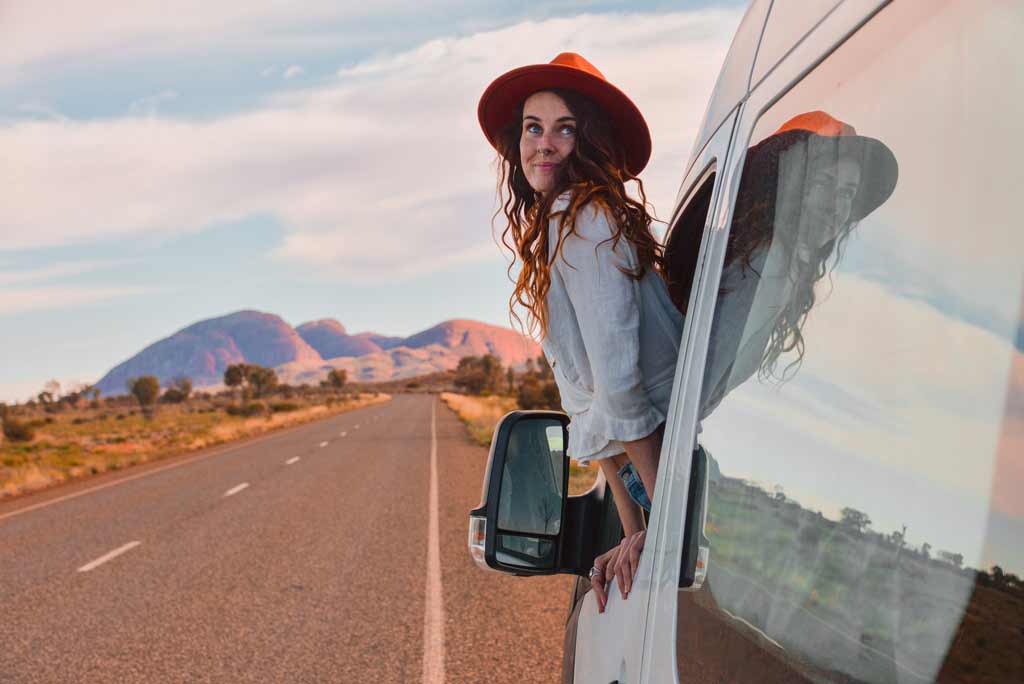
The top of the list of things to do in Uluru Kata Tjuta National Park is to watch the sunrise light up the rock with those iconic red centre colours.
Be sure to make an early start into the park, and allow at least 30-40 min for the drive in and to settle in to watch this magical moment.
Make your way to the sunrise carpark where you can either head to the viewing area or if you want to avoid the crowds, consider bringing a chair and your early morning brew!
Safe to say, there is nothing quite like sipping on your morning coffee while you sit back and enjoy the sun light up this beautiful heart of the Uluru Kata Tjuta National Park.
The rock is in full glow just before the sun peaks over the horizon, so this is the moment to capture a photo of those beautiful reds, but be quick or you may just miss the experience!
If you’re here for a few days and want to experience something different, try viewing Uluru from the Kata Tjuta sunrise viewing area for an extra unique experience of Uluru Kata Tjuta National Park.
From this angle the rock of Uluru is in full shadow, but is reminiscent of the aboriginal flag when the sun peeps over the horizon: a whole different kind of magic.
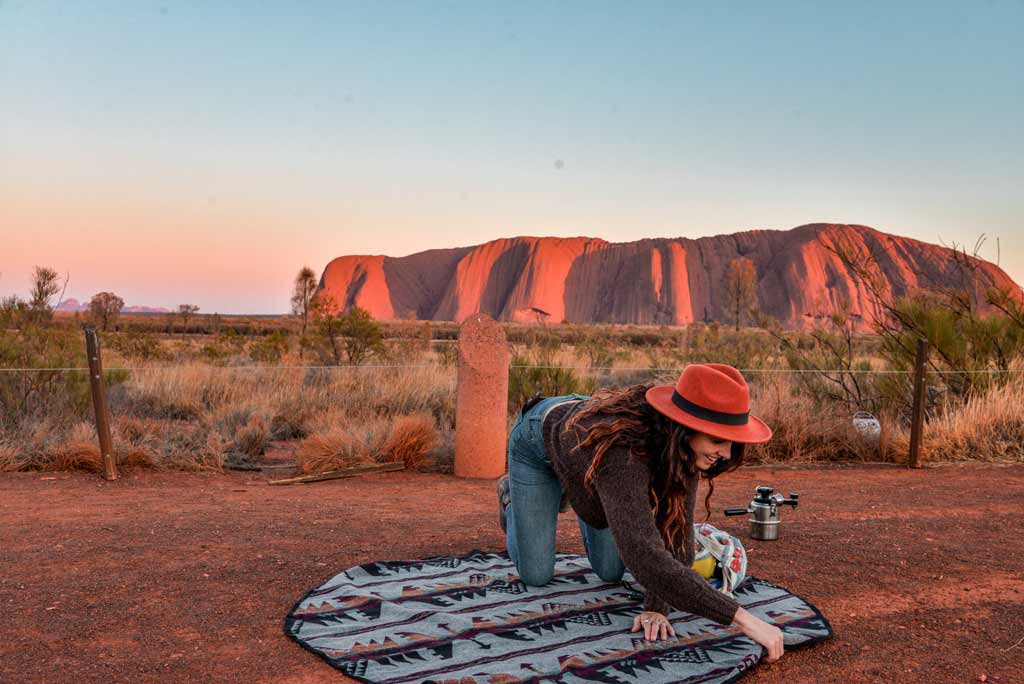
While the climb up Uluru has been discontinued, there is a 9.7km walking circuit that winds its way around the base of Uluru and is the perfect way to experience the cultural and natural beauty that this park has to offer.
Temperatures can rise up to 47 degrees celsius in the summer months, so if you’re planning to walk the circuit, starting early in the morning right after sunrise is recommended.
Park in the Mala carpark and make sure to bring lots of water and be sun safe as you go exploring!
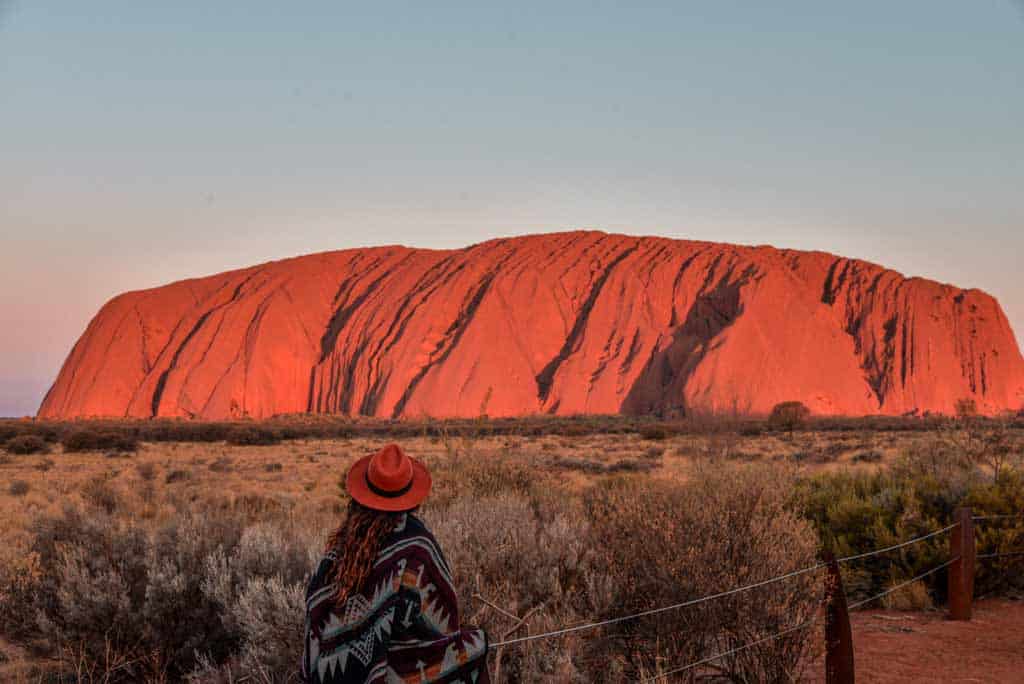
If walking isn’t your style or within your ability, this walking track is also shared by segway tours and bikes alike!
You can hire a bike from Outback Cycling located just outside the cultural centre and make your own way around the rock assisted by two wheels.
Alternatively, if you’re looking to try something a little different, then you may want to look into booking a Segway tour !
Visitors can join a segway tour of Uluru Kata Tjuta National Park with a guide from $159 AUD.
Named after the almost extinct Rufous hare wallaby of this region, this shorter walk is absolutely one of the best things to do in Uluru for all abilities.
Winding through culturally significant women’s sites, rock art and ending at Kantju Gorge, it offers so much in such a short distance (2km return).
If you’re interested in learning more about the parks geology and culture, then be sure to take advantage of the free tour run by the rangers through this area.
Resident rangers will give a brief introduction of the area, the national park landmarks, share some of the creation stories and answer any additional questions you have.
Allow up to 1 hour 30 minutes for this ranger led tour though Uluru Kata Tjuta National Park.
READ MORE: Check out our guide on the best things to do in Darwin !
If you’re unsure of things to do in Uluru for your best outback getaway, the Cultural Centre is a great place to begin your journey into Uluru history, Uluru activities, Uluru attractions, local artwork, artifacts and much more.
Here you can find videos explaining the creation stories mentioned throughout the park, as well as an introduction to Anangu culture.
This is also a great place to grab a map of the park to help with navigating the landscape!
The cultural centre also has two Aboriginal-owned art galleries showcasing Anangu art and craft: everything from paintings to woodwork.
Head to the galleries to enjoy the art, watch demonstrations from local Anangu people, or maybe even choose a piece to take home to support the local communities and artists.
If the Cultural Centre has you hooked and you’re a lover of aboriginal art and painting, be sure to check out Maruku Arts dot painting workshop at Ayers Rock Resort.
This workshop offers a fun introduction into western indigenous art and is a great way to learn from local artists about their art and the different symbols they use to share different Dreamtime stories.
READ MORE: We’ve published the most epic guide on the best things to do in Australia, other than Uluru. Check it out .
Kata Tjuta, meaning “many heads”, consists of 36 giant domes spread out over 20 kilometres.
These rock formations, while often lesser-known attractions for visitors and travellers alike, actually sit 200 metres taller than Uluru and held in equal cultural significance to the Anangu people.
There are two walks that you can take to explore these beautiful formations: The Valley of the Winds and Walpa Gorge.
The Valley of the Winds walk is a longer walk that allows travellers to walk in amongst the domes and see these formations up close.
This walk is challenging in parts, so allow up to 4 hours to complete the circuit.
This is also one of the areas in the national park that holds cultural significance to the local people.
Out of respect, they ask that it is not photographed to preserve the spiritual traditions of these areas, so be aware of where you take a photo.
Walpa Gorge is a much shorter walk, but with its towering cathedral-like walls acting as a desert refuge, it is rich with local flora and fauna to explore.
If you’re lucky you may even spot a wallaroo!
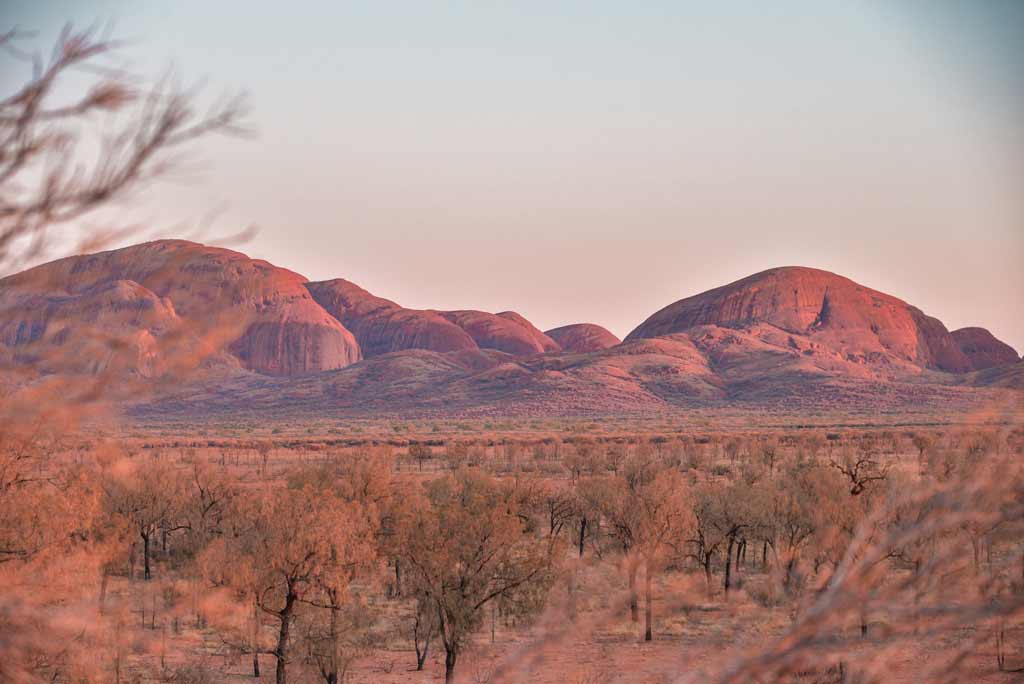
This art installation , aptly named Tili Wiru Tjuta Nyakutjaku or ‘looking at lots of beautiful lights’ in local Anangu language, was created in 2016 by internationally renowned artist Bruce Munro.
Due to popular demand, this installation of 50,000 spheres of light has been extended indefinitely.
Spend a few hours wandering and experiencing the magnificent installation of colours of the desert, or join an exclusive sunrise walking tour to have the entire place to yourself.
Wind your way through the maze of colorful, beautiful lights as they spread out and intertwine across the desert floor.
Dining under the stars by far has to be one of the best things to in Uluru with a few different options to choose from!
Tali wiru , meaning ‘beautiful dune’ in local Anangu language, is one of these unforgettable outdoor dining experiences.
This open-air fine dining bush food experience features a bush tucker inspired menu that incorporates native bush ingredients integrated into a 4 course dinner served with premium Australian wine.
As you make your way through this 4 course menu, you will also have the chance to learn from a local indigenous storyteller sharing their culture, history and stories about the local people and places.
Alternatively you can enjoy a similar dune top experience with the more moderately priced Sounds of Silence three-course bush tucker inspired buffet.
While taking in the stunning views of the iconic rock, sit back and enjoy a didgeridoo performance and learn from a local guide as they give a tour of the wonders of the desert night sky and paint a map of the stars and constellations.
Kings Canyon is located 324km north of Uluru in Watarrka National Park and features a rim walk showcasing the iconic Australian outback landscape of the Northern Territory.
This 6km circuit walk offers spectacular views of the gorge, weaves through marvellous sandstone rock domes known as the ‘lost city’ and dips briefly into a picturesque oasis aptly named the Garden of Eden.
The start of Kings Canyon is by far the most challenging part with 500 steep steps. But the rim walk mellows out as you make your way around the Kings Canyon Rim and is well worth the views!
Allow up to 3-4 hours to return and, as for all walks in outback Australia, midday temperatures can sky rocket, so be sure to get an early start and pack plenty of water!
If you prefer to go on a day trip to this area of Watarrka National Park, then you can book the highest rated one in the area right here .
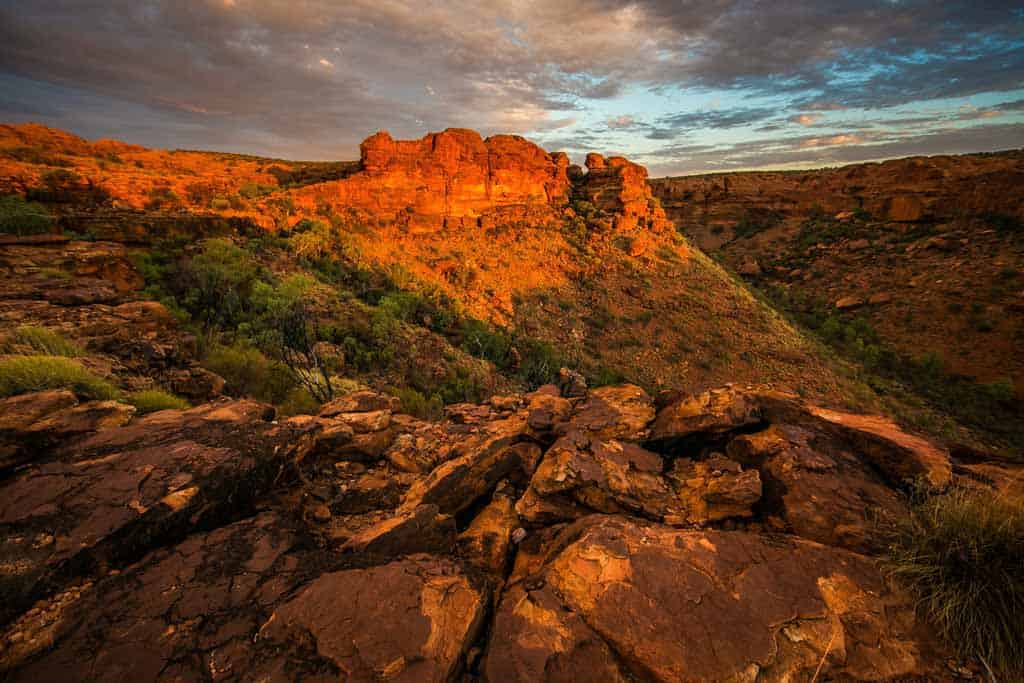
Uluru Travel Guide
Now that you know what to do in Uluru, let’s explore the best places to stay and eat to help you make your plans when you visit.
Best Accommodation – Where to Stay in Uluru
While there is nowhere to stay in Uluru National Park itself, there is a good variety of places in the local township Yalara. Also note that there aren’t really any budget options out here because it’s so remote. You can camp, or stay at one of these nice accommodations in Uluru.
This is a great accommodation option for singles and couples alike. The Desert Gardens Hotel has rustic furnishing and is surrounded by beautiful landscaped gardens.
Sit back and cool off in the pool or just enjoy a drink at the bar after a long day exploring Uluru.
The cream of the crop for accommodation in Uluru is without a doubt Ayers Rock Resort .
If you’re looking for a desert retreat then be sure to check out this hotel for your Uluru Adventure. They offer free transport to and from Ayers Rock Airport and an on-site restaurant with amazing food.
They also offer packed lunches and have cozy rooms with air conditioning.
Best Restaurants in Uluru
While the selection of restaurants and food outlets is small in this region, there is still a diverse range for all budget requirements!
Kulata Academy Cafe is a perfect spot to grab a quick bite to eat in town before heading off on a tour, or a snack once you’re back! Choose from their range of toasties, muffins, and other sweet treats as well as their hot drinks menu.
Ilkari Restaurant offers a diverse menu of contemporary Australian cuisine for breakfast lunch and dinner. Meals range from $20-60 AUD and is a great place for those with dietary preferences and needs to go for a sit down hearty meal in the heart of Yalara township.
As mentioned above, Tali Wiru is an absolute must when it comes to fine dining in Uluru. Offering a bush tucker inspired menu, with a backdrop of Uluru, it’s not going to disappoint!
Claire Taylor
Hi, We’re Alesha and Jarryd!

We’ve been traveling the world together since 2008, searching for the planet’s best destinations and adventures.
Love Travel?
Sign up for our free weekly newsletter for the best travel tips, ideas and deals!
We respect your privacy. Unsubscribe at any time.
READ MORE...
Jacis Lodges Review – A Luxury Safari in Madikwe, South Africa
Cape Kudu Hotel Review – Best Place to Stay on Koh Yao Noi
The Ultimate 3 Days in New York City Itinerary (2024 Guide)
Related Posts
A bulgarian mountain escape at kosovo houses, i shat myself in a tibetan monastery, the power of travelling outside your comfort zone, overlanding argentina – buenos aires to ushuaia by bus, 1 thought on “the 10 best things to do in uluru [2024 guide]”.
Thanks for this guide to visiting Uluru. We hope to include Uluru in our upcoming trip up the centre of Australia. Can’t wait to see the colours.
Leave a comment Cancel reply
Save my name, email, and website in this browser for the next time I comment.
The only Alice to Uluru itinerary you’ll ever need
Jennifer Ennion
Travel Journalist
30 October 2023

From the heart of the Red Centre to an Australian icon, Alice Springs to Uluru makes an epic road trip. Here’s everything you’ll ever need to know about doing it.
Alice springs.
Red earth, sunshine and quirky characters make Alice Springs a great place to launch an outback road trip.
Sitting at the epicentre of the Explorers Way (a 3000-kilometre route from Adelaide to Darwin, if you are driving north from Alice check out out ultimate Alice to Darwin itinerary ), Alice Springs – simply ‘Alice’ to locals – is a popular base for visitors looking to explore the Northern Territory’s outback.
Classic Aussie pubs mix with hip cafes; air-conditioned coaches on their way to the Royal Flying Doctor Service and the Alice Springs School of the Air share the road with cyclists on a tour into the MacDonnell Ranges.
Bird shows at Alice Springs Desert Park and venomous snakes at Alice Springs Reptile Centre wow animal lovers, while history buffs can whittle away hours checking out historic sites such as the National Pioneer Women’s Hall of Fame or the Alice Springs Telegraph Station, where Europeans first settled in town. Throw in sunset atop ANZAC Hill and you’ll be itching to see more of the Red Centre .
Not to miss
Watch competitors race in weird and wonderful floats in the famous Henley-on-Todd Regatta – the world’s only waterless regatta – on the dry Todd River every August.
The town also hosts the annual Alice Springs Camel Cup , a decades-old (and pretty eccentric) tradition perfect for a fun family day out.
Hiring a vehicle
If you’re planning on flying into Alice Springs and hiring a vehicle, Apollo Motorhome Holidays, Britz, Thrifty and Hertz all have branches here.
MacDonnell Ranges
You can easily get from Alice to Uluru in 5.5 hours along the sealed Stuart and Lasseter highways, but where’s the fun in that? Instead, head into the MacDonnell Ranges for an outback adventure bound to leave a lasting impression. The ranges are split in two – the West Macs and the East Macs – and both are impressive.
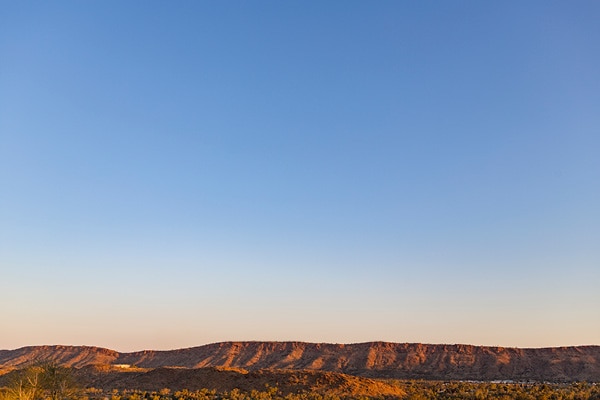
The MacDonnell Ranges are an outback adventure bound to leave a lasting impression.
The West Macs
The better known of the two, the West Macs stretch 200 kilometres and are etched with gorges, chasms and dry creek beds. They can be reached by following the Red Centre Way (an 1135-kilometre loop from Alice).
Places not to miss include the Standley Chasm, a dramatic, 80-metre-high rock face; the refreshing pools at Ellery Creek Big Hole and Ormiston Gorge ; and Simpsons Gap, an important spiritual site with several Indigenous dreaming trails.
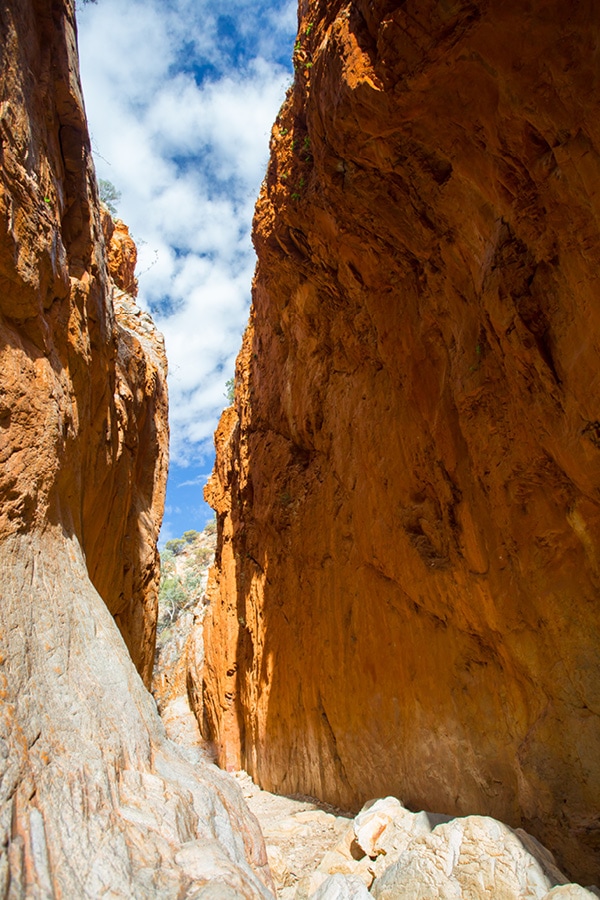
Places not to miss include the Standley Chasm.
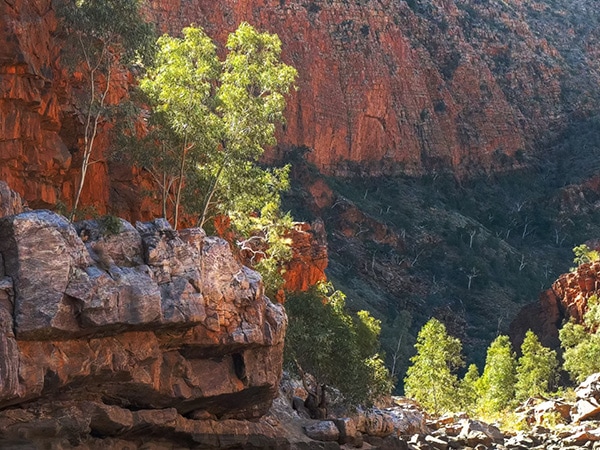
The towering red walls of Ormiston Gorge.
If you’re camping, unfurl a swag and enjoy a campfire at Redbank Gorge . Alternatively, Glen Helen Lodge offers basic accommodation close to Glen Helen Gorge and 1380-metre-high Mt Sonder.
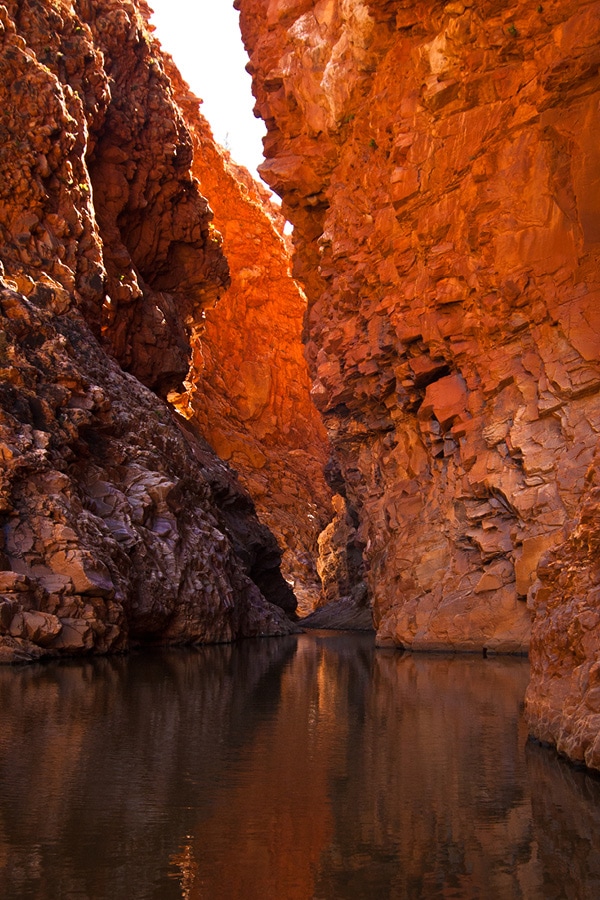
Unfurl a swag and enjoy a campfire at Redbank Gorge.
How to get there
At around 220 kilometres long, the Larapinta Trail is one of Australia’s legendary hiking routes. Starting in Alice Springs and ending at Mt Sonder, it follows the West Macs and is not for the faint-hearted.
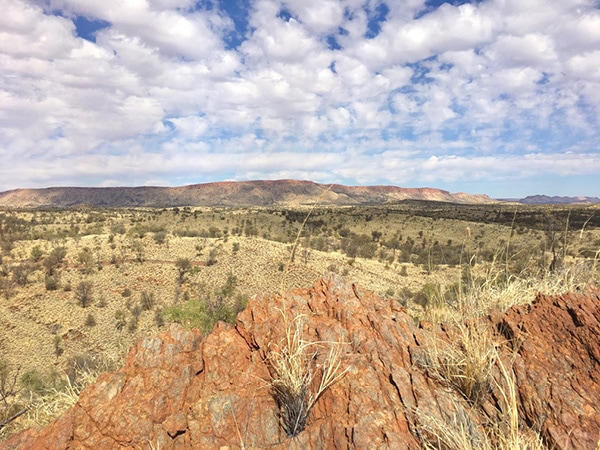
First stop on the Larapinta Trail: Euro Ridge.
Hikers need to fill up water bottles at tanks along the way and organise food drops. The Larapinta is broken into 12 sections and the best time to set off is during winter (June–August).
Go it alone or join a tour like those provided by Australian Walking Holidays, which offer semi-permanent campsites, including Sonder Camp.
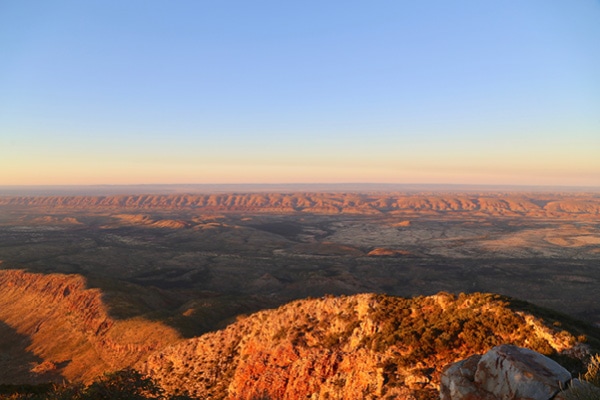
The view from Mt Sonder.
Don’t miss
Alice Springs Helicopters offer scenic flights over the MacDonnell Ranges and thrilling mountain bike tours that drop you at sections along the mountain biking trails in the West Macs area.
The East Macs
Less touristed, but arguably as stunning, the East Macs offer travellers insight into the Indigenous and gold rush history of the area.
Located 150 kilometres east of Alice Springs, bushwalking, camping and four-wheel driving is to be expected here. Tag along with a local or tour guide (we recommend Outback Elite Tours) for the ultimate adventure.
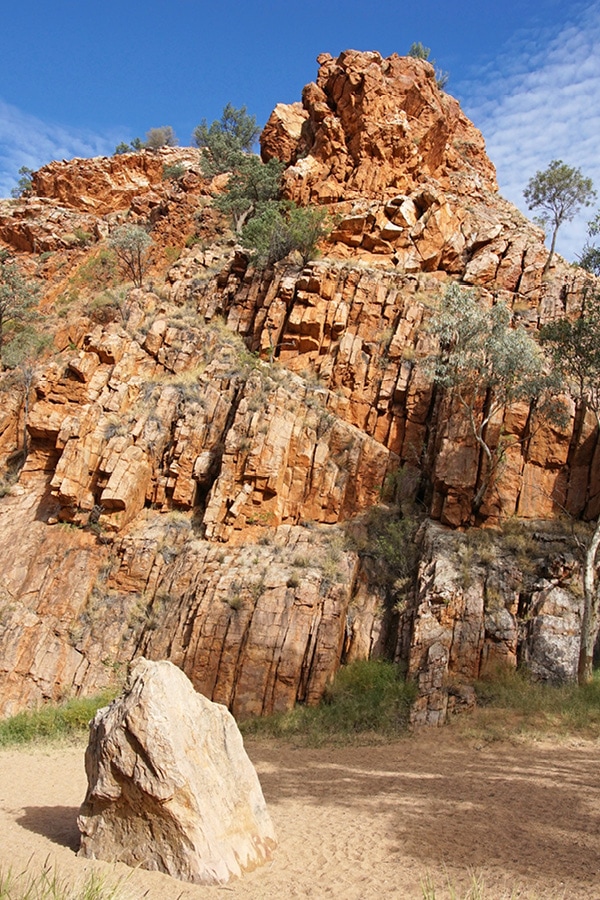
Less touristed than the West Macs, but arguably as stunning.
A main attraction is Trephina Gorge Nature Park, where you’ll be surrounded by rising walls of red and purple quartzite. The gorge is also home to what’s said to be the largest ghost gum in Australia (at 33 metres high and about 300 years old) and forms part of the Wallaby Dreaming Trail, significant to the Eastern Arrernte Aboriginal people.
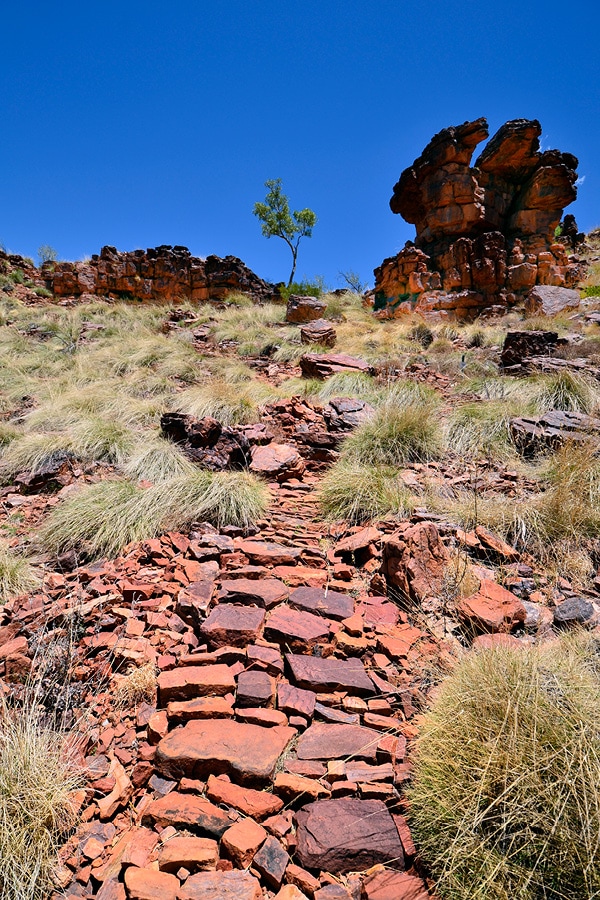
A main attraction of the East Macs is Trephina Gorge Nature Park.
While you’re here, visit N’Dhala Gorge Nature Park, home to 6000 rock carvings, as well as the old gold rush town of Arltunga , which dates back to the late 1800s, and Hale River Homestead, where you can grab a burger (booking ahead is recommended for meals).
Hermannsburg and Finke Gorge
Thought to be 350 million years old, The Finke River winds through Finke Gorge National Park , an important wilderness reserve between Alice Springs and Kings Canyon. Within the park’s confines is the ancient Palm Valley, where rare red cabbage palms, also dating back millennia, grow.
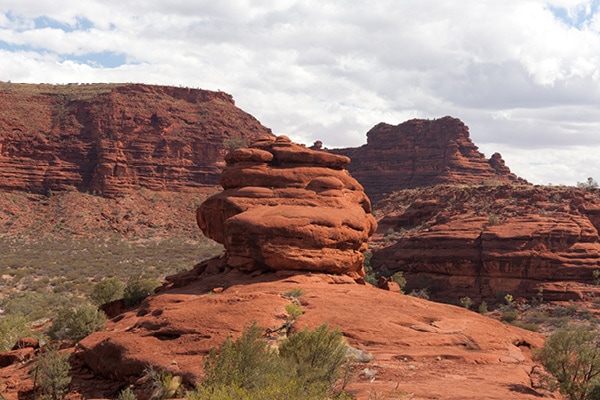
Palm valley in the Finke Gorge National Park.
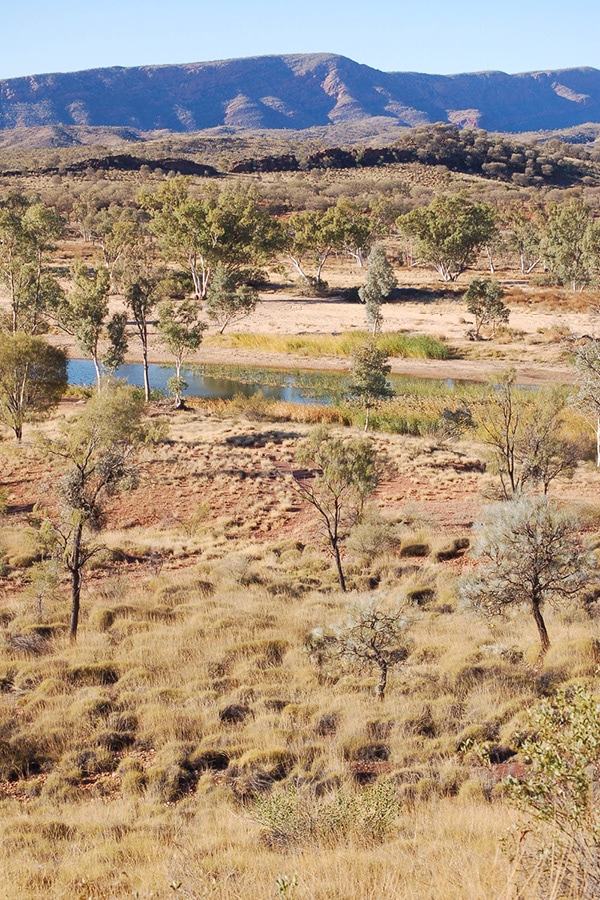
Palm Valley: home to the ancient Red Cabbage Palm.
To get into the park, you’ll need a high-clearance 4WD and be comfortable conquering rocky tracks. You will also want sturdy hiking boots as there are a tonne of trails.
Call into Hermannsburg prior to entering the park: it’s a historic precinct where a Lutheran Mission was active in the late 1880s and where renowned Aboriginal artist Albert Namatjira resided.
Kings Canyon and Watarrka National Park
After exploring the West Macdonnell Ranges head off-road along the Mereenie Loop as you make your way to Kings Canyon (you’ll need a 4WD and a permit). The canyon, plunging 270 metres, is the highlight of the park and an oasis of palms and ferns.
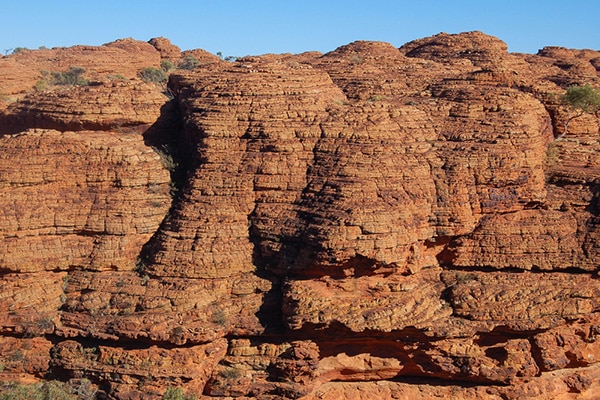
The canyon, plunging 270 metres, is the highlight of the park.
Rise early and set off on the six-kilometre Canyon Rim Walk , which will lead you to the sandstone domes of the Lost City and a sacred watering hole aptly named the Garden of Eden. There is also the much gentler 2.6-kilometre Kings Creek Hike to a lookout.
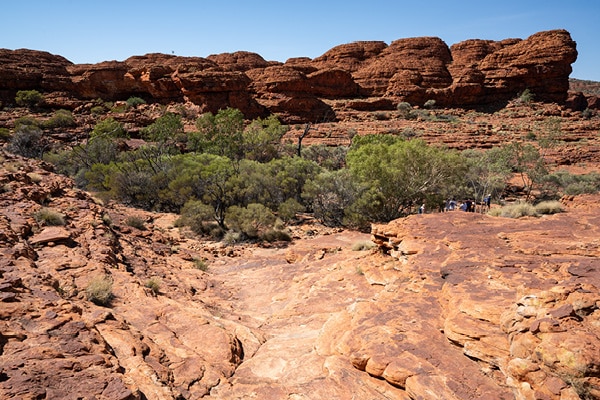
Take the Canyon Rim Walk to the sandstone domes of the Lost City.
Where to stay
Base yourself at Kings Creek Station, not far from Watarrka National Park . The 1800-square-kilometre property is open year-round and is a top spot to experience life on the land with both campsites and basic cabins available. Make time to enjoy traditional damper with a cup of billy tea.
Nothing says ‘outback’ more than the big red rock in the middle of the country, and a road trip here is the best way to appreciate its isolation and imposing beauty as it rises 348 metres from the desert.
In spite of its remoteness, there is plenty to do at UNESCO World Heritage-listed Uluru . First up, you’ll want to explore on foot, so rise early and join a guided tour around a portion of Uluru’s 10-kilometre base. The daily Mala Walk (two kilometres) is a good option if you want to learn about Uluru’s cultural significance and Indigenous rock art.
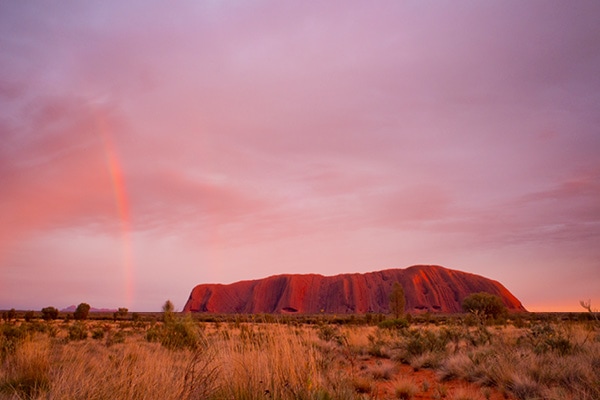
A outback road trip wouldn’t be the same without visiting Uluru.
While you’re there, sign up for a plod atop a camel for what Uluru Camel Tours director Mark Swindells describes as being “like a magic carpet ride”.
For something different, hop aboard a Segway, enjoy a Harley Davidson ride or plummet toward Uluru on a thrilling sky dive . If you want tips on how to extract as much of the magic of this place in a short period of time, we’ve written a 3-day Uluru itinerary based on our own trip here.
Set your alarm so you can watch Uluru change colour at sunrise. Drive to one of the viewing platforms, or join the Desert Awakenings Tour.
Another highlight is artist Bruce Munro’s Field of Light where a carpet of 50,000 lights will shine around Uluru until December 2020. Book through Ayers Rock Resort.
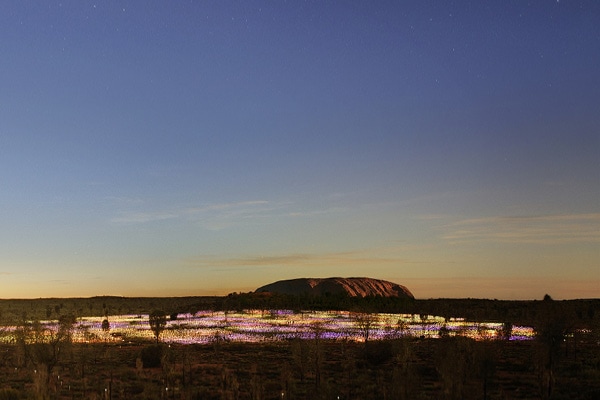
Field of Light; one of the largest art installations in Australia’s history.
For a special outback dining experience, you can’t go past Sounds of Silence . Savour native Australian ingredients, such as kangaroo, finger lime and lemon myrtle, while the Milky Way dazzles from above.
Accommodation in Uluru comes in all shapes and sizes, from luxury suites, to tent-style pavilions and campsites. It also runs numerous tours and workshops, some of which are free. Squeeze it all in by jumping on the resort’s complimentary shuttle, especially if you’re travelling with children or the elderly.
Need to know
Although Uluru is open to visitors year-round, in summer temperatures frequently sit at 45°C and flies are at their most persistent. Instead, visit between May and October, when daytime temperatures are comfortable.
If a one-way road trip from Alice to Uluru is enough for you, fly out of Ayers Rock Airport to many of Australia’s major cities.
If you can squeeze it in, don’t miss the 36 large rock domes of Kata Tjuta – more commonly known as The Olgas. Located about half an hour’s drive from Uluru, they’re easy to reach on a day trip.
The domes are dramatic, with the tallest one, Mt Olga, soaring 546 metres high. Explore them on foot by following the challenging Valley of the Winds trail (7.4 kilometres). It will take you about three hours, so set off early to avoid the midday heat. There is also the easier Walpa Gorge (2.6-kilometre) walk.
Go with a tour company
If the idea of hiring a car and driving into the outback makes you nervous, but you don’t want to miss out on this special part of Australia, there are plenty of tour companies willing to do the hard yards for you.
AAT Kings coach tours are comprehensive and reliable, as are those offered by G Adventures. Seit Outback Australia specialises in small-group tours.
For more information on things to do in the NT, visit the official Northern Territory website at northernterritory.com
Jennifer Ennion is a freelance travel and ski journalist who loves encouraging people to spend more time outdoors. From snorkelling with belugas in sub-Arctic Canada to hiking the Himalayas, Jennifer is constantly searching for stories that inspire readers to push their boundaries.

LEAVE YOUR COMMENT
Cancel reply.
Save my name, email, and website in this browser for the next time I comment.
You might also like
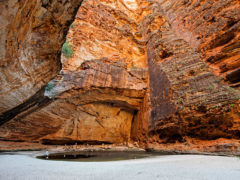
8 tips for travelling (& surviving) the outback as a family
With its unparalleled beauty and endless reaches, the Aussie outback holds its own. And, while the bush certainly brings its own charm – it also bri...
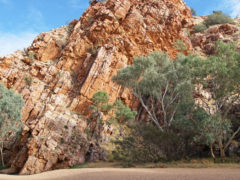
Everything to know about the East MacDonnell Ranges
Before heading off on the iconic Larapinta Trail through Central Australia’s West MacDonnell Ranges, we pivot 180 degrees to venture where mostly on...
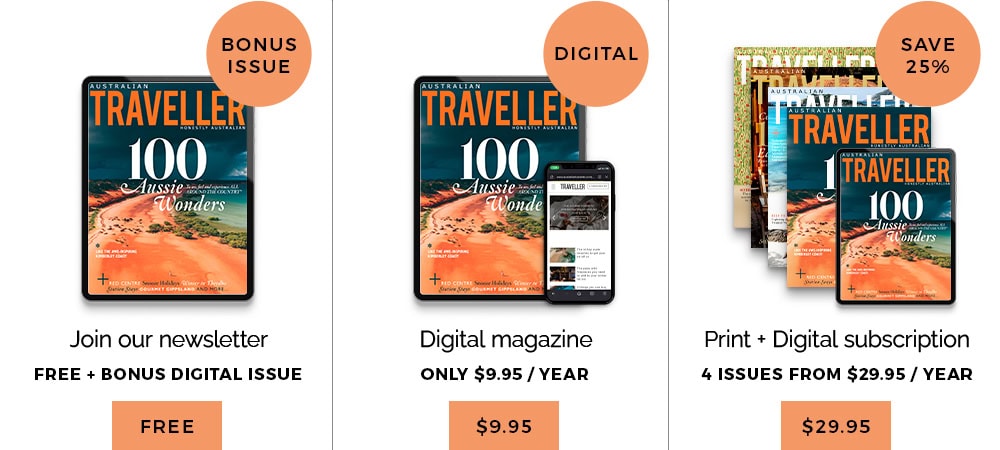
© Australian Traveller Media 2024. All rights reserved.

Alice Springs – Uluru Itinerary & Map (Australia’s Red Center Road Trip)
By Author Jurga
Posted on Last updated: November 11, 2023
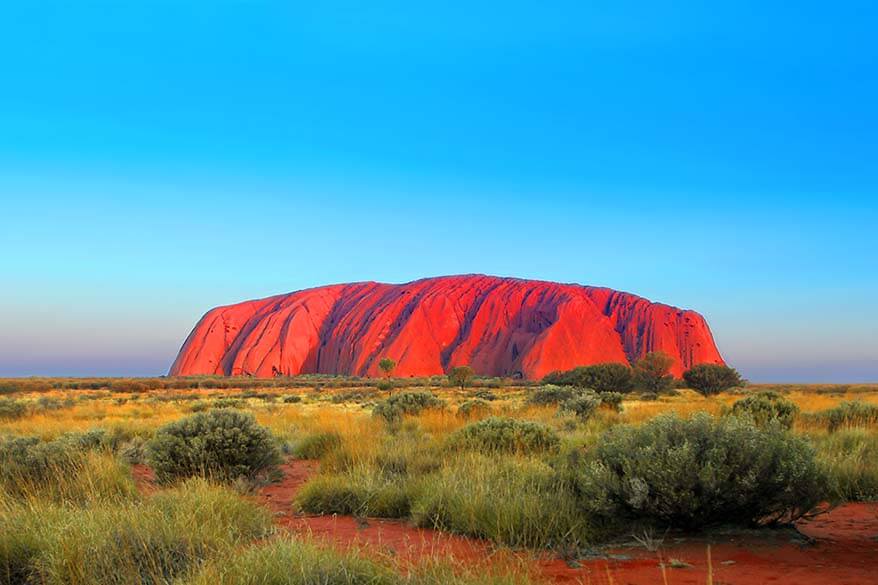
Are you thinking of visiting the Red Center of Australia and are not sure where to start? This article features a simple itinerary from Alice Springs to Uluru and back and the most beautiful places to see along the way. Find out!
Planning a family trip to outback Australia was not an easy task. We wanted to see a lot but had to take into account that we were traveling with the three young children. Nevertheless, we prepared our Alice Springs Uluru itinerary in such a way that it would bring us to all the nicest places in the region .
Despite the young age of our children and the extreme November temperatures of over 40°C (100°F), we saw all the highlights of the Red Center. In fact, we did more than expected. In this article, you can find our 6-day Australia Red Center road trip itinerary: from Alice Springs to Uluru and all the best places in between . I also included a map to make it easier to plan your trip.
If you want to see all the best places between Alice Springs and Uluru, then look no further – this road trip itinerary brings you to all the nicest places in Central Australia. If you are on a tight budget, scroll all the way to the bottom for some suggestions for a budget trip to Uluru. Find out!
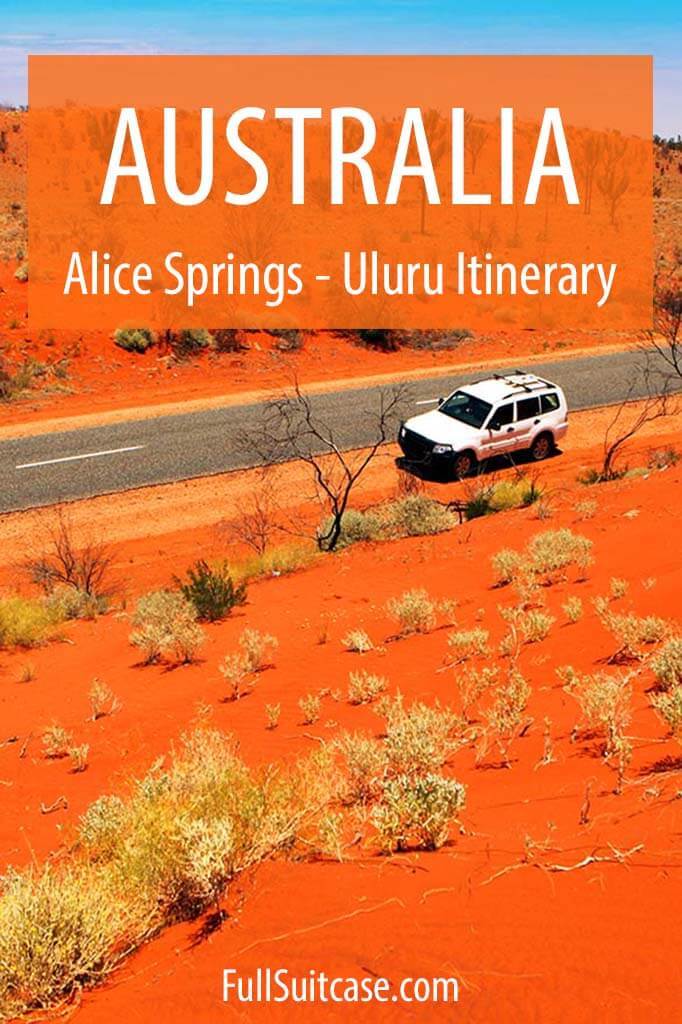
Australia Red Centre itinerary – OVERVIEW
Day 1: alice springs.
- Day 2: Alice Springs – MacDonnel Ranges – Glen Helen
Day 3: Glen Helen – Kings Canyon
- DAy 4: Kings Canyon – Uluru – Kata Tjuta National Park
Day 5: Uluru – Kata Tjuta National Park
- Day 6: Uluru and back to Alice Springs
Australia’s Red Centre on a Budget
Map of alice springs – uluru itinerary.
To make your travel planning easier, I created this map showing all of the places mentioned in this post, as well as our driving route.
Below, you can find all the details of this trip. Read on!
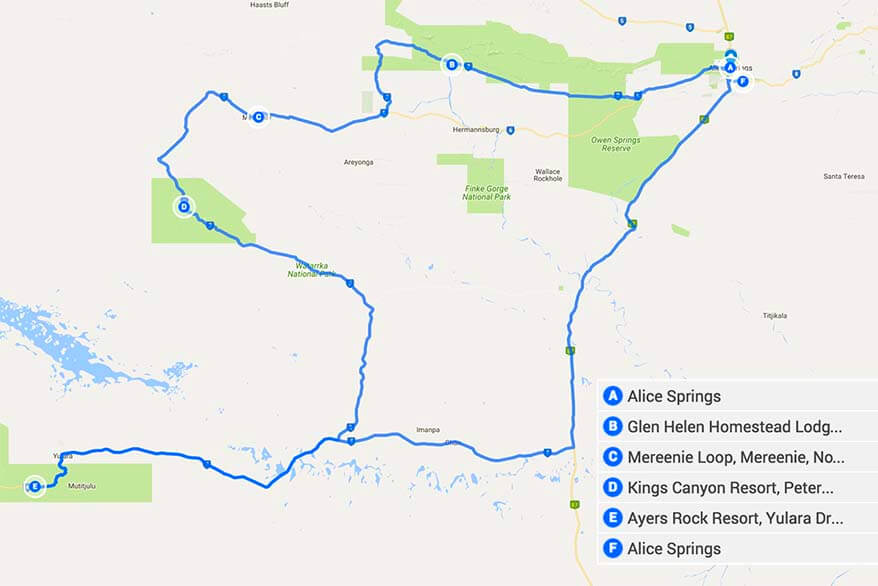
Here’s our recommended Alice Springs – Uluru itinerary:
We left Sydney in the morning and after a very scenic flight of less than three hours, we landed in a whole other world – Alice Springs.
It was 2,5 hours earlier in Alice Springs (and we were still dealing with jet lag coming from Europe) and at least 10°C warmer than in Sydney. We quickly threw away the last apples and bananas from our hand luggage in the quarantine bins (for more info check our practical tips for traveling to Australia ) and headed to the car rental stands.
We rented a 4×4 vehicle and the one they gave us was full of scratches and had a dented roof. This didn’t look promising! They explained to us that it was not the best idea to enjoy the sunset at Ayers Rock from the roof of your car as the previous renters did, and we were set to go.
In principle, you don’t need a 4WD vehicle in Australia’s Red Centre , since most of the main roads are paved. So if you are driving to Uluru (Ayers Rock) only, you can do it with any regular car as well. We rented a 4WD because we were planning to drive the gravel Mereenie Loop Road – read further for more info.
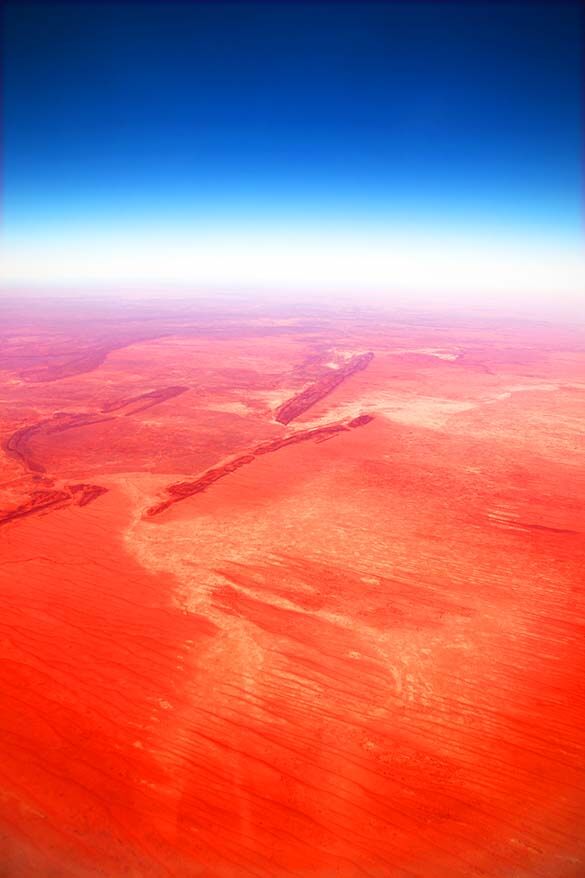
Now back to Alice Springs…
We checked in at our hotel and then headed to the town center which was completely deserted! No wonder, with temperatures around 36°C… And it was only spring – we visited the Red Center in early November.
After a while, we found an air-conditioned shopping mall. It looked like the whole town was there, escaping the heat, just like us… We stocked up on water and food supplies for the next couple of days (there are not many shops in the outback, so it’s really a must!). Since there was not much exciting to do downtown, we headed back to our hotel where we spent the rest of the afternoon by the pool.
I still don’t understand how it’s possible, but all the swimming pools in Australia’s Red Centre were freezing cold! The kids went swimming anyway, but we found it too cold and stayed on the side. 32°C in the shadow and the water too cold to swim – you have to experience it to believe it!
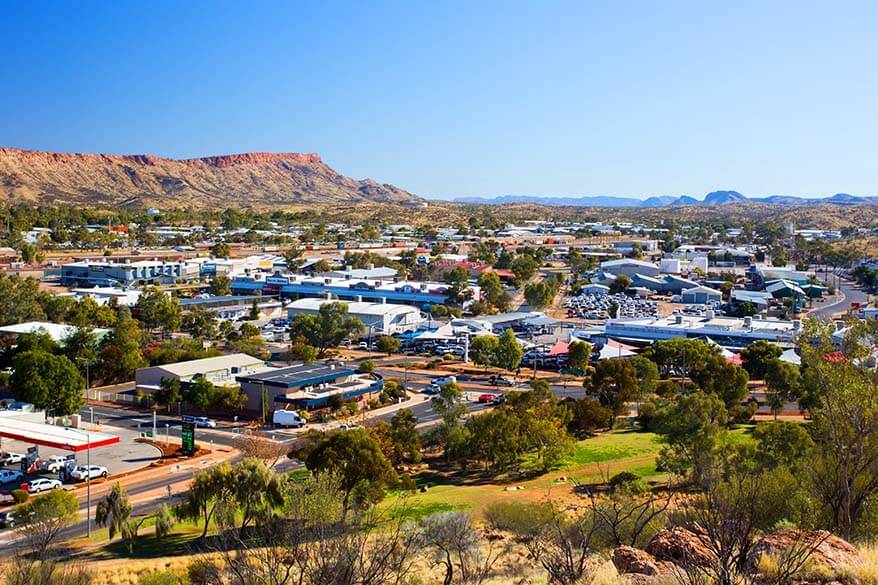
What to See and Do in Alice Springs
While the town itself isn’t that impressive, there are quite some activities you can do in Alice Springs. The nicest things to do are nature and wildlife – outside of town.
Here are a few suggestions for things to do in Alice Springs:
- Alice Springs Reptile Centre
- Alice Springs Desert Park
- The Kangaroo Sanctuary
- The Royal Flying Doctor Service
- You can also opt for this popular Alice Springs Highlights Tour and see the best of Alice Springs in half a day.
- A popular thing to do in Alice Springs is a hot air balloon tour .
- Rainbow Valley Conservation Reserve is well worth visiting, especially at sunset. But you do need a 4X4 for driving in the outback.
- West MacDonnell Ranges is another popular day tour from Alice Springs . We visited it as a part of our road trip – see day 2 itinerary further below, but if you want to stay in Alice Springs, you can easily do this with a tour.
- One of the best organized day tours from Alice Springs is a 4×4 tour to the Palm Valley . It’s a place that’s not very easy to visit on your own, so if you want to see it, consider a tour.
TIP: Depending on how much you want to see and do in and around Alice Springs, you might want to add an extra day to your itinerary.
Where to Stay in Alice Springs
There are many accommodation options in Alice Springs . We stayed in Alice on Todd self-catering apartments and it was ideal for a family.
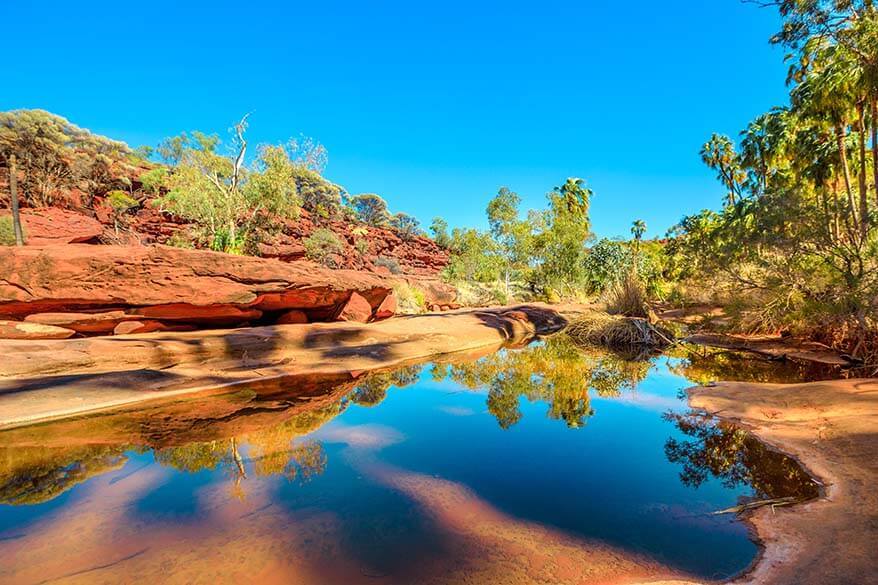
Day 2: Alice Springs – West MacDonnell Ranges – Glen Helen
While you could simply drive from Alice Springs to Uluru, we highly recommend that you include West MacDonnell Ranges (and also Kings Canyon – more info below) in your Uluru itinerary! It will make your trip so much more special!
The drive from Alice Springs to Glen Helen is only 130km and the road is paved. However, there is a lot to see and do in the area, so we took an early start before it got too hot to do anything.
Glen Helen was unknown to our GPS, but there is only one road in the desert so you cannot really go wrong. We followed Larapinta Drive and then Namatjira Drive towards Glen Helen and visited West MacDonnell Ranges along the way.
West MacDonnell Ranges
The West MacDonnell Ranges are simply stunning! There are hiking trails, beautiful gorges, and waterholes where you can swim…
We visited Simpsons Gap, Standley Chasm, Ormiston Gorge, Glen Helen Gorge on the first day, and the Redbank Gorge on the second day, on our way to Kings Canyon. Don’t miss this incredible place if traveling to Australia’s Red Centre!
LEARN MORE: West MacDonnell Ranges

Accommodation. We stayed at Glen Helen Homestead Lodge for one night. It’s a very basic accommodation, but there is really no other option here unless you return to Alice Springs.
I have to add that the food was very good and the location near the Glen Helen Gorge – simply spectacular. If we were to go back to Australia’s Northern Territory, I would book at least two nights at Glen Helen and take an extra day to explore the beautiful gorges of West MacDonnell Ranges.
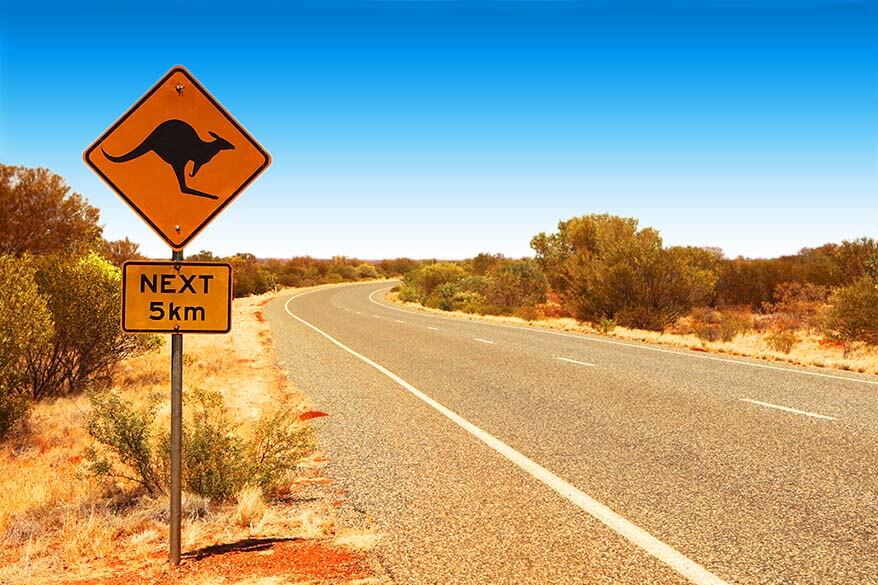
There are two ways to reach Kings Canyon – Watarrka National Park.
One is on the sealed road from Alice Springs, Stuart Hwy, Lasseter and Luritja Road. This would take you 6 hours from Alice Springs and about 8 hours from Glen Helen.
The shorter road – the Mereenie Loop Road – is a gravel road through the real outback of Australia. We took this road. See below!
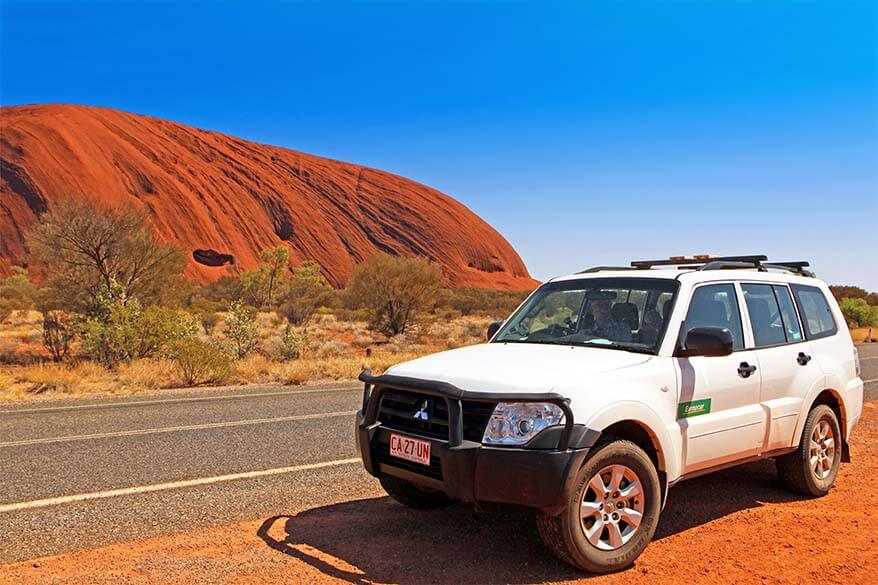
Mereenie Loop Road
We took the Mereenie Loop Road and it took us about 3hrs to get to Kings Canyon from Glen Helen. Three rather stressful hours, I have to say. You’re literally in the middle of nowhere: no houses, no shadow, only a handful of other cars and a desert as far as you can see.
Please note that the Mereenie Loop Road is recommended for 4×4 vehicles only. You really shouldn’t attempt this road in a standard vehicle. We passed one and they drove so slowly that I don’t think they got there by dark. In any case, you cannot do this road with a rented car if it’s not a 4×4.
You also need to buy a Mereenie loop permit in order to drive this road (you can get it in your hotel in Glen Helen).
The biggest part of the Mereenie Loop Road is gravel and it was in a pretty bad state when we visited. We found that driving faster made the ride smoother (go figure), but at 80km/h you just have to hope you don’t have to stop quickly as that would be practically impossible.
The landscape was somewhat uninspiring along the road, but we got to see a wild camel crossing the road. Somehow I never realized that there were wild camels in Australia. How cool is that! We saw two other animals – a snake and a lizard. But no exotic lizards and no Red Kangaroo (remember Kangaroo Jack ?) that we so much hoped to see in the outback…
Fuel is available at Glen Helen and at Kings Canyon, so fill up before driving the Mereenie loop road. It’s also a good idea to have water and some snacks with you. Petrol prices were 30% higher at Glen Helen than in Alice Springs and about double of Sydney prices. That’s the price to pay for traveling in the outback.
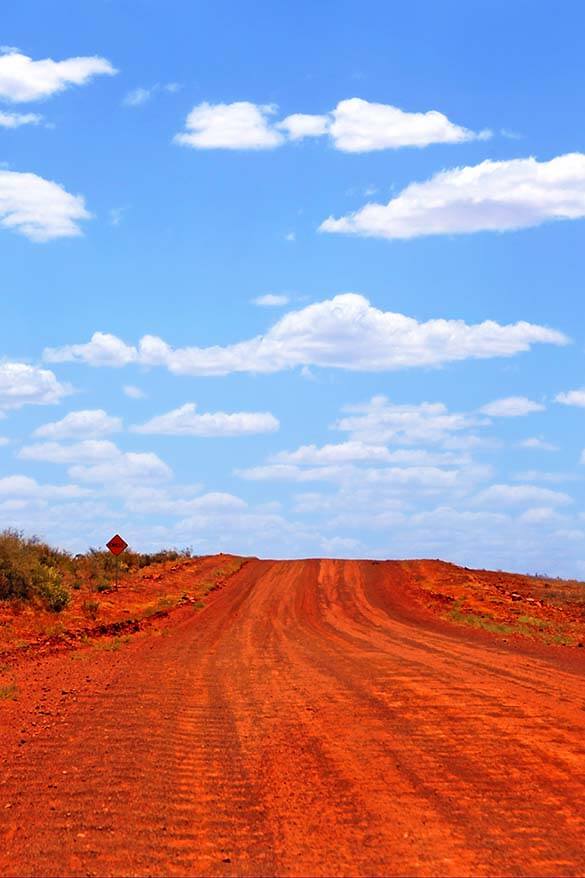
Palm Valley
One place we had heard about but didn’t visit was the Palm Valley in the Finke National Park. It’s home to the world’s oldest river, the Finke River and the Red Cabbage Palm, which is only found here.
You need a 4WD to access Palm Valley (which we had), but it’s also such a long drive that you’d either need to spend a night camping there or be prepared to drive for 10-12 hours through the Australian outback in one day. Again, it’s not something for a family with very young kids. But I read that some people visit Palm Valley on the way from Glen Helen to Kings Canyon and so apparently it is doable.
Another option would be to spend an extra night in Glen Helen and visit the Palm Valley as a day trip from there. As already mentioned, a good alternative stress-free way to visit Palm Valley is by booking this organized day tour from Alice Springs .
Kings Canyon Resort
Accommodation. Kings Canyon Resort where we stayed for the night was a luxury oasis in the desert! We had two big deluxe rooms with a terrace and a whirlpool with a view over the mountains… What a difference compared to the hotel at Glen Helen! The swimming pool was also cold, but it was bearable and we spent the rest of the afternoon at the pool.
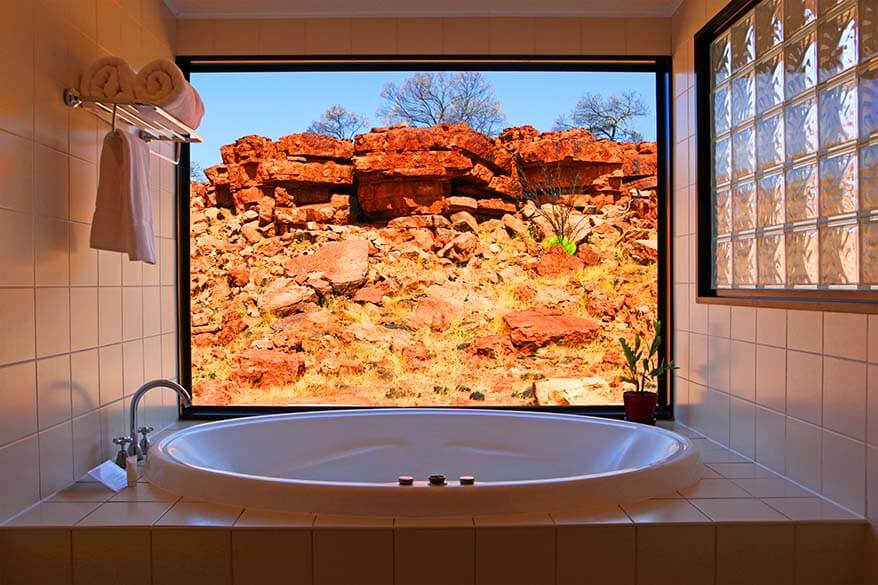
Day 4: Kings Canyon & Driving to Uluru – Kata Tjuta National Park
Kings canyon – watarrka national park.
The most beautiful walk at Kings Canyon is the Kings Canyon Rim Walk . It’s a 3-4 hour strenuous hike and you have to take a very early start if you intend to do it. It’s recommended to start at sunrise, at 6-7 AM and on a hot day they close the starting point of the walk by 9 AM.
With pain in our hearts, we decided not to do KingsCanyon Rim Walk with our kids. The 5-year-old could have probably done it without too many problems, but we just didn’t want to take the risk of taking three little kids up there on such a hot day. Temperatures reached 43°C by noon! We could have carried one or even two children if need be, but there is no way we could do this with three kids…
We chose to do the shorter walk at the bottom of the Kings Canyon instead – the Kings Creek Walk . It’s an easy yet spectacular walk between the red sheer walls of the canyon. Even the kids were impressed with the beauty around us. If you can, try to do both of these walks at Kings Canyon: the Rim Walk first thing in the morning and the Kings Creek Walk when you’re back down.
Afterwards we made a short walk at Kathleen Springs . This walk is easily accessible with a stroller, but not very spectacular. It’s ok if you are looking to fill your time here, but if you only do one walk, you better go for the Kings Canyon Rim Walk or Kings Creek Walk and skip Kathleen Springs altogether.
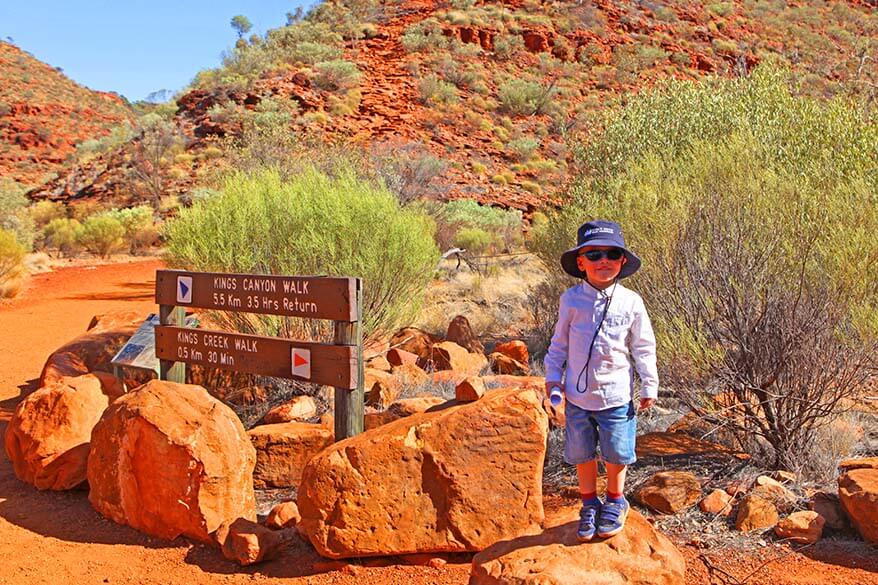
Kings Canyon to Ayers Rock Resort
In the afternoon we left the Kings Canyon and headed towards the Uluru – Kata Tjuta National Park.
The road from Kings Canyon to Uluru (Ayers Rock) is sealed. What a relief after yesterday!
On the way to Ayers Rock Resort, we stopped at Mt Conner outlook . The landscape is very impressive with bright orange/red sand all around you, Mt Connor in the distance, and an endless dried salt lake on the other side of the hill.
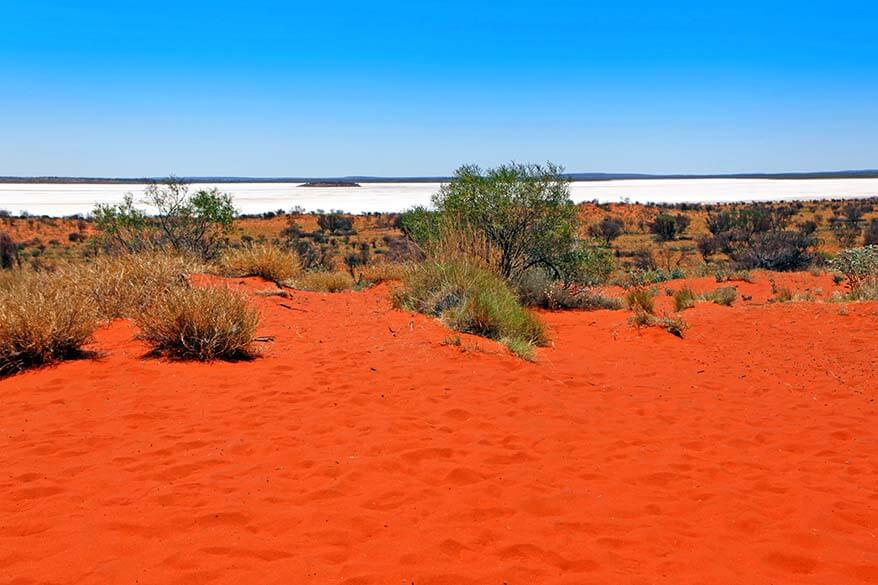
Yulara – Ayers Rock Resort
After a long drive through the beautiful red sand dunes landscape, we finally reached Yulara with Ayers Rock Resort.
Located only 15km from Uluru (Ayers Rock), the resort looks more like a little village with several hotels and other accommodation, a swimming pool, a petrol station, several shops, restaurants, and a small supermarket.
There are several accommodation options at the Ayers Rock Resort:
- We stayed at Emu Walk Apartments for 2 nights. This self-catering accommodation is ideal for families with children.
- The most luxury hotel at Ayer’s Rock is the 5* Sails in The Desert
- A bit cheaper 4* accommodation – Desert Gardens Hotel
- The best-priced hotel at Ayers Rock is probably the Outback Pioneer Hotel
- If all of the above are above your budget, the only other option is the Ayers Rock campground.
Sunset at Uluru – Ayers Rock
We decided to visit Uluru at sunset . There are just a few areas where you are allowed to park and watch the sunset, so we headed to one of them.
We found a huge car park that was full of cars and tourists. Some people were cooking dinner, some others were sitting on the roof of their cars (not a good idea, remember? :)) having a drink, somebody was singing… We counted almost 50 tripods and at least a hundred camping chairs. Unbelievable! It reminded me of those images you see on the news when thousands of people gather together expecting the end of the world… What a circus!
And as it often goes when expectations are this high, the reality disappoints. If you are looking for a romantic sunset experience at Uluru-Kata Tjuta, you may want to go somewhere else than the designated ‘sunset parking’.
The Olgas (Kata Tjuta) looked much nicer from afar, so that might be a good place or the base of Uluru itself. It will definitely be quieter.
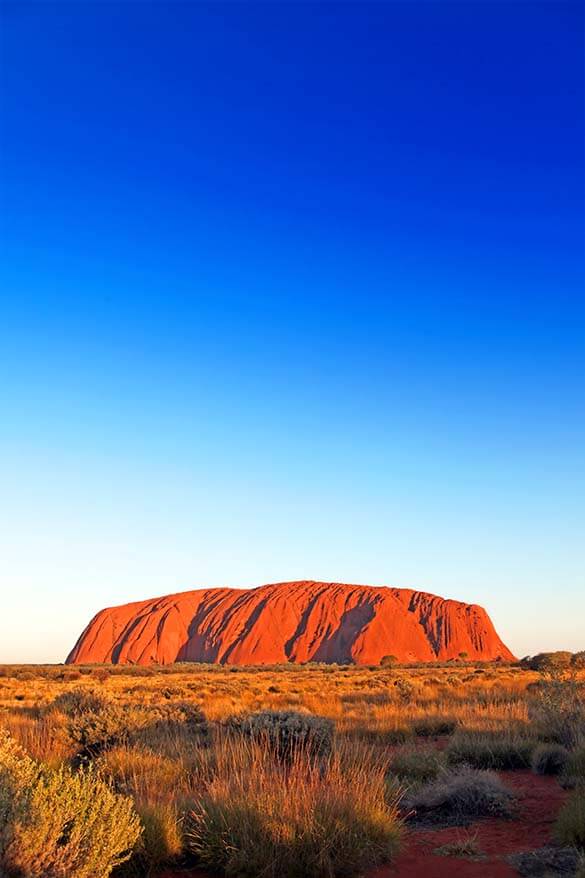
The highlight of any Uluru itinerary is a visit to the Uluru – Kata Tjuta National Park itself. If you don’t plan to hike much and the weather is not too hot, you could easily see everything here in just a day. We split our sightseeing over two mornings and could see everything we wanted and even do some hiking.
It was really hot when we visited Uluru. So we started the day early again because we wanted to try to do as much as we could in the morning before it got too hot to even be outside. Daytime temperatures were simply not human in November!
As if that was not enough, there were a lot of flies here. Swarms of flies EVERYWHERE. They were on your face, the lips, inside your nose, and your ears. That’s something you don’t see on the postcards or in promotional movies…
If I could give you one piece of advice it would be to bring a mosquito head net with you. They sell them in the area too, at about six times the regular price, but by the time you realize you need one, you are nowhere near the shops…

Hiking at Kata Tjuta (The Olgas)
The Olgas, or Kata Tjuta , are extremely spectacular, in a way more special and maybe even more impressive than the Ayers Rock. They are bright red in the midday sun and the view changes constantly as you approach these amazing rocks.
Our first stop was at the Kata Tjuta Dune Viewing Area . It’s only a short walk from the car (wheelchair accessible) and definitely worth a stop. Millions of flies though, so once again a head net would have been really useful!
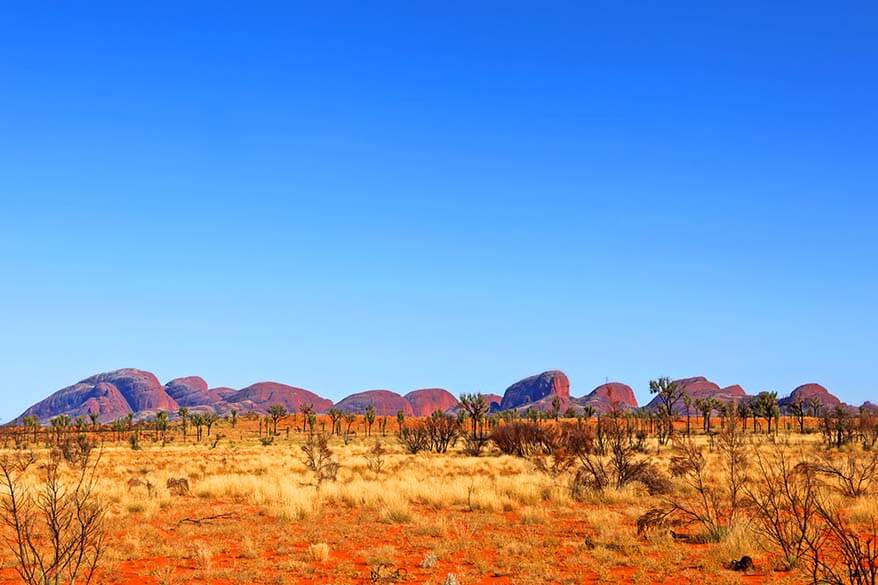
There are lots of beautiful hikes at Kata Tjuta and while not strenuous, they can become practically not doable in the desert heat, with or without kids.
Some walks get closed at 9 AM because of the heat, so if you plan to do any hiking, start very early.
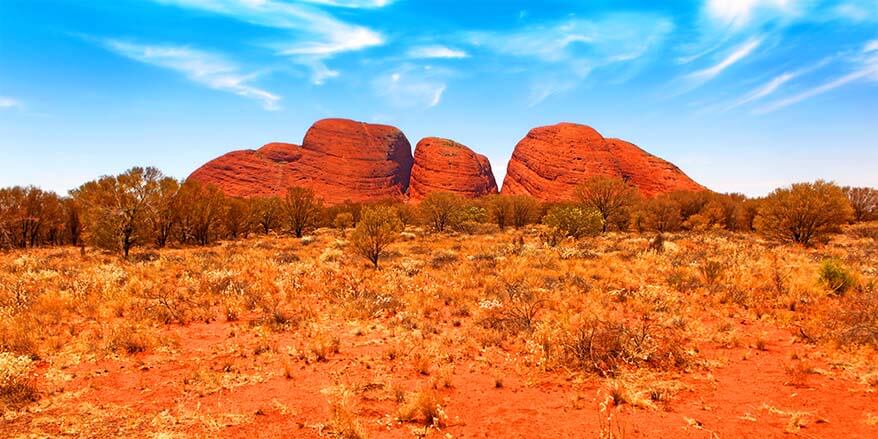
Walpa Gorge Walk at Kata Tjuta
We chose the Walpa Gorge walk since it was an easy short walk (2,6km, 1hr return) and we simply loved it! Phenomenal views along the way! If you are planning a trip to Uluru, make sure to visit Kata Tjuta as well!
LEARN MORE: Kata Tjuta & Walpa Gorge Hike
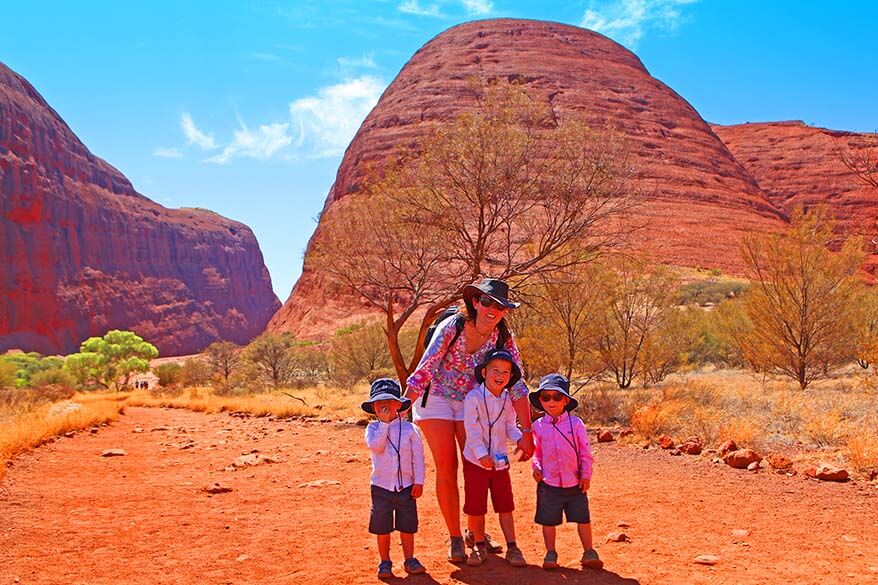
The Valley of the Winds
The Valley of the Winds Walk is said to be the most beautiful walk of Kata Tjuta. It’s a strenuous long walk (7,5km, 4hrs round) and it’s definitely not for everyone, certainly not in high temperatures. We didn’t even consider it.
However, you can easily do a part of the walk up to the Karu lookout point (2,2km, 1 hr return). I went on my own (my family decided to have a picnic in the air-conditioned car instead) and it took me half an hour return (I do walk fast). It was definitely worth the walk!
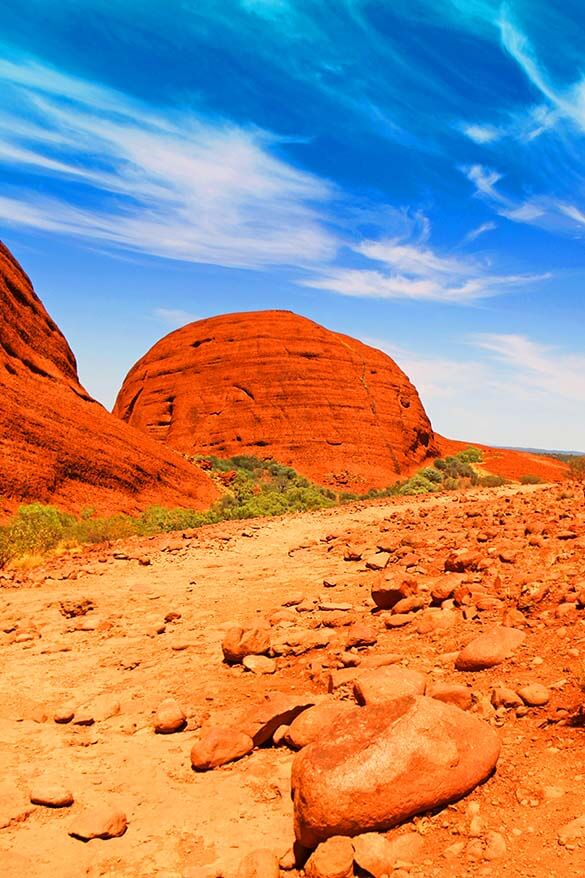
More Things to Do in Uluru
Hiking is not the only way to experience the Uluru – Kata Tjuta National Park.
Here is a short overview of some amazing things to do at the Ayers Rock:
- Uluru Sunrise or Sunset Camel Tour
- Uluru and Kata Tjuta Helicopter Experience (bucket list!)
- Uluru Sacred Sites Tour & BBQ dinner
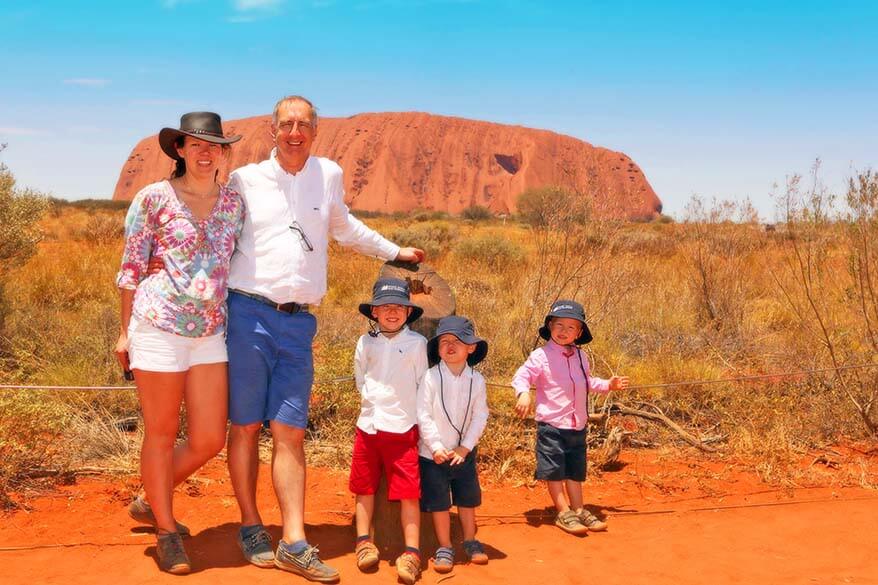
Day 6: Uluru (Ayers Rock) and back to Alice Springs
We had seen Uluru from a distance several times already – the classic view you see in all holiday brochures. But on our last day, we drove to the base of Uluru in order to explore it from close-by.
We found that it is so much more impressive from close by than it is from a distance!
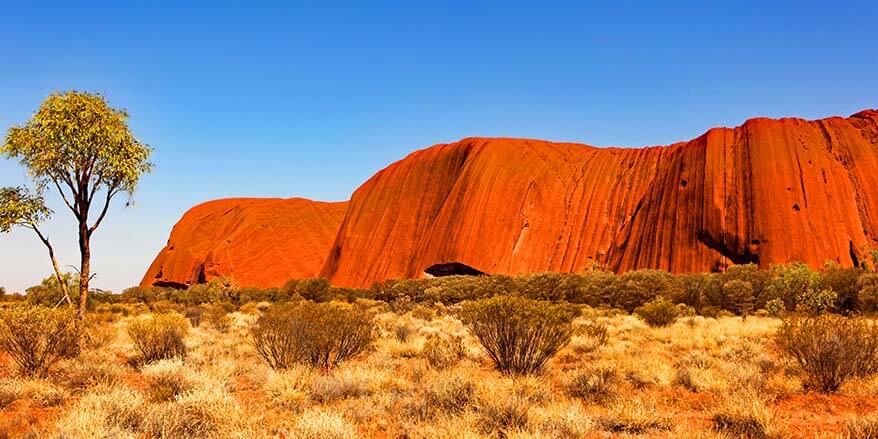
Climbing Uluru
There are several walks you can do at Uluru. You can opt for the Uluru Base Walk (10,6km, 3-4 hrs) that goes all the way around Ayers Rock, or you can choose one of the shorter options – sections of the long walk.
All the walks at Uluru are easy as the terrain is flat. When we visited, it was possible to climb Uluru, but Uluru is a sacred aboriginal site, so we chose not to do it. Nowadays, it’s forbidden to climb Uluru and I strongly urge you to respect this.
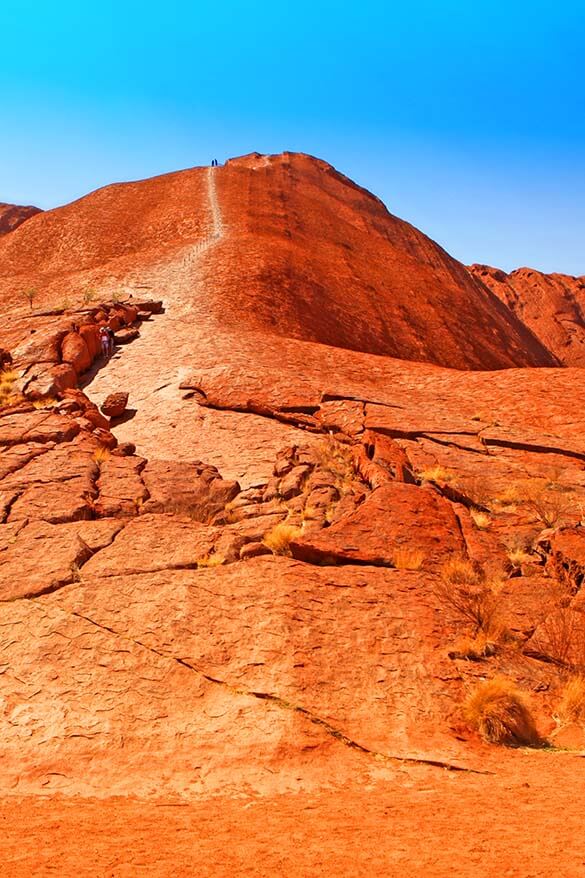
Uluru Base Walk
Uluru Base Walk is one of the best hikes you can do at Uluru. However, it’s a long hike of over 10km and takes at least 3,5-4 hours to complete.
It looked very nice, but it’s too long for a family with three young kids visiting in the summer. Instead, we decided to drive around by car and stop at some places to experience Uluru from close by. Of course, it’s not the same, but it’s definitely worth the short drive and it is a good alternative if for whatever reason you cannot do the long base walk.
If you like to get to know the aboriginal culture a bit more, make sure to visit the Aboriginal Cultural Centre as well. It’s a bit busy though as this is where all the tour busses stop. But this is also the only place where it is busy in Australia’s Red Centre. You’ll see no busses at Kata Tjuta, and you won’t meet groups of tourists on any of the walks.
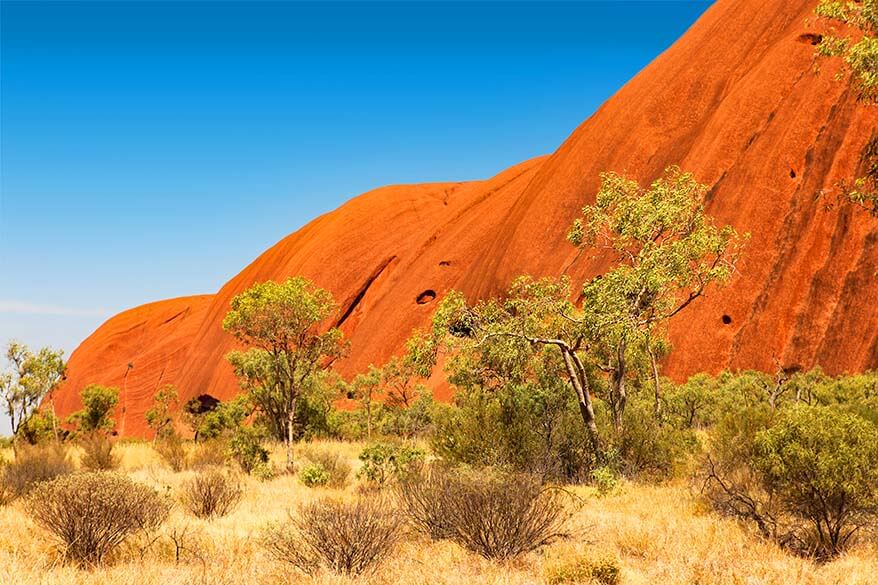
Mala Walk to Kantju Gorge
Based on some recommendations we found before our trip, we opted to do the Mala Walk to Kantju Gorge (2km, 1,5hr return, wheelchair accessible) and it didn’t disappoint! Magnificent scenery all around!
You have to see Uluru from close by to truly appreciate how special it is! It’s not ‘just a rock’ as someone told us before the trip. I would go back all the way to Australia to see it again and to explore this extraordinary region more in-depth.
The Mala Walk takes you to the profoundly peaceful Kantju Gorge. Sheer vertical walls and aboriginal rock paintings (Anangu rock art) make this walk really special. The kids enjoyed it a lot, and so did we.
Practical info: the Mala walk is flat and completely accessible for wheelchairs or strollers. This walk is partially in the shadow, so it can be done even when it’s really hot. Once a day (at 8 AM or 10 AM, depending on the season) you can join a free ranger-guided Mala walk, but the place was so peaceful that we definitely wouldn’t have wanted to share this experience with a group.
You can find more info in regards to Uluru and Kata Tjuta walks on the official website of Parks Australia .
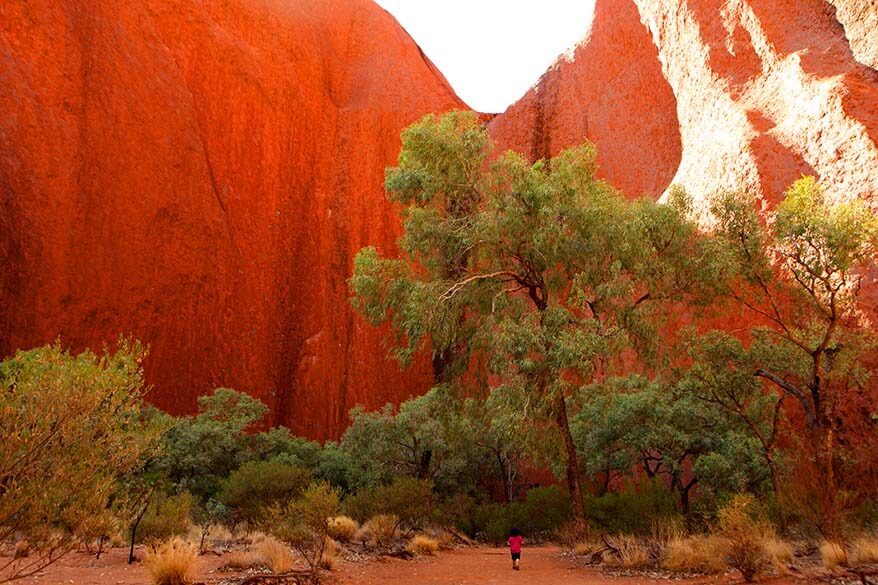
Uluru to Alice Springs
In the afternoon we left the Uluru – Kata Tjuta National Park for a long drive to Alice Springs. The road from Uluru to Alice Springs is sealed all the way. The driving distance is about 470km and it takes at least 5 hours. It took us 6 hours, photo stops included.
There is not much to see along the way, so we didn’t plan any stops. However, the first section of the highway has amazing scenery. You drive through a spectacular landscape with red sand dunes as far as the eye can see. A truly phenomenal sight!
At this point, we realized that we didn’t take any pictures of the red sand, and so we made a short photo stop in the desert. It was over 45°C and my family proclaimed me mad for getting out of the car to photograph sand, but as far as I’m concerned, I would do it again!
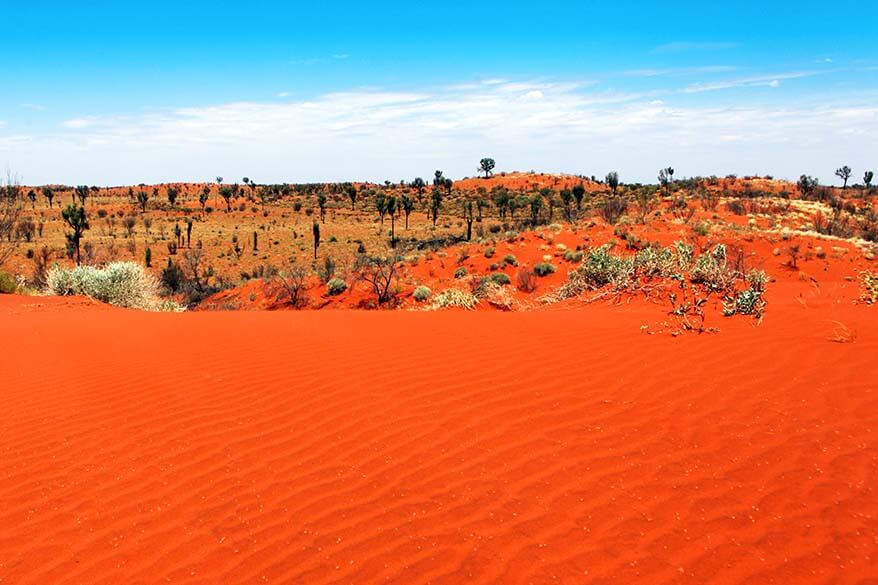
Back in Alice Springs
In Alice Springs we stayed at the same hotel as on the first night of our trip in the Red Centre – Alice on Todd . It felt like coming home.
The next day we flew to Adelaide from where we continued our Australian trip with a visit to Kangaroo Island , Great Ocean Road, and later also Tasmania. It was 20°C colder in Kangaroo Island than in Alice Springs and it probably made the whole Red Centre experience even more special.
Australia is so big and there is so much to see that we are definitely planning to return one day. If there is one place I would definitely want to visit again, it’s the Red Centre!
Below are those Red Centre trip suggestions I promised for budget travelers. Take a look!
If you have a limited budget and don’t want to spend money on expensive resorts and 4WD rental, there are several multi-day camping tours available in the Red Centre.
Most of them start and end in Alice Springs, which saves a lot of money and time. It might look not so cheap in the beginning, but if you consider the cost of a 4WD rental car, hotels, and food, it is. Especially if you’re traveling solo or just with two people.
Here is the best highly-rated budget-friendly Australia’s Red Centre camping tour that I found – the 3-Day Uluru – Kata Tjuta – Kings Canyon Camping Tour .
So, this is our Uluru itinerary starting and ending in Alice Springs.
As you can see, in 6 days, you can see all the highlights of Australia’s Red Center. If the temperatures are cooler when you travel, you could do much more hiking and explore most of the places deeper, or you could do a similar trip in 4-5 days as well. It’s really a matter of planning well and using the best hours of the day wisely.
Enjoy your trip!
More travel tips for Australia:
- Planning a trip to Australia
- Australia Itinerary
- One Day in Sydney
- Great Ocean Drive Best Stops
- Kennet River Koala Walk
- Kangaroo Island
- One Day in Melbourne
- Darwin Itinerary
- Hobart, Tasmania
If you found this post helpful, don’t forget to bookmark it and share it with your friends. Are you on Pinterest? Pin this image!
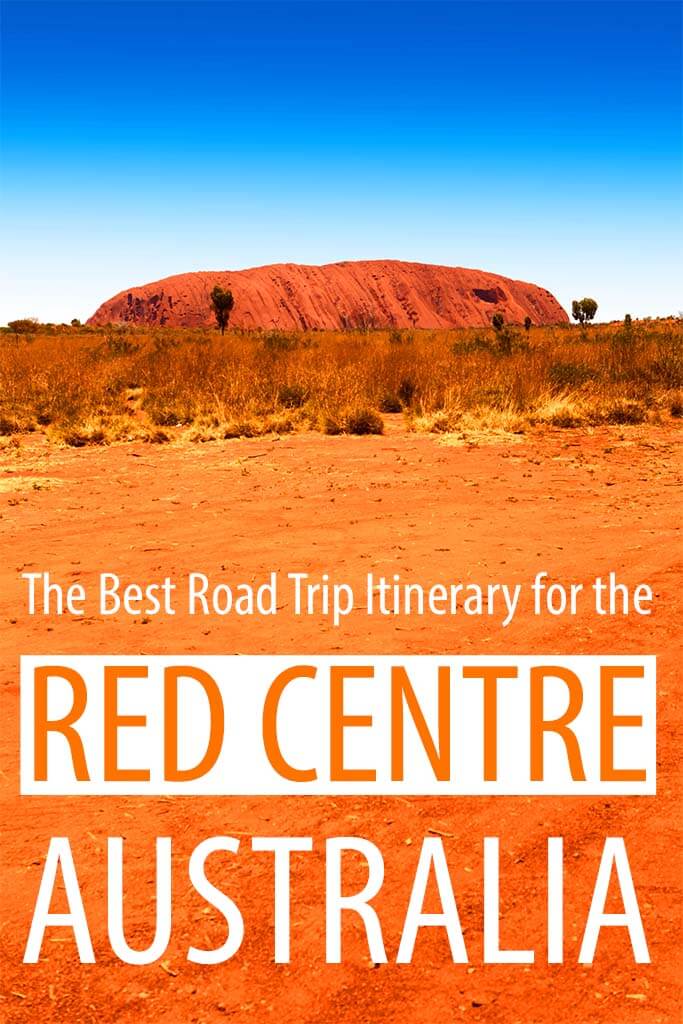
This site uses Akismet to reduce spam. Learn how your comment data is processed .
Saturday 1st of July 2023
Hi Jurga, thank you so much for all the great travel advice - I am just starting to plan a big Australia trip for my wife and I for next march and april - you have helped a lot !!! Trust all is good with you and your family and happy and safe travels.
Glad to help, Steve. Good luck with the planning and have a great time in Australia!
Wayne Power
Wednesday 5th of October 2022
Hi Thank you for sharing. Great job..My wife and I are planning on visiting Australia in mid February for at least six weeks. We are both in our mid-sixties but are in fairly good physical condition. I will be just the two of us and would really appreciate any advice you could give. Our dates are flexible but we want to avoid extreme heat . Thanks Wayne
Sunday 9th of October 2022
Hi Wayne, it's really difficult to give any useful advice not knowing what your interests are, your budget, where you fly to/from, or anything else really. And I really have no time to help our readers with detailed trip planning either. Take a look at this article for some information on how to approach this: Things to consider when planning a trip to Australia. You can also take a look at this 5-week Australia itinerary based on one of our trips. We did this trip in November, so it could work for February too, but yes, it will be hot at some places like Uluru. You can take away the places that don't interest you and/or add the areas that look more interesting (e.g. Great Barrier Reef or Perth) and make an itinerary that could work for you. Good luck with the planning!
Stephen Crocker
Thursday 30th of April 2020
As a "local" (or at least someone who has explored much there after my travels from NSW) may I suggest you should, if at all possible, plan to visit between late May and up to the end of September. Wonderful! Yes, some of the scenery may seem monotonous at times but have an relaxed attitude and you'll find yourself adjusting quite quickly. We took our 3 little ones across the Nullabour in 1992 and some of the great memories we and they have are of just stopping when they were getting a bit stroppy and just kicking a football around. We brewed up a cuppa on the side of the road. There don't seem many places these days where you can stop safely virtually the second you decide to. There will always be a tree or decent sized bush to give at least partial shade but in the winter/spring months it won't be a problem anyway. In places like those it can be eerie in near soundlessness, just hearing your blood going through your ear canals
Saturday 2nd of May 2020
Thanks for sharing your experience, Stephen. We'll be back Down Under one day again. The Red Center is a place like no other. Loved it, despite the heat.
Thursday 29th of August 2019
Reading your post brings back splendid memories :-) We were there in Uluru Aug last year & it was a fantastic experience. Thank goodness there were no flies, yes practically fly-free during winter. Especially love the Red Centre, views & walks of Uluru, Kata Tjuta & Kings Canyon was simply stunning. Never miss watching the sunrise & sunset. Every view has their 'WOW' effect. Our stay at Emu Walk Apartments was great too. My advise, to at least stay 3 days to truly enjoy this fascinating place.
Hi Kelly, just reading this I want to go back and visit again :) It's an amazing place, indeed. I hope we get back there one day and explore it more in-depth now that the kids are older. Happy travels!
Monday 4th of March 2019
This is so helpful, thank you. We are tentatively planning a trip to the Red Center in May of this year. We have a 3 yr old and a 9 month old baby. Would this trip be okay with a baby? I know your kids were a bit older -- I can't seem to find any blogs or info on Uluru/Alice/Kings with a baby. We hike and use baby carriers at home. Just worried about stocking up on food (I imagine the grocery options out there are limited - baby food even more so?) flies, potential danger from spiders/snakes since he will want to crawl on occasion despite our best efforts haha. Any tips would be appreciated!
Sunday 10th of March 2019
Hi, I really don't see why you couldn't visit the Red Centre with a baby. There are shops and even quite a big supermarket in Yulara, just next to the entrance to Uluru-Kata Tjuta NP, where all accommodations are also located. So you'll find whatever you need there. I'm not sure specifically about baby food or diapers, but I think it shouldn't be a problem. In any case, in Alice Springs you'll be able to buy all you need, so you can stock up there before leaving the town. As for spiders or snakes, we didn't see any. Flies - we visited in November and it was indeed a problem. Not sure how it is in May, I imagine it will be much cooler and also maybe less flies. But you may want to get a headnet just in case. Enjoy the trip - there will always be challenges, but it's a beautiful area and well worth visiting!

19 Spectacular Things To Do at Uluru
Wondering what to do when you visit Uluru? In this guide, I share my recommendations for the best things to do at Uluru, a truly unforgettable place to visit.
If there’s one place that epitomises Australia, it must be Uluru. This iconic red rock, smack bang in the middle of the country, is a must-visit for any trip to Australia.
Towering 348 metres above the Earth’s surface, what’s even more mind-boggling is that there’s more than 2.5 kilometres of Uluru actually beneath the surface!
While today it’s one of the most recognisable natural attractions in the world, Aboriginal people have known about it for thousands and thousands of years. This sacred site has evidence of human life dating back some 30,000 years. It’s still a sacred site for the Anangu people and I’ve no doubt that you’ll feel a deep sense of spirituality when you’re here.
You’ll never forget your first time seeing Uluru, and in this guide, I’ll share even more unforgettable things to do at Uluru.
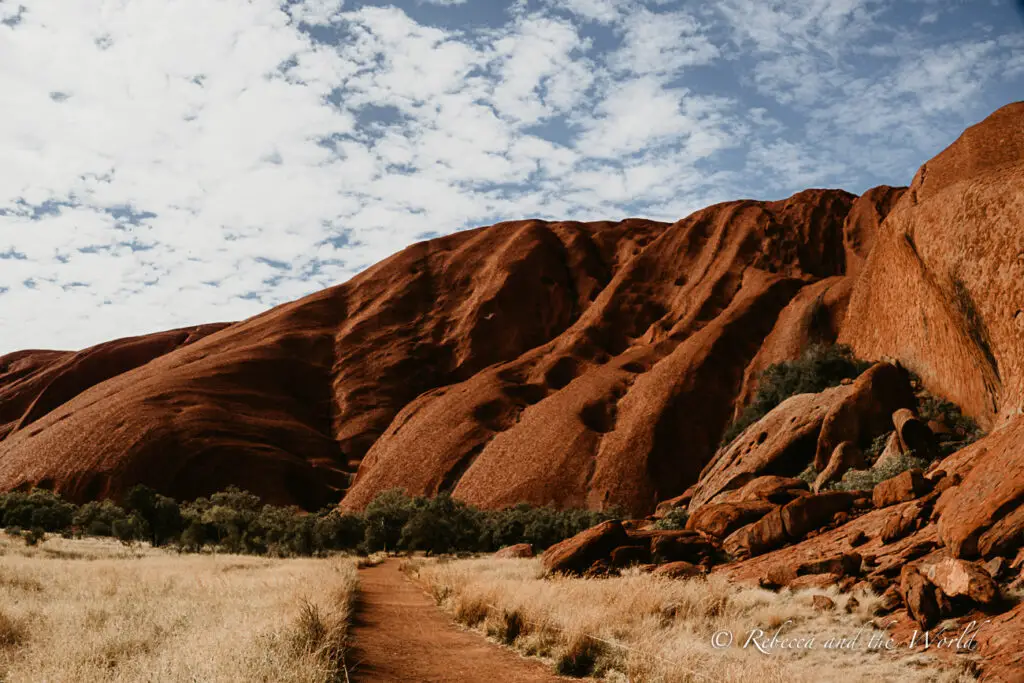
This blog post may contain affiliate links, meaning if you book or buy something through one of these links, I may earn a small commission (at no extra cost to you).
What's in this article (Click to view)
Tips for visiting Uluru
Uluru or ayers rock.
The explorer William Gosse named the monolith Ayers Rock in 1873, named so after Sir Henry Ayers, the Chief Secretary of South Australia at that time. It’s believed Gosse was the first non-Aboriginal person to spot Uluru.
But it’s been Uluru long before Europeans saw it and, thankfully, in 1993 the name was recognised in dual naming. While you can call it Ayers Rock, the better name is Uluru – one that recognises the sacredness of this natural wonder.
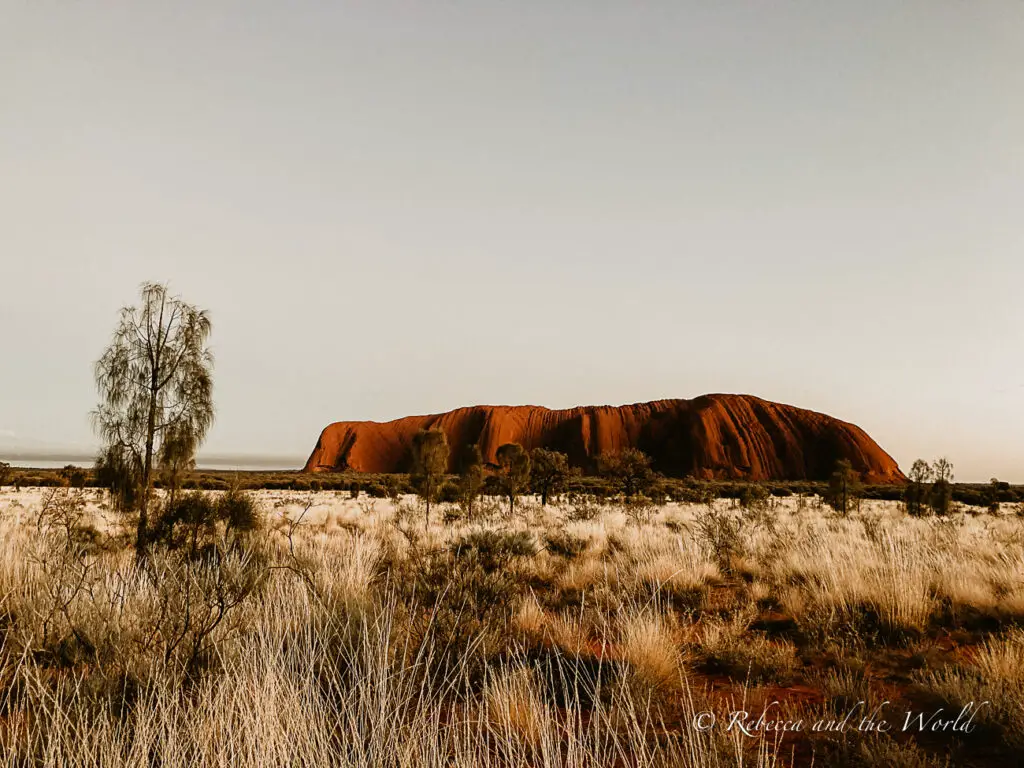
How long to spend at Uluru
Because there’s so much to do at Uluru – and because it’s pretty remote! – I recommend at least two to three nights. This will give you enough time to do activities at Uluru and spend a bit of time relaxing and taking in the majesty of Uluru-Kata Tjuta National Park. It’s one of the most amazing things to do in Australia , so don’t just speed through a visit to Uluru!
Buy a park pass
To visit Uluru-Kata Tjuta National Park, you need to purchase a park pass. These can be purchased at the gate, but if you’re travelling during peak seasons, I recommend buying it online in advance .
Passes cost $38 for adults and are free for children 17 and under.
Passes are valid for three days. You do need to specify your dates when you buy online, although you can change dates if needed (but only once).
You can’t take photos at some places
Uluru is a sacred site for the Anangu people and you will see signs showing where you can’t take photos or video to avoid revealing special sites. Make sure you respect these signs.
And on the topic of photos and video, it’s forbidden to fly a drone in Uluru-Kata Tjuta National Park without permission.
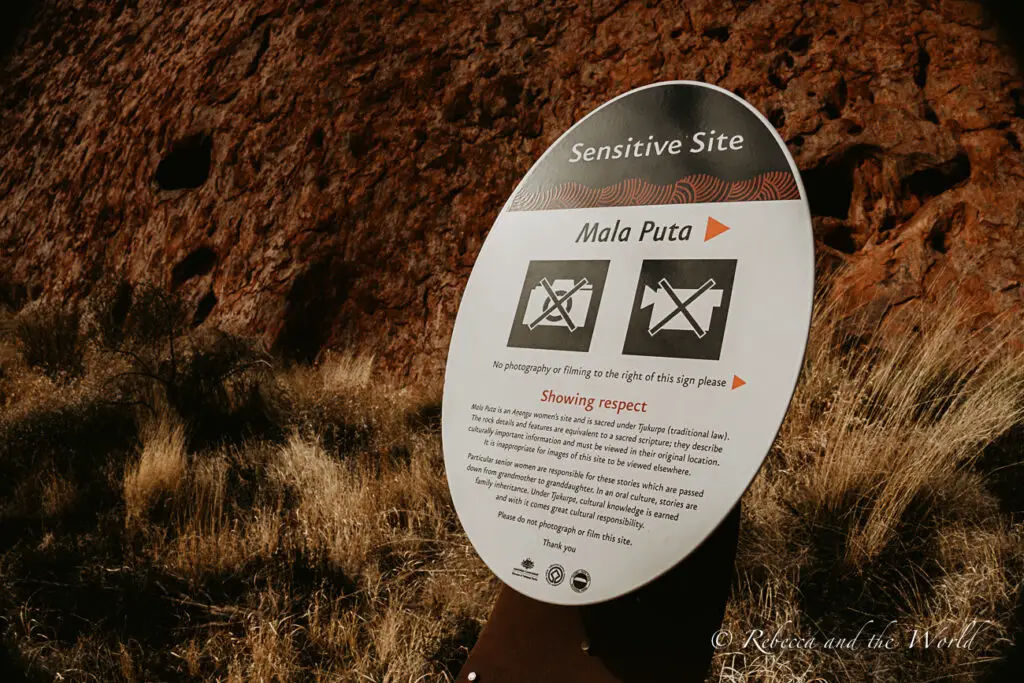
You can’t climb Uluru anymore
Despite the Anangu asking people not to climb Uluru for many, many years – for both sacred and safety reasons – visitors continued to climb. Thankfully, their requests are now respected, and as of 26 October 2019 you can no longer climb Uluru. Don’t worry – as one of the best things to see in the NT , Uluru is just as amazing from the ground.
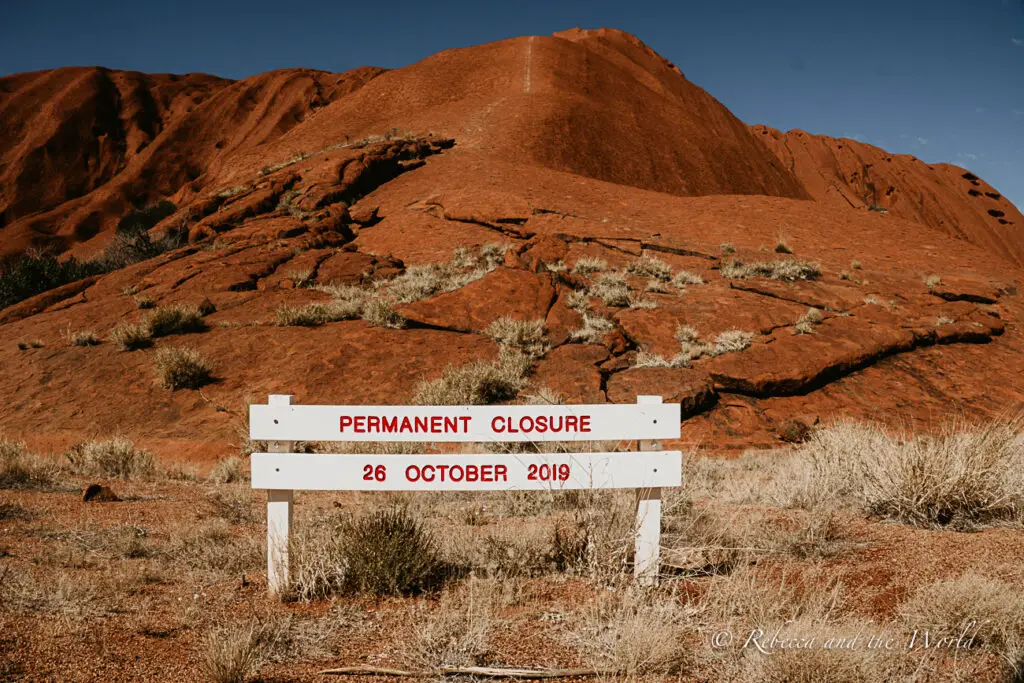
Avoid the heat of day
It can get very hot at Uluru, especially if you’re travelling outside of the winter months. Even in winter, day time temperatures can hit 30 degrees and above. When planning hikes, try to do them in the morning or afternoon to avoid the highest temperatures.
Book accommodation and Uluru activities in advance
Uluru is a popular place. Even in the off-peak seasons it’s not uncommon to find accommodation booked out and limited spaces on activities. So, make sure you plan ahead to avoid disappointment.
The best things to do at Uluru
Here are my recommendations for the best things to do in Uluru on your visit.
1. Uluru base walk
The Uluru Base Walk is a great way to see Uluru up close from all angles. The colour of the rock, its shapes and the patterns in the rockface change as you walk around.
Start the walk from the Mala carpark and take the loop clockwise. The walk is a 10.6km loop, which will take you around 3.5 hours. There’s interpretive signage at various points to explain interesting and important aspects of Anangu culture and life.
It’s a flat walk all the way around but be warned that there’s not a lot of shade. So, slather on sunscreen and make sure you have plenty of water a good hat for protection. There are a couple of seats along the path, but not many.
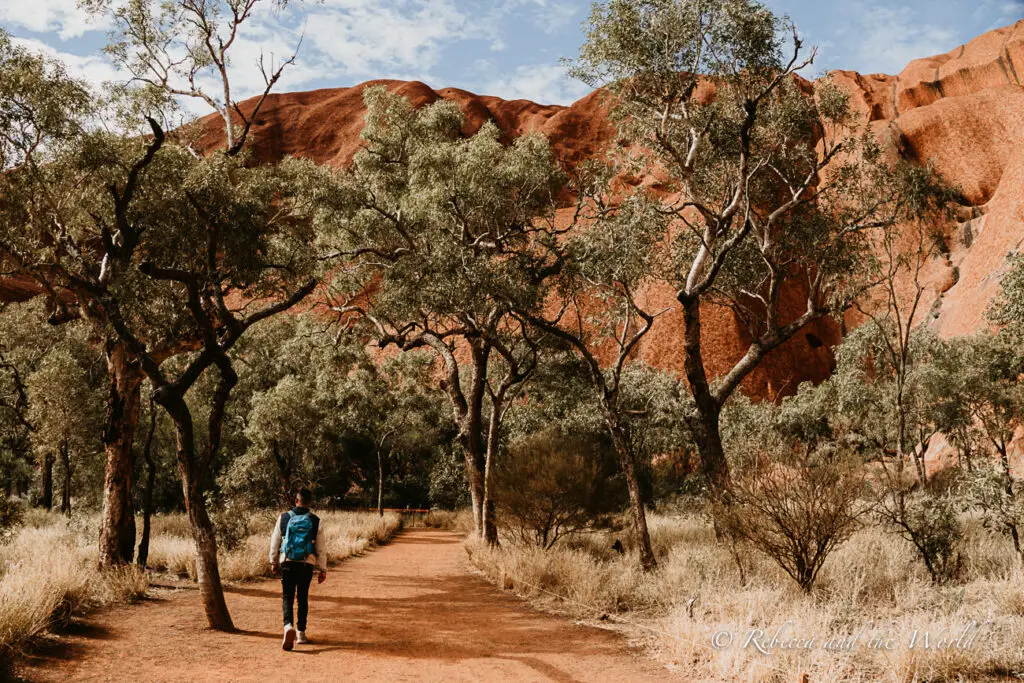
2. Hire a bike
If the idea of a 10.6km walk sounds daunting or you just don’t have the time, you can rent bikes and do the Uluru base loop on two wheels instead.
Outback Cycling has trailers full of bikes to hire at the Uluru-Kata Tjuta Cultural Centre. Bike rental costs from $70.
3. Or take a segway
And if you really don’t want to get active, then one of the easiest things to do at Uluru is take a segway around the base.
Personally, I’m not a fan of segways – they seem to take away from the sacredness of the site. But it is possible and you can book online from a variety of sunrise and sunset guided tours. Transfers can also be included.
4. Dine under the stars
Eating out under the inky black sky with a blanket of stars stretching above you is an amazing way to experience Uluru.
Ayers Rock Resort has two outdoor dining experiences: Tali Wiru and Sounds of Silence . Both aren’t cheap but they are incredible.
On our trip to Uluru, we splashed out for the Tali Wiru dinner. We were driven to a private deck with a view of Uluru. Dinner started with champagne, canapés and a yidaki (didgeridoo) performance, followed by a four-course menu. Each dish featured native ingredients and was paired with Australian wines.
The night ended with a fascinating astronomy lesson and hot chocolate and cognac around the campfire. Definitely not one of the cheapest things to do at Uluru (I didn’t tell my husband how much it cost!), but so worth it!
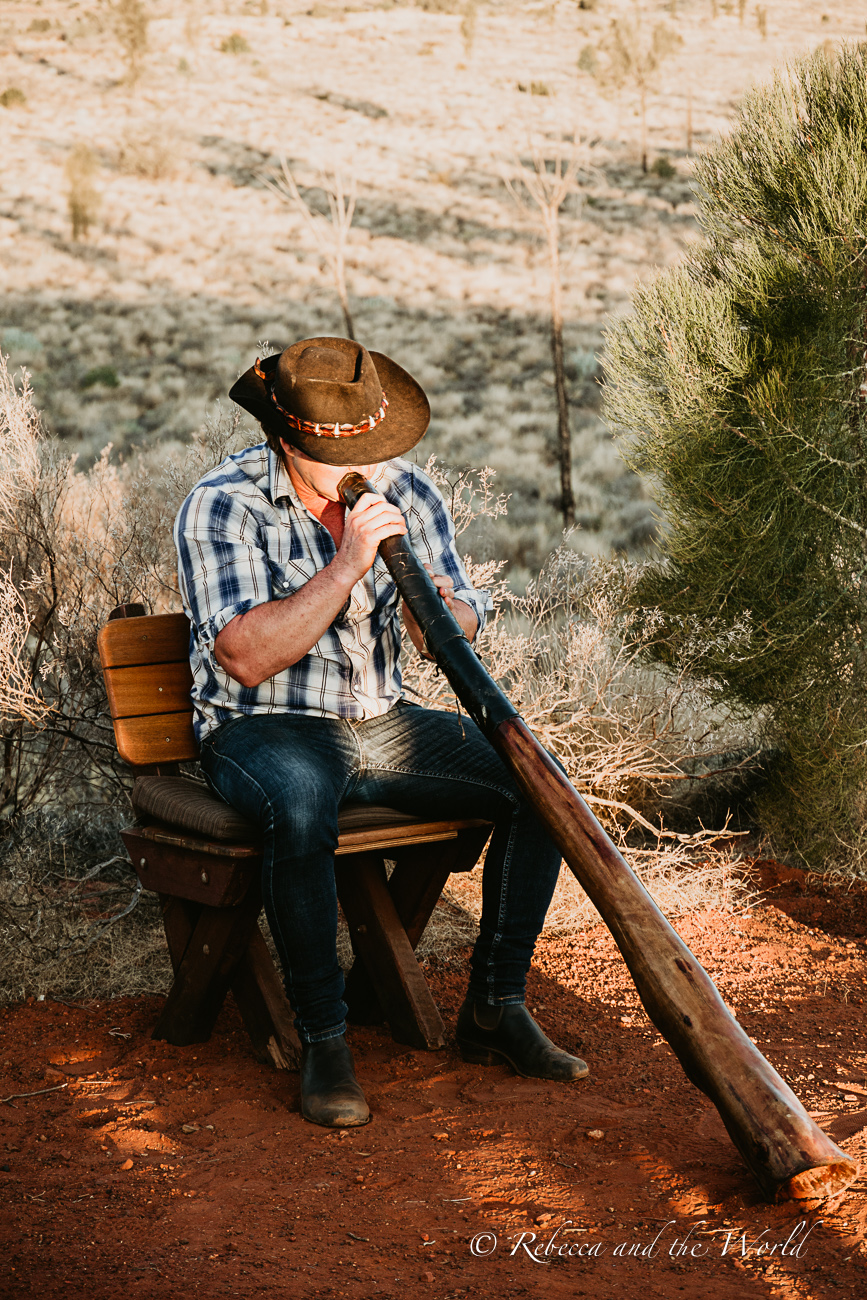
The Sounds of Silence dinner is a similar experience to Tali Wiru, but you’ll sit at shared tables (rather than just with your group). There’s an in-depth stargazing lesson and delicious food.
Reputable tour company AAT Kings also runs a BBQ dinner under the stars . Their tours include a multi-course meal, drinks and an astronomy lesson.
5. Watch the sky light up
The newest experience at Uluru is mind-blowing: more than 1,100 drones light up the sky to share an ancient story using modern-day technology.
Wintjiri Wiru tells the ancient Mala story from Kaltukatjara to Uluru. It’s the first time an Indigenous story has been told through the medium of lights, lasers, projection and drone technology at this scale and frequency.
Created in careful consultation with the Anangu people, the experience includes light refreshments or dinner, depending on the package you choose.
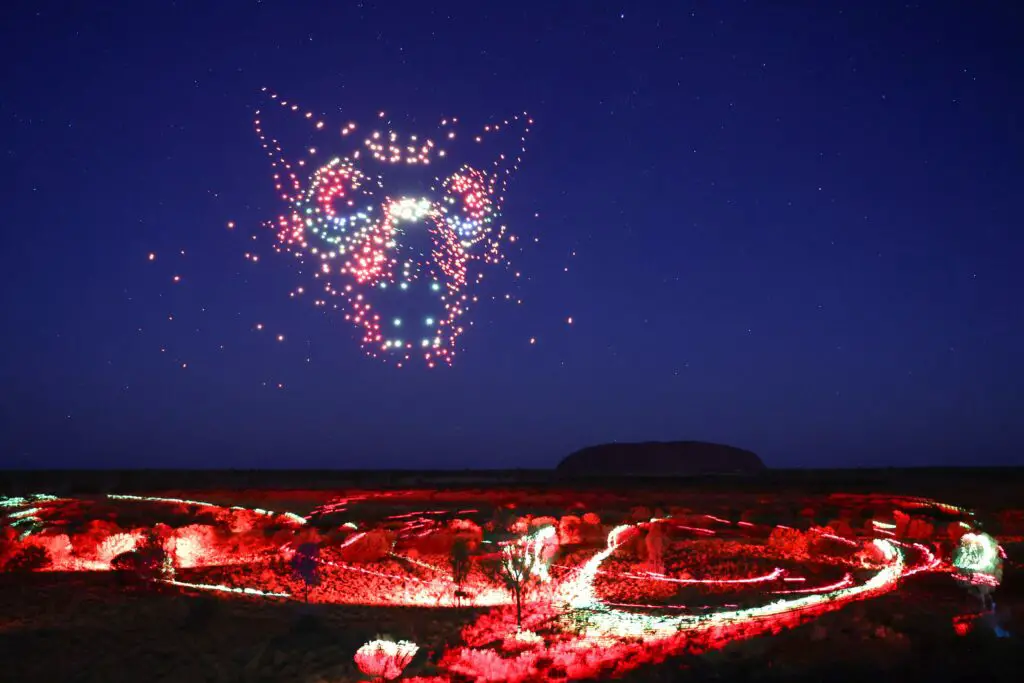
6. See Uluru at sunrise and sunset
Throughout the day, Uluru changes colour, and sunrise and sunset bring the richest, deepest reds and ochres.
There are a couple of places to watch the sunrise. The Talinguru Nyakunytjaku sunrise viewing area has several shelters, viewing platforms and some walking tracks so you can stand with the crowds or find a quieter spot to marvel at the sunrise.
For sunset, head to the clearly marked Car Sunset Viewing area to see the rich reds of Uluru as the sun sinks down over the horizon.
Hot tip: The sunrise and sunset viewing areas can get busy. But if you’d like to see the sunrise or sunset with fewer people, then head to the opposite viewing platform, where you’re likely to have the viewing area all to yourself. So, at sunrise, go to the sunset viewing platform and vice versa for sunset.
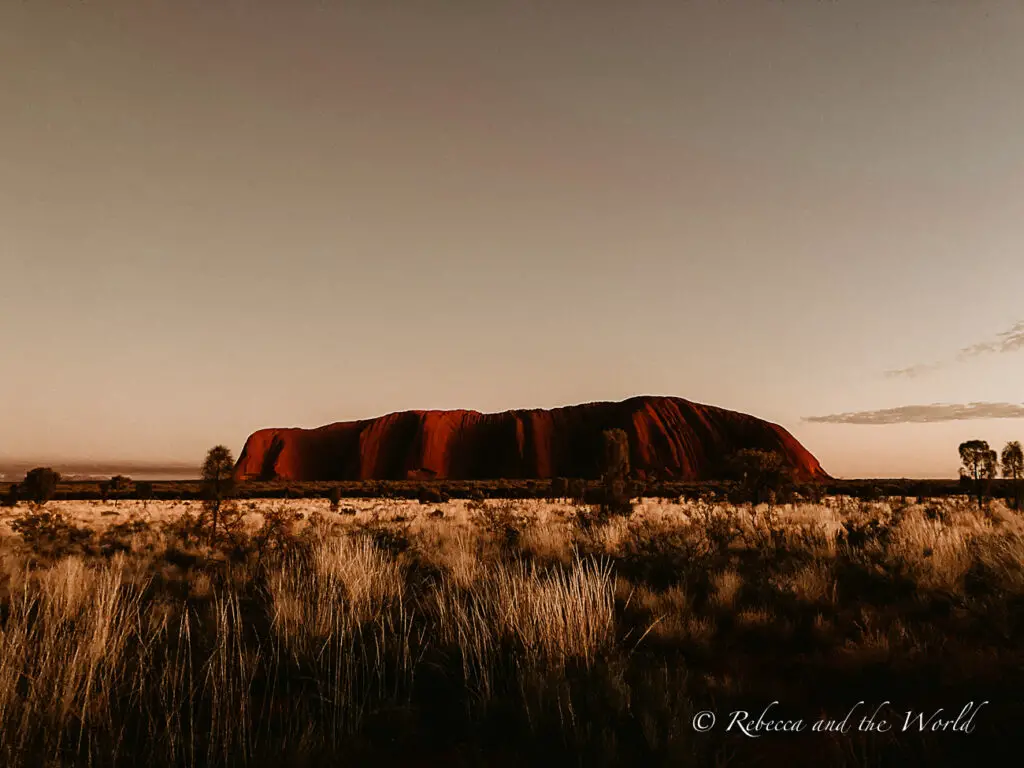
7. Head to Kata Tjuta
Kata Tjuta (the traditional name for the area previously known as The Olgas) is Uluru’s somewhat lesser-known sister, but it is equally as mind-blowing. This stunning rock formation is located in the same national park as Uluru, so it’s easy to spend a day at one and a day at the other, if you have the time on your Uluru road trip.
Kata Tjuta is a series of 36 domes pushing their way out of the flat surrounding land. The tallest dome rises almost 550 metres high. Kata Tjuta means “many heads” in Pitjantjatjara language, and it’s easy to understand where this name comes from.
On your way out here, stop at the viewing platform to get the full panoramic view of Kata Tjuta.
Kata Tjuta is also a spectacular place for sunrise and sunset. We didn’t have time to do this (our cosy bed was far too hard to get out of on the chilly mornings!) but the photos I have seen show the domes drenched in blood-red shadows.
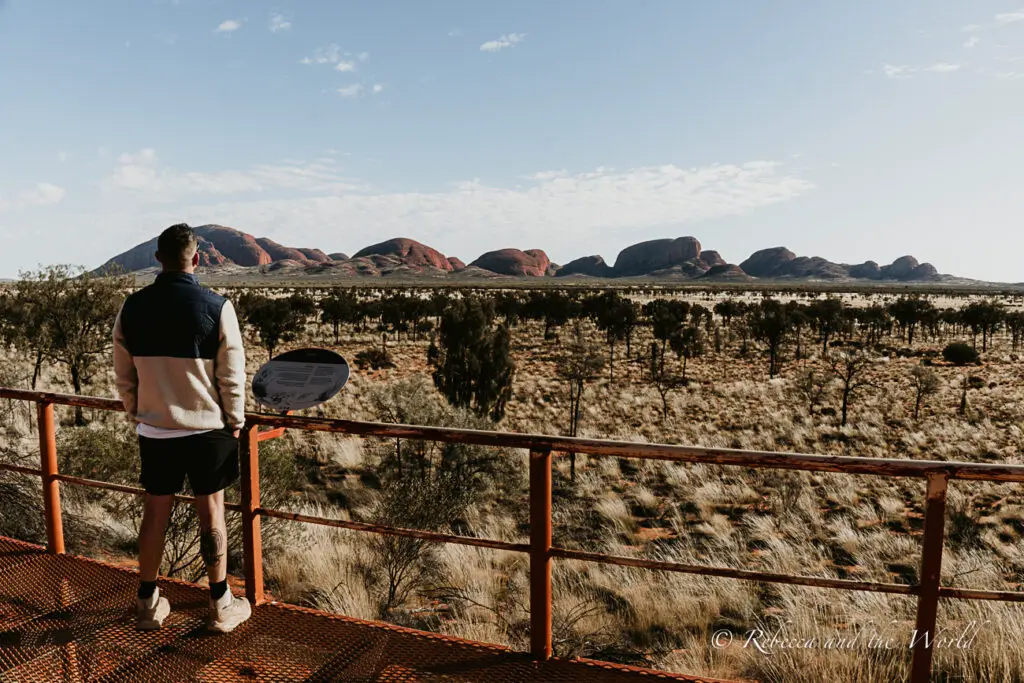
8. Hike the Valley of the Winds trail
One of my favourite hikes at Kata Tjuta is the Valley of the Winds trail. It’s a 7.4km loop that takes anywhere between two to four hours. There are shorter in and out sections if you don’t have the time or energy to do the whole hike.
The first part of the trail is really rocky – but don’t let that put you off. There are also some steep parts and rock scrambling up flat boulders. My favourite part of this hike is the Karingana Lookout, where you can gaze out between the boulders. Even with other people there, it feels incredibly tranquil.
The trail closes if the weather hits 36 degrees.
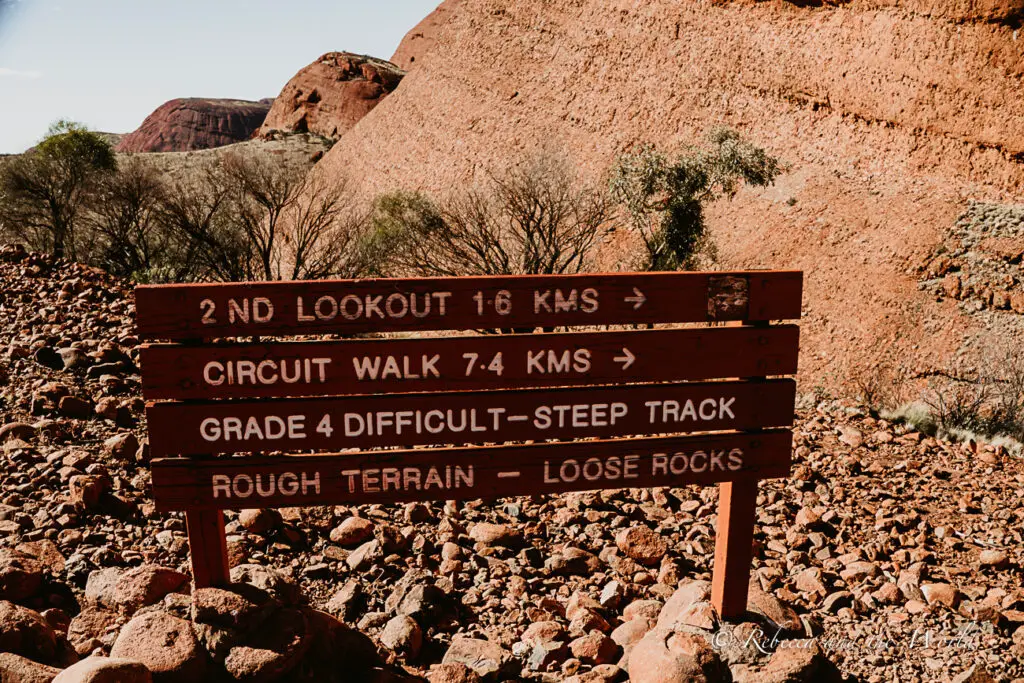
9. Check out Walpa Gorge
The other great hike at Kata Tjuta is the Walpa Gorge trail. At only 3 kilometres and relatively flat, it’s an easy in and out trail for the whole family.
The trail leads into the domes, and ends with a viewing platform that overlooks a lush green space. Standing at the base of the gorge, you have an acute sense of how these rock walls have formed over millions of years.
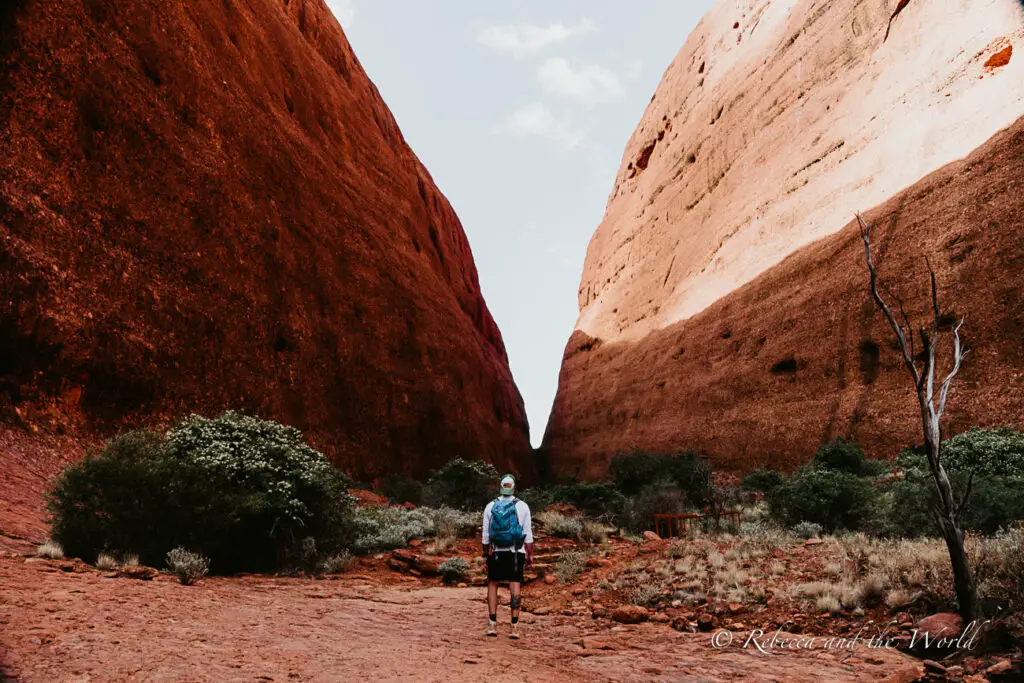
10. Take the guided Mala walk
The start of the Uluru base walk includes the Mala walk, a 2-kilometre trail. You can easily do this walk yourself and read the interpretive signage, but even better is that there are guided tours. Park rangers can tell you all about Anangu culture, the rock art and how the park is managed.
Guided tours operate at 10am daily from May to September, and at 8am from October to April.
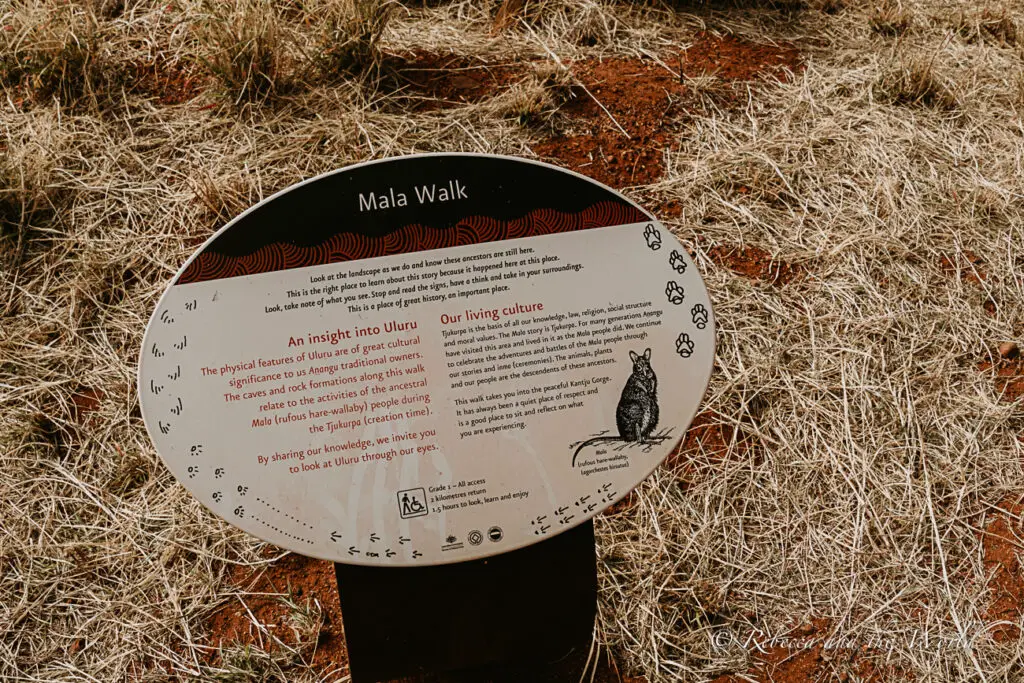
11. Go for a walk after sunrise
As well as being a great spot to watch sunrise each day, Talinguru Nyakunytjaku (mentioned earlier) has two walks that you can take after you’ve finished enjoying the sun rise.
The Minymaku Walk is a 1-kilometre return trail, and is where you can learn all about women’s business.
The Watiku Walk is a little longer at 1.5 kilometres, and this trail teaches visitors about men’s business.
Both trails have useful interpretive signage.
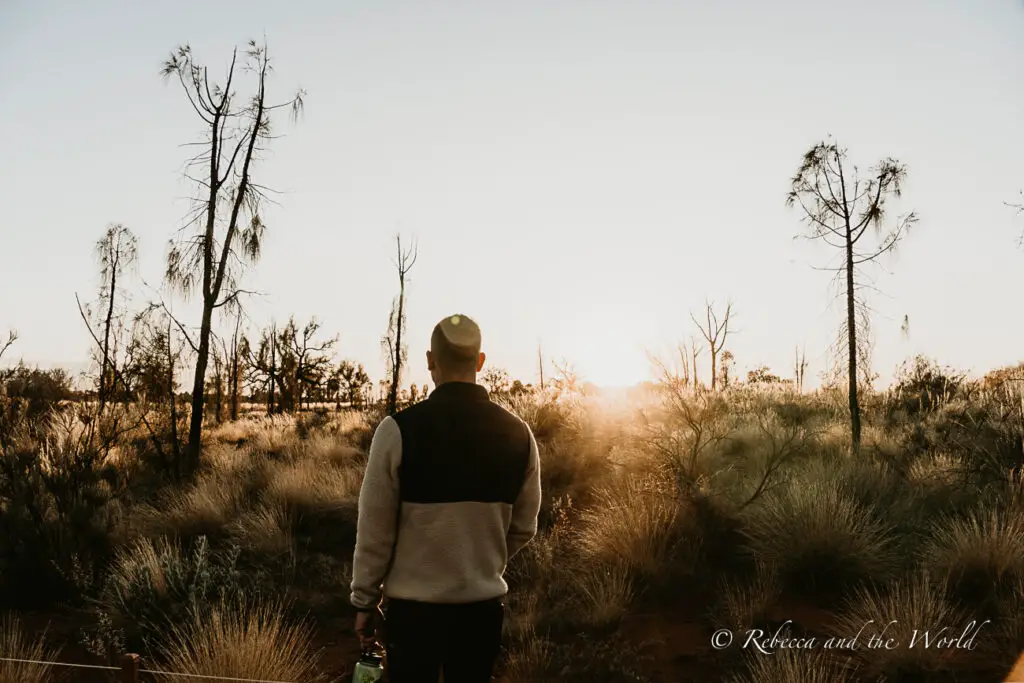
12. Wander through the Field of Light
Bruce Munro’s spectacular light installation was only supposed to be at Uluru for a short while but has now been extended – indefinitely. This is one of the most popular Uluru attractions.
The art installation features 50,000 light stems in various shades of red, purple, blue, green and white, laid out over a huge area with Uluru looming above.
There are a few different ways to see the Field of Light on your Uluru trip. Passes start from $46 for adults, but you can upgrade the experience to a Star Pass (with canapés and beverages) or even a dinner under the stars .
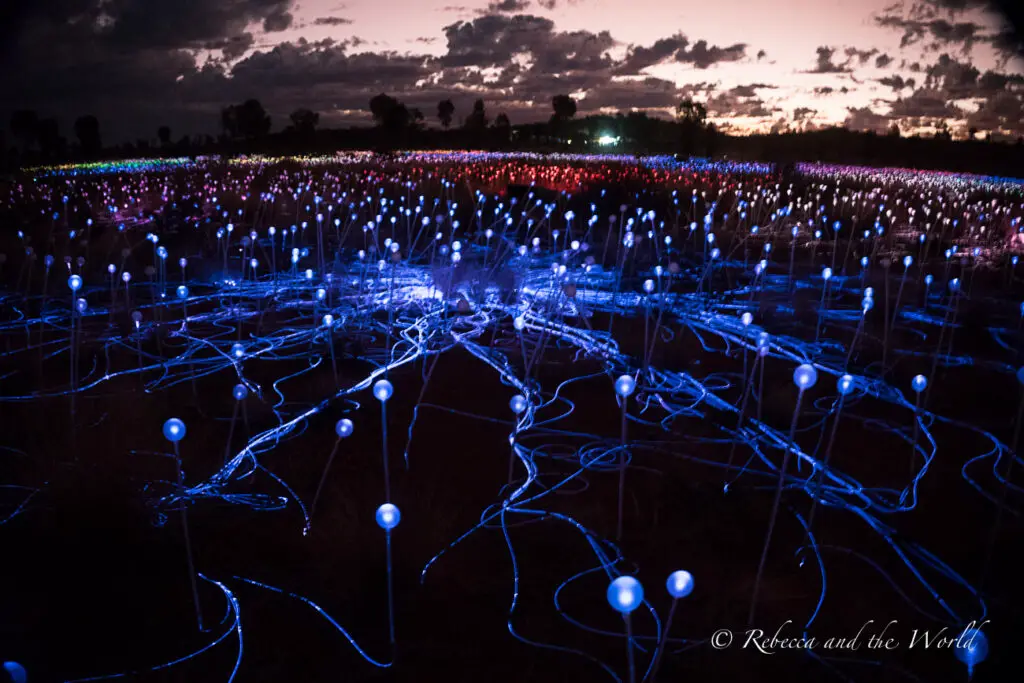
13. Enjoy free activities at Ayers Rock Resort
There’s no denying that a trip to Uluru isn’t going to be cheap. But Ayers Rock Resort does throw on a few free activities that give your wallet a break.
Check out the latest free activities , which can include everything from bush tucker talks to guided garden walks and painting workshops. These things to do in Uluru for free are great activities for families and adults alike.
14. Take a dot painting workshop
Art plays an important role in the passing on of Aboriginal culture, and Maruku Arts teaches visitors about this through a hands-on dot painting workshop.
During the class, you’ll learn about the various symbols and painting styles, and then get stuck into making an artwork of your own.
Workshops are 1.5 hours and are held twice a day throughout the year. Book online here .
Interestingly, dot painting isn’t a long-held tradition – it actually emerged in the 1970s as a way to hide traditional and sacred meanings in artworks.
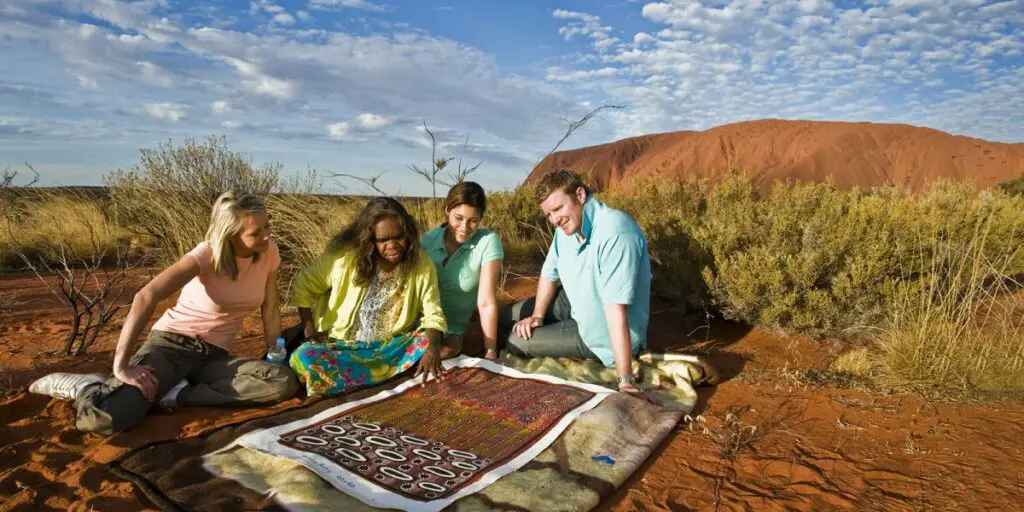
15. Visit the Cultural Centre
The Uluru-Kata Tjuta Cultural Centre is one of the best places to visit in Uluru to learn about culture. While it’s not fancy inside, it does have a tonne of information about local culture, traditions and stories. Spend a bit of time wandering inside before you head out on your hikes.
There are also some shops and galleries selling art and souvenirs, and the Ininti Café for a drink or snack (although it was closed when we visited).
16. Take a camel ride
A sunrise camel ride is one of the more unique ways to see Uluru. You will need to rise early and climb aboard a “ship of the desert” for a lumbering ride through the desert as the sun emerges.
Camel rides include damper and billy tea. Book online here .
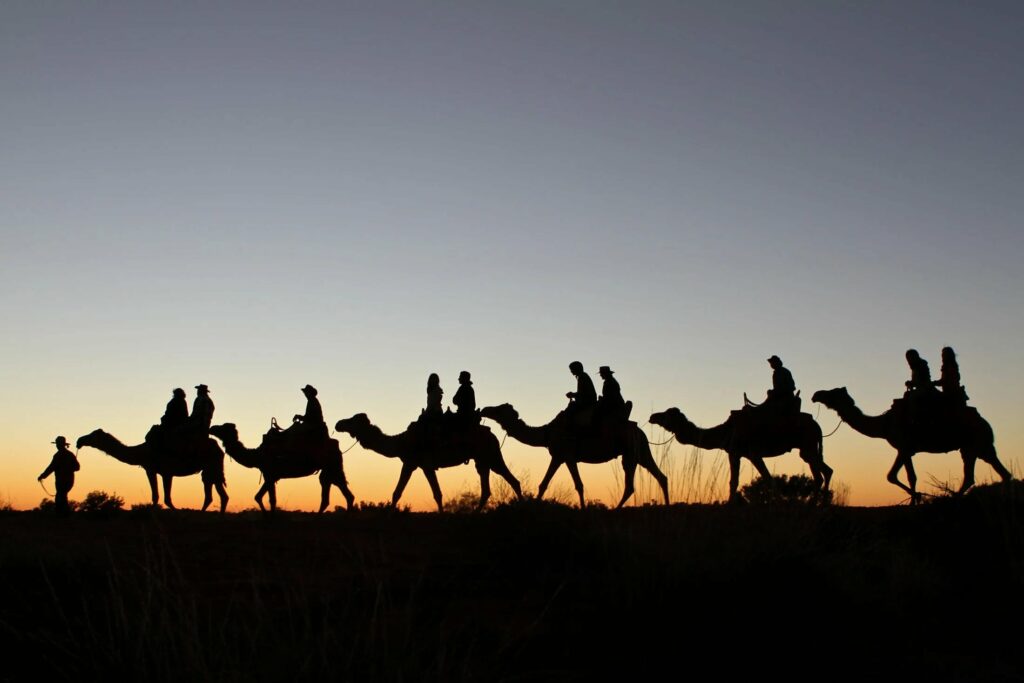
17. See Uluru and Kata Tjuta from above
Uluru and Kata Tjuta are incredible from the ground – but to truly get a sense of their size, jump in a helicopter or plane for a quick tour above.
Rides last 25 minutes but will give you an incredible view over both Uluru and Kata Tjuta.
Scenic plane rides cost from $295, while helicopter rides are around $330.
18. Simply sit and watch
Visiting Uluru can be overwhelming. Not only is there so much to do in Uluru, but there’s always an inescapable sense of being somewhere truly important and sacred.
So, make sure you take some time to just sit and contemplate. After the crowds have dispersed after sunrise, stay a little while longer and take in the majesty of this site. Or go outside at nighttime and take a moment to look up at the stars.
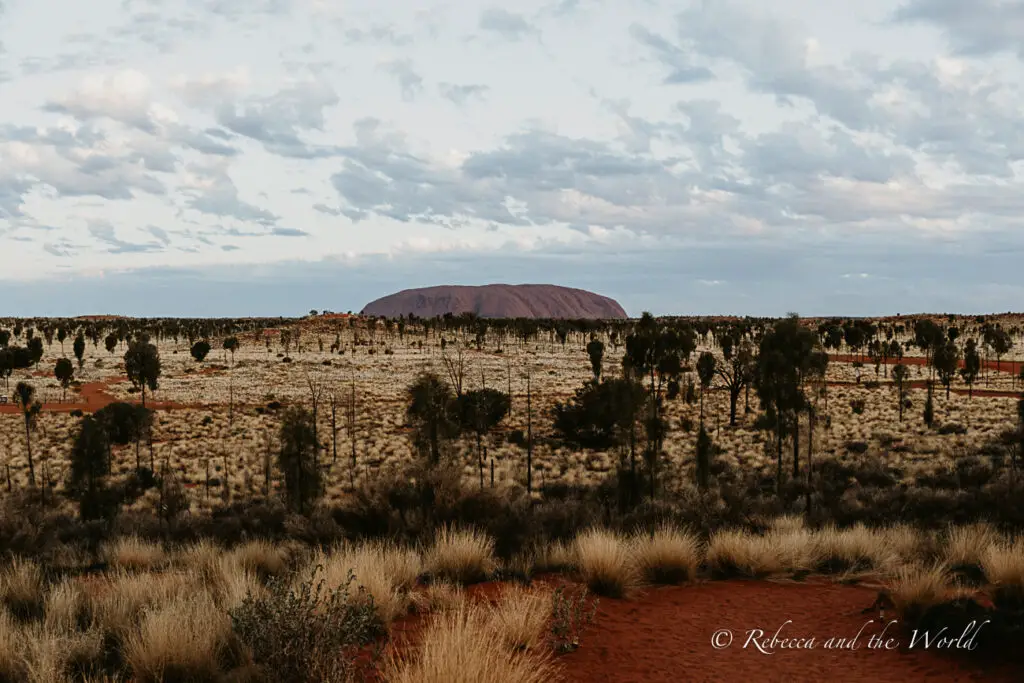
19. Take the Red Centre Way
You can visit Uluru for just a few days – but why not make it part of a bigger trip around Central Australia?
Hire a campervan or 4WD and take the Red Centre Way, a loop that takes in Uluru, Kata Tjuta, Watarrka National Park and Kings Canyon, and the West MacDonnell Ranges.
Check out my Red Centre Way itinerary for more information.
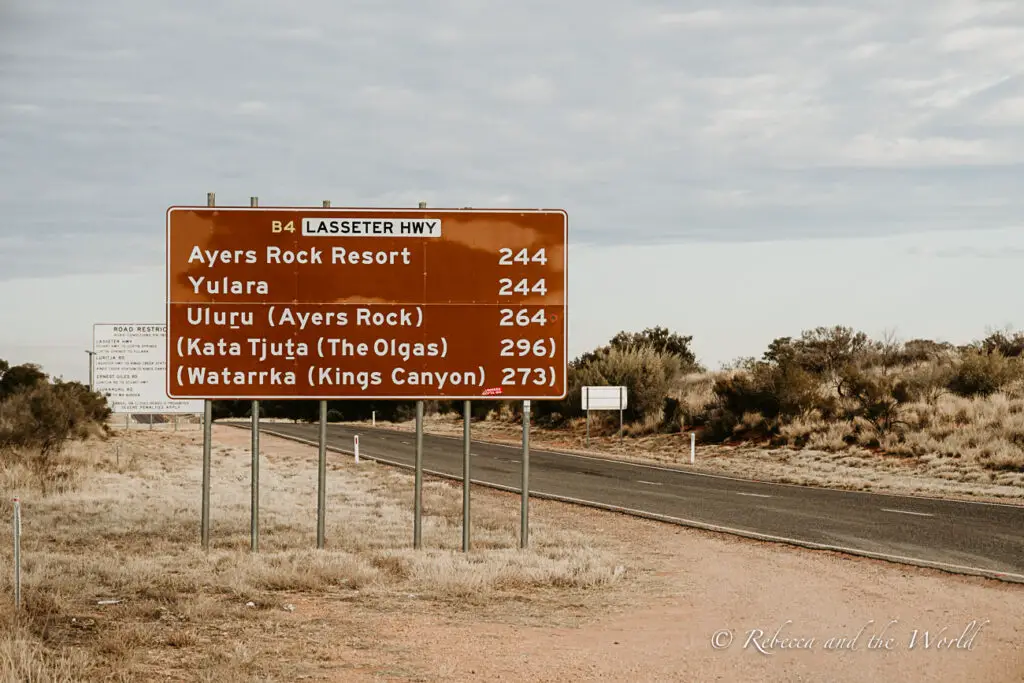
Best time to visit Uluru
The time of year will have a huge impact on your visit to Central Australia. While you can visit at any time of year, the winter months (between May and October) are milder and more pleasant. Days are usually sunny but remember to pack plenty of layers for the freezing desert nights!
Summer months bring high temperatures (up to 45 degrees) and lots of flies in Red Centre Australia. It’s also the wet season and storms can wash out parts of roads.
We visited in July and had sunny days ranging from 14 degrees to 27 degrees, but nights that got down to a brisk 3 degrees.
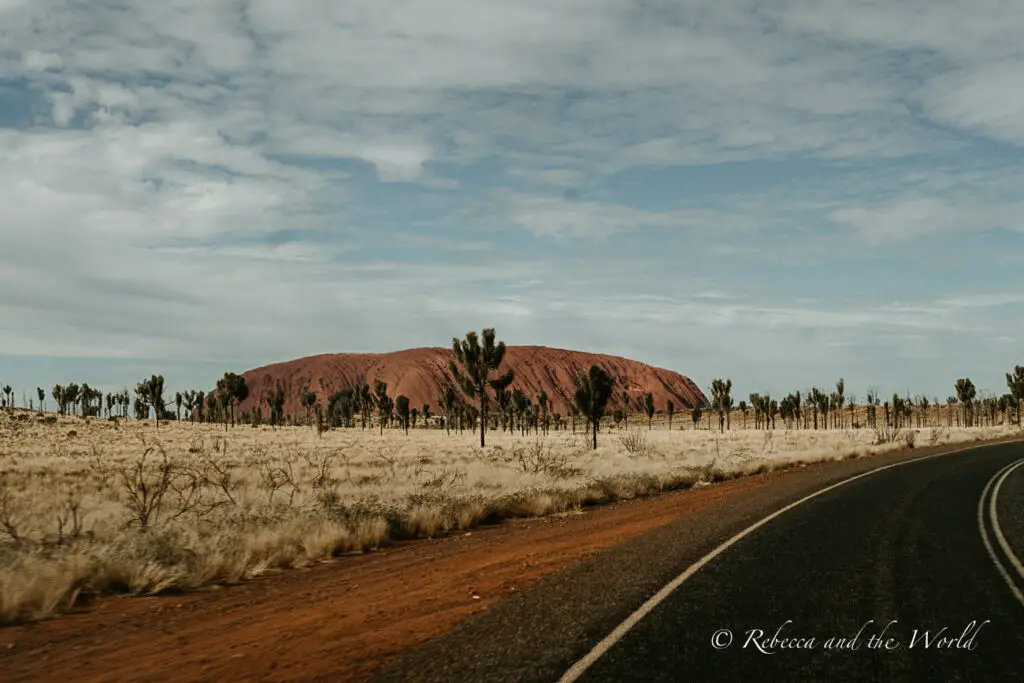
How to get to Uluru
In the heart of Australia, Uluru is remote and not always easy or cheap to get to.
The easiest way to get to Uluru is to fly into Yulara . Ayers Rock/Connellan Airport (code AYQ) is the closest airport to Uluru. Jetstar, Qantas and Virgin Australia have various services from Cairns, Sydney, Brisbane and Melbourne.
When you arrive, you can r ent a car at the airport . While there’s a shuttle bus that runs every 20 minutes around Ayers Rock Resort, it doesn’t go to Uluru-Kata Tjuta National Park, so you’ll need your own wheels or to join tours to get to the main attractions.
The other option is to fly into Alice Springs, rent a car there and drive to Uluru. Don’t forget that there are plenty of things to do in Alice Springs , so factor in a few days there in your itinerary!
The drive from Alice Springs to Uluru is 470 kilometres, or around 5 hours. Avoid driving in the dark. In my Central Australia road trip itinerary I have recommendations for campervan hire in Alice Springs and car rental.
Or you can add a visit as part of an epic Adelaide to Darwin road trip !
If you don’t want to drive at all, there are multi-day tours to Uluru .
Where to stay in Uluru
Campers and caravanners have two options: Ayers Rock Campground , the closest to Uluru, and Curtin Springs Station (100km away from the park).
There is no camping allowed elsewhere in Uluru-Kata Tjuta National Park.
We stayed at Ayers Rock Campground, which is well-equipped with showers, washing machines and drinking water. Plus, you have access to all the other facilities on offer at Ayers Rock Resort (IGA supermarket, petrol station, cafés and restaurants). Sites here book out months in advance so book ahead!
Ayers Rock Resort also has several hotels, including (in order of affordability): the Outback Hotel & Lodge , The Lost Camel Hotel , Emu Walk Apartments , Desert Gardens Hotel and Sails in the Desert . If you really want to splash out, Longitude 131° is the ultimate in luxury. You can read my full Uluru accommodation guide to help decide where to stay.
Final thoughts on things to do at Uluru
Uluru is one of those unforgettable places that should be on your bucket list – if it isn’t already. There are so many things to do at Uluru, so your trip can be luxury, adventure, relaxation or learning. Plan a few days here to see and experience this magical part of Australia!
Did you find this article helpful? Consider buying me a coffee as a way to say thanks!
Are you planning a trip to Uluru? Feel free to drop a comment below if you’d like some help planning your Uluru itinerary.
Related posts
Before you go… you might also like these Australia travel articles:
- What to pack for Uluru
- One-week Alice Springs to Uluru road trip
- The best things to do in Coober Pedy, South Australia
- The ultimate guide to Kakadu National Park
- What to do at Litchfield National Park
- What to do in Ikara-Flinders Ranges National Park
PIN IT FOR LATER: THINGS TO DO AT ULURU
Save this guide to things to do at Uluru to Pinterest so you can plan your Uluru itinerary later.
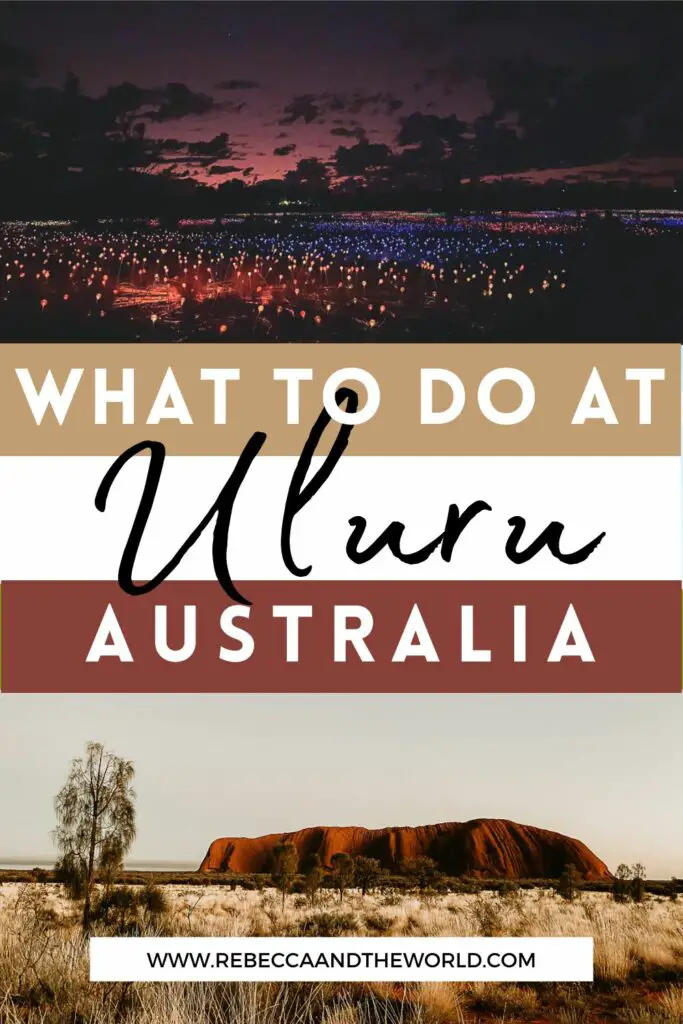
About REBECCA
I'm a travel junkie who started dreaming about seeing the world from a very young age. I've visited more than 40 countries and have a Master of International Sustainable Tourism Management. A former expat, I've lived in Australia, Papua New Guinea, Argentina and the United States. I share travel resources, tips and stories based on my personal experiences, and my goal is to make travel planning just that bit easier.
Leave a Comment Cancel reply
MORE INFORMATION
ABOUT WORK WITH ME CONTACT PUBLISHED WORK
AFFILIATE DISCLOSURE
AS AN AMAZON ASSOCIATE I EARN FROM QUALIFYING PURCHASES
© 2024 REBECCA AND THE WORLD
Privacy Policy
I ACKNOWLEDGE THE WURUNDJERI AND BOON WURRUNG PEOPLE OF THE KULIN NATION AS THE TRADITIONAL OWNERS OF THE LANDS AND WATERWAYS OF THE AREA I LIVE ON. I PAY MY RESPECTS TO ELDERS PAST AND PRESENT AND CELEBRATE THE STORIES, CULTURE AND TRADITIONS OF ALL ABORIGINAL AND TORRES STRAIT ISLANDER PEOPLE ACROSS AUSTRALIA.

- Privacy Overview
- Strictly Necessary Cookies
This website uses cookies so that we can provide you with the best user experience possible. Cookie information is stored in your browser and performs functions such as recognising you when you return to our website and helping our team to understand which sections of the website you find most interesting and useful.
Strictly Necessary Cookie should be enabled at all times so that we can save your preferences for cookie settings.
If you disable this cookie, we will not be able to save your preferences. This means that every time you visit this website you will need to enable or disable cookies again.
4 Week Uluru Itinerary – Oodnadatta – Coober Pedy
Our Uluru itinerary. Four weeks through outback Australia is going to be our next trip. We are leaving from home in Cootamundra and travelling the Oodnadatta Track with some good friends then Coober Pedy then north to Uluru and Alice Springs then through outback Queensland.
We will visit many iconic locations on this epic 4 week road trip. Marree, Farina, William Creek, Coward Springs, Algebuckina Bridge, The Pink Roadhouse at Oodnadatta, Coober Pedy, Uluru, Alice Springs, Tennant Creek, Longreach and Winton are just some of the bucket list locations we’ll be visiting as part of this Uluru itinerary. All up we plan on about 7,000kms and many of them will be on red dirt. We love red dirt. It’s going to be an awesome trip. Please follow us along!
We’ve been to Marree quite a few times now and it’s a favourite outback destination of ours. We can’t wait to have another burger in the pub and have a look around. Marree really is the intersection of some of our most iconic outback tracks.
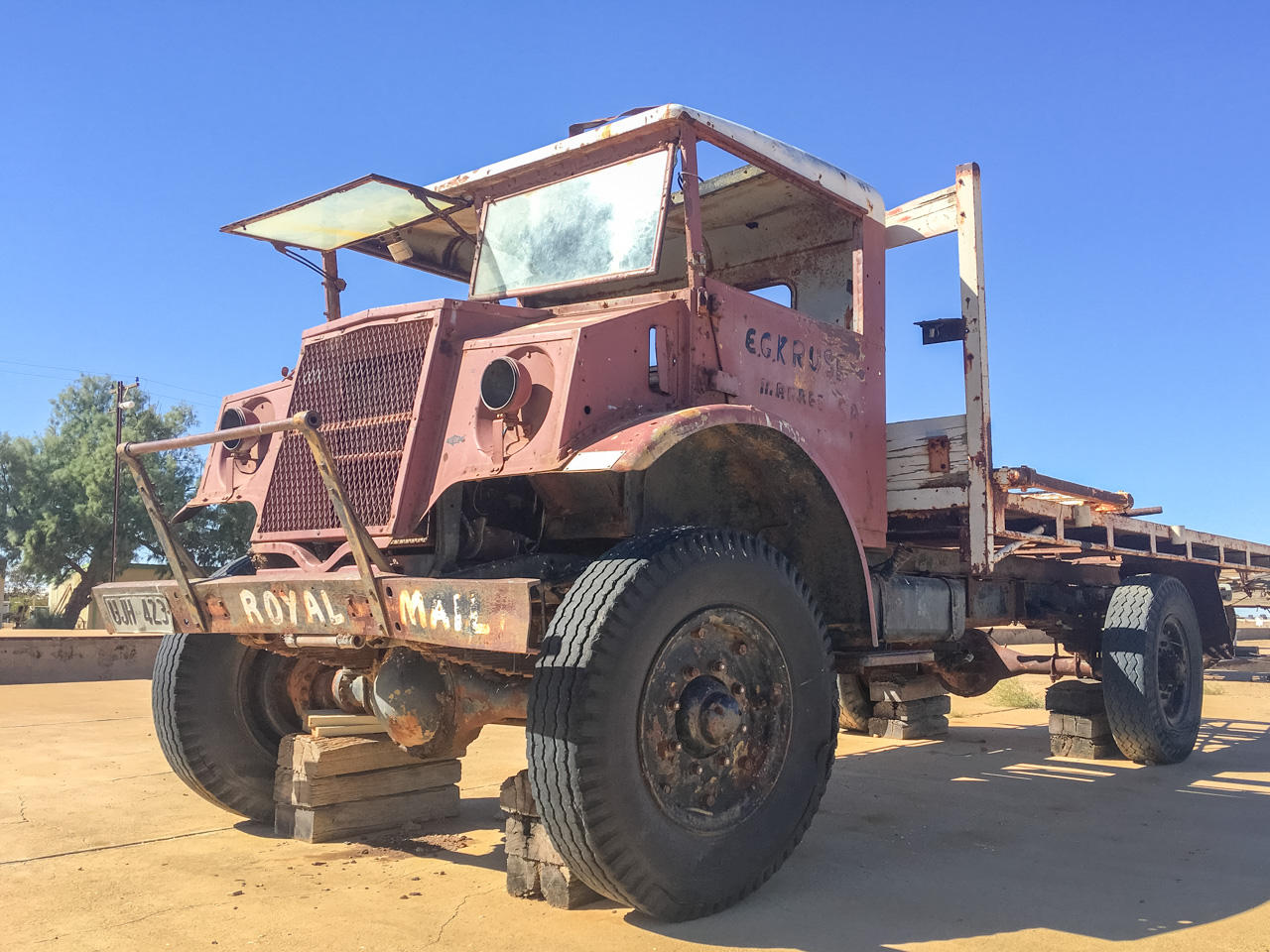
Tom Kruse Mail Truck At Marree
We love Farina and keep going back. It’s a great old Aussie ghost town and a fantastic place to camp. I think this trip will see us chalk up our tenth night of camping at Farina. If you haven’t been to Farina before then you should add it to your list.
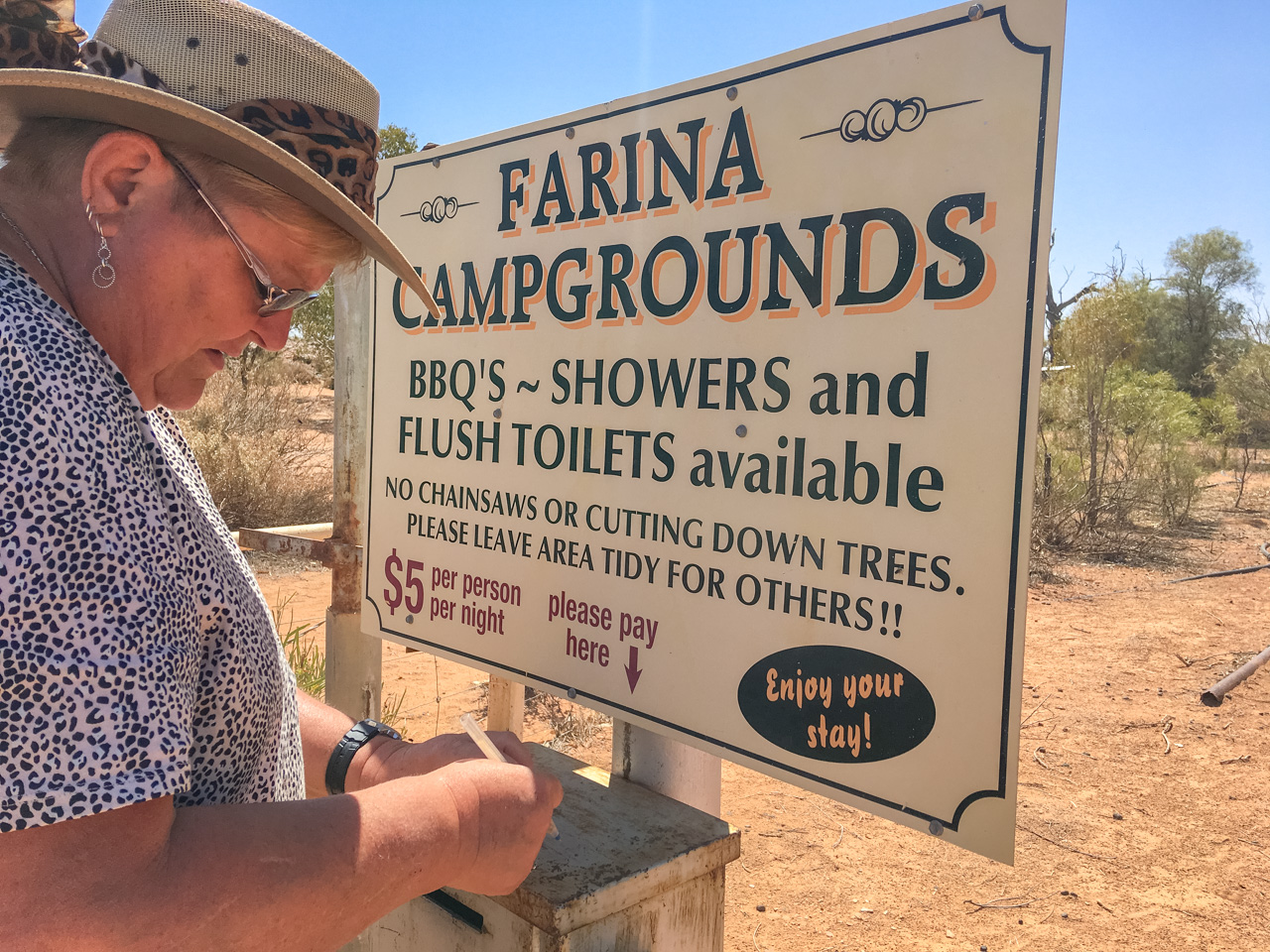
Farina Campgrounds Camp Honesty Box
William Creek
The pub at William creek is a favourite of ours and we’ve had quite a few beers there. Looking forward to camping across the road from the pub at William Creek and having a few more.
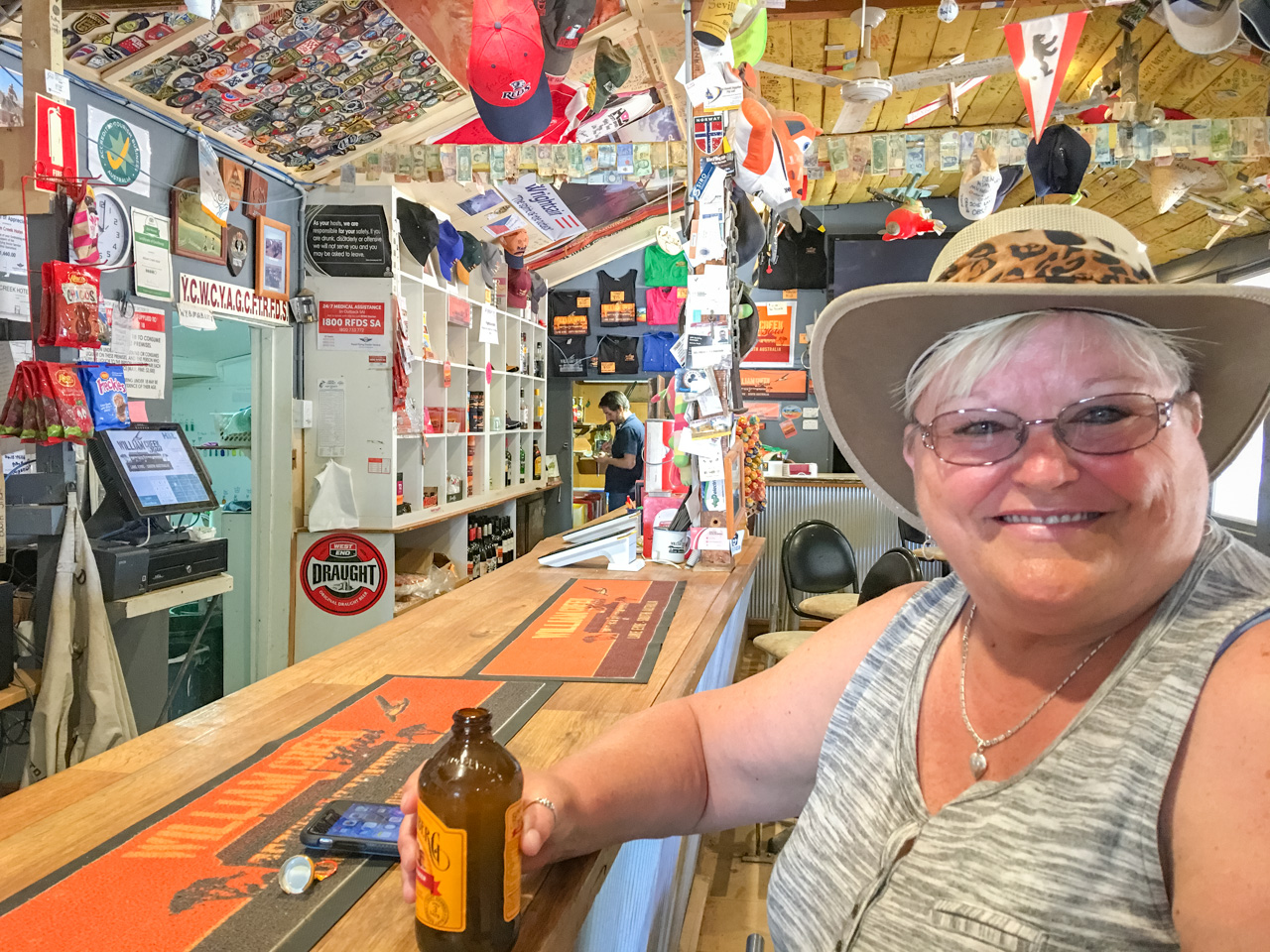
Amanda At William Creek Hotel
Coward Springs
Coward Springs is an oasis in the middle of the desert. We’ve camped there before and really enjoyed it. The little pool at Coward Springs is a great way to cool off after a hard days travelling – but don’t forget the fly nets!
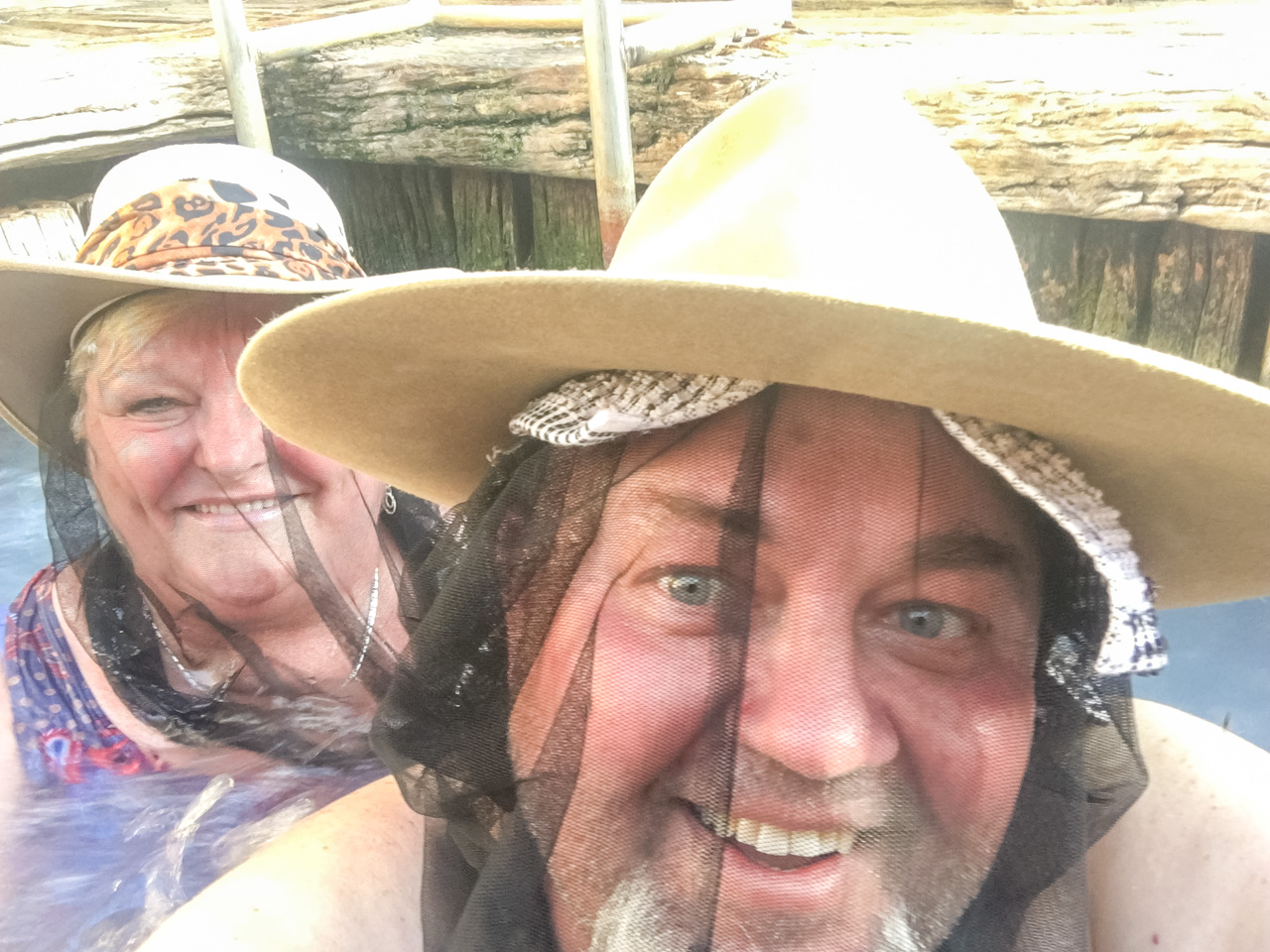
David & Amanda In The Spring At Coward Springs
Algebuckina Bridge
On the route of the now-closed Central Australia Railway lies the Algebuckina Bridge. The Algebuckina Bridge is an Australian Victorian era railway bridge in the state of South Australia about 55 kilometres south of the town of Oodnadatta. January 1892 marked its opening. We have stopped in here before and had a look and taken some photos but this time we plan on camping there.
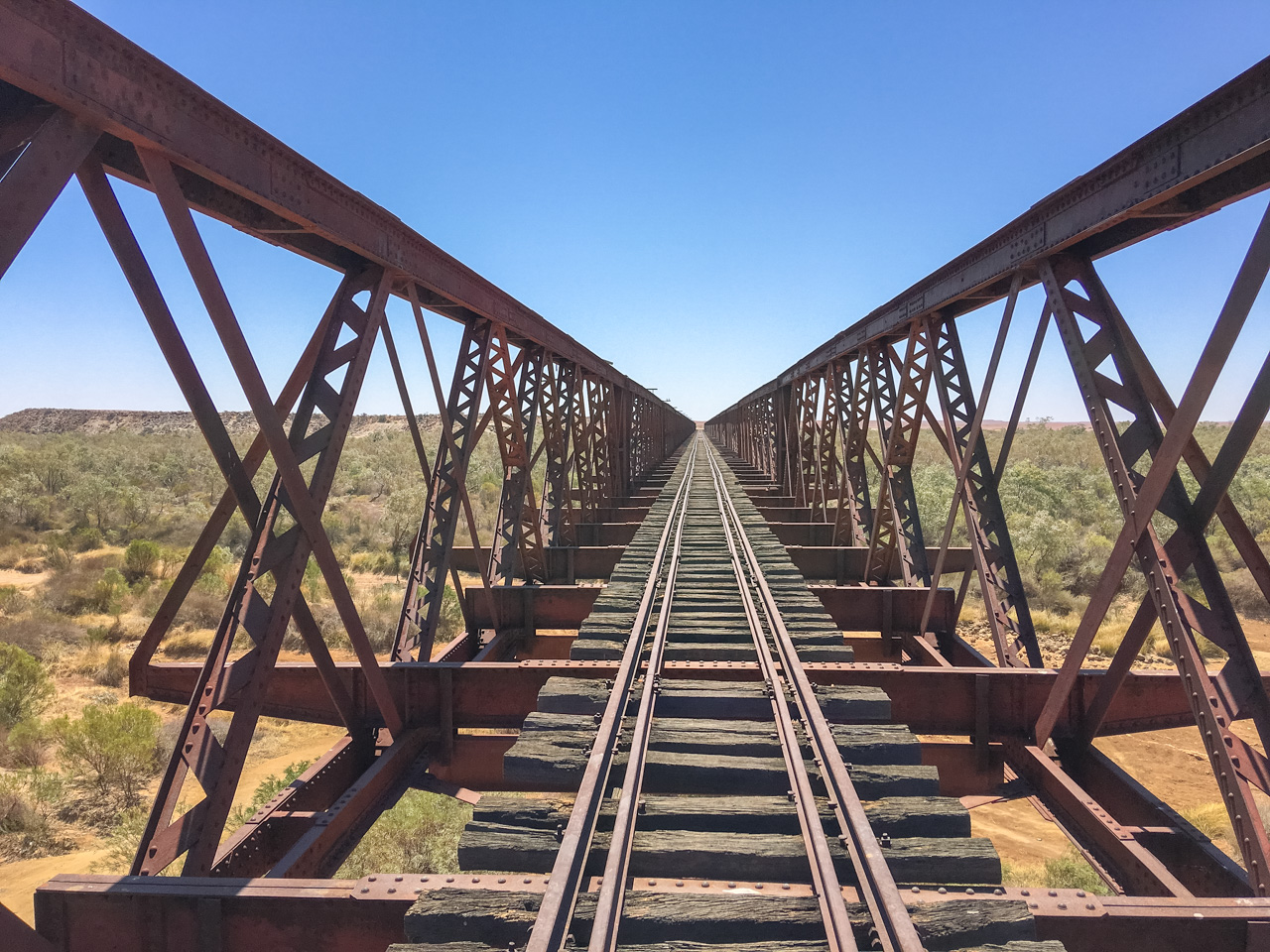
Algebuckina Bridge On The Oodnadatta Track
The Pink Roadhouse At Oodnadatta
No trip along the Oodnadatta Track would be complete without calling in at the iconic Pink Roadhouse at Oodnadatta. I’m going to have one of their famous “Oodnaburgers” again – Amanda probably won’t as she didn’t like hers last time. What’s wrong with her – they’re bloody awesome! Hopefully this time we have a bit better luck and don’t get a flat tyre (Tek Screw) at the fuel bowser.
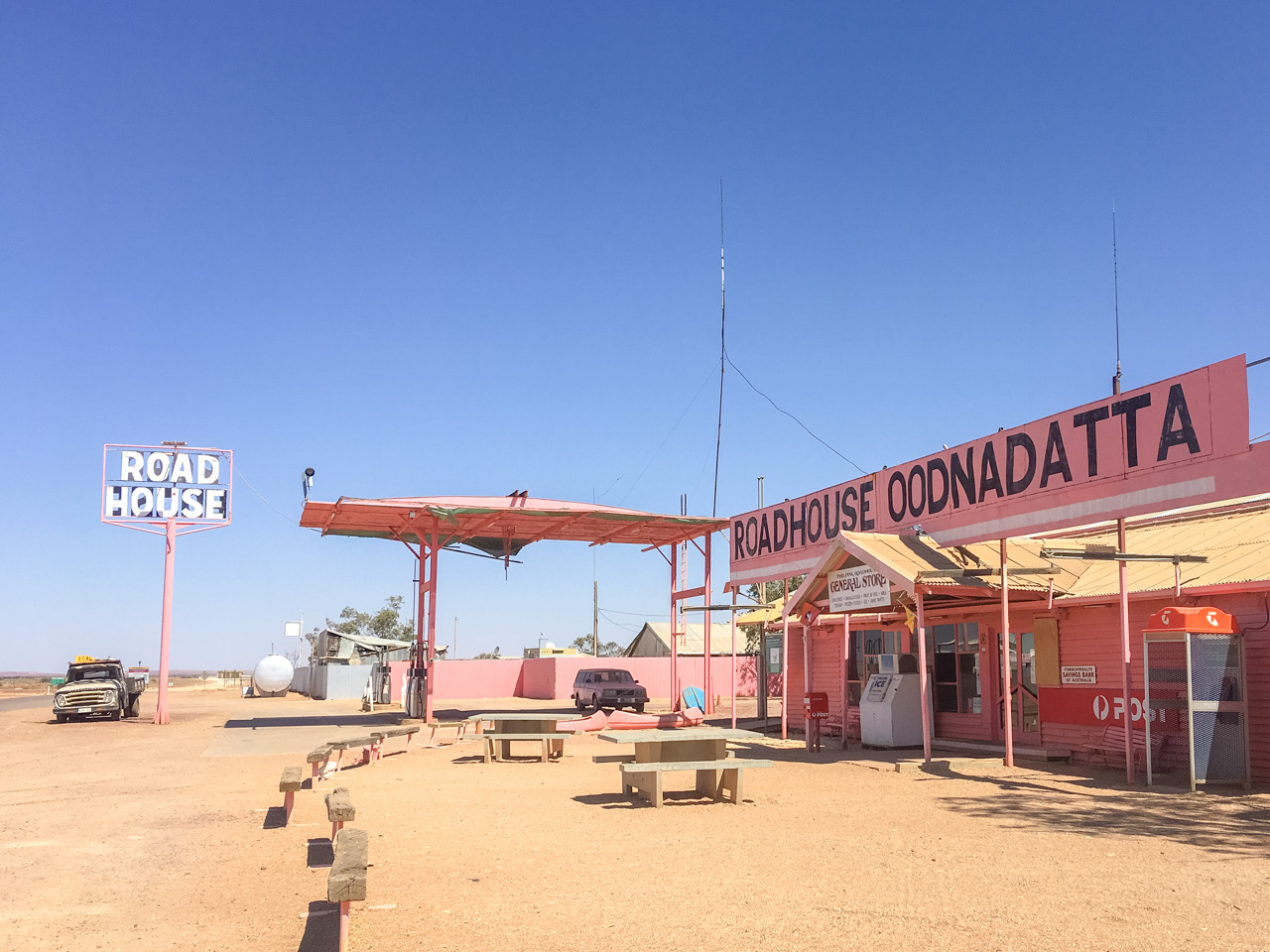
Pink Roadhouse Oodnadatta
Coober Pedy
This time in Coober Pedy we’re hoping to be able to explore the town. On our last visit we had an issue with the car’s battery and it was a long weekend so nothing was open. We were limited to having a look at places we get to on foot. On our last day there after getting a replacement battery we had an explore and loved what we saw. I’m really looking forward to going out to the Breakaways and watching the sunset. We’ve been up Big Red at Birdsville to watch the sunset before and I’m hoping this is just as spectacular. We’re also planning on going to the drive in movies!
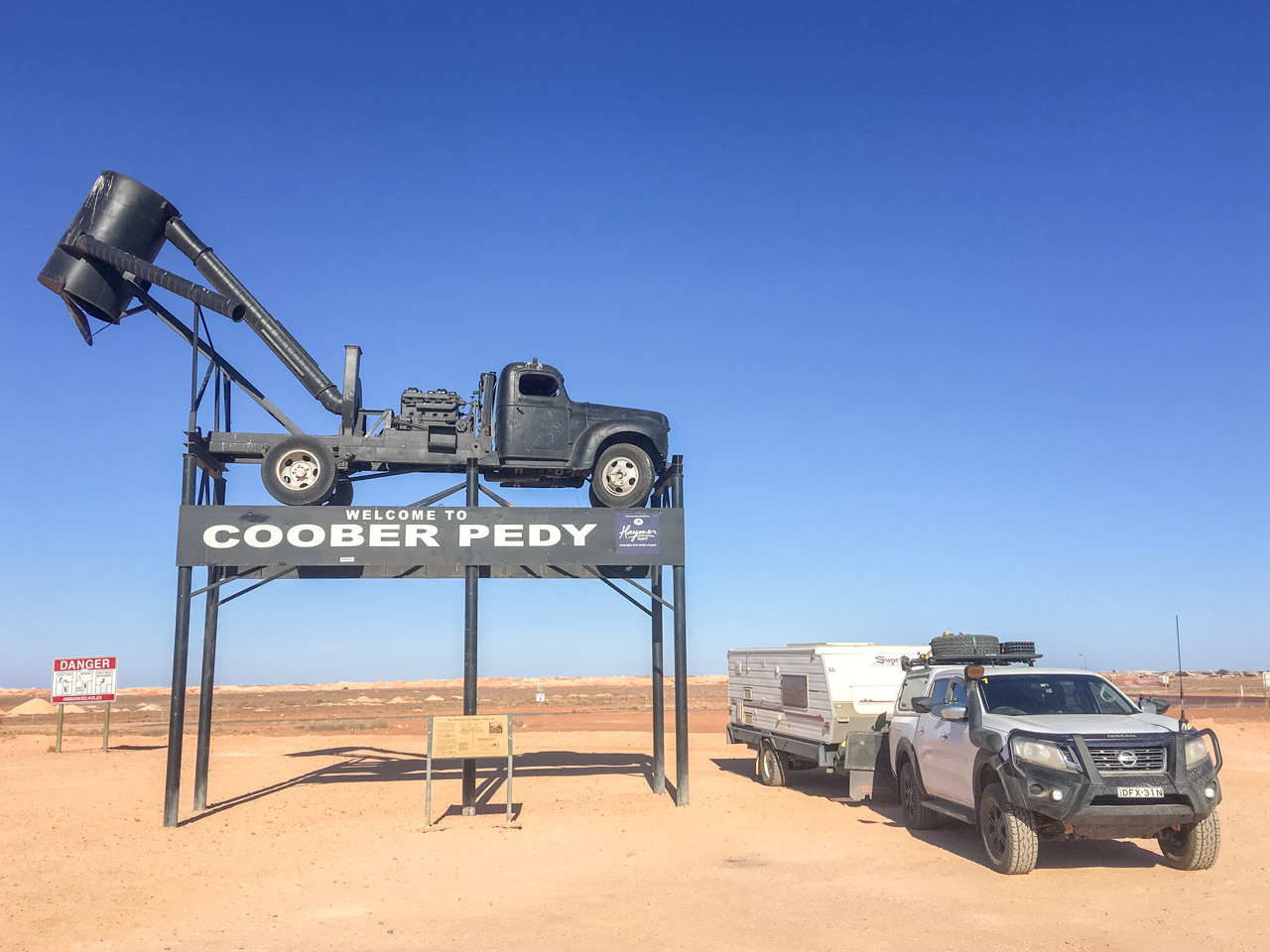
Welcome To Coober Pedy
How have we never been to Uluru? We’ve been saving it for years, now it’s finally time to check it out. I really want it to be as spiritual an experience as I have been told it is. It’s been right towards the top of my bucket list since I was a little kid. Uluru is a massive sandstone monolith in the heart of the Red Centre, an arid region of the Northern Territory. It is roughly 450km from the closest large city Alice Springs. In Indigenous Australian culture, Uluru holds great spiritual significance. Around 550 million years ago, Uluru was thought to be beginning to form. The natural formation is part of Uluru-Kata Tjuta National Park, which also features 36 red-rock domes called “The Olgas”. This part of the trip is the focus of our Uluru itinerary.

Alice Springs
We’ve never been to Alice Springs before and it’s been on our bucket list ever since we started travelling Australia. The Northern Territory town of Alice Springs lies halfway between Darwin and Adelaide, each 1,500 km away. Visitors travel there to explore the Red Centre, the country’s interior desert region. I’m looking forward to seeing the historic buildings and equipment at the Alice Springs Telegraph Station Historic Reserve. The vintage equipment and buildings date from 1872 and were part of the Overland Telegraph Line (linking Darwin and Adelaide).
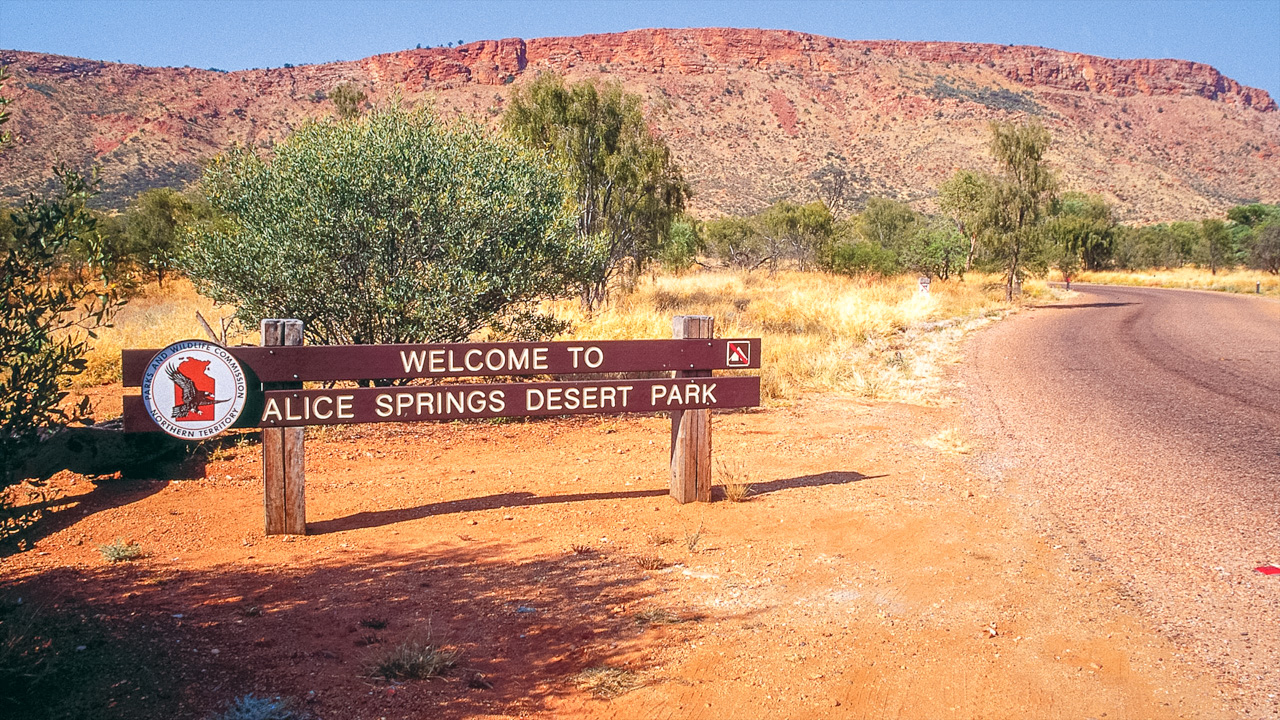
Alice Springs Desert Park
Tennant Creek
Warumungu Aboriginal people occupied the Tennant Creek region for thousands of years. Located close to the telegraph station is a very significant sacred site called “Jurnkurakurr”, where a black-nosed python called “Jalawala” resides. Tennant Creek Telegraph Station was constructed in 1872. By 1875, it had been rebuilt from locally quarried stone after first being constructed out of bush timber.
It served as a repeater station on the Overland Telegraph Line, which connected Darwin with Adelaide. In addition, it was used as a depot for government supplies. A 19th century blacksmith shop was found there, as well as a cart shed, ration store, meat house, smokehouse, and cellar. Cattlemen and slaughtermen were employed by the Warumungu at the station. In the 1890s well over 100 indigineous Australians were living at the station.
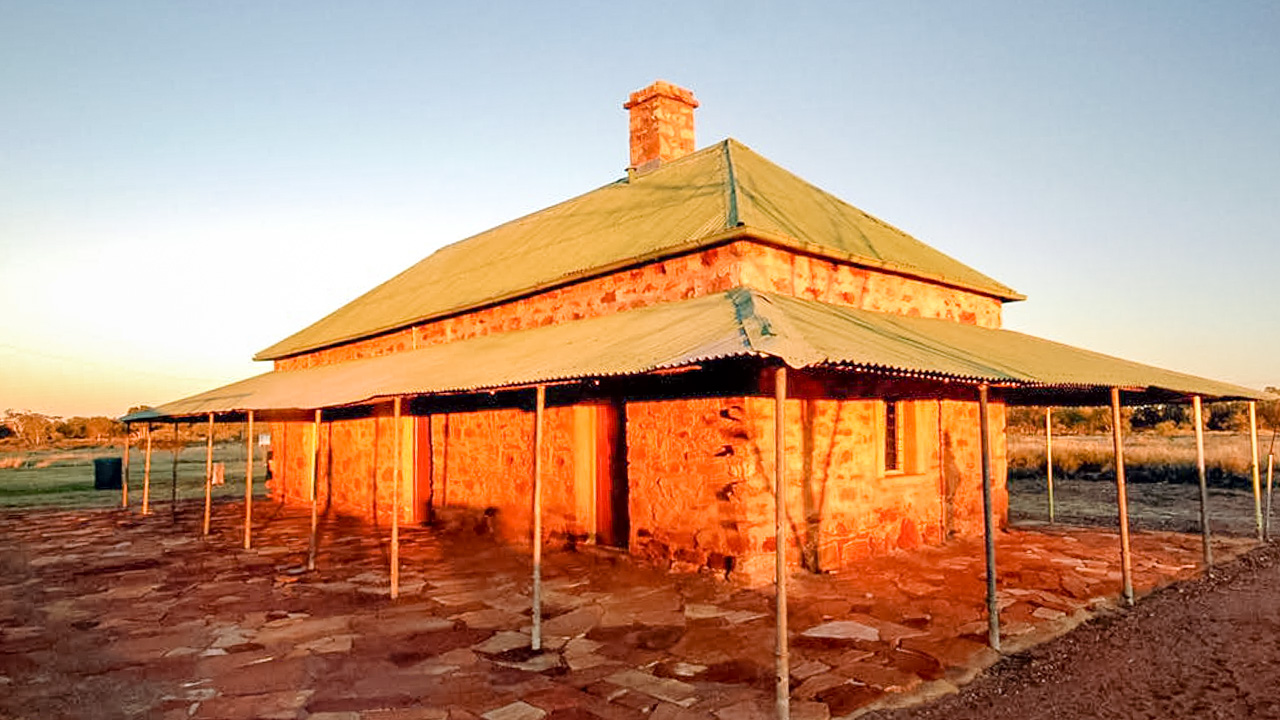
Tennant Creek Telegraph Station
Longreach is the heart of Outback Queensland. It’s home to attractions including the Australian Stockman’s Hall of Fame and Qantas Founders Museum. We’ve never been to Longreach before and I think it will be awesome. Call us weirdos but we want to have a good walk through the cemetery. If you haven’t noticed it on our blog before visiting cemeteries is something we do a lot of. You can learn a lot about a towns history by visiting it’s cemetery.
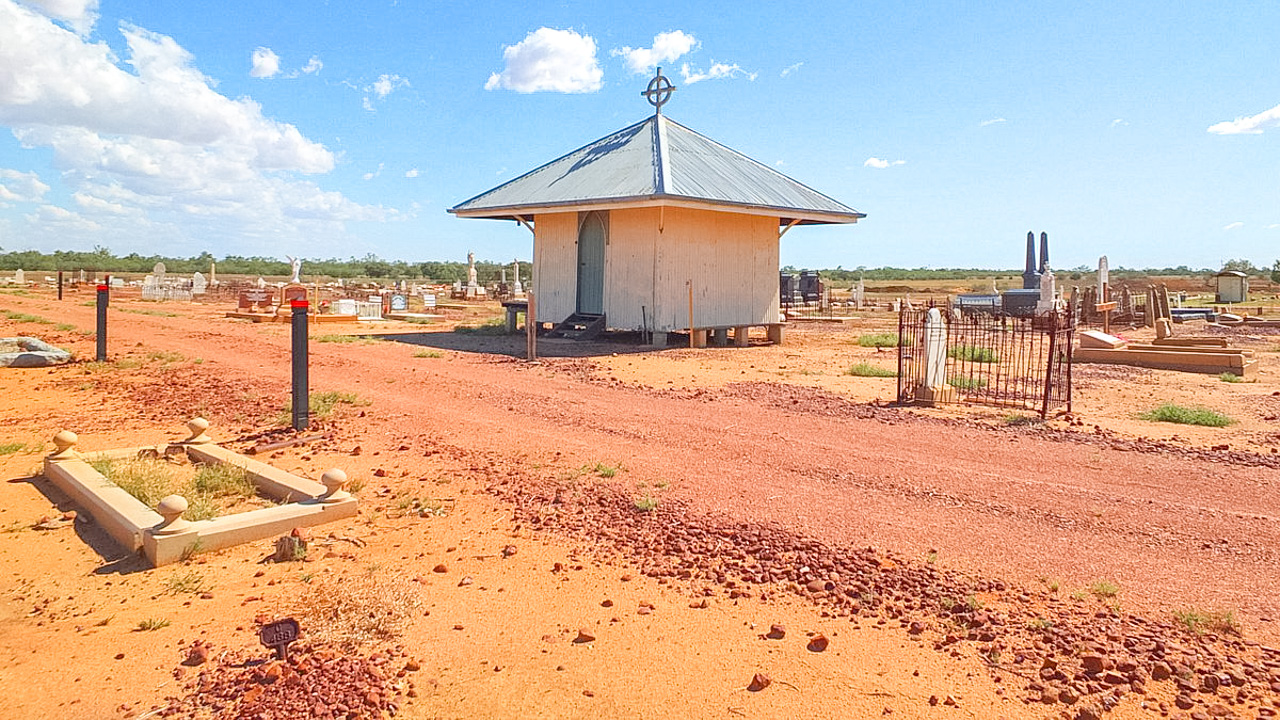
Longreach Cemetery
Looking forward to visiting the pubs in Winton. I’ve heard a bit about them and want to find out for myself. Amanda wants to hit the dinosaur trail, that will be good too.
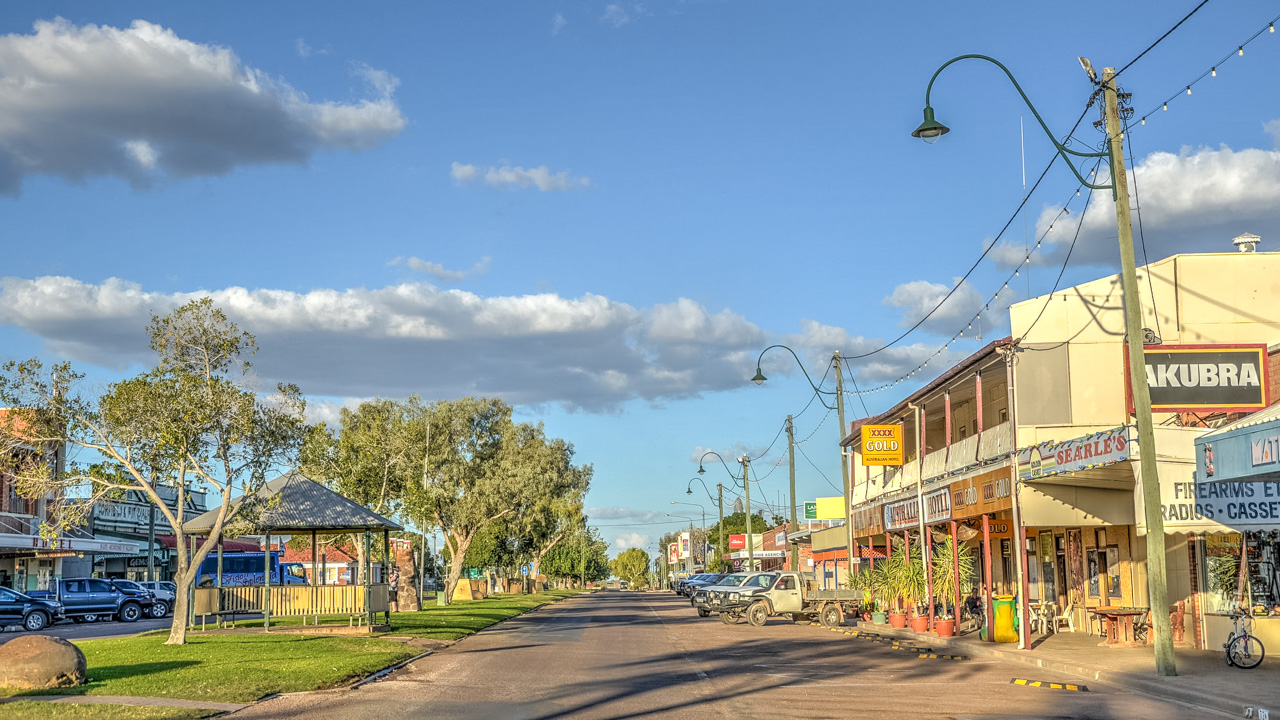
Winton Queensland We Want To Check Out The Pubs
Uluru Itinerary
We are really looking forward to this trip. Our Uluru itinerary is outlined below with driving distances and approximate times.
Related Posts
- Free Camping In Coober Pedy & Getting Out & Exploring
- 27 Best Camp Sites On The Oodnadatta Track South Australia
- Oodnadatta Track – Coober Pedy – Uluru – Travel Itinerary
- Uluru Sunset Viewing Area
- Strzelecki Track and Oodnadatta Track Travel Itinerary
- Top 10 Free Bush Camping Locations in Australia
Recent Posts
- Geocaching Around Tumut
- 15 Camps For Free Camping In Moama On The Murray River
- Caravan Rear Bar Storage – Maximise Your Caravans Storage
- North Berry Jerry Cemetery In The Coolamon NSW Shire
- Geocaching Around Marrar – Coolamon – Berry Jerry
- Aussie Camp Oven Cooking
- Birdsville Track – Dig Tree – Oodnadatta Track
- Cairns Via The Great Inland Way
- Cameron Corner & Farina via Strzelecki Track
- Camping Trips
- Darling River Run
- Grain Silos Of Australia
- Iconic Aussie Pubs
- List Of All Australian Pubs And Hotels
- MARS Enthusiasts Facebook Group
- Oodnadatta Track – Uluru 2022
- Silverton & Lightning Ridge
- Tasmania Road Trip In a Tent
- Vehicle & Van Preparation
- Weekend Camping Trips

Australia Recommends 2024

Come and Say G'day

G'day, the short film

Discover your Australia

Travel videos

Deals and offers

Australian Capital Territory

New South Wales

Northern Territory

South Australia

Western Australia

External Territories

The Whitsundays

Mornington Peninsula

Port Douglas

Ningaloo Reef

Airlie Beach

Kangaroo Island

Rottnest Island

Hamilton Island

Lord Howe Island

Tiwi Islands

Phillip Island

Bruny Island

Margaret River

Barossa Valley

The Grampians

Hunter Valley

McLaren Vale

Glass House Mountains

Alice Springs

Uluru and Kata Tjuta

The Kimberley

Flinders Ranges

Kakadu National Park

Eyre Peninsula

Karijini National Park

Great Barrier Reef

Blue Mountains

Daintree Rainforest

Great Ocean Road

Purnululu National Park

Cradle Mountain-Lake St Clair National Park

Litchfield National Park

Aboriginal experiences

Arts and culture

Festivals and events

Food and drink

Adventure and sports

Walks and hikes

Road trips and drives

Beaches and islands

Nature and national parks

Eco-friendly travel

Health and wellness

Family travel

Family destinations

Family road trips

Backpacking

Work and holiday

Beginner's guide

Accessible travel

Planning tips

Trip planner

Australian budget guide

Itinerary planner

Find a travel agent

Find accommodation

Find transport

Visitor information centres
Deals and travel packages

Visa and entry requirements FAQ

Customs and biosecurity

Working Holiday Maker visas

Facts about Australia

Experiences that will make you feel like an Aussie

People and culture

Health and safety FAQ

Cities, states & territories

Iconic places and attractions

When is the best time to visit Australia?

Seasonal travel

Events and festivals

School holidays

Public holidays
How to get to Australia's most iconic cities

How long do I need for my trip to Australia?

How to travel around Australia

Guide to driving in Australia

How to hire a car or campervan

How to plan a family road trip

How to plan an outback road trip

Uluru, Uluru-Kata Tjuta National Park, Northern Territory © Tourism NT, Luke Tscharke
4-day family holiday in and around Ulu r u
Recalibrate your understanding of the term natural wonder and enjoy some quality family time at Australia's spiritual heart on this epic four-day Ulu r u adventure.
By Paige Richardson
Too far, too expensive and the kids might not ‘get’ its cultural significance are the reasons why so many families are yet to make the pilgrimage to Australia’s most iconic rock. While it may be far, its location is part of what makes it so special; while it can sometimes be expensive to get there, you’ll be floored by the range of free and cheap activities for families once you do; and while it’s profoundly spiritual, children are perhaps the most accepting (and by far the most riveted) audience to any creation story.
Convinced yet? Let this four-day itinerary be your guide.
,url-https%3A%2F%2Fwww.australia.com%2Fcontent%2Fdam%2Fassets%2Fimage%2Fmapbox%2Fmarkers%2F1x%2F6.png(130.737399,-25.299051),url-https%3A%2F%2Fwww.australia.com%2Fcontent%2Fdam%2Fassets%2Fimage%2Fmapbox%2Fmarkers%2F1x%2F5.png(131.002771,-25.253742),url-https%3A%2F%2Fwww.australia.com%2Fcontent%2Fdam%2Fassets%2Fimage%2Fmapbox%2Fmarkers%2F1x%2F4.png(130.98446,-25.241294),url-https%3A%2F%2Fwww.australia.com%2Fcontent%2Fdam%2Fassets%2Fimage%2Fmapbox%2Fmarkers%2F1x%2F3.png(131.032722,-25.35121),url-https%3A%2F%2Fwww.australia.com%2Fcontent%2Fdam%2Fassets%2Fimage%2Fmapbox%2Fmarkers%2F1x%2F2.png(130.998195,-25.300549),url-https%3A%2F%2Fwww.australia.com%2Fcontent%2Fdam%2Fassets%2Fimage%2Fmapbox%2Fmarkers%2F1x%2F1.png(130.986899,-25.241)/auto/600x400@2x?access_token=pk.eyJ1IjoidG91cmlzbWF1c3RyYWxpYSIsImEiOiJja2ExdXdsNzYwNTZsM2dsd24zNnFqMTN2In0.An2c1t_cPfn8R7-LR5glLg)
4-day family holiday in and around Ulu r u
Day 1: Getting to Ulu r u-Kata Tju t a National Park

Ulu r u, Ulu r u-Kata Tjuṯa National Park Northern Territory © Tourism Australia/Nicholas Kavo
While driving to r u">Ulu r u is entirely possible, to pull off this itinerary you’ll need some wings. You can fly direct to Yulara – the township just outside Ulu r u-Kata Tju t a National Park – from most capital cities in Australia with a flight time between two and four hours. Not your typical domestic jaunt, no, but worth it; alighting here – and seeing Ulu r u from the air – is an experience in itself. After landing on the red-dirt airstrip, hire a car or take the complimentary airport transfer for guests of Ayers Rock Resort .
Save your second sighting of the red rock monolith for sunset from one of the park’s five viewing areas. Pack a picnic (and your camera), find your place on the dunes and watch as a kaleidoscope of sunset colours are thrown over Ulu r u and the hue of the desert landscape intensifies. Or, make your first night effortless and book the sunset tour with SEIT Outback Australia .
Stay: Most of the accommodation options at Ulu r u are located in Yulara, within the Aboriginal-owned Ayers Rock Resort , where you can choose between five-star luxury, mid-range hotels and even campgrounds. The one- and two-bedroom apartments at Emu Walk Apartments are self-contained, making them a good pick for families.
Day 2: Exploring Ulu r u

Segway tour, Ulu r u-Kata Tju t a National Park, Northern Territory © Tourism NT

Sizzle an emu sausage for dinner or make your own croc-dog at Pioneer BBQ and Bar at Voyages Ayers Rock Resort, a do-it-yourself BBQ restaurant that lets you choose your cut of meat and fry it yourself.
Start your day in the Ulu r u-Kata Tju t a National Park at the Cultural Centre to learn more about the significance of Ulu r u to its traditional owners, A n angu. Displays, exhibits and talks focus on Tjukurpa (Aboriginal law, moral systems and culture), and on the natural and human history of the park. Entry to the centre is free with your national park pass – all visitors to Ulu r u-Kata Tju t a National Park require a pass, which should be booked in advance.
From here it’s only five minutes by car to Mala carpark, the meeting point for the free ranger-guided Mala Walk . This 2km (1.5mi) walk is one of two shorter trails suitable for families (the other is the Kuniya Walk to Mutitjulu Waterhole ). It travels along parts of Ulu r u’s base, through the caves where A n angu’s ancestors – the Mala (rufous hare-wallaby) people – first camped, and past traditional rock art before arriving at Kantju Gorge. For a breezier alternative, slap on a helmet and jump on a Segway or hire a bike and cycle the full 11km (7km) loop.
Day 3: Ulu r u camel tours and crafts

Ulu r u camel tour, Ulu r u-Kata Tju t a National Park, Northern Territory © Uluru Photography
Now acquainted with the local A n angu, get to know the other Red Centre locals; namely Bruce the blue tongue lizard, Wolverine the bearded dragon and Max the mulga snake at Ayers Rock Resort’s Red Desert Reptile Show . Learn about the desert’s 73 different reptile species before your own up-close encounter with the critters.
Next, take part in one of Maruku Arts’ dot-painting workshops . Learn the different symbols that make up the Tjukurpa and, with the help of a Maruku guide and local artist, create your own work of art to take home. Kids aged five and up are welcome.
Make like explorers of old and spend the afternoon surveying the gargantuan landscape from atop a camel with Uluṟu Camel Tours . Ask for Tex (he’s textbook perfect) or Ted (he loves a cuddle), and hop along amid the dunes and spinifex with unimpeded views of Ulu r u at sunset.

7 meaningful family holidays to start planning now
Day 4: Field of Light and Kata Tju t a

Field of Light, Ulu r u-Kata Tju t a National Park, Northern Territory © Tourism Australia
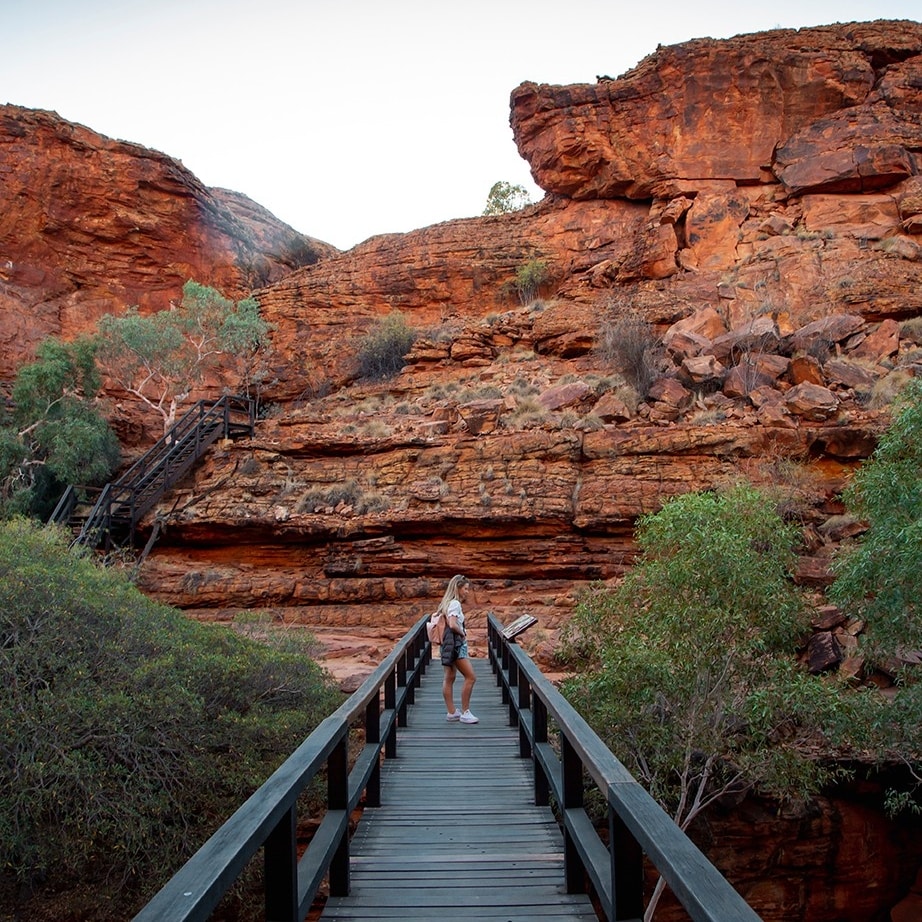
If you have time, make the three-hour trip from Ulu r u to Watarrka National Park to see Kings Canyon , complete with a contoured rock amphitheatre and swimming hole in the mythically titled Garden of Eden.
Artist Bruce Munro’s solar-powered installation of 50,000 spindles of light twinkle and sway in the shadow of Ulu r u like a field of flowers in bloom at its base. See Field of Light at dawn on the sunrise tour as the first light glows on the horizon, then contemplate its creation over a cup of freshly-brewed billy tea. Before you leave, take a look behind you for a view of your next destination: Kata Tju t a.
It’s not as famous as Ulu r u, but nearby Kata Tju t a’s ‘many heads’ are just as impressive. The 36 domes rise up to 546 metres above the desert plain and were formed by the same geological events – beginning around 550 million years ago – that first exposed Ulu r u. Walk among the giant sandstone boulders on the shorter 2.6km (1.6mi) return, Walpa Gorge walk with SEIT Outback Australia .
After sunset, set off for a tour of the desert’s crowning glory and the final stop on your Ulu r u adventure. While you could simply look up to see this outback treasure, an introduction to the night sky from a resident astronomer on the Family Astro Tour offers an entirely new (and sparkly) perspective. Learn how ancient cultures used the night sky to orient themselves and predict seasons, and spot the animal shapes found in constellations that have featured in Aboriginal creation stories for thousands of years.
For inspiration and more things to do in the Northern Territory, go to northernterritory.com .
Explore more nearby

We use cookies on this site to enhance your user experience. Find out more . By clicking any link on this page you are giving your consent for us to set cookies.
Acknowledgement of Country

We acknowledge the Traditional Aboriginal and Torres Strait Islander Owners of the land, sea and waters of the Australian continent, and recognise their custodianship of culture and Country for over 60,000 years.
- New Zealand (English)
- United States (English)
- Canada (English)
- United Kingdom (English)
- India (English)
- Malaysia (English)
- Singapore (English)
- Indonesia (Bahasa Indonesia)
- Deutschland (Deutsch)
- France (Français)
- Italia (Italiano)
- 中国大陆 (简体中文)
*Product Disclaimer: Tourism Australia is not the owner, operator, advertiser or promoter of the listed products and services. Information on listed products and services, including Covid-safe accreditations, are provided by the third-party operator on their website or as published on Australian Tourism Data Warehouse where applicable. Rates are indicative based on the minimum and maximum available prices of products and services. Please visit the operator’s website for further information. All prices quoted are in Australian dollars (AUD). Tourism Australia makes no representations whatsoever about any other websites which you may access through its websites such as australia.com. Some websites which are linked to the Tourism Australia website are independent from Tourism Australia and are not under the control of Tourism Australia. Tourism Australia does not endorse or accept any responsibility for the use of websites which are owned or operated by third parties and makes no representation or warranty in relation to the standard, class or fitness for purpose of any services, nor does it endorse or in any respect warrant any products or services by virtue of any information, material or content linked from or to this site.

IMAGES
COMMENTS
PDF itinerary Download. Book this trip. This 7-day itinerary takes you from Uluru and nearby Kata Tjuta to the majestic Kings Canyon, and on to the ancient salt lakes of Lake Amadeus. You'll learn about Uluru's importance to the local Anangu people and experience life on a working outback camel station. See Australia's most iconic ...
The details. The three-hour Uluru Highlights tour with SEIT includes a guide, sunrise at Uluru, an outback picnic breakfast and pick up and return from Ayers Rock Resort. Prices start from $138 per adult, $110 per child, $60 per infant for car seat hire. This is just one of many ways you can experience Uluru up close.
Wrap up - 3 Day Uluru Itinerary in Uluru-Kata Tjuta National Park. Visiting Central Australia is a chance of a lifetime, and travelers who choose to take that journey will be rewarded with incredible beauty. The 3 Day Uluru Itinerary above provides an amazing combination of awe-inspiring nature, history, and culture, making it a truly unique ...
Itineraries. Sunset at Ulu r u is a must for any itinerary. Photo: Tourism Australia. There is so much to do in and around Ulu r u-Kata Tju t a, from contemplating the vastness of the desert and the richness of A n angu culture to riding Segways through the landscape and dining under a star-studded sky. Given the wide variety of activities on ...
Here I cover my Uluru experience, the recommended 3 day Uluru itinerary travel tips, and the best places to see on your Uluru trip. Visiting Uluru is going to leave you spellbound! It may be the best adventure in the Australian outback! 99% of readers found must see on the east coast of Australia helpful.
Currently, the park pass costs $25 for 3 consecutive days entry and this can be extended to 5 days at no extra cost. But as of 1st November 2020 this will be going up to $38 for 3 days. However if you are travelling with children, the current fee for a child is $12.50, from 1st November 2020 child entry will be free.
The best time to visit Uluru and Kata Tjuta is between May and September when the temperature sits between a pleasant 20°C (68°F) and 30°C (86°F).The cool and dry weather makes activities like walking and camel rides even more enjoyable. High season: Dry season (May - September) Low season: Wet season (October - April) Don't miss: Wandering through 50,000 illuminated bulbs at the Field ...
Before we get into the 3 day Uluru itinerary, it might be best to also cover some important topics on things you need to know before you visit Uluru. Tips for Travelling Australia. Travel with an eSim: Airalo is the world's first eSIM store that solves the pain of high roaming bills by giving travelers access to eSIMs (digital SIM cards ...
Day 1: Uluru-Kata Tjuta National Park. For the first day of our Uluru itinerary we drove out to the entrance gate of the Uluru-Kata Tjuta National Park. To enter the park you need a ticket which we bought in advance online. The ticket costs AU$38 it is valid for 3 days to explore this UNESCO World Heritage Site.
1 About Uluru & surroundings. 2 Our 3-day Uluru tour itinerary. 2.1 Day 1: Uluru - Learn about Aboriginal culture. 2.2 Day 2: Kata Tjuta - Hike in the Valley of the Winds. 2.3 Day 3: Hike in Kings Canyon. 3 How to prepare for a trip in the outback. 3.1 Be ready to battle the flies.
2) Red Centre Way Map. To make it simple, the Red Centre Way is an area of Northern Australia that spans from Uluru-Kata Tjuta National Park up to Alice Springs.It includes highlights such as Uluru, Kata Tjuta, Kings Canyon, and the West MacDonnell Ranges.. There is just a ton to do all along the Red Centre Way and this itinerary will walk you through it all.
Alice Springs to Uluru: An epic itinerary. Day 1 - An insight into life in the Outback, Alice Springs. This itinerary starts in Alice Springs, the largest town in Central Australia. The flight here is an adventure in itself as the land below changes from the lush green of coastal Australia to the deep red martian landscape of the Outback.
Option 3. Ride a bike around Uluru. Riding a bike around Uluru is a much easier option than walking it. The path is smooth, the ride is easy. And, because it's quicker… it's less time in the desert sun. You can take your own bikes, or you can hire some there. Option 4. Take and Uluru Segway tour.
2) Hike Around the Uluru Base Walk. 3) Segway or Cycle Around Uluru. 4) Don't Miss the Mala Walk. 5) Visit the Cultural Centre. 6) Join a Dot Painting Workshop. 7) Visit Kata Tjuta. 8) Be Amazed by the Field of Light Installation. 9) Enjoy Dinner 'Under the Stars'. 10) Spend Some Time in Kings Canyon.
Although Uluru is open to visitors year-round, in summer temperatures frequently sit at 45°C and flies are at their most persistent. Instead, visit between May and October, when daytime temperatures are comfortable. If a one-way road trip from Alice to Uluru is enough for you, fly out of Ayers Rock Airport to many of Australia's major cities.
Australia Red Centre itinerary - OVERVIEW. Day 1: Alice Springs. Day 2: Alice Springs - MacDonnel Ranges - Glen Helen. Day 3: Glen Helen - Kings Canyon. DAy 4: Kings Canyon - Uluru - Kata Tjuta National Park. Day 5: Uluru - Kata Tjuta National Park. Day 6: Uluru and back to Alice Springs. Australia's Red Centre on a Budget.
Here are my recommendations for the best things to do in Uluru on your visit. 1. Uluru base walk. The Uluru Base Walk is a great way to see Uluru up close from all angles. The colour of the rock, its shapes and the patterns in the rockface change as you walk around.
In Indigenous Australian culture, Uluru holds great spiritual significance. Around 550 million years ago, Uluru was thought to be beginning to form. The natural formation is part of Uluru-Kata Tjuta National Park, which also features 36 red-rock domes called "The Olgas". This part of the trip is the focus of our Uluru itinerary.
4. Kings Canyon & Watarrka National Park. Just 3 hours' drive from Ulu r u is Kings Canyon, a stunning rock formation which is worth a couple of days' visit. Kings Canyon and the Watarrka National Park have a number of bushwalking options which take in the sights and let you marvel at the sheer natural beauty. 5.
The 1,135km (705mi) Red Centre Way road trip is one of the Northern Territory's most iconic journeys, beginning in Alice Springs, then making its way to Tjoritja/West MacDonnell Ranges, Watarrka/Kings Canyon, and Uluru-Kata Tju Uluru-Kata Tju. Start your seven-day trip along the Red Centre Way on a high note, viewing Alice's picture-perfect ranges at sunrise on an Outback Ballooning hot ...
While driving to Uluru is entirely possible, to pull off this itinerary you'll need some wings. You can fly direct to Yulara - the township just outside Uluru-Kata Tjuta National Park - from most capital cities in Australia with a flight time between two and four hours.Not your typical domestic jaunt, no, but worth it; alighting here - and seeing Uluru from the air - is an experience ...